Trekking in Nepal

Langtang Valley Trek – Best Time, Cost, Route, Itinerary
By Suraj Katwal
Updated On May 30, 2023
Langtang Valley Trek offers a majestic view of mountains with panoramic landscapes. It is the top 3 most visited trekking destinations in Nepal alongside Everest Base Camp Trek and Annapurna Base Camp Trek.
This trek is exciting with picturesque views of the beautiful village within the Langtang National Park. Langtang is the best vacation spot for regular and novice trekkers, and I am sure it will be your unforgettable lifetime experience.
Langtang Valley is a hidden gem with a wild rural landscape, and most people follow Tibetan Culture. Moreover, in the peak season, you can get spectacular views of pine forests, rhododendron, snow-capped mountains, magnificent glaciers, etc.
Furthermore, this will be a very long and ultimate guide about Langtang Valley Trek , so if you want to know about specific things about Langtang trekking, then you can follow the quick navigation.
Langtang Trekking Overview
Langtang Valley Trekking is the nearest region from Kathmandu for trekking located on the north side of Nepal. It is a classic and pleasing trek that lies between Nepal and China (Tibet) border. Langtang Valley is also named the “ Valley of Glaciers.”
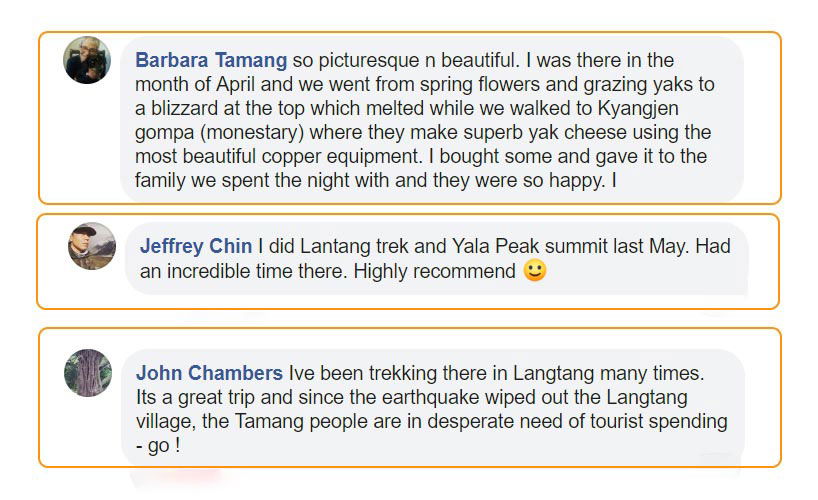
The popular international news website The New York Times has listed Langtang Valley as the top 52 places to visit in the year 2017. I have snapped some Langtang Valley trek reviews from New York Times Travel Facebook Page.
Getting To Langtang Valley
The trek begins from Kathmandu to Syabru Besi. The distance between the capital city and Syabrubesi is roughly 122 km. It takes around 9-10 hours by Public bus and 8-9 hours by Jeep.
It’s not recommended to trek from Kathmandu to Langtang Valley on foot as it’s a long distance and not a safe option. Instead, the trek usually starts from either Syabrubesi or Dhunche, which can be reached by road transport.
2) By Private Jeep
Hiring a private jeep for transportation to Syabrubesi or Dhunche is more expensive than taking a public vehicle. However, if you’re traveling to Nepal through a travel agency, they can arrange private transportation for you, so you don’t have to worry about it.
If you want faster and more comfortable service, you can opt for a private jeep instead of a public bus. A 6-7 seater private jeep service usually costs around $150-$200 for a one-way drive to Dhunche, the starting point of the trek to Langtang Valley.
3) By Public Bus
Taking a public bus is a much cheaper option compared to hiring a jeep for transportation to Syabrubesi or Dhunche. The cost of a public bus is around $7 – $8 per person. The bus service is available at Macha Pokhari, Kathmandu.
The road condition of Pasang Lhamo Highway, which leads to the Langtang Valley trek starting point, is generally okay, but there are some areas where the road can be a bit scary.
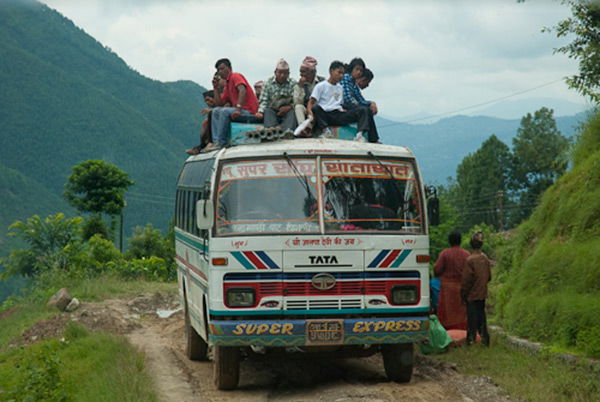
Start Here: Getting Around Nepal
Highlights of Langtang Valley Trek
- Scenic Drive from Kathmandu to Syabrubesi with breathtaking views of the landscapes.
- Explore the unspoiled beauty of Langtang National Park, located between the Nepal-China (Tibet) border.
- Learn more about Tibetan Buddhist culture and their way of life.
- Experience the extended diversity of flora and fauna, including rare species like the red panda and snow leopard.
- Enjoy stunning views of towering peaks like Dorje Lakpa (6,990 m), Langtang-II (7,227 m), Langtang Lirung (7,200 m), Ganesh Himal (7,429 m), and more.
- Immerse in the unique culture and lifestyle of the Tamang community by visiting typical Tamang villages.
- Get the chance to climb Chorko-Ri and witness a panoramic view of the Langtang range.
- Walk through an unimaginable Rhododendron forest, especially during the spring season when the flowers are in full bloom.
Langtang Necessary Permits
Permits are generally required for entry and exit from the Langtang Valley trekking route. Make sure to obtain the necessary permits from the Nepal Tourism Board (NTB) in Kathmandu. You will need to carry your passport and photos for the permit application process.
1) TIMS Card
Trekker’s Information Management System (TIMS) is a card that you get as a permit. These permits must be shown at checkpoints in different places.
The TIMS Card for Langtang Trek is a record that helps trekkers in case of an earthquake, or extreme weather, and for finding lost trekkers.
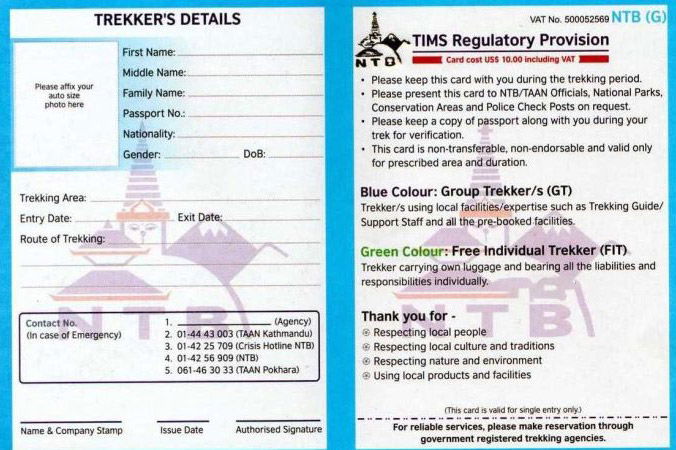
For independent trekkers, it cost around Rs. 2000 ($20), and for group trekkers with a guide, it cost around Rs. 1000 ($10). But if you are traveling through Travel Agency, then they will manage TIMS Cards for you.
2) Langtang National Park Fee
The entrance to Langtang National Park will cost you around Rs 3000 (~$30). You need to ask for this permit at Tourism Board Kathmandu, or you can get it from the Dhunche (Starting point of Langtang Valley Trekking)
Langtang Valley Trekking Itinerary
If you are searching for a good itinerary about Langtang, then this is a new itinerary route after the earthquake in 2015.
This is just an outline itinerary of Langtang. Find the days, hours, heights, and different places in Langtang Valley Trek Itinerary.
The level of the trek starts from easy, and furthermore, you get more challenges, and the journey will reach moderate difficulty as the height rises.
Normally, Pro trekkers want to finish the trek quickly, but novice trekkers need to acclimatize to the surrounding. So, it may take more than a week to complete the full trek.
Langtang Valley Food Guide
For meals, you can get different delicious items. As always you are far away from your home, therefore, don’t expect the food to be of your choice instead adjust with the items in the guesthouse.

1) Breakfast At Langtang Route, you can get tea, juice, toast, pancake, egg, potatoes, mo: mo, etc. for breakfast. The cost of breakfast at this route starts at $2-$3. Higher the elevation the price may increase up to $4-$5.
2) Lunch and Dinner For lunch and dinner, the best food to eat is “ Dal Bhat ” which provides you with lots of calories and proteins. There is a saying about it, “Dal Bhat Power 24 Hours”. You can also find several items beside it like salad, pickles, etc. The price for lunch and dinner is around $4-$5 and may go up at the top.
3) Water Water is yet another most essentials thing to consider while trekking around the Himalayan region. Most trekkers neglect this thing, but it is good to carry an extra bottle with you to avoid spending an additional amount. You can always refill a bottle of water at hotels for free or for a lesser amount.
If you want to buy a bottle of water, then it may cost you from $1.5 at a lower elevation to $3.5 at a higher elevation. And also, don’t forget to drink hot water at the stop to prevent Acute Mountain Sickness (AMS).
Accommodation
Langtang Valley is a much-loved destination, and you can find plenty of tea houses and hotels for accommodation. Don’t expect the guesthouse to be luxurious, but there will be enough clothes to keep you warm.

You can find a clean room, decent beds, and toilets, which will be kind enough to stay at teahouses. In peak season, you may have to adjust the beds and clothes. It is best to contact your travel agency to book excellent accommodation out there.
Langtang Circuit Trekking Route Map
You can find the Langtang Circuit Trekking Route Map that covers the whole valley and basically, the journey starts from Kathmandu. The highest point you will see is Langtang II and Langtang Lirung.
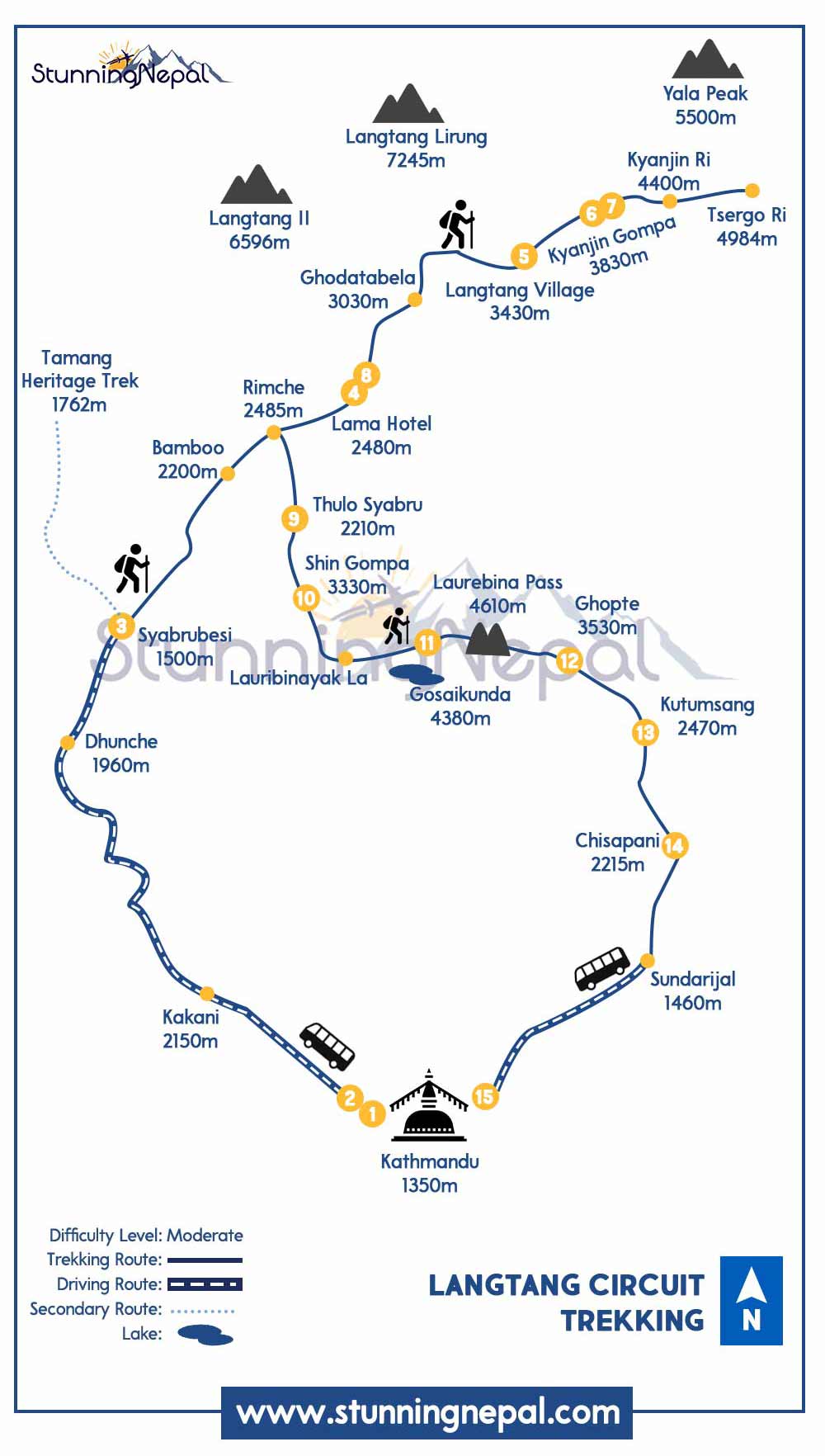
Langtang Trek Altitude Graph Map
There are various itineraries available for the Langtang Valley trek, and each may have a different altitude graph map. However, for the itinerary mentioned above, we will provide the altitude graph map accordingly.

Langtang Trekking Map
If you prefer a hardcopy trekking map of Langtang, you can easily find it in Kathmandu. Numerous shops sell different trekking route maps.
Maps are essential items that you need to carry while trekking. Additionally, you can find the Langtang Geographic map on Amazon.
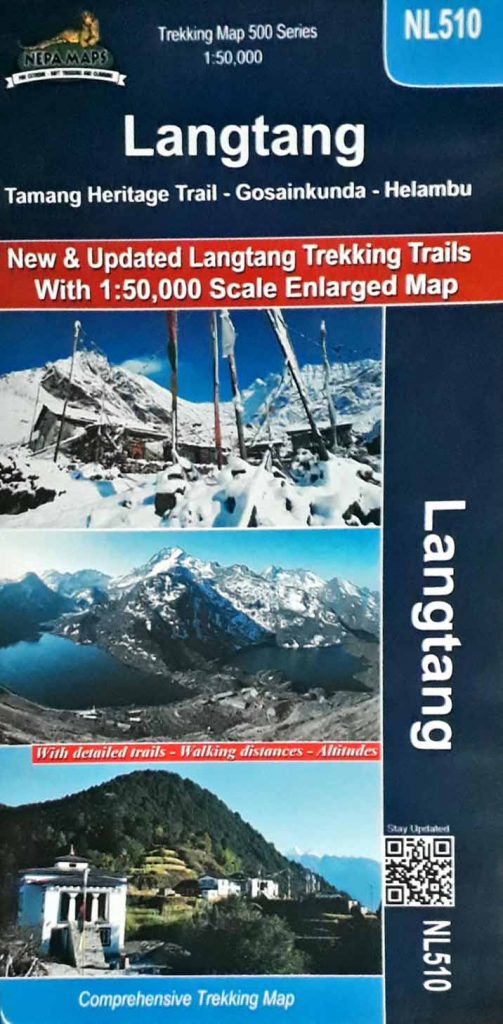
Famous Langtang Trekking Route
Apart from the Langtang Valley trek, there are other famous trekking routes in the Langtang region that you can explore while in Nepal. These include the Helambu Trek, the Gosaikunda Trek, and Tamang Heritage Trail. You can choose to trek to these places individually, or you can opt for a joint Helambu-Gosaikunda-Tamang Heritage trek.
1. Helambu Valley Trekking

Helambu region is a great and nearby place to visit from Kathmandu for a short trek . This place remains unspoiled despite being close to the Capital City. Helambu Trek is a glorious opportunity to explore the culture and tradition of the Sherpa community.
At peak season, you will get to see Rhododendron Forests, Snow-Capped Mountains, Waterfalls, Bamboo Forests, etc. The trek to Helambu starts from Sundarijal located at the eastern end of Kathmandu.
Helambu Trek Highlights
- Explore Buddhist Monastery.
- A glimpse of Snow-capped Mountains.
- Sunrise and Sunset over Mountains.
- Pass through dense rhododendron forest.
- Find unique Sherpa Culture and Lifestyle.
2. Langtang Gosaikunda Trek

Langtang Gosaikunda is an easy trek that is best for a picturesque view of the mountains and is famous for Gosaikunda Lake. Starting from Dhunche to Syabru Besi, Gosaikunda can be reached within 3-4 days.
This sacred lake is one of the holiest lakes famous among Hindus and Buddhists. Thousands of domestic and international travelers visit Gosaikunda Lake every year.
Gosaikunda Trek Highlights
- Beautiful Mountains Ranges.
- Gosaikunda Lake is one of the holiest lakes.
- Astonishing evergreen forests and landscapes.
- Flora and Fauna.
- Explore Lake like Nagkunda, Suryakunda, Saraswatikunda, and, Bhairabkunda.
3. Tamang Heritage Trail
Tamang Heritage Trail is an easily accessible trek from Kathmandu Valley. You will find beautiful Tamang village and tourism in this area has helped to uplift the lifestyle of the people.
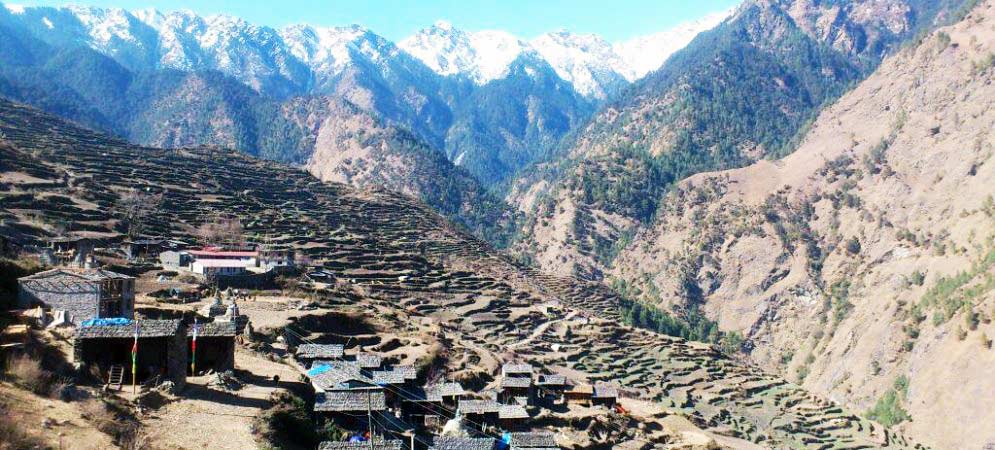
Tamang Heritage is a moderate-difficult trek, and after the earthquake, the route was closed. But now, the route is re-opened, and also hire a local guide to explore more about this heritage trail.
Tamang Heritage Trail Highlights
- Explore traditional houses.
- Culture and Lifestyle of Tamang and Sherpas Community.
- View the highest point Nagthali Pass (3,165 meters).
- View snow-capped mountains Ganesh Himal (7,429 meters), and Langtang Lirung (7,245 meters).
Trekking Gear
This is the most crucial section of this guide. Gears are vital aspects if you are going for short or long trekking. Sometimes backpacking is difficult if you are unfamiliar with the weather condition of a particular place.
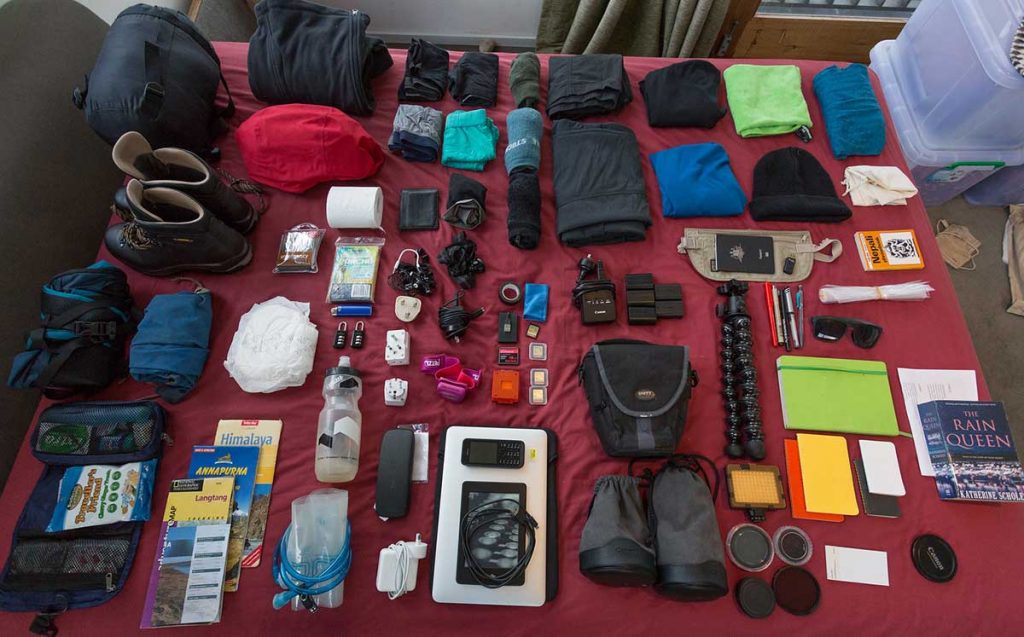
Actually, You don’t have to carry all the trekking gear from your hometown. You can find hundreds of trekking shops in Kathmandu. The shop generally sells or rents the gear items at a low price.
But bring the basic stuff like a hiking boot, Trekking Bag, etc. from your country. Trekking Shop in Kathmandu commonly rents gloves, jackets, Sleeping Bags, etc.
Hiring a Guide and a Porter
Most people love to go hiking or trekking with a guide and a porter. A porter helps to carry your goods so that it will be easier for longer hiking at a higher altitude. Generally, a guide helps to make you more comfortable in a newer place.

Make sure that your travel agency is registered with the Nepal Tourism Board (NTB) and Trekking Agencies Association of Nepal (TAAN). Besides that, you also need to make sure that your agency has a certified guide.
Langtang Trekking for Female Travelers

Nepal is safe for both male and female travelers. For female trekkers, you need to be extra careful while exploring different places.
Sometimes, it will be different situations as every country has its own culture, languages, and lifestyle. So always respect it and be sure you follow them.
Always be careful about the dress code while in Nepal. Also, don’t forget to hire a guide and never go outside alone in the evening time.
Additionally, if you feel uncomfortable with a male guide, then you can hire a female guide too in Nepal and also read our guide for Female Travelers .
Langtang Valley Trek Without Guide
It is always true that you need to hire a guide and porter to be safe while trekking the Langtang region.
Moreover, if you don’t have any prior experience with solo trekking, then this trek might be much more challenging.
Actually, Solo traveling means gaining more experience and knowing the place better. Although, It is best to hire a guide with a porter so that they can carry your luggage and make trekking much more fun.
But, if you are thinking of trekking Langtang without a guide, then be sure about everything, including routes, weather, hotels, and other things.
Then, it is good to explore the Langtang Trek independently starting from the capital city, Kathmandu.
Moreover, most travelers don’t know the Nepali language, but if you have a little bit of experience with it, then it will be much easier. Though, most of the people here at hotels can understand the standard English Language.
Langtang after Earthquake
In the year 2015, Nepal was hit by a devasting 7.8 Magnitude earthquake. Among various affected areas, Langtang was one of them, and her home and the lives of people were deeply affected.
The earthquake hit some parts of this trekking route and moreover, teahouses and guesthouses were destroyed. The avalanche buried the entire village. Therefore, the trekking route was closed for a long time.
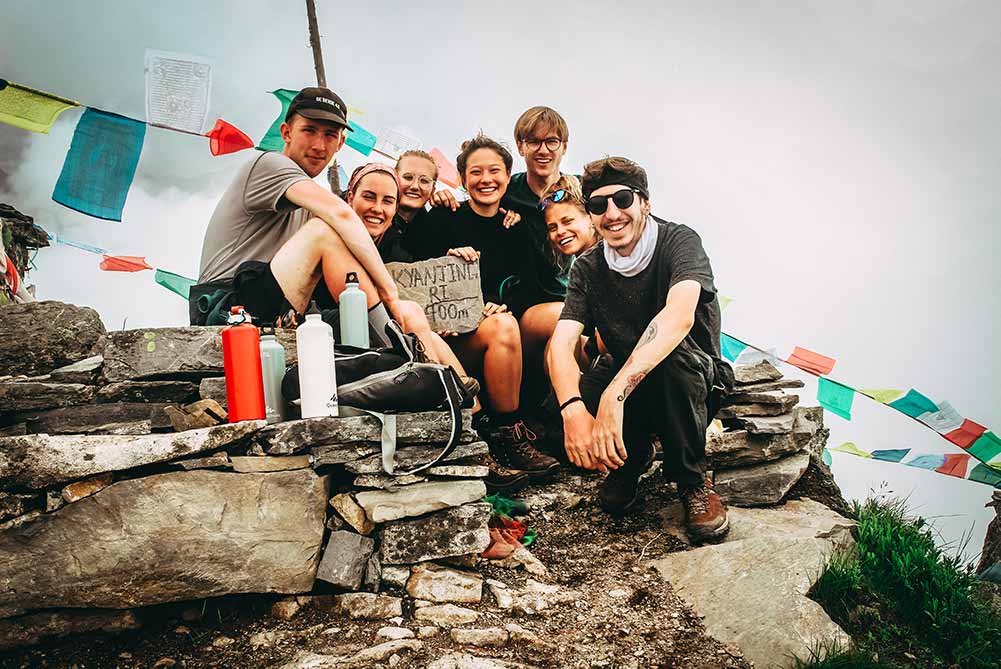
But, now the Nepal Government has reopened this route for trekking. Presently, the Lives of People at Langtang have recovered from the earthquake. The route is good, and you don’t have to worry about it. Also, you can contribute economically to revive the life of the local people.
Nepal Trekking Insurance
While traveling in any part of the world, insurance is a must because no one knows the future. It is essential to have insurance while trekking and traveling to Nepal. Most insurance is necessary when you are going hiking, trekking, climbing, or on an expedition.
Is it necessary to have trekking insurance while visiting Nepal?
Trekking insurance is one of the crucial things while traveling. Nepal is best for hiking and trekking as you can find various routes with easy to hard difficulty levels. So, if you are unfamiliar with hiking and trekking, then we advise going for insurance.
There are different types of insurance policies, and you can take benefits from them. So if you are a solo traveler, then you can go for personal insurance. Also, if you are a group of travelers, then you can also go in bulk too.
Langtang Valley Trek Cost for Nepali
If you want to know the price for the Langtang Valley trek then the cost of the trek ranges from Rs. 15,000 – 20,000. But the cost may vary depending upon the group size, food, and accommodation you take during the trek. Be sure to carry extra money, it will be helpful in case of emergencies and other stuff.
The duration of the trek is 5-7 days that starts from Kathmandu. It is best to manage a group of up to 10 people so that it can be comfortable going for the trek.
So, if you are your friends are looking for a unique trekking experience, be sure to put the Langtang Valley Trek at the top of your list!
Frequently Asked Questions
Which Nepal trek is best?
There are many attractive places in Nepal for trekking. Some of the popular trekking destinations are Everest Base Camp and Annapurna Base Camp . Besides, this Langtang Valley Trek is another popular trekking destination in Nepal. It is the magical and unspoiled trek of Nepal.
How long is Langtang Trek?
Normally, if you have less time, then you can go for 7 days trekking, but if you are searching for an extended version, then you can go for 20-22 days trekking.
Can you trek without a guide?
Basically yes, you can go Langtang trekking without a guide. As said by a local guide, the level of this route starts from Easy to Moderate. So, it is possible without any guide. But we recommend you hire a guide for safekeeping.
How safe is Langtang Trek?
After the devasting earthquake in 2015, the route was closed by Nepal Government, but now the route has been completely changed and re-opened for trekking moreover, it is much safer for trekking.
How much does it cost to trek to Langtang Valley?
It depends upon the trekking days and the travel agency itself. There are lots of factors behind the cost. The estimated cost for the Langtang Valley Trek is between $600-$1000.
How difficult is the Trek?
Trekking Levels are generally graded in 4 parts: Easy, Moderate, Difficult, and Strenuous. The Langtang Valley Trek is a moderate difficulty trek. Most trekkers can finish the Langtang route easily.
How many hours a day do I have to walk during the Trek?
The average walk time is around 5-6 hours a day. So, be prepared mentally and make yourself stronger physically to finish the Langtang Trek.
Do I need a permit for the Langtang Trek?
Yes, you need Trekker’s Information Management System (TIMS) card which must be issued by the Tourism Board. TIMS card must be presented at the entry point at Langtang Gateway.
Will I get altitude sickness on the trek to Langtang?
The range of this trek is moderate. So, there is a low chance of getting altitude sickness, but be sure to take precautions while advancing to a higher altitude.
Can I charge my phone and camera battery during Langtang Valley Trekking?
For electricity, solar panel powers the village, and you get an opportunity to charge your camera battery or cellphone, but you have to pay an extra charge of around $1-$3 per hour. But be sure to carry a portable power bank during the trek to charge up small devices like phones. Also, you can use a portable led USB light using a power bank that comes in handy during the journey.
Is there WiFi on Langtang Valley Trek?
There are WiFi services available in different guesthouses/teahouses. There is around 90% of the area where can use WiFi but you have to pay extra money to use it.
Can I use the ATM during Trek?
Usually, in Langtang Areas, it is difficult to find an ATM lounge. You can use an ATM and Credit Card in Capital City, Kathmandu. It is the best idea to take cash with you if you are exploring rural areas.
Can I hire a local guide during Trek?
Basically, the Travel Agency will arrange a local guide and porter for the whole trek to make your trekking fun and colorful.
We almost have mentioned all the details like the best time to visit, routes, itinerary, Price, Altitude Graph, Trekking Map, etc. So I hope you liked our ultimate guide to Langtang Valley Trek .
If you have a long holiday to spend in Nepal, then you can go for an extended Langtang tour but if you have short vacations then keeping the itineraries tight you can go for 7 days trekking.
If you have any questions/feedback regarding this trek, then please feel free to comment or contact us.
Love this post. Pin it for later
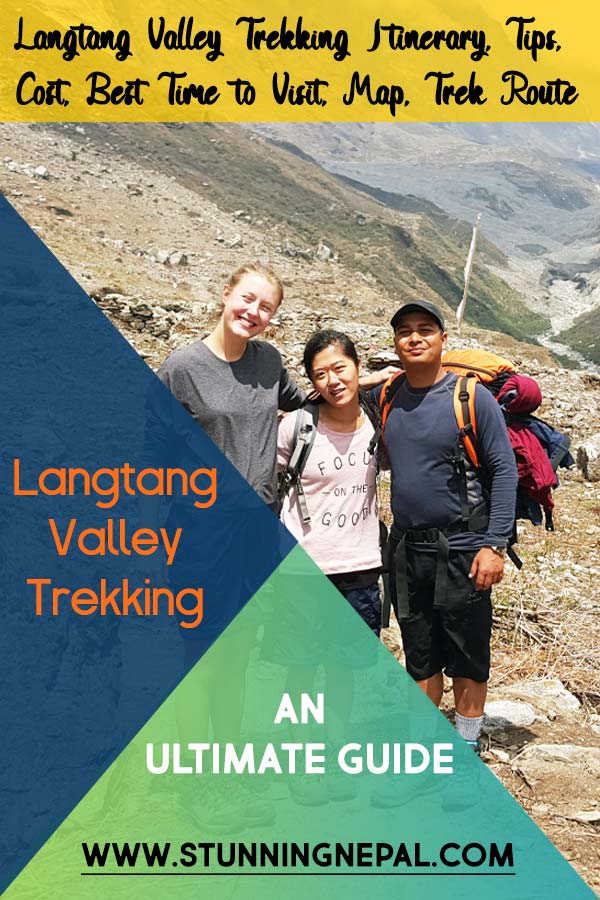
Suraj Katwal
Suraj is a travel enthusiast who believes in finding solace in the heart of nature. He enjoys exploring new destinations, different culture, and encouraging people to travel.
Travel Resources
Hotel & Flight
Searching for the best hotels & flight tickets to visit Nepal? Check out the best deals.
Related Articles...
5 Best One Week Treks in Nepal
Annapurna Base Camp Trek Cost for Nepali
Annapurna Base Camp Trek vs Everest Base Camp Trek
30 Interesting Facts About Mount Everest
Why is Annapurna so Deadly Mountain?
How to Find Travel Agency for Everest Base Camp Trek?
Annapurna Base Camp Trek Weather
Top 5 Family Trek in Nepal
1 thought on “Langtang Valley Trek – Best Time, Cost, Route, Itinerary”
Thanks for sharing very well-written and worth reading this article. Wish to see more in the coming days.
Leave a Comment Cancel reply
About stunning nepal.
Stunning Nepal is a travel blog that intends to provide travel tips, references & guides, things to do & also your guide for hiking & trekking in Nepal.
Travel Guide
Things To Do
Food and Festivals
Privacy Policy
Get in Touch
Stunning Nepal
Address: Dhanawantari Marg, Kathmandu 44600, Nepal
+977-9808211139
© 2024 Stunning Nepal. All Rights Reserved

The Langtang Trek Itinerary: the ultimate guide
This post offers you the ultimate Langtang Trek itinerary. The Langtang trek is a beautiful multi day hike in the Bagmati province of Nepal . An area that is 51 kilometers north of Kathmandu . Making this an easy and accessible trek for those that love to see the Himalayas, but have limited time
The Langtang trek brings you to a beautiful valley at the foot of the snow capped mountain peaks of Kyanjin Ri and Langtang Lirung. All are part of the Langtang National Park.

Why choose the Langtang Trek?
So why choose the Langtang trek? My first response would be, because it is a very beautiful and diverse hike. The Langtang trek starts in lush forests where you might see langur monkeys or red panda’s and ends in the alpine meadows of Kyanjin gompa where yaks wander around.
Culturally it is also an interesting hike as you pass by multicultural villages with Tamang and Sherpa communities. Most ethnic groups along the Langtang trek are of Tibetan origin and follow Buddhism.
The Langtang trek is one of the shortest tea house treks in Nepal and brings you to beautiful high altitude mountain sceneries in just a few days. Perfect if you are short on time, but if you prefer a longer hike it is easy to combine the Langtang trek with the Gosainkund lakes and the Helambu circuit.
The Langtang trek is also a sustainable choice as you do not need to fly to reach the start of the trail. Syabrubesi is an 8 hour bus journey from Kathmandu. Despite all these advantages, the Langtang trek gets relatively few visitors compared to the Everest and Annapurna regions. If you want to avoid the crowds, Langtang is a great destination.

The Langtang Trek and the earthquake
The Langtang area was hit hard by the earthquake in 2015 when a deadly avalanche completely destroyed Langtang village. The families that survived slowly rebuilt their lodges, but then covid came. If there is one area in Nepal where people can really benefit from the return of tourism, it is on the Langtang trek.
I did the Langtang trek in 2010. Long before the earthquake hit the area. The Langtang village that I visited and stayed at, no longer exists and is still buried under the avalanche. Survivors moved to Kyanjin gompa, but a new Langtang village is built 100 meters above the old one.
As of now, the Langtang Trek is open again and there are enough lodges in the new Langtang village to receive trekkers.

Langtang Trek Itinerary
In this Langtang trek itinerary I mention every day the amount of time it took me from start to finish. I am a slow hiker though. I like to take frequent breaks to enjoy the beautiful views.
If you are a fit hiker, you can probably do it in less time
Day 1: Bus from Kathmandu to Syabrubesi
You need the first day to get from Kathmandu to Syabrubesi, the start of the Langtang trek. Like any bus journey in Nepal , it is a long and bumpy ride over winding mountain roads. Delays are common with frequent breakdowns or landslides blocking the road.
In theory, the bus journey to Syabrubesi takes around 8 hours. In practice, it often takes much longer. Buses stop everywhere to let in new passengers. Up till the point that the only place left for more people is on the roof.
My bus was half empty when we left Kathmandu, but one hour later was totally packed. As we left the city behind us the views got more beautiful and soon the peaks of the Himalaya were in sight.
Right before Dunche there were some scary parts with steep cliffs right next to the road. Even the Nepali lady next to me was afraid.
After 9 long hours I finally arrived at Syabrubesi. Because it was late in the afternoon I decided to stay the night.
Logistics : Buses and shared jeeps to Dhunche and Syabrubesi leave everyday from the Gongabu bus station (new bus park or Machapokhari) in Kathmandu. Get there early as it is a chaotic bus station and buses to Langtang leave between 6 – 8 AM in the morning. It is best to reserve your tickets a day in advance at the bus station or at a travel agency in Thamel.
Insider tip : there are delux buses that are slightly more expensive, but don’t stop everywhere to let in new passengers. Shared jeeps are also slightly faster. The best option are private jeeps, but they are expensive ($150+)

Day 2: Syabrubesi (1492) – Lama Hotel (2447)
15 kilometers, 7 hours, altitude gain 1070+
The first day of the Langtang trek is also one of the most difficult days of the trek as you gain more than a 1000 meters in altitude. It starts with a 3 hour gentle climb up to Bamboo village.
Bamboo village is about halfway and a great place for a lunch break. After Bamboo the climb gets more steep, but is still not too difficult if you take it easy.
Overall, I really enjoyed my first day. Most of the day is right next to the Langtang river and through lush forests where I saw langur monkeys in the trees. In total it took me little over 7 hours to reach Lama Hotel or Changtang village. A cluster of lodges in the forest.

Day 3: Lama Hotel (2447) – Langtang village (3430)
14 kilometers, 6 hours, altitude gain 980+
The second day of the Langtang trek is another day of long ascents. The first half of the day is still next to the river and through the forests. However, after 3 hours you leave the forests behind you and enter the beautiful Langtang valley.
Ghodatabela is midway and a great place to stop for lunch. From here you have beautiful views on the snow capped mountain peaks of the Himalayas. The second half of the day is through the glacial valley past small rural villages.
Langtang village used to be the largest and oldest village in the Langtang valley. Famous for its yak yogurt and yak cheese. Langtang village was swept away by an avalanche in the 2015 earthquake. Slowly a new village is built and there are a number of new lodges to stay the night.

Day 4: Langtang village (3430) – Kyanjin Gompa (3900)
7 kilometers, 4 hours, altitude gain 470+
The third day of the Langtang valley is the shortest and only has a small gain in altitude. I did feel the ascent more than the previous days though which probably had to do with being over 3000 meters high.
I felt tired easily and was more quickly out of breath. Therefore, I had to take frequent breaks. Stil, I enjoyed every step I took because of the spectacular views. Between Langtang village and Kyanjin gompa are a few yak herding villages with visible buddhist influences such as ancient mani walls and stupas.
Kyanjin gompa was the most lively village I visited in the Langtang valley. Yaks and horses were grazing in the fields, children were playing outside and women walked outside carrying buckets of yak milk.
Kyanjin gompa is a good place to try yak yogurt or yak cheese and the yak cheese factory is definitely worth a visit.

Day 5: Kyanjin Gompa
Kyanjin Gompa is a great place to stay for at least one day to explore the valley. For half day hikes you can choose between the peaks of Kyanjin Ri and Tsergo Ri that both offer beautiful viewpoints. The hike up to the summer yak pastures of Langshisha Kharka is a long and challenging day trip.

Day 6: Kyanjin Gompa – Lama Hotel
20 km, 8 hours, altitude loss -1440
The sixth day of the Langtang valley trek was a very long day walking back from Kyanjin Gompa all the way to Lama Hotel. At Ghodatabela I was doubting whether to stop and still had energy, but I miscalculated the time it took to reach Lama Hotel. Being alone in the forest with misty clouds in the mountains and the sun setting was very beautiful, but I was glad to reach the warmth of my guesthouse just before dark.

Day 7: Lama Hotel – Syabrubesi
15 kilometers, 7 hours, altitude loss -1070
The seventh day of the Langtang valley trek I felt a bit sad that this would be my last day of hiking. I loved being back in the forests and once again saw langur monkeys. It felt too soon for my lunch break at Bamboo and my arrival at Syabrubesi.

Day 8: bus back to Kathmandu
Going back to Kathmandu after trekking in the mountains of Nepal always brings mixed feelings. Of course I am looking forward to the comforts and delicious foods in Kathmandu, but at the same time I am missing the mountains as soon as I take my seat in the bus back.

The Langtang Trek Travel tips
Langtang trek permits.
For the Langtang trek you need two permits.
TIMS card : The Trekkers information management card is necessary for almost all treks in Nepal. You can get your TIMS card at the Tourism Board office at Bhrikuti Mandap in Kathmandu. Bring your passport and two passport size photos. The TIMS card costs 2000 nepalese rupees.
National Park Entrance permit : For the Langtang trek you also need a national park entrance permit. Although you can get this at the checkpoints in Dunche and Syabrubesi I recommend you to get it as well at the Tourism Board Office at Bhrikuti Mandap in Kathmandu. This costs 3000 nepalese rupees plus 13% VAT.
Do I need a guide on the Langtang Trek?
The Langtang trek is moderately difficult, but easy to do without a guide. There is one trail to follow and it is hard to get lost. Unless you go off season there will be enough other hikers on the trail to keep you company.
If you are alone and not that experienced you might want to consider joining a guided trek or hiring a guide, porter or porter guide.
In Nepal there is a clear distinction between a porter and a guide. A guide shows you the way and can tell you more about the history and the culture of the places you visit. A porter will only carry your luggage. Despite their heavy burden they often walk far in front of you and might have reached the lodge when you are only midway. A porterguide is less common, but does both.
If you prefer a female guide I can recommend the 3 sisters adventure trekking that works to empower women and trains women to become trekking guides in Nepal.
Update April 2023 : The Nepal Tourism Board issued a press release that trekking without a guide is no longer permitted from 1 April 2023 onwards. Trekkers planning to hike in Nepal’s National Parks where you normally need a TIM’s card should have a government licensed guide that is registered with the official Trekking Agency Association of Nepal (TAAN) . It is unclear yet how this rule will play out in practice. Everest issued a press release stating that they will not enforce it. Other areas do. However, there are no guidelines on how they are going to implement the ban on solo trekking .

Accomodation on the Langtang Trek
Along the Langtang trek there is plenty of accomodation and teahouses to choose from. They are rather basic compared to other treks like, The Gokyo Lakes , Poon hill trek or the Annapurna Circuit . They can’t be booked online beforehand. There is a first come first serve basis and some lodges are fully booked by big tour groups.
At the regular stops like Lama Hotel, Langtang village and Kyanjin Gompa there are enough lodges that there will always be a bed for you somewhere.
The prices of accomodation is incredibly cheap, sometimes even free, but they do expect you to order dinner and breakfast at their establishment.

Food on the Langtang Trek
The good thing about tea house treks in Nepal is that however basic lodges might be, the food is often quite good if you stick to Nepali cuisine. Yes, many lodges try all kinds of international dishes to attract tourists, but in my opinion often not the best choice.
When trekking in Nepal I eat Dahl bath at least once a day. This national dish of rice with lentils knows a huge variety. Different vegetable curries from fermented spinach to roasted cauliflower and different pickles to spice it up. Not one dahl bath is the same.
Other Nepali foods to try are Tibetan bread, Thukpa and Momo’s.

When to hike the Langtang Trek
The best time to go trekking in Nepal is spring and autumn.January and February will be too cold with lots of snow on the trail. March, April and May are the warmer months before the monsoon. As the rainy season approaches it can become hot, dusty and humid, but this is not a problem at the higher altitude Langtang valley. Another highlight in spring are the blooming rhododendrons
June, July and August are the monsoon months bringing lots of rain and leeches at the lower altitudes. The biggest problem regarding the Langtang trek is the high chances of landslides on the road from Kathmandu to Syabrubesi and muddy trails.
September, October and November are the most popular months for trekking. Autumn brings clear blue skies and mild temperatures before the cold sets in in December. Autumn is also a festive season with the celebration of Dashain and Tihar . Nepal’s biggest festivals .

Altitude Sickness on the Langtang Trek
The Langtang trek involves a rapid gain of altitude with Syabrubesi at less than 1500 meters high and Kyanjin gompa at 3900 meters high. Experts advise to not ascend more than 300 – 400 meters per day once you are above 3000 meters high. This Langtang trek itinerary actually ascends a little bit more than that and therefore it is important to be cautious of altitude sickness.
The key to prevent altitude sickness is to take it slow, give your body enough time to adjust to the height and to drink enough water. Diamox is a medicine that might help your body to acclimatize, but will not cure altitude sickness once you have severe symptoms. In that case, the only remedy is to go down to a lower altitude as soon as possible.
Mild symptoms may include being tired and more easily out of breath. More severe symptoms of high altitude sickness are headache, dizziness, trouble sleeping, breathing problems, loss of appetite and nausea.
Take these symptoms seriously and watch out for symptoms in others, even in your nepali guides or porters. It is a misconception that they cannot get altitude sickness.
Langtang Trek Books and Guides
Cicerone and Trailblazer both have excellent and comprehensive guides about treks in Nepal. Unfortunately their guidebooks about Langtang are out of print and somewhat outdated. Still, if you can get one of those I would certainly recommend it.
Another option is the Lonely Planet’s trekking in the Nepal Himalayas guide. However, even the newest version was released shortly after the earthquake and lots of things have changed in Langtang since.
Langtang Trek packing list
If you need to carry your own gear on a multi day trek the advice is to bring as little as possible. The Langtang trek is not difficult and there is no need to bring a tent or food. Below a few things to consider
Sun protection : no matter what time of the year, you will need to bring protection against the sun. Sunscreen and a hat are a must.
Rain protection : there is always a risk of rain. I brought a poncho along that protected both me and my backpack from the rain.
Sturdy shoes : There is no need for proffesional hiking boots. However, there are rocky trails. Bring sturdy shoes that fit you well. Don’t bring brand new shoes. Make sure they are tested and comfortable to prevent blisters.
Hiking socks : Besides good shoes, hiking socks are key to prevent blisters. Merino wool socks are lightweight and dry quickly. Wrightsocks are specially designed with double layers to prevent blisters. Decathlon has good merino wool socks too.
Layers : there can be a big difference in temperatures during the day and night. The best way to deal with this is to wear layers. As a base layer I bought merino wool tshirts. I had a fleece vest as a midlayer and as the upper layer I had a windproof jacket.
Backpack : Your shoes and backpack are two things that will have a big influence on the comfort of your multi day trek. I recommend to go to an outdoor store to get some good advice to buy a backpack that fits your torso length and that is comfortable when you wear it. I own the Osprey Fairview trek 50 that I am very happy with.
Reusable water bottle : to prevent plastic waste I always bring a reusable water bottle with me and a water filter or steri pen.
Sustainable Travel on the Langtang Trek
Although the Langtang trek is not as crowded as other trails, tourism is increasing. The trails become more crowded and pollution is a growing problem. Traveling sustainably to the Himalayas is essential to minimize your environmental impact and preserve the area’s natural beauty for future generations.
Support the local community : You can support the community by purchasing goods and services from local vendors. It is better to try Nepali Cuisine that uses local ingredients rather than imported foreign foods. Nepali food is vegetarian friendly and it is very easy to follow a vegetarian or vegan diet.
Stay in small scale sustainable hotels : It is also better to stay in locally-owned guesthouses or homestays to support the local economy directly. These accommodations often have a more positive impact on the environment compared to large hotels.
You can try to look for guesthouses or homestays that prioritizes sustainable practices. That said, environmental awareness is still low. It’s up to you to use water sparsely, turn off lights, air conditioning, and heating when leaving your accommodation.
Leave no trace principle : When hiking the Langtang Trek, stick to designated trails to protect the fragile alpine ecosystem. Straying off the marked paths can cause soil erosion and damage to plant life. If you are lucky enough to spot wildlife, observe quietly from a distance to prevent disruption to their habitats and help maintain their natural behaviors.
I encourage you to take all your trash back with you and dispose of it responsibly. In other words, leave no trace of your visit. Even better is when you bring something to pick up any of the trash that other people left behind.
To avoid single-use plastics, invest in reusable items. For example, you can bring your own water bottle with a filter. At last, use biodegradable and eco-friendly personal care products to minimize pollution of water sources.
Respect the culture : Besides environmental concerns it is also important to be sensitive of the community’s way of life. Nepal is a multicultural country and on the trail you will encounter different ethnic groups.
People will appreciate it, if you dress modestly. Learning a few basic phrases in Nepali, can go a long way in building meaningful connections and to learn more about the local culture. Not everybody is happy to have their picture taken. When in doubt, ask permission.
Disclaimer : This post with a travel guide about the Langtang trek in Nepal contains affiliate links. If you buy any service through any of my links, I will get a small commission at no extra cost to you. These earnings help me to keep Backpack Adventures alive! Thanks for your support!

2 thoughts on “The Langtang Trek Itinerary: the ultimate guide”
Thanks for this great overview. It’s just what I was looking for
Hi! Happy to read it! Being a trekking – tourist guide, i want leave one suggesstion : While you stay a couple of days at kyanjing gumba, should not miss to hike to Tserku-Ri (4984m)
Leave a Reply Cancel reply
Your email address will not be published. Required fields are marked *
- Kale by LyraThemes.com.

- Best Hikes In The World
- Appalachian Trail
- European Hikes
- Nepal Hikes
- Patagonia Hikes
- See All Hikes
- Mount Kenya
- Mount Kilimanjaro
- Mount Toubkal
- See All Mountains
- South Africa
- New Zealand
- Switzerland
- United Kingdom
- Packing Lists
Langtang Valley Trek – One Of The World’s Most Beautiful Valleys
Asia , Nepal
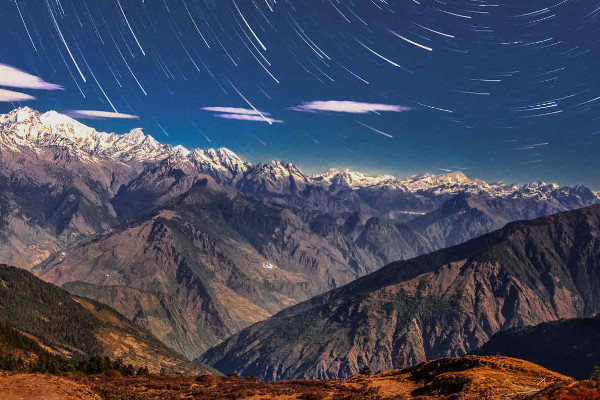
The Langtang Valley Trek is a relatively easy trek and is often far less busy than other popular treks in Nepal . The trek can be done in seven days; however, it usually takes 10 to 12 days.
On this page, you will find a comprehensive and impartial guide to the Langtang Valley Trek.
Langtang Valley Trek
Route overview.
The famed British mountaineer and travel writer, Bill Tilman (1898-1977), called this “one of the world’s most beautiful valleys.”
The local people in the Langtang Valley are mostly of Tibetan origin and, according to legend, the valley was first discovered by a lama – a teacher of Tibetan Buddhism – who was pursuing a runaway yak. “Lang” is Tibetan for “lama” while “tang” is Tibetan for “follow.”
The highlight of the Langtang Valley Trek is the sight of the Langtang Lirung range, which is simply stunning. The eponymous mountain is 23,773 feet high and dominates the valley.
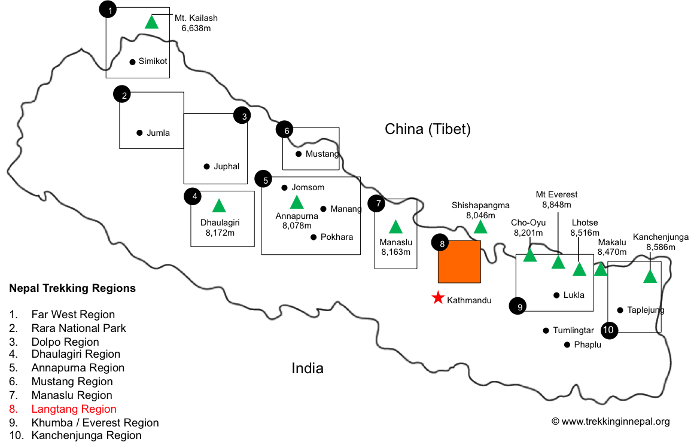
Langtang Regional Map
The Langtang valley region is in central Nepal, around 19 miles directly north of Kathmandu and near the border with Tibet. Although close to Kathmandu, closer than any other trek, this is as wild as it gets.
As you can see from the map above, the valley runs from east to west, sandwiched between the Himalayas to the north and the slightly lower Langtang Lirung range to the south.
Langtang Recommended Map
We believe the best map of the Lantang region is the Langtang & Helambu Map of the GHT which can be purchased online via Amazon. The map is produced based on data collected from the National Geographic Information Infrastructure Programme (NGIIP).
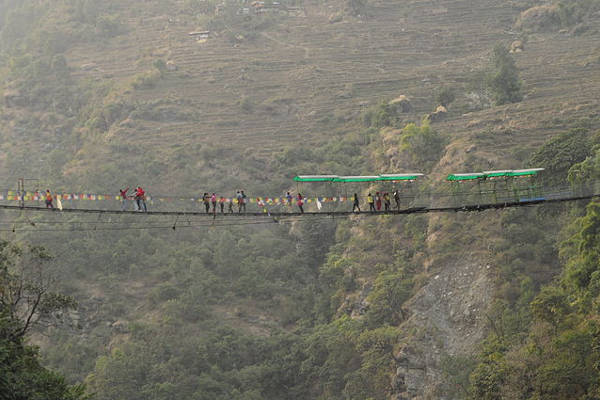
Langtang Trek Itinerary
It is possible to conduct this trek staying only at tea houses, but there is some time under canvas in this particular itinerary. There are several trek itineraries for this route, however, the one below is the most popular. You could also possibly arrange to meet your operator in Syabrubesi if you want to make your own way there.
Day 1-2: Arrive Kathmandu
You will arrive in Kathmandu on the first day.
You have the second day to spare while the provider arranges things. Kathmandu is a UNESCO World Heritage Site , so you could use the time to explore some the incredible local sites. Or you could do some last-minute shopping around the markets.
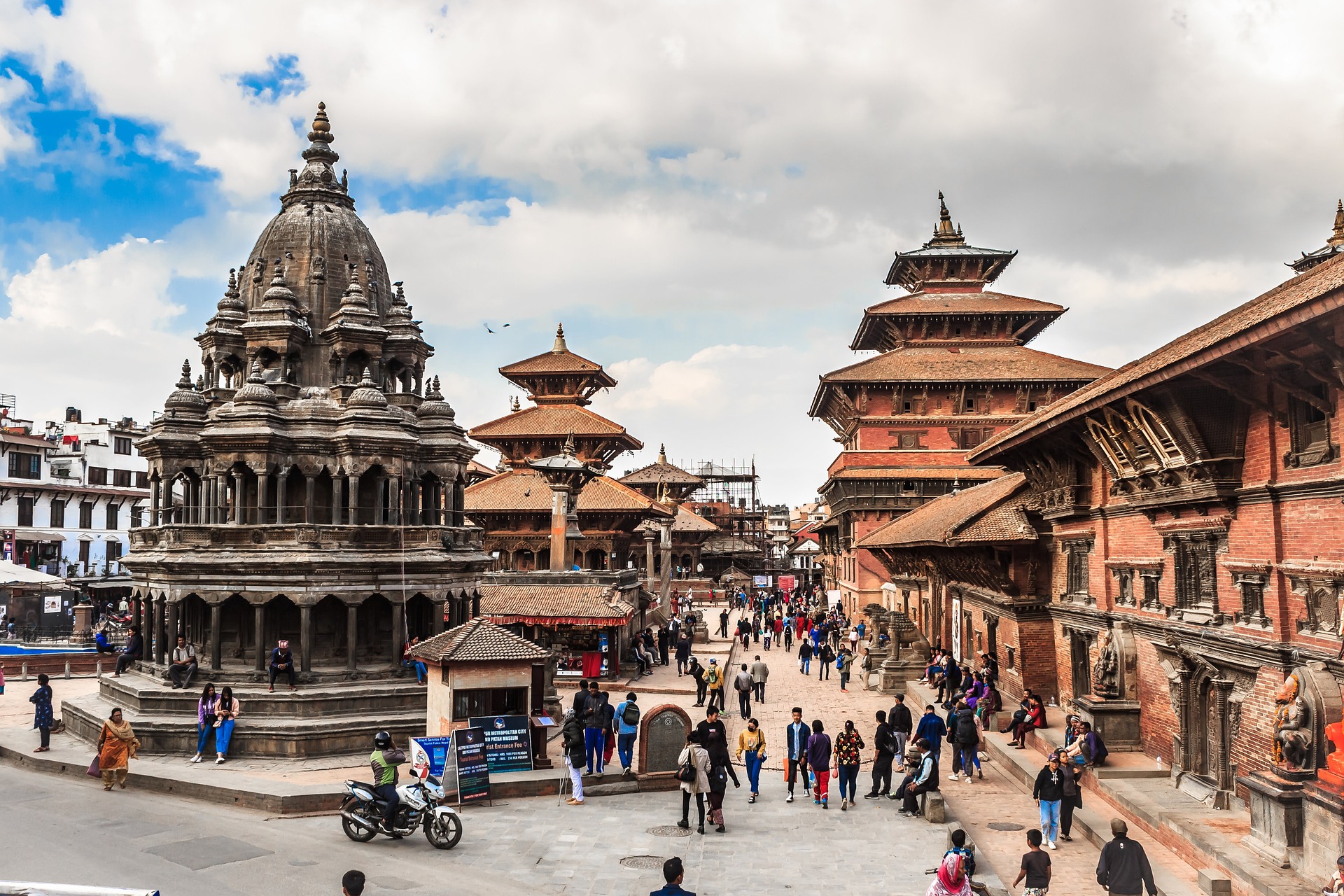
Day 3: Drive to Syabrubesi
Leaving early in the morning, you embark upon a seven-hour drive to Syabrubesi at the bottom of the Langtang Valley, the valley of glaciers. The second half is unpaved and the drive becomes quite rough. You might share a bus with goats and chickens. Sometimes, during the rainy season, the road is blocked by landslides.
The route is dazzling, passing through high ridges and with a marvellous panorama of the Himalayas that includes the Annapurnas, Ganesh Himal, Manaslu and the peaks of the Langtang range. There are many waterfalls and wild bee hives. You could also potentially see yellow-throated martins, Himalayan black bears or red pandas, which are endangered. There will certainly be no shortage of monkeys.
Day 4: Trek across the Bhote Kosi
Here, the trek begins properly. The trail takes you across the Bhote Kosi, which emanates from Tibet and lies in a deep gorge. You then climb through sub-tropical forests that teem with bird life, connecting to the trail from Syabru. One of these birds is the danphe, which is a colourful bird and the national bird of Nepal.
You will follow the river, ascending through uninhabited forests of oak and rhododendron, catching sight of langur monkeys if fortune smiles upon you. Vegetation becomes sparser as you go. You will camp overnight in a forest.
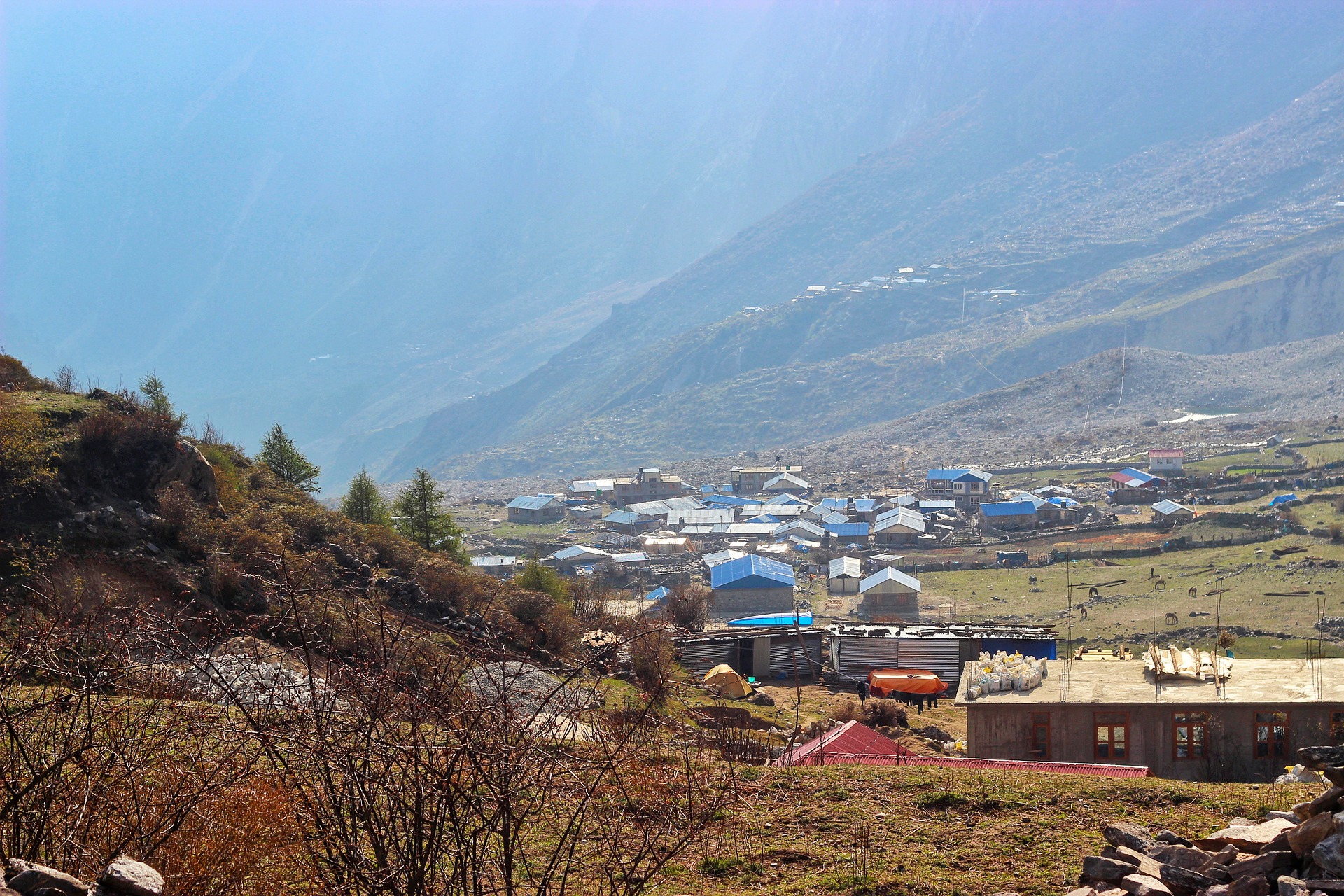
Day 5: Trek to Langtang
This day sees more climbing, with the occasional glimpse of Langtang Lirung visible through the trees. The trail leaves the forest at Ghora Tabela, now a Nepalese army post. The trail climbs comfortably, and the valley grows wider.
In summer, you will pass the temporary settlements of herders whose livestock grazes here. There are numerous chortens and mani walls, structures featuring inscriptions. In Tintin in Tibet , Captain Haddock was informed that you should always walk to the left of a chorten or demons will be released, but this was an invention of the author, so there is no cause for worry.
Shortly before the village of Langtang, there is a monastery for your delectation. The village is the headquarters of the Langtang National Park, which opened in 1976, the first in the Himalayas and the most unspoiled in Nepal. Houses there are of Tibetan style, with flat roofs and surrounded by stone walls.
Day 6: Trek to Kyangjin and onward
You will climb slowly through small villages and yak pastures. The valley opens, allowing for even better views. Having crossed a few small streams and moraines (patches of dirt or rock), before lunchtime, the trail arrives at the settlement of Kyangjin.
Here, there are facilities for the production of spiritual fulfilment and cheese: a small monastery and a famous government-owned factory. The factory makes Swiss cheese from yak milk and is supported by the Swiss government. Really, it should be called nak milk, as that is the female. This is just a small, three-roomed building, but it churns out prodigious quantities of cheese in summer. The snow-covered peaks in every direction make this spot very dramatic and beautiful.
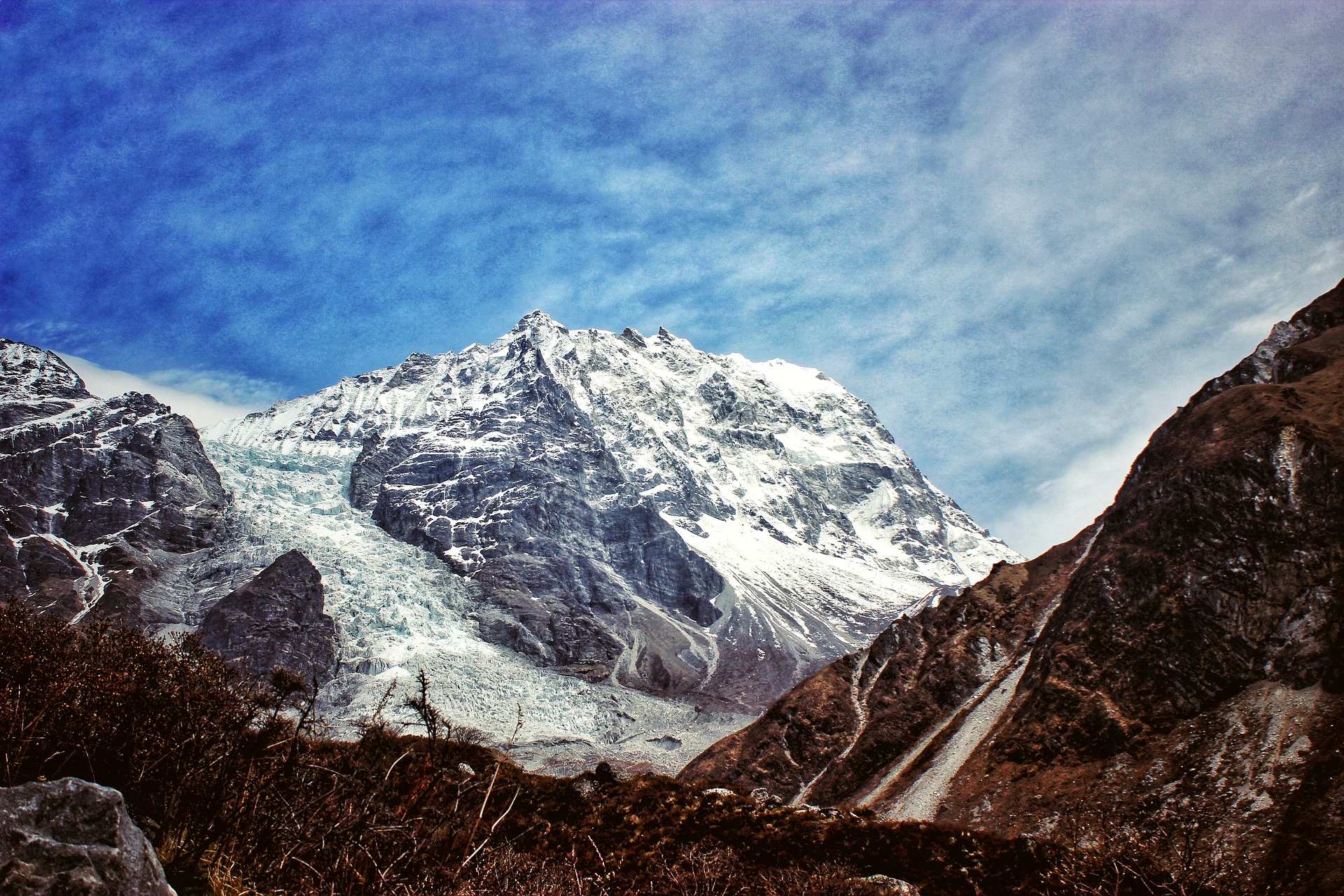
Day 7: Acclimatisation Day
This is a rest day which you will probably use to explore. The glaciers of Langtang Lirung are sensational. You could even summit Kyangjin Ri (14,209 feet), known locally as Brana Chumbo, which is immediately behind the village and provides a breathtaking 360-degree view of the Langtang peaks.
Day 8: Retrace route to Langtang
You will retrace your route towards Langtang village. The trail heads is down hill through forest following the river. You pass through ethnic Tamang settlements who strictly follow religious and cultural practices similar to that of the Tibetans.
Day 9: Return to Syabrubesi
You will continue the return journey, finishing at Syabrubesi. This is roughly a 5-hour walk and the easy trail goes mostly downhill through lush green vegetation.
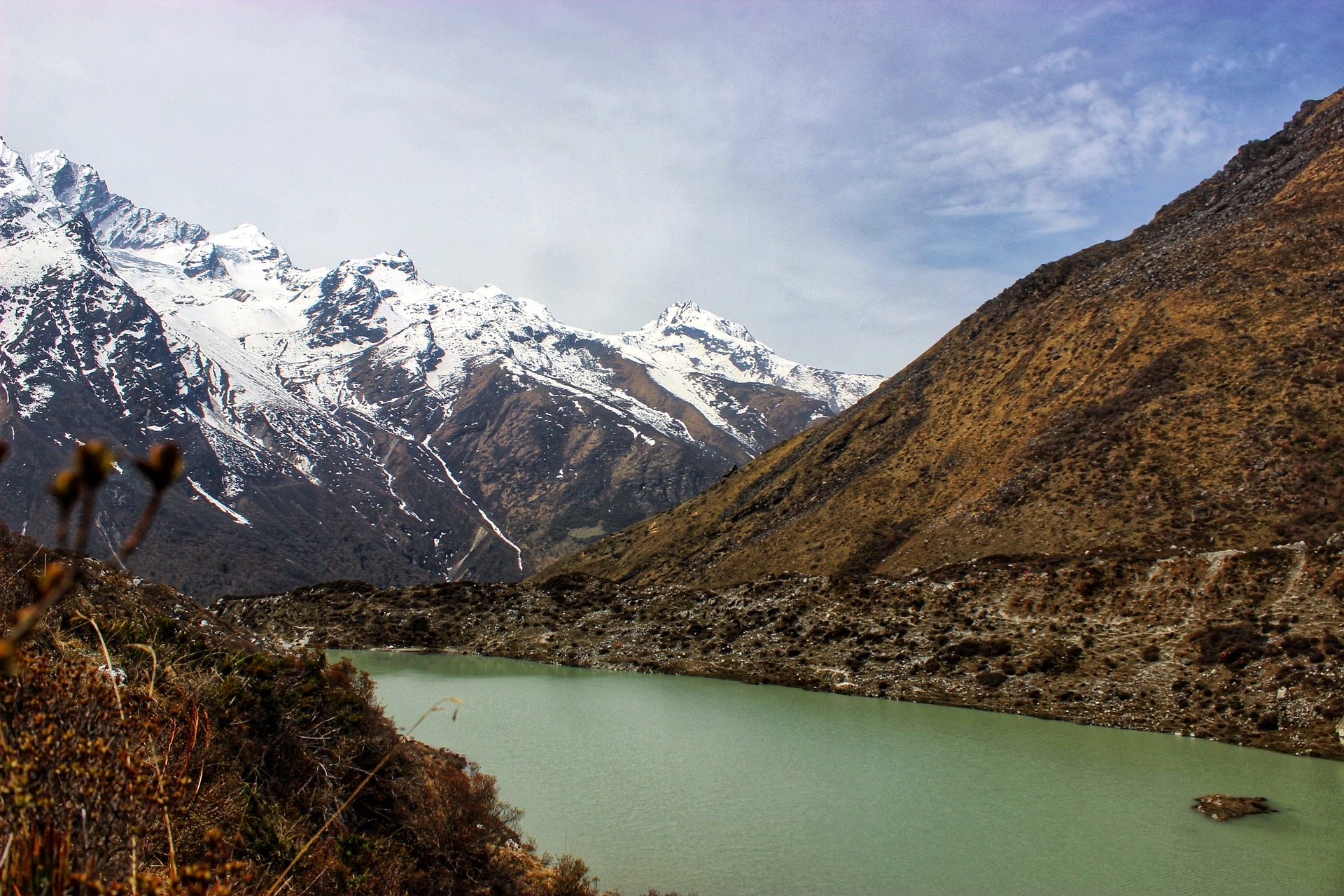
Langtang Valley Trek FAQ
How much does the langtang valley trek cost.
Costs for the Langtang Valley trek range from $1000 on the low-end to $2,000 on the top-end. Check out our list of the best trekking companies in Nepal .
Are permits required for the Langtang Valley trek?
You don't need a permit for the Langtang Valley Trek. However, you must be registered with the Trekkers Information Management system (TIMS for short) in order to do the trek. An entry fee of $30 is charged by the Langang National Park.
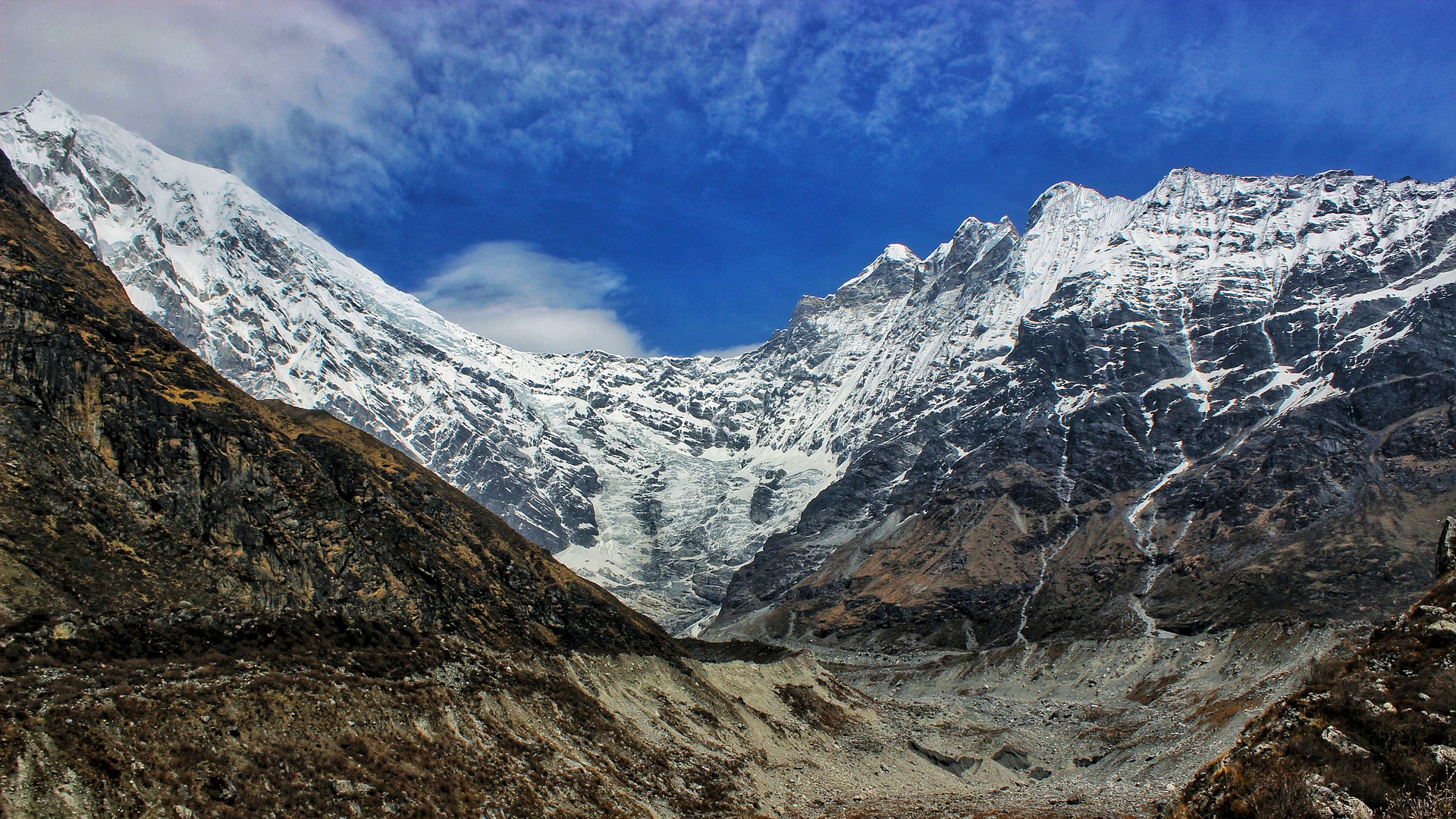
When is the best time to trek the Langtang Valley?
The best time to trek the Langtang Valley is Autumn, from mid-September to mid-December, and Spring, from March to May. These are considered the best seasons to hike in Nepal . when the sun is out during the day, but the nights are cold. Winter is also a possibility, if you don’t mind the cold.
Is altitude sickness a risk on the Langtang Valley trek?
Yes, altitude sickness is a risk because the Langtang Valley trek ascends to some high-altitude points. At its highest point, Tserko Ri, you will reach an altitude of 5,000 meters (16,347 feet). There are steep section on this trek where you will ascend fairly quickly.
Because of this, it is important to have a good understanding of the risks associated with high altitude trekking and how the body acclimatises to high altitude. We recommend you read our detailed article on Altitude Sickness and Acclimatisation .
How difficult is the Langtang Valley trek?
The Langtang Valley Trek is considered to be of moderate difficulty. There are steep sections that require a good level of fitness; however, the trek is relatively short and most people with a good attitude and high level of determination should be okay.
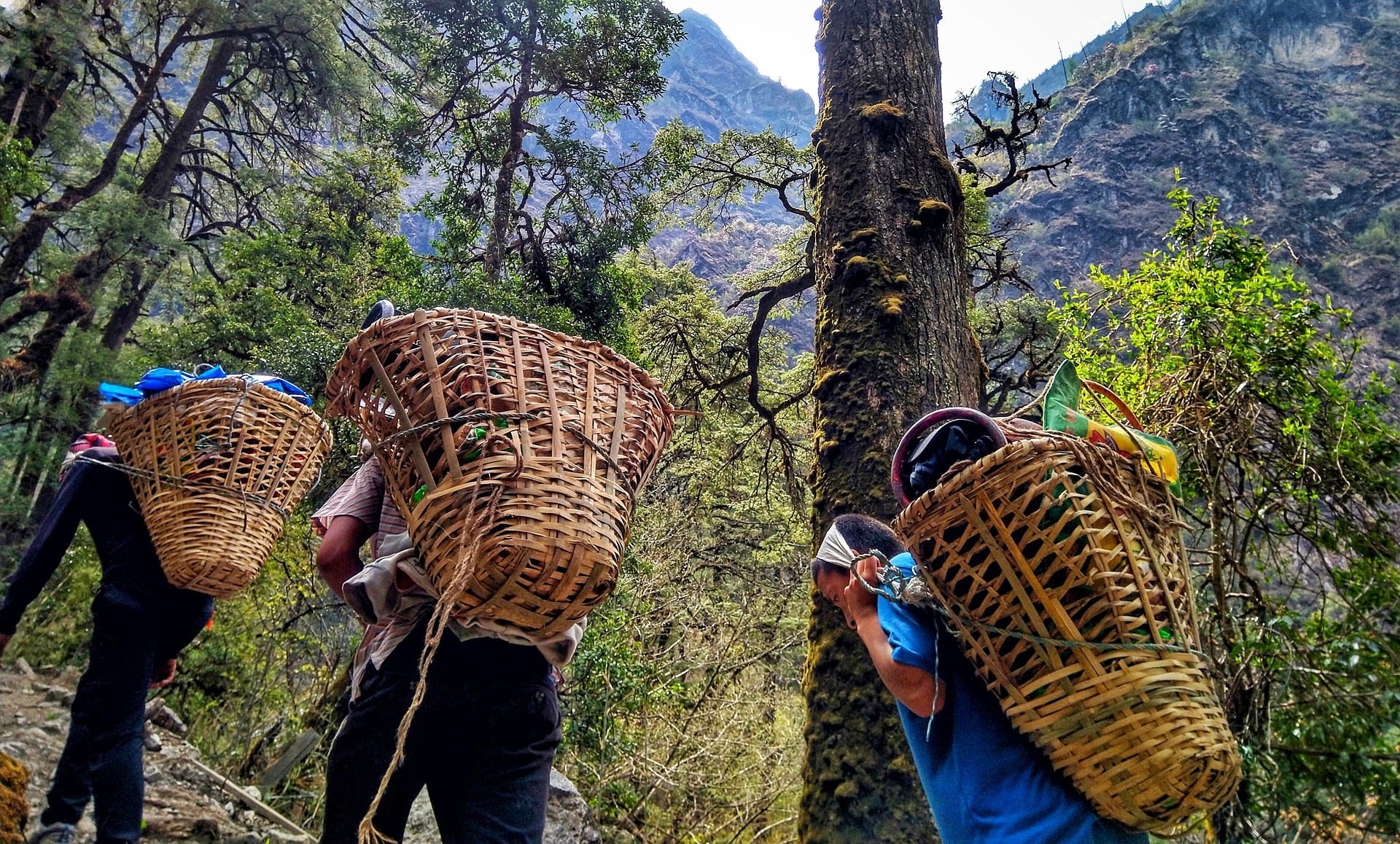
What gear do I need for the Langtang Valley trek?
Trekking the Langtang Valley requires a number of essential pieces of trekking gear and equipment. It is a long and moderately difficult trek, exposing you to a range of altitudes where temperatures fluctuate dramatically between night and day.
Much of your gear can be rented or bought in Kathmandu, but we strongly suggest bringing the most important pieces of gear and equipment with you.
To help you plan and prepare for your trek, we recommend reading our hiking packing list . Also, dont forget to take out good travel insurance for Nepal .
Are there any recommended guidebooks for the Langtang Valley trek?
Yes, there are several recommended guidebooks for the Langtang Valley trek. The Langtang Valley trek appears in many guidebooks which you use before and during your trip.
We highly recommend A Trekking Guide to Langtang: Gosainkund, Helambu and Tamang Heritage Trail by Sian Pritchard-Jones and Bob Gibbons. If this guidebook isn’t available, then Trekking the Tamang Heritage Trail of Nepal by Alonzo Lucius Lyons is very good too.
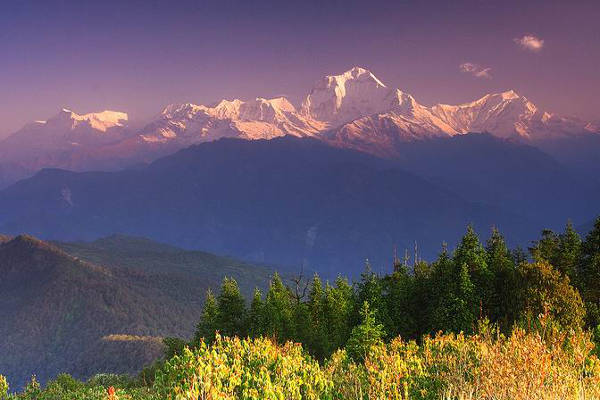
Continue browsing
See more information on Nepal . Or check out these other Nepal hiking articles:
- Short Nepal Trails
- Kala Patthar Trek
- Annapurna Circuit Hike
- Everest Base Camp Trek
- Trekking the Khumbu Valley
- Island Peak Hiking Guide
- Hiking to Rara Lake
- Limi Valley Trek
- Rolwaling Trekking Guide
- Panchase Hike
- Dhaulagiri Circuit Trek
- Trekking the Jomsom Muktinath
- Hiking to Kanchenjunga Base Camp
- Mera Peak Trek
- Helambu Hiking Trail
- Mustang Circuit Trek
- Gokyo Lakes Hike
- Trekking to Makalu Base Camp
- Gosainkunda Trek
- Ghorepani Poon Hill Trek
- The Royal Trek
About the author
Mark Whitman
Mark has trekked extensively in Asia, Europe, South America and Africa. He founded Mountain IQ in 2014 with the sole aim to be the best online information portal to some of the most popular mountain destinations around the world. When not writing for Mountain IQ, Mark is out exploring the outdoors with his wife!
Leave a Reply
Your email address will not be published. Required fields are marked
We work with local guides to offer great value adventures at unbeatable prices

LANGTANG VALLEY TREK GUIDE

LANGTANG VALLEY TREK

Pin Tweet Share WhatsApp
THE ESSENTIAL GUIDE
In this guide we cover everything you need to know about the Langtang Valley Trek in Nepal. This includes a suggested itinerary, a route map, and a GPX download, as well as practical information about accommodation, costs, what to pack, independent vs. guided treks, and more. Along with this written guide, we also share ‘silent hiking’ films of the trail and a video guide to trekking the Langtang Valley. For detailed trail notes, check out our Langtang Valley Trekking Route Guide .
With lush forests and snow-capped peaks, the chance to reach nearly 5000 m without crossing a high mountain pass, and an opportunity to experience the culture of the Tibetan-speaking Tamang people, there are many things that appeal about a Langtang Valley trek. What’s more, the area is relatively close to Kathmandu, the transport options make it easily accessible, and the trek itself is not too long. Read on to discover more and start planning your own Langtang Valley trek.
TREK OVERVIEW LANGTANG TREK VIDEOS MAP & GPX DOWNLOAD ELEVATION PROFILE & 3D MAP SUGGESTED LANGTANG ITINERARY TREKKING SEASONS GETTING TO LANGTANG VALLEY LANGTANG VALLEY PERMITS TREKKING INDEPENDENTLY TREKKING WITH A GUIDE RECOMMENDED TREK AGENCY ACCOMMODATION ON THE TREK FOOD ON THE LANGTANG TREK SAFE DRINKING WATER WIFI/PHONE SIGNAL/CHARGING LANGTANG TREK COST & BUDGET WHAT TO PACK FOR THE TREK ALTITUDE AWARENESS TRAVEL INSURANCE ADD-ON TREKS GETTING TO NEPAL NEPAL TOURIST VISAS WHERE TO STAY IN KATHMANDU MAPS, GUIDEBOOKS, & APPS
TREK OVERVIEW LANGTANG TREK VIDEOS MAP & GPX DOWNLOAD ELEVATION PROFILE & 3D MAP SUGGESTED ITINERARY TREKKING SEASONS GETTING TO LANGTANG VALLEY LANGTANG VALLEY PERMITS TREKKING INDEPENDENTLY TREKKING WITH A GUIDE RECOMMENDED TREK AGENCY ACCOMMODATION ON THE TREK FOOD ON THE LANGTANG TREK SAFE DRINKING WATER WIFI/PHONE/CHARGING LANGTANG TREK COST WHAT TO PACK FOR THE TREK ALTITUDE AWARENESS TRAVEL INSURANCE ADD-ON TREKS GETTING TO NEPAL NEPAL TOURIST VISAS WHERE TO STAY IN KATHMANDU MAPS, GUIDEBOOKS, & APPS
*Some of the links in this post are affiliate links – if you purchase a product or service via these links, we may earn a small commission at no extra cost to you . This helps offset the cost of running this blog and keeps us travelling so that we can continue to produce great content for you. We greatly appreciate your support!*
LANGTANG VALLEY TREK OVERVIEW
- DISTANCE | 60 – 75 km (depending on day hikes)
- DURATION | 6 – 8 days (+ 2 days travel to/from Kathmandu)
- START/END | Syabrubesi (accessible by public bus (8+ hours) or private jeep (6 – 7 hours) from Kathmandu)
- PERMITS REQUIRED | Langtang National Park Fee 3000 NPR (payable at checkpoint near start of trek), TIMS NOT Required
- TREKKING SEASON | Best Seasons: Mid-March to April, October to Mid-November; Shoulder Seasons: Early-March, May, September, Mid-November to December; Avoid: June to August, January to February
- TREK DIFFICULTY | Moderate
- ELEVATION GAIN/LOSS | +/- 3420 metres (to Kyanjin Gompa only), +/- 5300 metres (including day hikes)
- MAX ALTITUDE | 3865 m at Kyanjin Gompa, 4965 m if trekking to Tsergo Ri
- GUIDE MANDATORY | Debatable: From April 1st 2023, trekking guides became mandatory for all foreign trekkers in Nepal, however the rule isn’t necessarily being enforced on the ground
- ACCOMMODATION | Teahouses/Guesthouses in villages along the trail
- TREK COST | $ 24 – 100 USD per person, per day (budget independent trekker to fully inclusive package)
- ADD-ON TREKS | Gosainkunda , Tamang Heritage Trail, climbing Yala Peak
- RECOMMENDED TREKKING AGENCY | Himalayan Masters , Quote HOGG5 for 5% discount
DISTANCE 60 -75 km
DURATION 6 – 8 days (+ 2 days travel to/from Kathmandu)
START/END Syabrubesi (accessible by public bus (8+ hours) or private jeep (6 – 7 hours) from Kathmandu)
PERMITS REQUIRED Langtang National Park Fee 3000 NPR (payable at checkpoint near start of trek), TIMS NOT Required
TREKKING SEASON Best Seasons Mid-March to April October to Mid-November Shoulder Seasons Early-March, May, September Mid-November to December Avoid June to August January to February
TREK DIFFICULTY Moderate
ELEVATION GAIN/LOSS +/- 3420 metres (to Kyanjin Gompa only) +/- 5300 metres (including day hikes)
MAX ALTITUDE 3880 m at Kyanjin Gompa 4965 m if trekking to Tsergo Ri
GUIDE MANDATORY Debatable: From April 1st 2023, trekking guides became mandatory for all foreign trekkers in Nepal, however the rule isn’t necessarily being enforced on the ground
ACCOMMODATION Teahouses/Guesthouses in villages along the trail
TREK COST $24 – 100 USD per person, per day (budget independent trekker to fully inclusive package)
ADD-ON TREKS Gosainkunda , Tamang Heritage Trail, climbing Yala Peak
OUR RECOMMENDED TREKKING AGENCY Himalayan Masters , Quote HOGG5 for 5% discount
LANGTANG VALLEY FILM & VIDEO GUIDE
Our ambient ‘silent hiking’ style films are perfect for getting a sense of the Langtang Valley trek. Our indepth video guide works well as a companion piece to this written guide and includes much more discussion of our own experience on the trek.
Watch the behind the scenes version of our Langtang Valley trek on Instagram stories
Watch the behind the scenes version of our langtang valley trek on instagram stories .
Langtang Valley Trek Stories
LANGTANG VALLEY TREK MAP & GPX DOWNLOAD
Langtang valley trek //.
MAP & GPX DOWNLOAD
We have created a detailed Langtang Valley trekking map to accompany this guide. The trekking route between Syabrubesi and Kyanjin Gompa, the day hiking routes to Kyanjin Ri and Tsergo Ri, and the stats for each section are all marked on the map. Villages and tea shops are also marked, as well as key sights and practical info such as checkpoints. Guesthouses as per our own trek itinerary are marked, including prices and services, phone numbers, and a copy of the menu. Photos are included with almost every pin. You can use the digital map online, or download it for offline use with a mapping app such as Organic Maps, Maps.me or Gaia GPS. This is very helpful for navigation assistance on the trail and allows you to quickly pinpoint key places and services along the way and calculate distance and elevation differences between destinations. Note that while we’ve tried to be as accurate as possible when recording and mapping the route, changes on the ground are inevitable, and this map should not be solely relied upon for navigation.
LANGTANG VALLEY TREK ELEVATION PROFILE
ELEVATION PROFILE
The image below shows the elevation profile of our own route for the Langtang Valley trek, going via Sherpagaon on the way up, including the day hikes to Kyanjin Ri (4586 m) and Tsergo Ri (4965 m), and ending at the Gosainkunda turn-off on the way down. Elevation is displayed in metres and distance in kilometres.

3D ROUTE MAP
Watch our 3D relief map video of the route to visualise the geography of the Langtang Valley and get a sense of the trek.
LANGTANG VALLEY TREK ITINERARY
In the table below, we have outlined what we feel is an ideal Langtang Valley trek itinerary. This is an 8 day trek starting and ending in Syabrubesi, plus 2 days travel to and from Kathmandu.
Many Langtang Valley trek itineraries offered by trekking agencies, or outlined in other blog posts online, suggest a 6 day trek plus 2 travel days. Although that is certainly possible, when you consider factors like altitude and acclimatisation, day hikes, and alternative routes, we feel an 8 day trekking itinerary is better and will outline the reasons for this below.
The times given for each day are an average and don’t include time for lunch or other significant stops, such as tea/coffee breaks. You may of course be faster or slower than these times, depending on a variety of factors such as your pace, desire to take photos, and interest in things along the way.
If viewing on a mobile device or tablet, scroll to the right to see the full table or flip your screen to landscape mode.
*You could stop earlier at Ghodatabela (~ 3000 m) although the accommodation is more basic, or continue to Langtang if you are already acclimatised (which will save you a day)
** You could continue 30 minutes to Rimche for better views
ALTITUDE AND ACCLIMATISATION
Most Langtang Valley trek itineraries suggest trekking from Syabrubesi to Lama Hotel on Day 1 (1500 m to 2485 m), from Lama Hotel to Langtang or Mundu on Day 2 (2485 m to 3450 m), and then from Langtang or Mundu to Kyanjin Gompa on Day 3 (3450 m to 3865 m). From Kyanjin Gompa, two of the absolute highlights of the Langtang Valley trek are the day hikes to Kyanjin Ri (4586 m) and Tsergo Ri (4965 m) on Days 4 and 5.
If you are already acclimatised (ie. you have been at altitudes of 3500 m + within the previous week), then we don’t see a problem with this itinerary. However, if you are not yet acclimatised, we feel the speed of ascent to 3500 m and above puts hikers at an unnecessary risk of experiencing adverse reactions to altitude.

Ascending too quickly to Langtang village (3450 m) and above can put trekkers at risk of experiencing symptoms of altitude sickness

Everybody reacts to altitude differently. There’s every chance that you may feel fine by the time you reach Langtang or Kyanjin Gompa, but there’s also a chance that you may be suffering from headaches, nausea, fatigue, loss of appetite, or other symptoms of AMS (Acute Mountain Sickness) because the speed of ascent has been too fast for your body to properly acclimatise. At best, if your symptoms are relatively mild, you may feel pretty miserable and too unwell to tackle the day hikes to Kyanjin Ri and/or Tsergo Ri, missing out on some of the best views and experiences on the Langtang Valley trek. And at worst, you could put yourself at risk of developing HAPE or HACE, both life-threatening conditions.
Therefore, we feel that it is more sensible to follow medical advice and aim to sleep no more than 300 – 500 metres higher than the previous day when at altitudes of 2500 m and above . As such, our suggested itinerary includes a night at Thangshyap (3190 m) on Day 2 , before ascending to Langtang at 3450 m on Day 3, and finally Kyangjin Gompa at 3865 m on Day 4. This is the itinerary we followed and I (Kim) suffered almost no symptoms of AMS during the trek, having suffered from AMS at similar altitudes in the past when ascending more rapidly.
DAY HIKES TO KYANJIN RI AND TSERGO RI
Many Langtang Valley trek itineraries include a 2 night stay at Kyanjin Gompa , however we would recommend staying 3 nights instead. This gives you plenty of time to rest and further acclimatise on the day you arrive at Kyanjin Gompa, then do the day hike to Kyanjin Ri the following morning, and the day hike to Tsergo Ri the morning after that.
These two day hikes are absolute highlights of the trek. By planning morning ascents you’ll give yourself the best possibility of clear views, and by spreading them out over two days you will be less rushed and better acclimatised.

Climbing Tsergo Ri in the morning gives you the best chance of having clear mountain views

ALTERNATIVE ROUTES ON THE WAY UP & DOWN THE LANGTANG VALLEY
The Langtang Valley trek is largely an up and down the valley route, following the same trail from Syabrubesi to Kyanjin Gompa and back again. Between Rimche and Kyanjin Gompa there is no way to avoid this, however between Syabrubesi and Rimche there is an option to take an alternative route on the way up and/or down , which we think is far more interesting than simply repeating the same trail.
Most Langtang Valley trek itineraries suggest hiking from Syabrubesi to Lama Hotel on Day 1, and repeating this route in reverse on Day 6. The route follows the Langtang Khola (River), going via Bamboo. However, for a change of scenery and chance to visit more local villages in the region, we’d suggest taking an alternative route from Syabrubesi to Sherpagaon on Day 1.
Instead of climbing gradually up the valley and ending the day with a steep climb to Rimche or Lama Hotel, you’ll start the day with a steep climb up through forest to Khangjim and Surka. From here you’ll follow a gently undulating trail for the rest of the day, working your way around the hillside through attractive forest sections and across open areas with fantastic views. Sherpagaon itself is a lovely village with a mix of guesthouses and local homes, and the views from here are great. The following morning it takes less than 1.5 hours to trek to Rimche (again with fantastic views), where you’ll rejoin the classic Langtang Valley trekking route.

High above the Langtang Valley floor, Sherpagaon (2563 m) has impressive views of the surrounding mountains

Sherpagaon (2563 m) has impressive views of the surrounding mountains from its position high above the Langtang Valley floor
If for whatever reason you would prefer not to trek the alternative route to Sherpagaon on Day 1, we would at least suggest overnighting at Rimche instead of Lama Hotel. The views from Rimche are much better than at Lama Hotel (a riverside location tucked into a narrow valley), plus it’s more interesting to stay at different places on the way up and down the valley.
If combining the Langtang Valley trek with the Tamang Heritage Trail, note that you’ll trek via Sherpagaon anyway.
OUR RECOMMENDED TREKKING AGENCY
We partnered with Himalayan Masters for our Langtang Valley, Gosainkunda, and Everest Three Passes treks, and found them to be professional and committed to a high level of service
To enquire about booking your own trek, get in touch via email at [email protected] and mention the code HOGG5 to get a 5% discount off the cost of your trip
LANGTANG VALLEY TREKKING SEASON
TREKKING SEASON
Like many treks in Nepal , the peak seasons for trekking in the Langtang Valley are Mid-March to April and October to Mid-November . While nothing is guaranteed, as weather patterns are becoming increasingly unpredictable in Nepal and across the world, these months typically offer the best chance of clear skies mixed with warmer temperatures. In autumn, expect less wind and higher temperatures, while in late March and April, blooming rhododendrons and other spring flowers are a beautiful sight at lower elevations.

Clear, sunrise mountain views in late March from the rooftop terrace of the Holyland Guesthouse in Kyanjin Gompa (3865 m)

The shoulder seasons of Early-March and Mid-November to December can be quieter and colder, typically with clear weather, especially in December. In late May and early September there is a higher chance of early or lingering monsoon rains and cloudy skies.
The summer months of June, July, and August coincide with the monsoon season . Trekking during this period means lots of walking in rain, poor visibility with clouds obscuring the surrounding mountains, muddy trails, and leeches. The landscape is lush and green though, and some rare mushrooms and colourful wildflowers can be spotted on the hillsides. Many guesthouses close during this time, although there is usually at least one open in each settlement.
The winter months of January and February are considered too cold by most to trek, and as is the case during the summer monsoon, many guesthouses close for these two months. If you don’t mind cold mornings and evenings, December is a good option for clear skies and sunny days.
HOW TO GET TO/FROM THE LANGTANG VALLEY TREK TRAILHEAD
HOW TO GET TO AND FROM THE TRAILHEAD
Syabrubesi is the trailhead for the Langtang Valley trek , a small town approximately 115 km north of Kathmandu. You can get there by public bus or private jeep and the journey takes around 5.5 – 9 hours depending on your mode of transport. The road is narrow and twisting at points with occasional steep drop-offs, and includes some bumpy sections on rough non-tarmac roads.
BUS FROM KATHMANDU TO SYABRUBESI
Buses from Kathmandu to Syabrubesi depart from Machhapokhari (near the New Bus Park / Gongabu Bus Park) between 6am – 8am every day. They depart from Syabrubesi to Kathmandu between approximately 6am – 7am. Tickets cost 1000 NPR per person, one way. The journey takes around 8 – 9 hours, although it’s possible it can take longer depending on road conditions that day. In Kathmandu, you can arrive early and purchase a ticket on the same day, or head to the bus stop the day before to buy your ticket. In Syabrubesi, you can ask your guesthouse owner to book your seat for the following morning.

A typical bus plying the route between Kathmandu and Syabrubesi

The bus will stop a couple of times during the journey for food and a toilet break. It’s a pretty uncomfortable trip, with no air conditioning, dust and fumes blowing in the windows, and often music blasting through the speakers for hours on end. Drivers can tear along the road at high speed, which can be potentially dangerous and a little scary.
You can get a taxi between Thamel (or elsewhere in Kathmandu) and Machhapokhari for about 500 NPR. If you hail a taxi on the street, be sure to agree the price with your taxi driver at the start. You can also use a taxi app such as Pathao ( iOS / Android ).
PRIVATE JEEP FROM KATHMANDU TO SYABRUBESI
A private jeep from Kathmandu to Syabrubesi costs approximately $170 one way. It can seat up to 7 people plus a guide and driver (with your bags strapped to the roof). The price can be shared between all passengers. The route is the same as by bus, but the journey time is usually significantly less at around 5.5 – 7 hours, depending on the road conditions that day. You will likely stop for lunch and a toilet break along the way, and you have more flexibility to stop for photos, etc, whenever you like.

A private tourist jeep enroute to Syabrubesi
If you are organising your Langtang Valley trek via a trekking agency, they will be able to organise a private jeep for you. Otherwise, you can ask at your hotel or at local travel agencies. A private jeep will pick you up at your accommodation, offering door-to-door service.
It is much more comfortable to travel by private jeep than bus, and safer too.
SEE MORE FROM NEPAL

Everest Base Camp Trek: The Essential Guide

Everest Three Passes Trekking Route Guide

Everest Three Passes Trek: The Essential Guide

Gosainkunda Helambu Trekking Route Guide

Gosainkunda Trek: The Essential Guide

Langtang Valley Trekking Route Guide

Langtang Valley Trek: The Essential Guide

What To Pack For Trekking In Nepal

Upper Mustang Trek: The Essential Guide

Upper Mustang Trek Itinerary: A Day By Day Account

Annapurna Circuit Trek: The Essential Guide

Annapurna Circuit Trek Itinerary: A Day By Day Account

Manaslu Circuit Trek: The Essential Guide

Manaslu Circuit Trek Itinerary: A Day By Day Account
Langtang valley trek permits and fees.
TREKKING PERMITS & FEES
To trek in the Langtang Valley you will need to pay the Langtang National Park entrance fee , which is 3000 NPR (1500 NPR for SAARC nationals, 100 NPR for Nepalis). You can pay it on the way to Syabrubesi, at the NP entrance shortly before Dhunche, where all public and private transport have to make a stop. You need your passport and the fee in cash, in Nepalese rupees (NPR). Be sure to hold onto your receipt as you need to show it at checkpoints along the route.
Formerly, getting a TIMS card was also necessary, but this hasn’t been the case for a couple of years and when we trekked in March 2023, it was not required. Whether this situation will continue, we can’t say, but since 1 April 2023 a TIMS (Trekkers’ Information Management System) card can only be obtained by a representative of a registered trekking agency.
Your bag will be searched at the same checkpoint where your NP permit is issued, and the police will specifically ask if you have a drone with you. These are not permitted, unless you have the relevant permission and documents proving it.
TREKKING THE LANGTANG VALLEY INDEPENDENTLY
TREKKING INDEPENDENTLY
The Langtang Valley is not a restricted area, and as such, a guide (historically) has not been mandatory. However, the Nepal Tourism Board announced on March 9 2023 that as of April 1 2023, all international trekkers in Nepal are required to hire a licenced trekking guide and obtain the TIMS card through an authorised trekking agency registered with the government of Nepal. This abrupt announcement led to much confusion and debate about where such a rule applies, and whether it is being enforced on the ground.
A common interpretation of the rule is that trekking routes where TIMS is not required are exempt from the mandatory guide rule. The Langtang Valley falls under this category (along with treks in the Khumbu region, such as Everest Base Camp or Everest Three Passes).
From our own experience trekking in Nepal in March and April 2023, we can confirm that independent trekkers are still trekking in the Langtang Valley without guides. They are passing through police and national park checkpoints without any problems. However, the situation can of course change, so it’s best to seek out on-the-trail updates from independent trekkers on active Facebook groups, forums, etc.
PROS AND CONS OF INDEPENDENT TREKKING
Assuming the situation stays the same, and hikers continue to be able to trek independently in the Langtang Valley, here are a few thoughts on the pros and cons of independent trekking here.
This is the cheapest way to trek in the Langtang Valley. You won’t have to pay for anything extra beyond your daily food and accommodation costs, permit fee, and transport to/from the trailhead.
You have complete freedom and flexibility. You can choose how long to trek for each day, what route to take and where to stay. If you like somewhere, you can choose to stay an extra day without having to consult anyone else or consider their needs.
It is easier to enjoy a bit of ‘alone time’ on the trail. If you are trekking with a guide or group it can be harder or more awkward to branch out and enjoy walking alone with your thoughts.
You’ll likely have more interaction with locals. If you are trekking with a guide it is common practice for them to deal with everything at your guesthouse and act as a go-between. It’s normal for your guide to take your order, bring out your food, and settle up the bill on your behalf, which means you may have little interaction with the owner or staff yourself. But, you’ll be doing all that by yourself if you trek independently.
With freedom and flexibility comes more responsibility and the need to do more research, preparation and daily planning. You will need to spend time organising things both on and off the trail. You will need to sort out all the logistics like your permit, transport, and accommodation by yourself, and be confident in your route planning and navigation.
You are more vulnerable in an emergency situation or if you get sick. This is especially true if you are trekking solo. You should prepare as best you can with a comprehensive medical kit, emergency contact numbers at the ready, and ideally an emergency communication device like the InReach Explorer .
In peak trekking season you may find it harder to get a room. Many guesthouses prefer bigger groups with organised companies and will give preference to them over independent solo trekkers or those in small groups. Guides with existing local contacts often call ahead to book rooms, something which isn’t as easy for independent trekkers with no personal contacts.
You miss out on all the insights a knowledgeable, English speaking guide can offer. Your understanding of the region, and Nepal in general, is likely to be much broader after spending a week or more in the company of a Nepali guide rather than going it alone.
This is the cheapest way to trek in the Langtang Valley. You won’t have to pay for anything extra beyond your daily food and accommodation costs, permit fee, and transport to/from the trailhead.
You have complete freedom and flexibility. You can choose how long to trek for each day, what route to take and where to stay. If you like somewhere, you can choose to stay an extra day without having to consult anyone else or consider their needs.
It is easier to enjoy a bit of ‘alone time’ on the trail. If you are trekking with a guide or group it can be harder or more awkward to branch out and enjoy walking alone with your thoughts.
TREKKING THE LANGTANG VALLEY WITH A GUIDE (AND PORTER)
TREKKING WITH A GUIDE (AND PORTER)
Many people choose to trek the Langtang Valley with a guide, and often with a porter too. Whether you’re an inexperienced or seasoned trekker, this is a great option. Not only can an experienced guide be invaluable when it comes to your safety, a guide can also enrich your experience on the trail, giving you the opportunity to learn much more about the history, culture, and geography of the land. Hiring a porter to carry your bag will put less strain on your body, making your trek much easier and perhaps allowing you to better enjoy the surroundings. Hiring a guide and/or porter also provides jobs and supports the trekking tourism economy.
If you are trekking the Langtang Valley with a guide you will usually meet them in Kathmandu prior to your trek, travel to the trailhead together, and then return to Kathmandu together at the end. If you’re trekking with a porter, they may also travel with you from Kathmandu, or you may meet them locally at the start of the trek.

A guide can help with many practical things and also provide insight into local culture and customs

A guide can help with many practical things, but also provide insight into local culture and customs
During your trek a guide will stick with you on the trail, suggest the best spots to stop for lunch, and take you to their recommended overnight accommodation. At busy times, they may call ahead and pre-book a room for you. They will act as your go-between at each guesthouse, arranging your room, taking your food orders, and settling the bill. It’s normal for a guide to run through the following day’s itinerary each evening, giving you an overview of the trail, trekking time, and any other relevant information. Your guide will always be around at your guesthouse, but they won’t stick by you constantly. You will have plenty of freedom to hang out in your room or the dining room, read your book, chat with other guests, play cards, etc. Guides sleep and eat in the same guesthouse as you, always in a separate room.
Porters often trek at their own pace, meaning you won’t always be with them on the trail. It’s common for you to pack your porter bag before breakfast and have it ready for them, and for your bag to already be in your room when you arrive at your guesthouse for the evening. In the Langtang Valley, porters will sleep and eat at the same guesthouse as you, again in a separate room.
HOW TO ORGANISE A LANGTANG VALLEY TREKKING GUIDE (AND PORTER)
The easiest way to arrange a trekking guide is via a trekking agency . You can book an inclusive Langtang Valley trekking package which covers your transport, permit, guide (and porter), accommodation costs, and three meals a day. Alternatively, you can pay for a guide (and porter) only, and then pay-as-you-go for your accommodation, food, transport, and permit.
Choosing a trekking agency is often the trickiest part as there are thousands of registered agencies in Nepal and the quality of service can vary greatly between them. Many trekkers will choose a guide or agency based on a trusted recommendation from a friend or fellow trekker, and this is a good approach. An alternative option is to visit a number of trekking agencies in person when you arrive in Thamel (Kathmandu) to get a feel for a company that you like, or to contact agencies online in advance.
Having trekked with three different agencies and three different guides on three visits to Nepal, our best experience has been with Himalayan Masters . We partnered with them for our Langtang Gosainkunda and Everest Three Passes treks, and found them to be professional, committed to a high level of service, and competitively priced.
We really appreciate the fact that Sandip, the agency owner, is super flexible when it comes to itinerary amendments that don’t just follow the norm (eg. including Sherpagaon and Thangshyap). He’s also a problem solver and what we’d call a real ‘go-getter’, a trait that’s highly valuable to his clients, whether he’s retrieving a swallowed bank card from a Thamel ATM in record time or fixing logistical issues when things go wrong last minute at 2am (both real life examples experienced by us or fellow Himalayan Masters clients we met on the trail!).
We’d also highly recommend our Himalayan Masters guide, Govinda Rai, who we spent over a month trekking with in Nepal. He is very professional, taking care of everything you would expect from a guide, but also tailoring his suggestions and advice specifically to his clients, resulting in a more enjoyable trekking experience overall. We quickly came to trust his choices for lunch stops and accommodation as we felt they were always among the best options available. His knowledge of the trail was excellent, and his advice on trekking times for each day (based on our own pace) was spot-on, making it easier for us to plan our itinerary and make on-the-go changes as we saw fit. And on a personal level, we found Govinda to be easy-going, friendly, and an all-round great person to spend time with.

Govinda, o ur Himalayan Masters guide, enjoying a masala tea break at Kyanjin Ri (4586 m)

Govinda, our Himalayan Masters guide, enjoying a masala tea break at Kyanjin Ri (4586 m)
We also met a number of other Himalayan Masters guides while out on the trail, including Dipak who we chatted with lots, as our Langtang Valley trek itinerary coincided for three nights at the same guesthouses. From our interactions with Dipak, and positive feedback shared over dining room chats with his two trekking clients, we’re confident that Himalayan Masters are working with great guides across the board.
To discuss your Langtang Valley trek, get in touch with Himalayan Masters at [email protected] , and you’ll get a 5% discount off your trip cost by using our code HOGG5 .
CHALLENGE YOURSELF ON THE EVEREST THREE PASSES TREK

PLAN YOUR TREK WITH OUR GUIDE

TRAIL NOTES AND OTHER USEFUL INFO
ACCOMMODATION ON THE LANGTANG VALLEY TREK
Accommodation.
Accommodation on the Langtang Valley trek is in the form of guesthouses, also known as teahouses or lodges. These can be found regularly along the trail in local villages (Langtang/Kyanjin Gompa), in guesthouse only settlements (Lama Hotel/Bamboo), and occasionally as stand alone guesthouses such as Riverside (at Gumnachok). In general, the standard of accommodation in the Langtang Valley is quite high, as many of the guesthouses have been newly built following the devastating earthquake of 2015. The main exception is Lama Hotel, where all the guesthouses are old and the facilities are more basic. The guesthouses at Rimche, Gumnachok, and Ghodatabela are also more basic.

There are many guesthouses at Kyanjin Gompa

Guesthouses provide both accommodation and meals, and you are expected to eat dinner and breakfast at the guesthouse you sleep at. Lunch is usually at a different guesthouse along the trail, unless you arrive early at your destination for the day.
Rooms are basic, but comfortable. They usually have two single beds, although some places will have rooms sleeping three, or just one. Beds always have a sheet-covered mattress, a pillow with a pillowcase, and a blanket. We have seen plenty of bedding hanging out to dry which would suggest sheets, pillowcases, and blankets do get washed, however there is no guarantee that they will be freshly laundered for each guest. Personally, we always trek with our own sleeping bag and silk liner, using the blanket over our sleeping bag for extra warmth at higher altitudes.
There is always a light in the room, powered by mains electricity or solar. Often there is a small table, some hooks on the wall, and a bin, and there is almost always a window with curtains. Some guesthouses will have charging sockets in the room, but this is not always the case. There is no heating in guesthouse rooms, only ever in the main dining room.

A better-than-average room in the Langtang Valley, this one at the Holyland Guesthouse, Kyanjin Gompa

TOILETS AND SHOWERS
There are often rooms with attached bathrooms (ensuite) available, but shared bathrooms are also common. If you have an attached bathroom this will usually have a toilet, sink (not always), and shower. Shared bathroom facilities usually consist of separate toilets and shower rooms, with a sink outside, although sometimes there is no dedicated sink and you’ll need to wash your hands/brush your teeth at an outdoor tap.
Toilets may be sit-down or squat style. Toilet paper is never provided , so you’ll need to pack your own and buy more as you go. Do not flush toilet paper down the toilet, always put it in the bin next to the toilet (this may be an old tin can, a cardboard box, a plastic container, or such like.) Sit-down toilets will likely have an automatic flush, although at higher altitudes in cold weather, the pipes can freeze and you may need to flush the toilet using a bucket of water. Squat toilets never have an automatic flush; you always need to flush using the scoop and bucket of water provided.
Showers are generally solar heated, although sometimes a gas shower is available (usually for a fee). If neither are available, guesthouses can provide a bucket of hot water for a fee, which you can use to wash.
DINING ROOM
Every guesthouse has a dining room where you can eat your meals, drink tea, and hang out. There are usually tables and fixed benches around the perimeter of the room, with plenty of movable chairs too. Expect to see a display cabinet of snacks and sundries for sale (eg. chocolate bars, biscuits, Pringles, toilet paper, soft drinks), and often a Buddhist prayer altar, too. The dining room is the only room with a stove, usually lit in the late afternoon/early evening as the sun goes down and it starts to get cold, making it nice and cosy.

A traditional and typical teahouse/guesthouse dining room, complete with stove, this one at the Ganesh View Hotel, Rimche

A typical, traditional teahouse/guesthouse dining room, complete with stove, this one at the Ganesh View Hotel, Rimche
The kitchen is usually pretty cosy too, as most food is cooked over a wood fire stove. In smaller guesthouses, or when it’s not too busy, you might be invited to sit in the kitchen to stay warm (often at breakfast when the dining room is still cold).
COME JOIN US ON INSTAGRAM

FOOD ON THE LANGTANG VALLEY TREK
FOOD AND DRINKS
Every guesthouse serves meals and you are expected to eat dinner and breakfast at the guesthouse you are sleeping at, otherwise the cost of the room will be much higher. There are also a few bakeries, coffee shops, and tea shops along the route where you can pop in for treats.
Every guesthouse has a menu, and the options for breakfast, lunch, and dinner at each are almost identical. Prices tend to increase the higher you go as food and fuel needs to be transported further via porters or pack mules, resulting in additional costs.
LANGTANG VALLEY SAMPLE MENU
Click into the slider to see a typical example of a menu in the Langtang Valley. This menu is from Summit Guesthouse in Thangshyap (3190 m) and the prices are similar to those in both Langtang (3450 m) and Kyanjin Gompa (3865 m).

Breakfast dishes include porridge, muesli, eggs, Tibetan bread (a kind of fried dough), chapati (flat, unleavened bread), and pancakes . Honey, jam, peanut butter, apples, chocolate sauce, and yak cheese are common accompaniments on offer.
Breakfast options are generally priced between 300 – 600 NPR (approx $2 – $5 USD) , depending on location and item.
LUNCH AND DINNER
Dal Bhat is a ubiquitous Nepali meal , eaten twice a day by many locals. It consists of plain rice, a lentil soup, veggie curry, papad (poppadom), and some sort of pickle. Depending on the veggies available, you may also get saag (spinach) or something similar. Everything is served on a big plate, and you can get free refills of each item (apart from the papad!).

There are always free refills of rice, dal and curry with Dal Bhat , giving rise to the familiar catchphrase ‘Dal Bhat power 24 hour’

With Dal Bhat , t here are always free refills of at least the rice, dal and curry, giving rise to the familiar catchphrase, ‘Dal Bhat power 24 hour’
Other options include various soups (some fresh, some from a packet), basic pasta dishes (usually fried), fried rice, fried noodles, boiled or fried potatoes, and momos (steamed or fried dumplings). Ingredients more or less revolve around eggs, cheese, potatoes, carrots, cabbage, onion, garlic, and tinned tuna.
Meal options are generally priced between 350 – 700 NPR (approx $3 – $6 USD) , depending on location and item.
Various hot drinks include black/green/milk/masala/mint/ginger lemon honey tea, instant coffee, and hot chocolate . You can order a single cup or a small/medium/large thermos (called ‘pots’). Cups or pots of hot water are also available.
Seabuckthorn juice is commonly available, served either hot or cold. Seabuckthorn grows locally and is harvested and turned into juice in autumn, making this the best season to try it, although it is often still available in spring.
Soft drinks like Coke, Fanta, and Sprite are available to buy at each guesthouse shop, along with bottled water (although we recommend purifying tap water to drink instead of buying bottled water). You can also buy beer (bottles/cans) and small bottles of Khukuri rum , however it’s best to avoid alcohol at higher altitudes as this dehydrates you and makes acclimatisation more difficult.
Hot drinks are on average about 150 NPR per cup ($1 USD) , or up to 1500 – 2000 NPR per large pot ($11 – $15 USD). Soft drinks are about 400 NPR ($3 USD), bottled water is about 350 NPR ($2.5 USD) , and beer is about 800 NPR ($6 USD) .
SNACKS AND DESSERTS
You can buy chocolate bars, biscuits, and Pringles at most guesthouse shops. Other snacks like popcorn, papad, prawn crackers, yak cheese, or french fries are often available on the menu, and you can usually get desserts like apple, Snickers, or Mars spring rolls/fritters/pies/momos.
Prices for Snickers/Mars are around 300 NPR ($2 USD) , packets of biscuits start from 100 NPR ($.80 USD) , and Pringles are about 600 NPR ($5.5 USD) . Desserts range from 300 – 600 NPR ($2 – $5.5 USD) .

A typical example of what’s on sale in Langtang Valley guesthouses

A fairly typical example of what’s on sale at guesthouses in the Langtang Valley
BAKERIES AND COFFEE SHOPS
Proper coffee machines are starting to make an appearance in the upper reaches of the Langtang Valley, brought to the area at much expense via helicopter. A real americano goes perfectly with a baked goodie such as a brownie, cinnamon bun, or slice of apple pie, available at bakeries in Langtang and Kyanjin Gompa, as well as a few other select spots. Our personal favourite is the Himalayan Bakery in Langtang, run by friendly Mapsing.
Coffee costs around 300 – 400 NPR ($2 – $3 USD) , and bakery treats are usually around 400 – 600 NPR ($3 – $5.5 USD) .
SAFE DRINKING WATER ON THE LANGTANG VALLEY TREK
SAFE DRINKING WATER
Bottled water is available to buy along the trail, however a much better option (environmentally and economically!) is to treat tap water and drink this instead. Come prepared with a refillable water bottle and/or water bladder , and a method of treating the water to make it safe for drinking.
The cheapest option is to use water purification tablets . You drop these into the water, wait about 30 minutes, then your water is safe to drink (although it can have a strange taste due to the active chemical in the tablets, ie. iodine or chlorine). You can buy these easily in supermarkets and outdoor shops in Kathmandu.
Our preferred method of water sterilisation is to use a Steripen Ultra in conjunction with a filter . The filter screws onto the top of our Nalgene water bottle and ensures any weird floaty bits or particulates are filtered out. Then we stick the Steripen into 1 litre of water for 90 seconds and the UV light sterilises the water, making it safe to drink immediately and with no change to the taste. The Steripen Ultra model is rechargeable via USB, so we can charge it using our solar panel, power bank, or an electrical socket. We always carry water purification tablets as an emergency backup, although we’ve never had to use them during 6+ years of using the Steripen.
Other common sterilisation methods include a Lifestraw , Grayl , Water-To Go , or a squeeze filter system .
THINKING ABOUT THE MANASLU CIRCUIT TOO?

DAY BY DAY ACCOUNT
WIFI, PHONE SIGNAL, AND CHARGING ON THE LANGTANG VALLEY TREK
WIFI, PHONE SIGNAL, AND CHARGING
Nepal Telecom SIM cards work best in the Langtang Valley , with a phone signal and (weak) data connection available for most of the trek up to Rimche, and between Ghodatabela and Kyanjin Gompa. NCell doesn’t get much of a phone signal or data connection beyond Syabrubesi.
WiFi is available at a number of guesthouses and bakeries along the trail, although this is often via a hotspot connection to a staff member’s phone. The more people connected, the slower the internet service. There is often a charge of 300 NPR ($2 USD) for unlimited use per stay at a guesthouse . There is no WiFi or phone signal at Lama Hotel or other locations in the narrow valley area, such as Riverside/Gumnachok. Poor weather conditions can affect WiFi connectivity, with no guarantees that it will be working 24/7. In short, you can’t rely on having an internet connection every day, however you will be able to access the internet regularly throughout the trek.

In a deep and narrow section of the Langtang Valley, there is no wifi, data connection, or phone signal at Lama Hotel

There is no wifi, data connection, or phone signal at Lama Hotel, a collection of older guesthouses in a deep, narrow section of the Langtang Valley
Many guesthouses run off solar power and free in-room charging isn’t always available, although we had sockets in our room at four out of six guesthouses on the Langtang Valley trek. At our guesthouse in Lama Hotel, solar power was so limited that charging wasn’t possible at all, and in Thangshyap, charging in the dining room was possible for a fee per device.
Generally speaking, if there are no sockets in your room then you will be able to charge in the dining room , but there may be a fee per device (eg. 150 NPR (~$1 USD) for a phone or 250 NPR (~$2 USD) for a camera battery.
It’s a good idea to pack a power bank (or two, depending on your usage), enabling you to charge your phone and batteries on-the-go. You can charge your power bank overnight in your room or in the dining room when you don’t need it. A portable solar panel can also be useful although it’s certainly not necessary and will add extra weight to your pack; not worth buying unless you will use it on other treks and outdoor adventures in the future.
LANGTANG VALLEY TREK COST AND BUDGET
COSTS AND BUDGET
The cost of your Langtang Valley trek will very much depend on how you choose to trek (whether independently or with a guide), and how many people you share the costs with . The cheapest option is to trek independently as a duo, opting to travel by public transport and sleep in rooms with shared bathroom facilities every night. Trekking with a guide and porter as part of an inclusive trek package, taking private transport, and sleeping in rooms with attached bathrooms wherever possible, will cost more.
Below is a breakdown of the average costs for a Langtang Valley trek.
LANGTANG VALLEY TREK COSTS
3000 NPR ($23 USD) taxi to bus station + public bus (per person return)
$340 USD private jeep return (cost can be shared between up to 7 people)
3000 NPR ($23 USD) per person (1500 NPR for SAARC nationals/100 NPR for Nepalis)
Twin Room w/ attached bathroom, average cost 1000 NPR ($7.50 USD) per night (for 1 or 2 people)
Twin Room w/ shared bathroom, average cost 500 NPR ($3.80 USD) per night (for 1 or 2 people)
3 x meals with hot drinks, average 2500 NPR ($19 USD) per person, per day
Extra Snacks (chocolate bars, biscuits, soft drinks) average 1000 NPR ($7.50 USD) per person, per day
For a detailed look at prices, check out the Langtang Valley menu in the food section above
WIFI/CHARGING
Average 300 NPR ($2.30 USD) per person, per day
$20 – $30 USD per day (cost can be shared with up to 5 people)
$18 – $25 USD per day (max weight carried 25 kg, cost can be shared between 2-3 people)
Expected by guides and porters
Recommended minimum amount is:
500 NPR ($4 USD) per person, per day for guides
400 NPR ($3 USD) per person, per day for porters
For larger groups, tip 10% of total tour cost to be split between all trekking staff
3000 NPR ($23 USD) per person (1500 NPR for SAARC nationals, 100 NPR for Nepalis)
In summary, the average cost for an 8 – 10 day Langtang Valley trek is about $24 per day for a budget trekker sharing a room with one person and trekking independently, with no guide or porter. A fully inclusive package is about $100 per day . Other considerations, such as trekking with a guide but no porter, buying lots of snacks, or staying in more expensive rooms, would see your daily budget falling somewhere between these two figures.
MONEY AND ATMs ON THE LANGTANG VALLEY TREK
You must bring all the cash you need from Kathmandu , in Nepalese rupees. There is an ATM in Kyanjin Gompa, but it wasn’t working when we visited and by all accounts it can’t be relied upon. It’s a good idea to have a mixture of large and small bills, as guesthouses, teashops, and bakeries don’t usually have change.
ATMs in Nepal have maximum withdrawal limits (usually 35,000 NPR), and your bank card is also likely to have a max daily withdrawal limit. Be sure to plan ahead and start withdrawing cash a few days in advance if you need to carry a lot.
PLAN YOUR TREK ON THE ANNAPURNA CIRCUIT

WHAT TO PACK FOR THE LANGTANG VALLEY TREK
WHAT TO PACK
We have outlined packing recommendations for a Nepal trek in our What To Pack For Trekking in Nepal guide, so be sure to check this out for a complete rundown. You can also download our Nepal Packing List , a useful online or printable checklist for your trek.
In a nutshell, you will need clothes suitable for trekking in warm and cold conditions and for changing into in the evening, gear to use on the trail and at your guesthouse, any relevant electronics, hygiene and first aid items, and a few essentials such as cash, emergency contact details, travel insurance documents, and your passport.
If you arrive in Nepal without the appropriate gear for trekking, you can buy and/or rent everything you need in Kathmandu (either fake or genuine items). Some trekking agencies provide gear free of charge to clients. Himalayan Masters , for example, provide sleeping bags, down jackets, trekking poles, water bottles, purification tablets, caps, and T-Shirts, plus a duffel bag if you’re trekking with a porter.
You can leave any excess luggage at your hotel in Kathmandu and pick it up when you return from your trek.

WHAT TO PACK FOR YOUR TREK
ALTITUDE AWARENESS
Acute Mountain Sickness (AMS) , also commonly referred to as Altitude Sickness, can affect people at heights of around 2500 m and above . It can affect anyone regardless of age, physical fitness, or other factors. The higher you go the less oxygen there is, and it takes time for your body to adjust. Symptoms of AMS, such as headaches, nausea, vomiting, dizziness, fatigue, or loss of appetite, can occur when your body is not properly acclimatised to being at a particular altitude. The highest sleeping altitude on the Langtang Valley trek is around 3865 m, at Kyanjin Gompa. The highest points you are likely to trek to are Kyanjin Ri (4586 m) and Tsergo Ri (just under 4965 m).
AMS can develop into the life-threatening conditions of HACE or HAPE, therefore symptoms of AMS should never be ignored. Read up on the causes, symptoms, and treatments for AMS prior to your trek – it could save your life or that of a fellow trekker! We have found the altitude.org website helpful, along with the PDF booklet about Travel at High Altitude (available in a number of languages) produced by Medex . A number of other medical websites, such as the NHS , are also good resources.
In a nutshell, the best way to avoid developing AMS (or the life-threatening conditions of HACE or HAPE) is to follow medically advised best-practices . This includes ascending slowly , sleeping no more than 300 – 500 metres higher than the previous night , taking a rest day for every 1000 metres ascended above 2500 m, staying well hydrated by drinking lots of water, and going on acclimatisation hikes where you can climb high but return to sleep at a lower altitude .

Getting to the top of Tsergo Ri (4965 m) is a great feeling; make sure you acclimatise properly so you can enjoy it!

Getting to the top of Tsergo Ri is a fantastic feeling; acclimatise properly beforehand so you can enjoy it!
If you develop AMS symptoms, do not ascend any higher. Rest, drink water, eat something, take paracetamol and ibuprofen to help with the pain, and assess whether your condition is worsening or improving. If it is worsening, you should descend to a lower altitude immediately. If it is improving or staying the same, rest at the same altitude for a night and allow your body more time to acclimatise before ascending.
Acetazolamide (Diamox) is a tablet that can be taken as a preventative to AMS, or as a treatment to help reduce the symptoms. It helps to speed up the acclimatisation process by causing you to breathe deeper and faster, resulting in higher oxygen concentrations in the body. It usually comes in tablets of 250 mg and the dosage is 125 mg twice a day. You can speak to a medical professional prior to your trip about taking Acetazolamide (Diamox). It is available to purchase over the counter at pharmacies in Kathmandu and trekking guides will often carry it in their first aid kit. Common side effects of taking Acetazolamide (Diamox) are tingling fingers, lips, and/or feet.
Note that many guides and locals will advise you to eat garlic soup as a remedy to AMS, but there is no medical evidence to support this notion.
TRAVEL INSURANCE FOR TREKKING IN NEPAL
You will have the chance to trek up to nearly 5000 m on the Langtang Valley trek. Trekking to this altitude is NOT automatically covered by most travel insurance providers , but you should be able to pay extra for an add-on ‘activity pack’ which will cover you for trekking at such heights. When choosing your travel insurance policy, it’s also wise to ensure you have Search and Rescue cover and Medical Evacuation cover included.
Always check the inclusions and exclusions of your policy carefully. Some travel insurance providers have specific exclusions or conditions when it comes to trekking in Nepal. For example, the excess for helicopter evacuation may be considerably higher for Nepal than elsewhere. This is due in part to a scam in recent years whereby trekkers who become ill are pressured or encouraged to fly out of the mountains by helicopter for medical attention, with unscrupulous guides, helicopter companies, doctors, and even some trekkers themselves, profiting from the scam.
You should also make a note of the correct procedure for medical emergencies and the insurance company emergency contact number . Add this information to your phone, and keep a written copy with you while trekking.
Whether you are currently in your home country or are already travelling, two travel insurance policy providers that can cover you for trekking in Nepal are World Nomads (for residents of 140+ countries) and True Traveller (for UK and EEA residents only). We have purchased travel insurance policies from both of these companies on numerous occasions and have found their policies to be comprehensive, and their online claims and extension processes straightforward.
If you still need to organise travel insurance, we’d suggest getting a quote from each to see which suits you best.
Click the links below to get a quote
Click the links to get a quote.
LANGTANG VALLEY ADD-ON TREKS
ADD-ON TREKS
It’s possible to combine a Langtang Valley trek with other treks in the region . One option is the Tamang Heritage Trail , a 5 to 6 day route which also starts and ends at Syabrubesi. Another option (and the add-on trek that we chose) is Gosainkunda , a high altitude lake and holy pilgrimage site. This adds 4 to 6 days onto your trek. You can start/end at Dhunche just south of Syabrubesi, or cross the Laurebina Pass and end at Kutumsang, Chisapani or Sundarijal, northeast of Kathmandu.
Read our Complete Guide to the Gosainkunda Trek and Gosainkunda Trail Notes to find out more and plan your own Langtang Gosainkunda trek.

Gosainkunda is a great addition to a Langtang trek, requiring an extra 4 – 6 days

It’s also possible to climb Yala Peak (5500 m) from Kyanjin Gompa. This is usually a 2 day expedition, camping at Yala Peak Base Camp on Day 1, then summiting the peak and returning to Kyanjin Gompa on Day 2.
You can organise each of these add-on treks plus a Yala Peak climb via Himalayan Masters (our recommended local trekking agency) and get 5% off your trip cost if you mention our referral code HOGG5 . Contact them by email at [email protected] .
GETTING TO NEPAL
It’s possible to travel overland from India to Nepal, crossing the border at Sunauli. The route and details are described in this post on Seat 61 .
The easiest way to get to Nepal is by flying and this is how the vast majority of people arrive. A number of different airlines operate flights to Nepal’s only international airport, Tribhuvan International Airport, on the outskirts of Kathmandu. There are very few long distance direct flights to Nepal, so you can expect to transfer somewhere in Asia or the Middle East, depending on your direction of travel.
It’s best to book your flights at the earliest possible opportunity . During busy times, such as the peak trekking seasons in spring and autumn, flights are often fully booked.
CHECK FLIGHT OPTIONS HERE
Arriving at kathmandu airport.
There is a money exchange booth next to the visa payment counter , prior to passing through immigration. There is an ATM next to the visa payment counter too, however it is unreliable. More ATMs are available after passing through immigration, but it’s best to have some cash with you just in case.
You can arrange a SIM from NCell or Nepal Telecom at arrivals , and SIM cards are also available from many small shops in Thamel.
AIRPORT TAXI
A taxi from the airport to Thamel costs approximately 800 – 1000 NPR ($6 – $7.50 USD) and takes between 15 – 30 minutes depending on traffic and the time of day. There are prepaid taxi counters at arrivals, or you can negotiate a fare with a taxi driver outside (there are no metered taxis). You need to pay cash .
PLAN YOUR TREK TO UPPER MUSTANG

NEPAL TOURIST VISAS
Tourist visas are available on arrival at Tribhuvan International Airport and at all land border crossings that are open to foreign travellers .
While tourist visas on arrival are available for many foreign passport holders, citizens of some countries are required to get a visa prior to arrival, while those from SAARC countries can get their visa free of charge.
See the Nepal Immigration website for more details.
NEPAL VISA ON ARRIVAL
There are three Nepal tourist visas available and three things you must have to get one on arrival:
- 15 Days – 30 USD
- 30 Days – 50 USD
- 90 Days – 125 USD
WHAT YOU NEED
- A passport valid for at least six months
- At least one blank page in your passport
- The visa fee in cash (US Dollars is best)
The Nepal tourist visa on arrival process is as follows:
NEPAL VISA ON ARRIVAL PROCESS
- Go to the machines to the right as you enter the arrivals hall. You’ll need your passport details and hotel address . After filling in the required details on the screen, take a photo of the confirmation page on your phone (the printer doesn’t work).
- Next, you need to pay for your visa at the desk on the left as you enter the arrivals hall. You can show the confirmation on your phone. They want a cash payment for the visa. A sign indicates that a number of currencies are acceptable, including EUR, GBP, CAD, USD, AUD, JPY, KRW, AED, SGD, THB, MYR, CHF, DKK, QAD, SAR, CNY, HKD, KWD, and BHD. Note that they will NOT accept Bank of Scotland GBP notes, only Bank of England notes. You cannot pay in NPR. The sign says they accept card payments, but they will refuse and advise you that you must pay cash. If you insist hard enough, then they’ll send you to the desk on the far left to pay at a card machine with a $1 surcharge. The machine can be temperamental and the payment may fail to go through a few times. Also, it’s treated as a cash advance from your credit card, not a transaction, so you’ll probably be charged a cash withdrawal fee by your credit card company. After paying for your visa you’ll get a receipt .
- Take the receipt of visa payment, your passport , and boarding pass for your flight into Kathmandu to the immigration desk and get stamped through.
WHERE TO STAY IN KATHMANDU
Thamel is the main tourist hub in Kathmandu , with plenty of restaurants, bars, shops, and services aimed at trekkers. Below are our accommodation recommendations for before and after your Langtang Valley trek, with something to suit all budgets.
BUDGET KATHMANDU ACCOMMODATION
Flock Hostel | Dorm and Private rooms, modern design, close to Thamel, rooftop bar and terrace, restaurant
Zostel Kathmandu | Dorm and Private rooms, terrace, bar, restaurant, close to Thamel
Flying Yak | Dorm and Private rooms, modern design, central Thamel, bar, terrace
Yakety Yak | Dorm and Private rooms, sleek modern design, rooftop terrace, bar, restaurant, central Thamel
Bag Packer’s Lodge | Budget private rooms with shared or private bathroom, rooftop terrace, restaurant, central Thamel location
MID-RANGE KATHMANDU ACCOMMODATION
9ine Thamel | Sleek minimalist design, central Thamel, excellent restaurant
Nomad Hotel | Tasteful modern design, short walk from Thamel, restaurant and terrace
Oasis Kathmandu Hotel | Good location in Thamel, restaurant, generically ‘nice’ decor
Kathmandu Aagantuk Hotel | Good location in Thamel, restaurant, generically ‘nice’ decor, some rooms with balconies
Hotel Roadhouse | Stylish Modern design with heritage feel, central Thamel, popular restaurant on ground floor
HIGH-END KATHMANDU ACCOMMODATION
Dalai-La | Central Thamel, courtyard restaurant, artistic Nepali design
Hotel Thamel House | Classic heritage style with lots of brick and wood, leafy courtyard restaurant, central Thamel
Kathmandu Marriott Hotel | Sleek and minimal design, walking distance to Thamel, Nimsdai store on-site
Aloft Kathmandu | Modern design, Thamel location
Baber Mahal Vilas – The Heritage Hotel | Heritage boutique hotel invoking a range of historic styles
The Dwarika’s Hotel | 5* luxury heritage style hotel, half-way between airport and Thamel
SEE MORE KATHMANDU ACCOMMODATION HERE
Watch our full length langtang valley film, langtang valley maps, guidebooks and apps.
MAPS, GUIDEBOOKS & APPS
You can easily pick up trekking maps of the Langtang Valley region in Thamel, Kathmandu, with many shops selling them.
Good guidebooks for the Langtang Valley specifically, and Nepal in general, include A Trekking Guide to Langtang by Sian Pritchard-Jones and Bob Gibbons (available in paperback or kindle), Lonely Planet’s Nepal Guide , the Lonely Planet Trekking in the Nepal Himalaya guide, and The Rough Guide to Nepal .
We would also suggest having a mapping app on your phone that can be used offline . Our favourite is Organic Maps ( iOS / Android ) (very similar to Maps.me, but with less ads) which is easy to use and has a straightforward interface. You can download maps for the area beforehand and use it offline with the GPS on your phone. Our Langtang Valley Trekking E-Map includes a KML file with the route and all relevant places pinned, which can be imported to Organic Maps or Maps.Me for easy navigation and planning.
We also use the Gaia GPS app ( iOS / Android ) when we want more detailed topographical info, ensuring that we’ve downloaded the relevant map region online in advance. Again, our Langtang Valley Trekking E-Map includes a GPX file download of the route and key places, which can be imported directly into your app.
THANKS FOR READING!
If you’ve found this guide helpful, please consider leaving us a small tip. Your support is greatly appreciated and helps cover the costs of running this blog.
Kim and Del Hogg
If you’ve found this guide helpful, please consider leaving us a small tip.
Your support is greatly appreciated and helps cover the costs of running this blog.
That’s it for our guide to the Langtang Valley trek. We hope you found it useful. If you’ve any thoughts or experiences to share, or any questions about this trek, drop them in the comments below.
ORGANISE YOUR TRIP
Still not sorted your travel insurance it’s not too late get a quote now, liked this guide pin it for later, leave a reply.
WORK WITH US
We use cookies to ensure we give you the best possible user experience on Going the Whole Hogg. By continuing to browse this site, we assume you're happy with this.
Cookie and Privacy Settings
We may request cookies to be set on your device. We use cookies to let us know when you visit our websites, how you interact with us, to enrich your user experience, and to customize your relationship with our website.
Click on the different category headings to find out more. You can also change some of your preferences. Note that blocking some types of cookies may impact your experience on our websites and the services we are able to offer.
These cookies are strictly necessary to provide you with services available through our website and to use some of its features.
Because these cookies are strictly necessary to deliver the website, refusing them will have impact how our site functions. You always can block or delete cookies by changing your browser settings and force blocking all cookies on this website. But this will always prompt you to accept/refuse cookies when revisiting our site.
We fully respect if you want to refuse cookies but to avoid asking you again and again kindly allow us to store a cookie for that. You are free to opt out any time or opt in for other cookies to get a better experience. If you refuse cookies we will remove all set cookies in our domain.
We provide you with a list of stored cookies on your computer in our domain so you can check what we stored. Due to security reasons we are not able to show or modify cookies from other domains. You can check these in your browser security settings.
We also use different external services like Google Webfonts, Google Maps, and external Video providers. Since these providers may collect personal data like your IP address we allow you to block them here. Please be aware that this might heavily reduce the functionality and appearance of our site. Changes will take effect once you reload the page.
Google Webfont Settings:
Google Map Settings:
Google reCaptcha Settings:
Vimeo and Youtube video embeds:
You can read about our cookies and privacy settings in detail on our Privacy Policy Page.
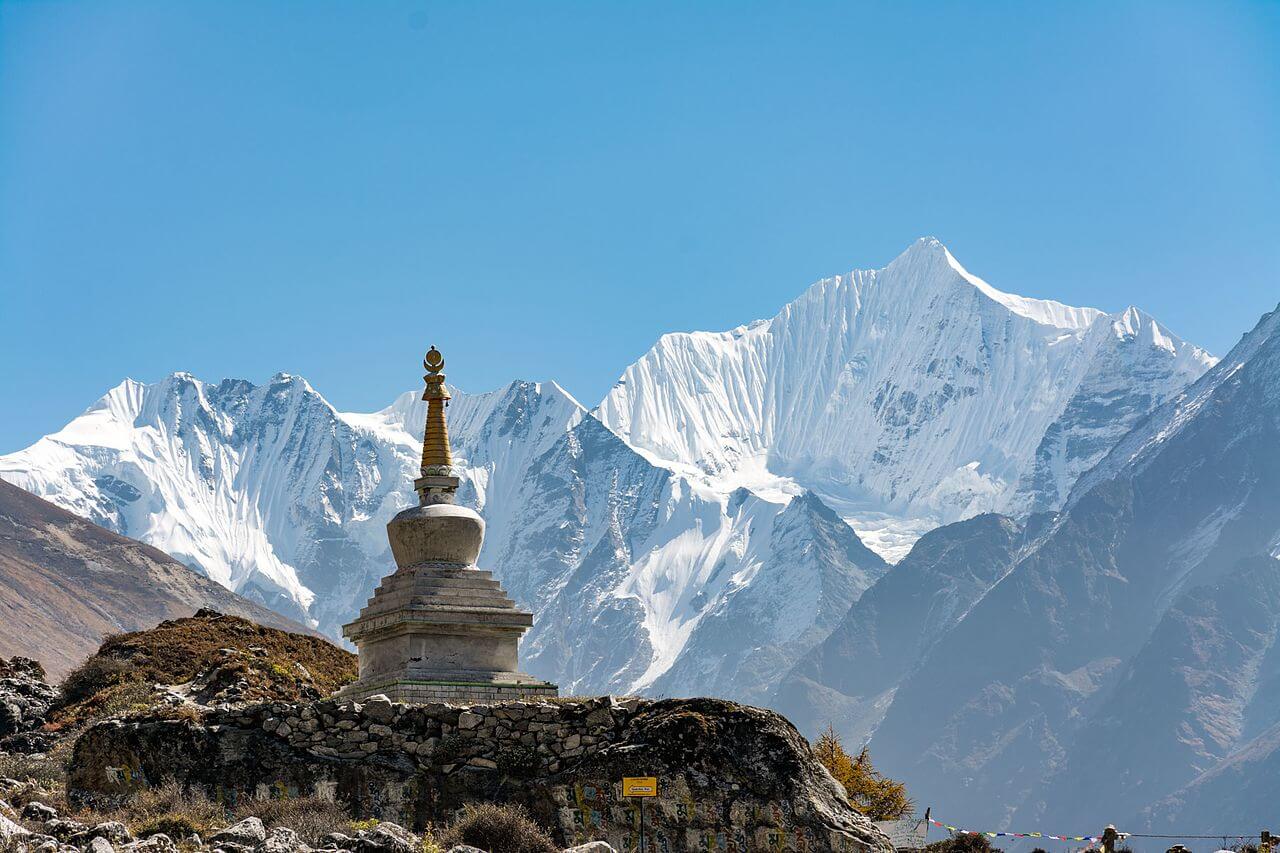
Langtang Valley Trek
Langtang Valley is a classic trekking destination, located only 61.8km away from aerial distance, north of Kathmandu.
Although the Langtang Valley Trek is relatively short, accessible, and cheap, the trails are quieter with less number of trekkers compared to other classic trekking destinations in Nepal .
The trek is ideal for both experienced trekkers as well as novice travel enthusiasts. This trek provides an incredible opportunity to traverse through beautiful Tamang villages, diverse landscapes, eye-catching waterfalls, high Himalayan valleys, monasteries, and densely forested areas.
The mountain trails to Langtang also offers you a spectacular sight of the glaciers and mountains including Langtang Lirung, Ganesh Himal, Jugal Himal, Dorje Lakpa, and Ganja La Pass.
Protected as Langtang National Park , it is home to an abundance of exotic animals and birds. On a lucky day, you may spot plenty of wild animals including red panda, langur, musk deer, snow leopards, Himalayan tahr along with birds like Himalayan monal, white-winged redstart, and the snow Patridge.
Before the catastrophic earthquake in 2015, Langtang used to be one of the most commercial trekking destinations in Nepal. The region was severely affected and damaged by the earthquake. Some of the villages in the region were destroyed and buried under the rubble. However, after massive reconstruction and renovation efforts, the area is now open for the trekkers.
Table of Content
Langtang Valley Trek Facts
Highlights of langtang valley trek.
- Langtang Valley is a relatively short and accessible trekking destination with a fantastic Himalayan experience.
- Relish the beautiful spectacles of Langtang Lirung, Ganesh Himal, Manaslu, and Jugal Himal.
- Breathtaking climb to the vantage point of Tserko Ri at the elevation of 5033m.
- Explore the beautiful Tamang villages and get a more in-depth insight into their cultures and heritages.
- Opportunity to witness rare animals like the red panda, snow leopard, langur, and musk deer.
- Explore the ancient monastery of Kyanjin Gompa.
Getting There and Away
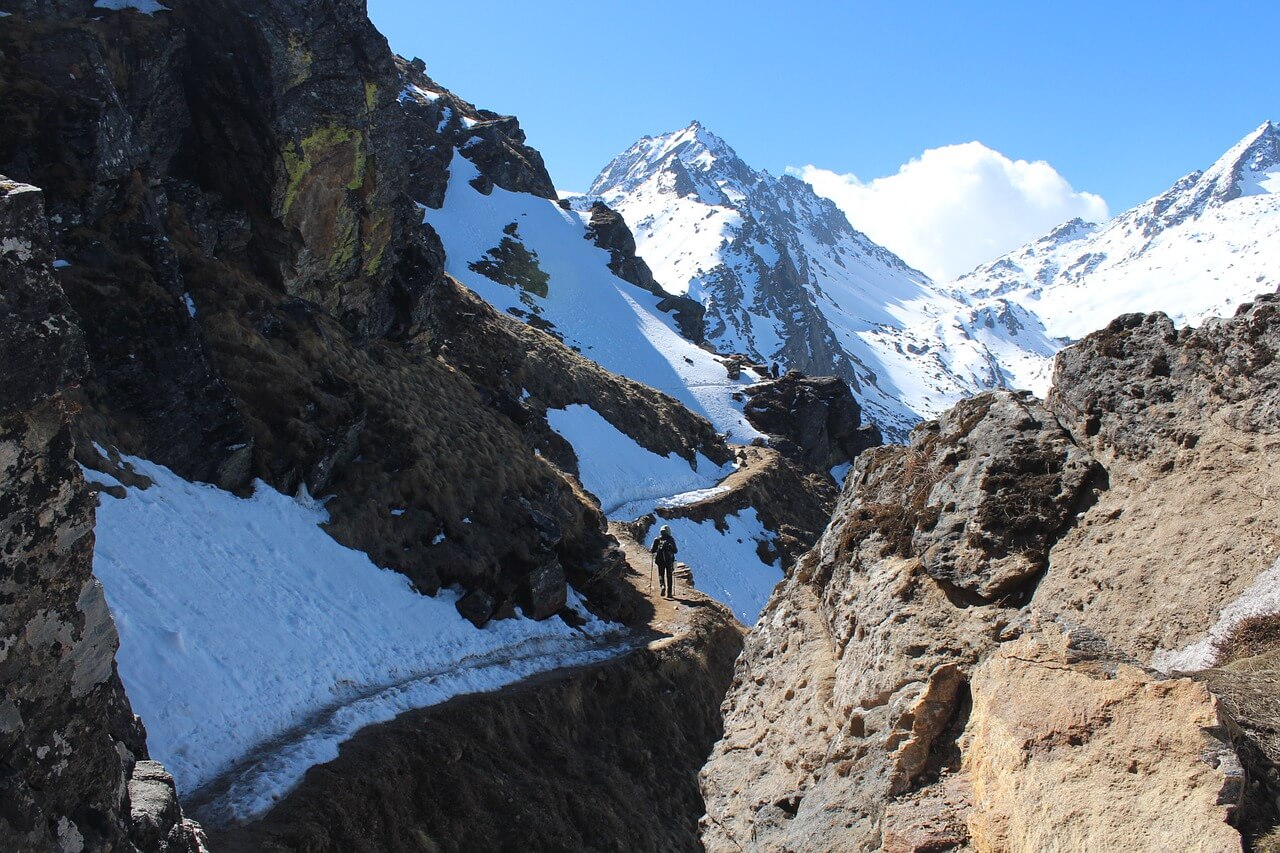
Start of the Trek
Your journey to Langtang Valley Trek begins with a 7-hour drive from Kathmandu to Syabrubesi. The drive from Kathmandu to Syabrubesi covers the total distance of 122km. Although reasonably short in distance, there is still no luxury transportation services available for this region. You can drive to Syabrubesi either by local bus or local/private jeep.
The local bus departs from Machhapokhari every morning from 7 to 9 AM. The bus fare may cost you from $6 to $8 depending upon the different transportation companies. The main discomfort while driving on a local bus is congested seats and too many passengers.
The local jeep will cost about $8 to $10 per person on a sharing basis. You can take these jeeps from Machhapokhari as well. They depart every morning from 6:30 to 9 AM.
If you’re willing to hire a private jeep, it’ll cost you around $150 for a group of 6-7 travelers.
The road condition you travel along reveals its pathetic and rough forms. The highway from Kathmandu to Trishuli Bazaar is good with a narrow winding road. However, once you drive further from Trishuli Bazaar, the road becomes rough and bumpy. Along the way, you come to experience some dreadful landslides.
End of the Trek
Since both starting point and endpoint of Langtang Valley Trek is at Syabrubesi, you’ll be retracing the route backward from Syabrubesi to Kathmandu at the end of the trek.
You’ll have similar transportation options while traveling from Syabrubesi to Kathmandu.
Outline Itinerary of Langtang Valley Trek – 8 Days
Lantang valley trek detailed 8 days itinerary, day 1: drive from kathmandu (1,400m) to syabru besi (1,550m) – 7 to 8 hours.
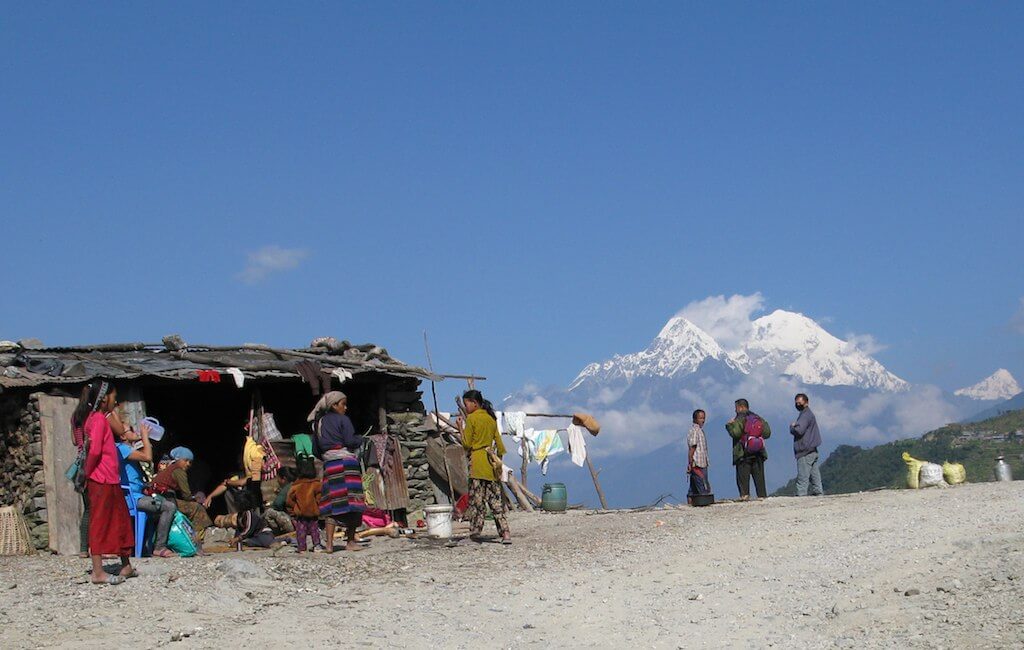
The adventure of Langtang Valley Trek begins with a 7-hour drive from Kathmandu to Syabru Besi. You can either take a local bus from Macchapokhari or hire a jeep to Syabru Besi.
As soon as the bus departs from Kathmandu, the road climbs over the ridge offering majestic views of Ganesh Himal, Manaslu, and Annapurna. The condition of the highway is extremely rocky and rough with tons of potholes and small ditches.
You’ll be driving alongside the Trishuli river for most of the day. Driving past the bustling town of Trisuli, the road leads towards Dhunche, the administrative center of Rasuwa District. Make sure to keep your TIMS card and National Park Permit in an easily accessible place as you’ll need to show them at the Park Gate right before Dhunche. After driving for another hour downhill from the town of Dhunche, you’ll reach Syabru Besi.
Day 2: Trek from Syabru Besi (1,550m) to Lama Hotel (2,380m) – 6 to 7 hours
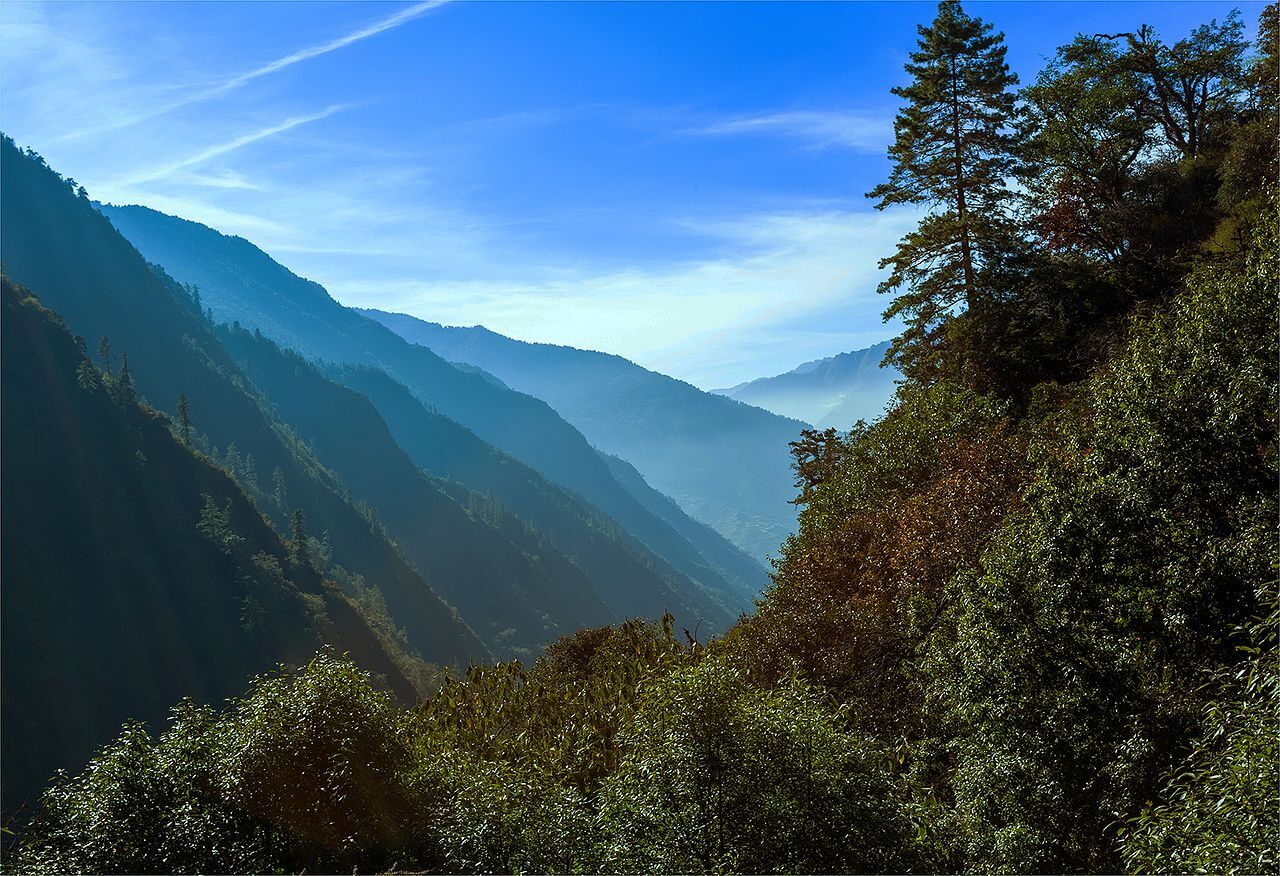
You’ll start the trek from Syabru Besi by crossing the bridge over the Ying Yang River. The trail ascends and descends simultaneously through the dense sub-tropical forest alongside Langtang Khola.
As the trek continues, oak and rhododendron trees dominate the surroundings. While walking in the woods, make sure to watch out for the langur monkeys. The trail goes steep and slightly strenuous through the forest up to Lama Hotel.
Day 3: Trek from Lama Hotel (2,380m) to Mundu (3,430m) via Langtang Village – 6 to 7 hours
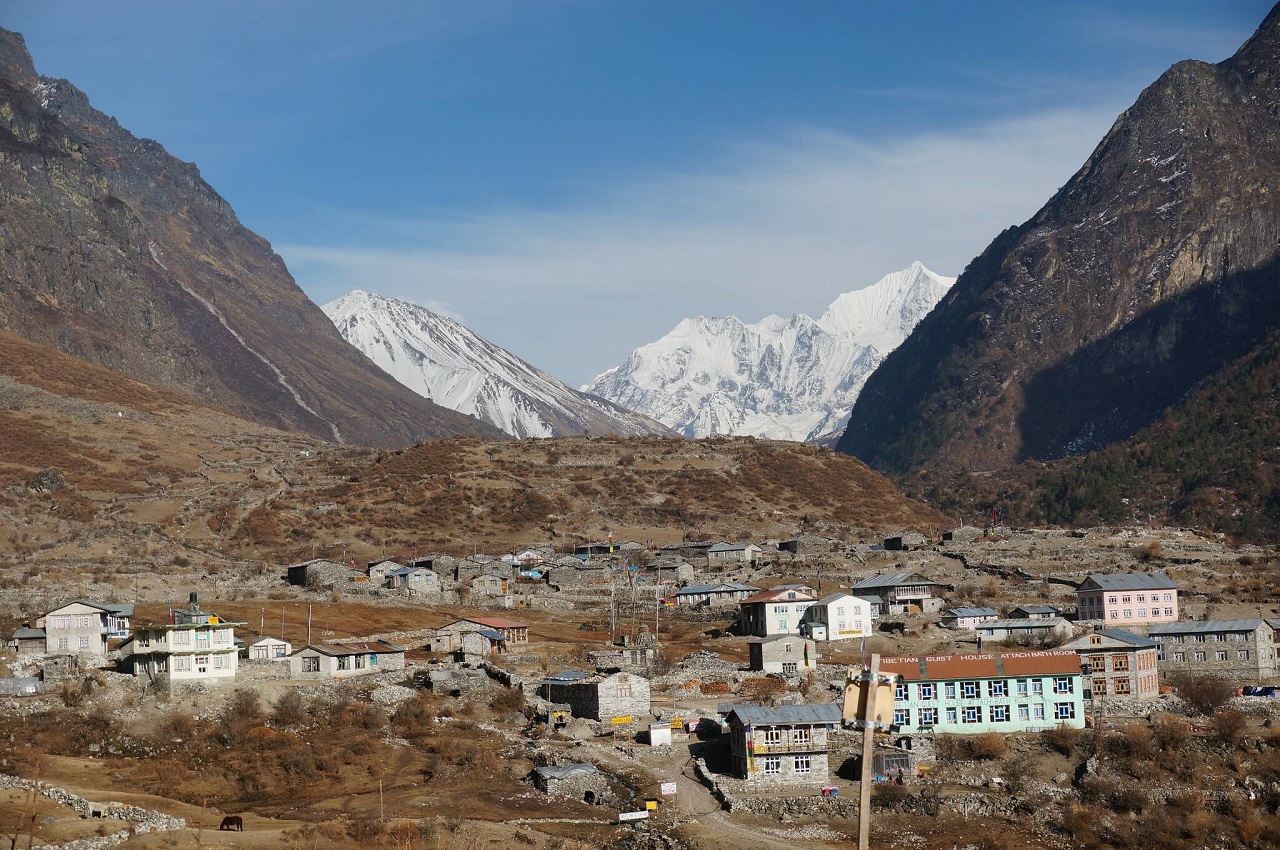
On this day, the forest trail continues through plenty of waterfalls and occasional glimpses of Langtang Lirung. At Ghoda Tabela, the path emerges out of the woodlands into the lush green meadow. The snow-capped peaks of the Langtang range begin to appear on either side of the valley.
The trail further continues to a gentle uphill, passing a few temporary settlements towards Langtang village. Before the 2015 earthquake, Langtang village was once a bustling settlement with plenty of teahouses and lodges. A massive rock field surrounds the entire valley. Mundu village is only half an hour away from Langtang village.
Day 4: Trek from Mundu (3,430m) to Kyanjin Gompa (3,870m) – 3 hours
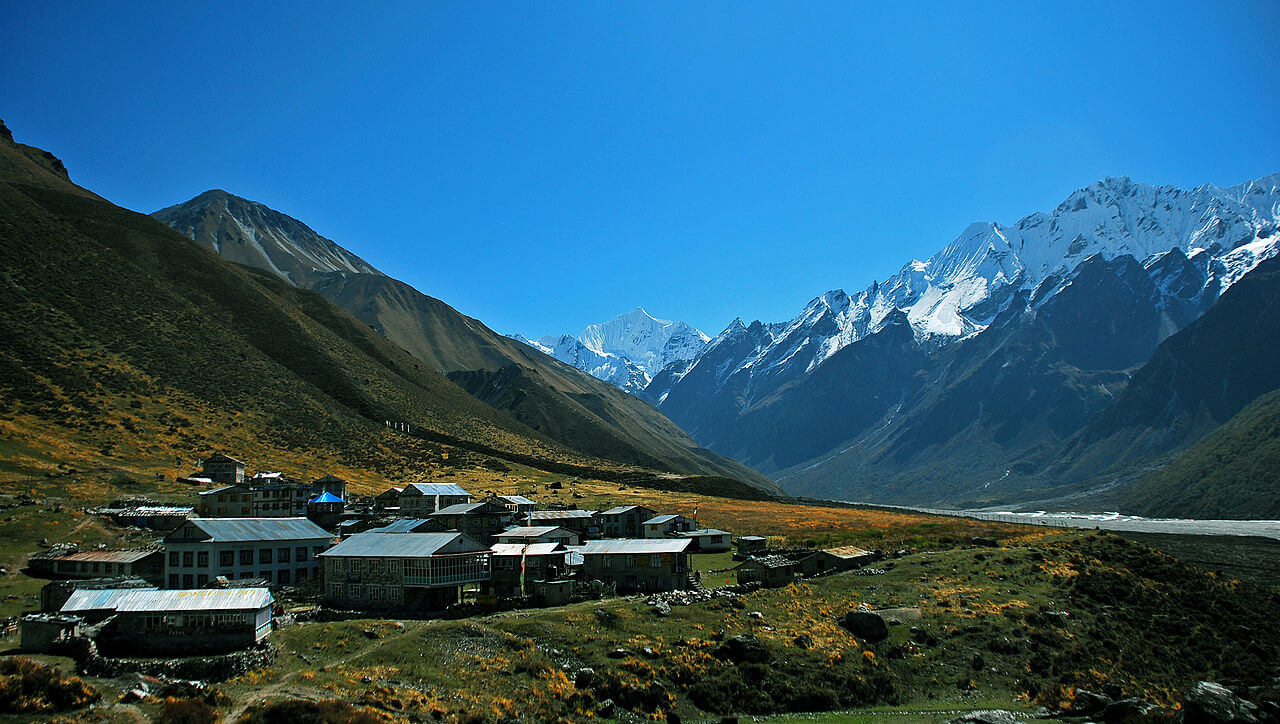
Today, the trail continues gradually passing water mills, chortens, prayer flags, and sacred mounds of rocks with carved inscriptions. The route heads upwards to a yak pasture where the sight becomes more extensive with the mountain views.
As you cross over some moraines and small streams, you’ll reach Kyanjin Gompa. Since this is the shortest day of the trek, you’ll arrive at Kyanjin Gompa by lunchtime. So, if you do not want to spend the day resting, we recommend you head towards Langshisha Kharka for incredible views.
Day 5: Excursion to Tserko Ri (5,000m) – 5 to 6 hours
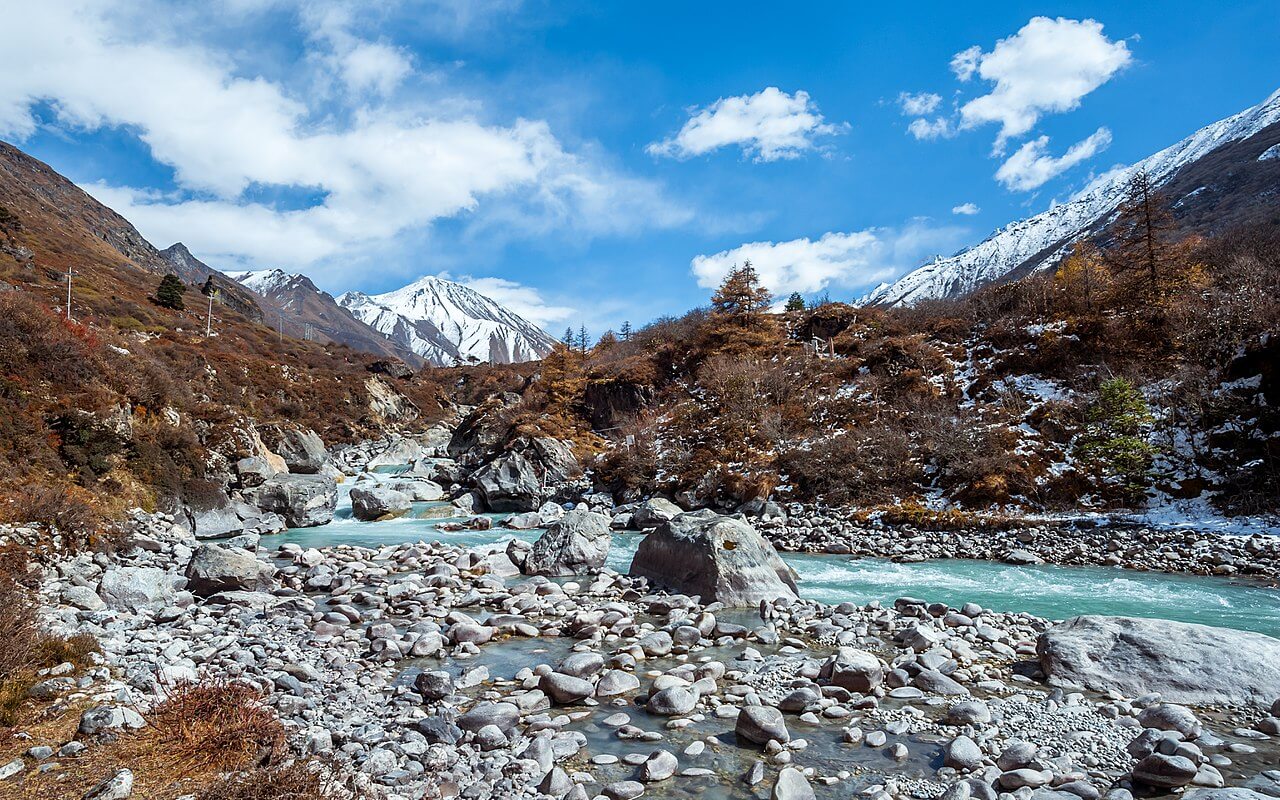
Hike up to the vantage point at Tserko Ri to relish the incredible sights of the mountains, glaciers, and the Langtang valley. Tserko Ri marks the highest elevation point of the trek at 5,000m above sea level.
Since you’ll return to Kyanjin Gompa by the afternoon, you can also explore the ancient monastery of the village. Additionally, you can also visit the cheese factory and glacier.
Day 6: Trek from Kyanjin Gompa (3,870m) to Lama Hotel (2,380m) – 6 to 7 hours
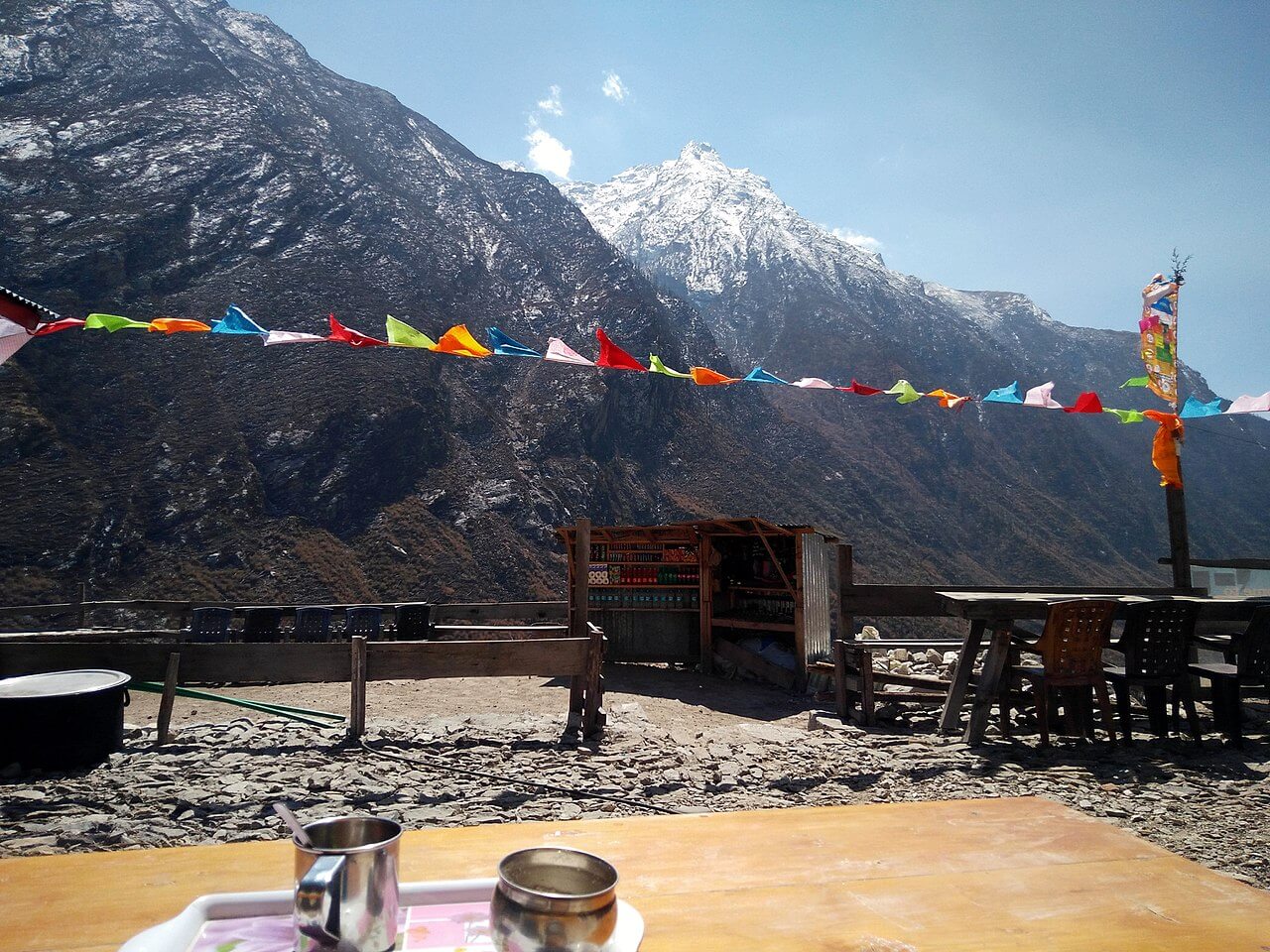
On this day, you retrace the route from Kyanjin Gompa back to Lama Hotel. The way follows back alongside the Langtang River through Mundu village to Ghoda Tabela. The trail is mostly downhill throughout the day. Upon reaching Ghoda Tabela, you’ll continue descending on a steep downhill to Lama Hotel.
Day 7: Trek from Lama Hotel (2,380m) to Syabru Besi (1,550m) – 6 to 7 hours
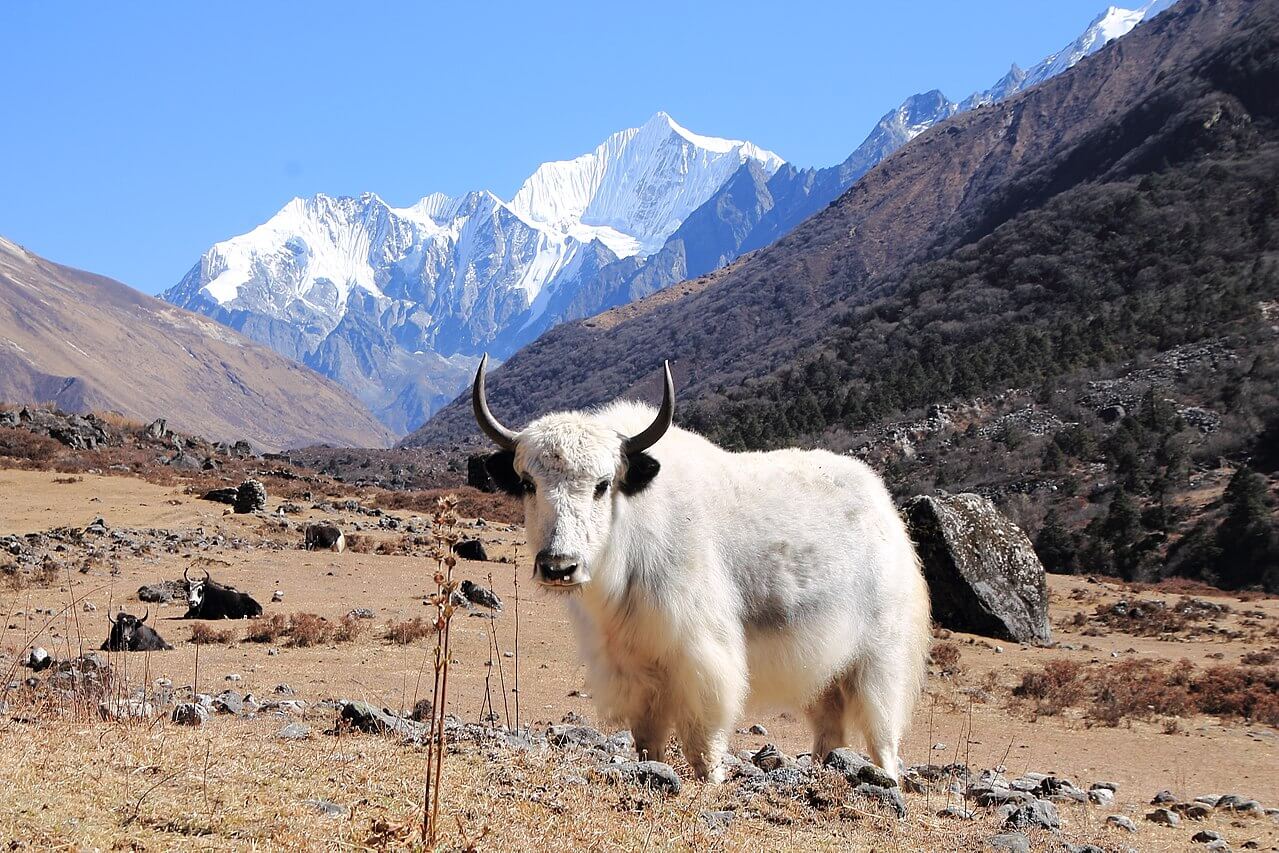
Two different trails lead to Syabru Besi. You can either retrace the route enjoying the forest from Lama Hotel or you can take a detour from Rimche via Sherpa Gaun to Syabru Besi.
The detour from Rimche takes much longer to arrive at Syabru Besi, but this spectacular route is worth the time.
Day 8: Drive from Syabru Besi (1,550m) to Kathmandu (1,400m) – 8 to 10 hours
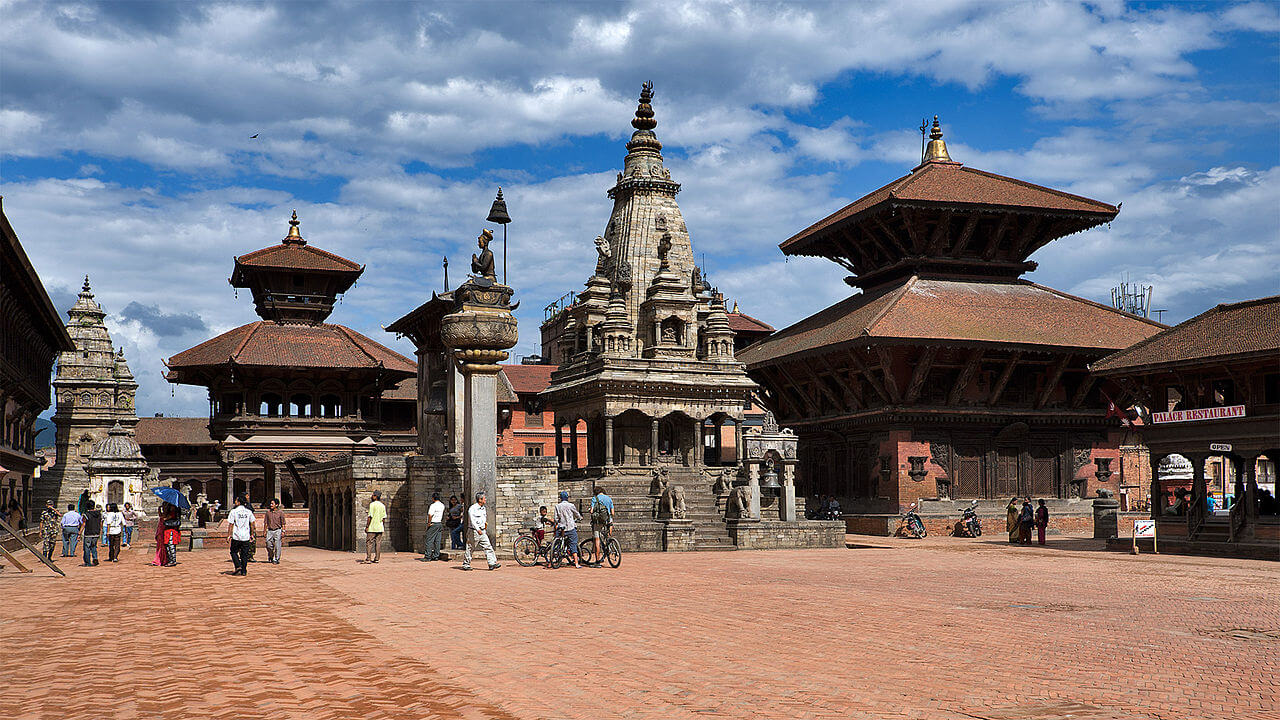
On the final day, you drive back from Syabru Besi to Kathmandu. If you’re early, you can catch a local bus from here. Otherwise, you can also take a local jeep for a slightly convenient experience. It takes about 7-8 hours to drive from Syabru Besi to Kathmandu.
Langtang Valley and Gosainkunda Extension
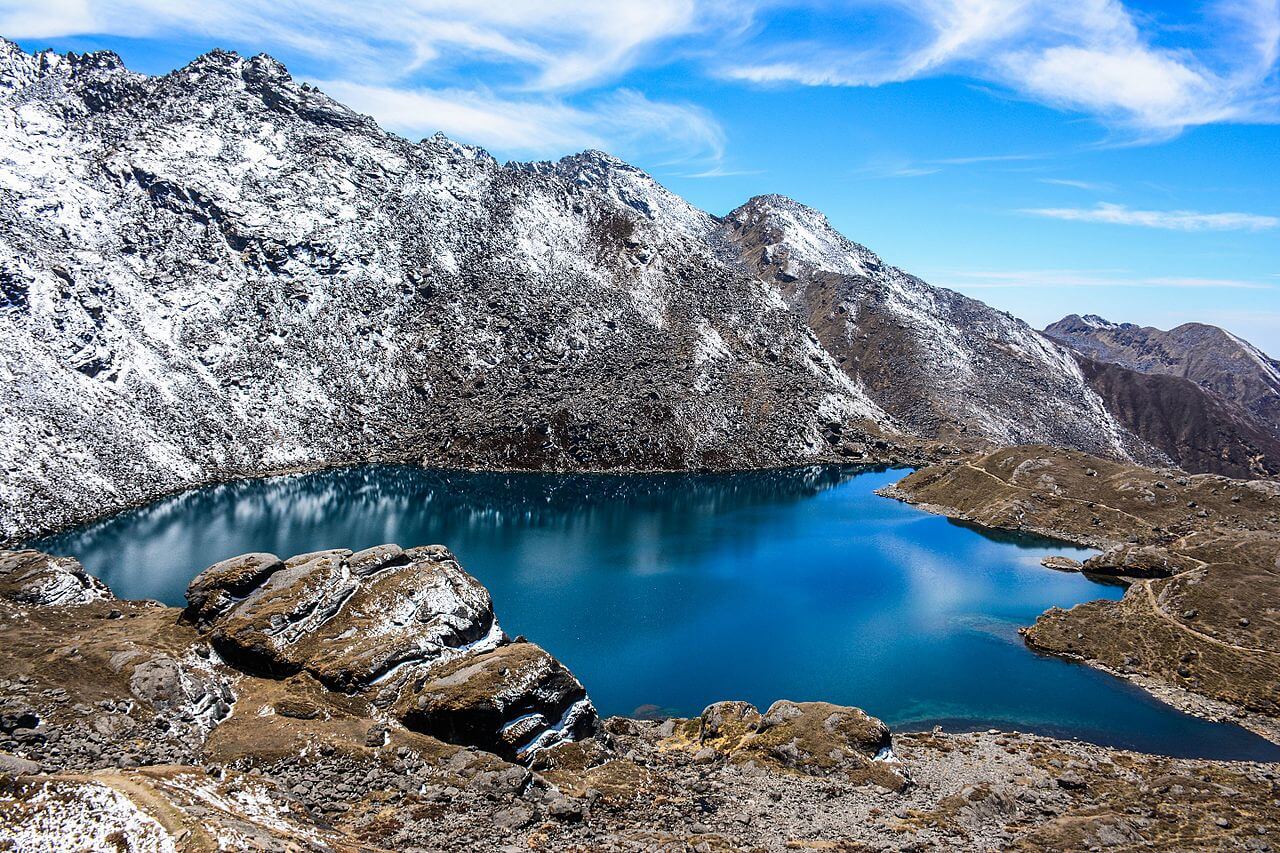
If time permits, you can combine the Langtang Valley Trek with Gosainkunda. The trek offers remote trails with spectacular views of the mountains at Langtang and high Himalayan lake at Gosainkunda.
Gosainkunda, a holy glacial lake at an elevation of 4,380m, is a shrine of Hindus. The diverse landscapes, lush green forest, terraced fields, hills, and scenic mountain views make Gosainkunda one of the most stunning trekking destinations in Nepal.
Langtang Valley Trek with Gosainkunda Extension begins with a drive from Kathmandu to Syabru Besi and then follows through the Langtang Valley. The trail to Gosainkunda connects from Thulo Syapru while retracing the route back from Langtang Trek. The path is quite steep from Thulo Syabru to Sing Gompa and up to the pristine lake of Gosainkunda.
Best Time to Travel in Langtang Region
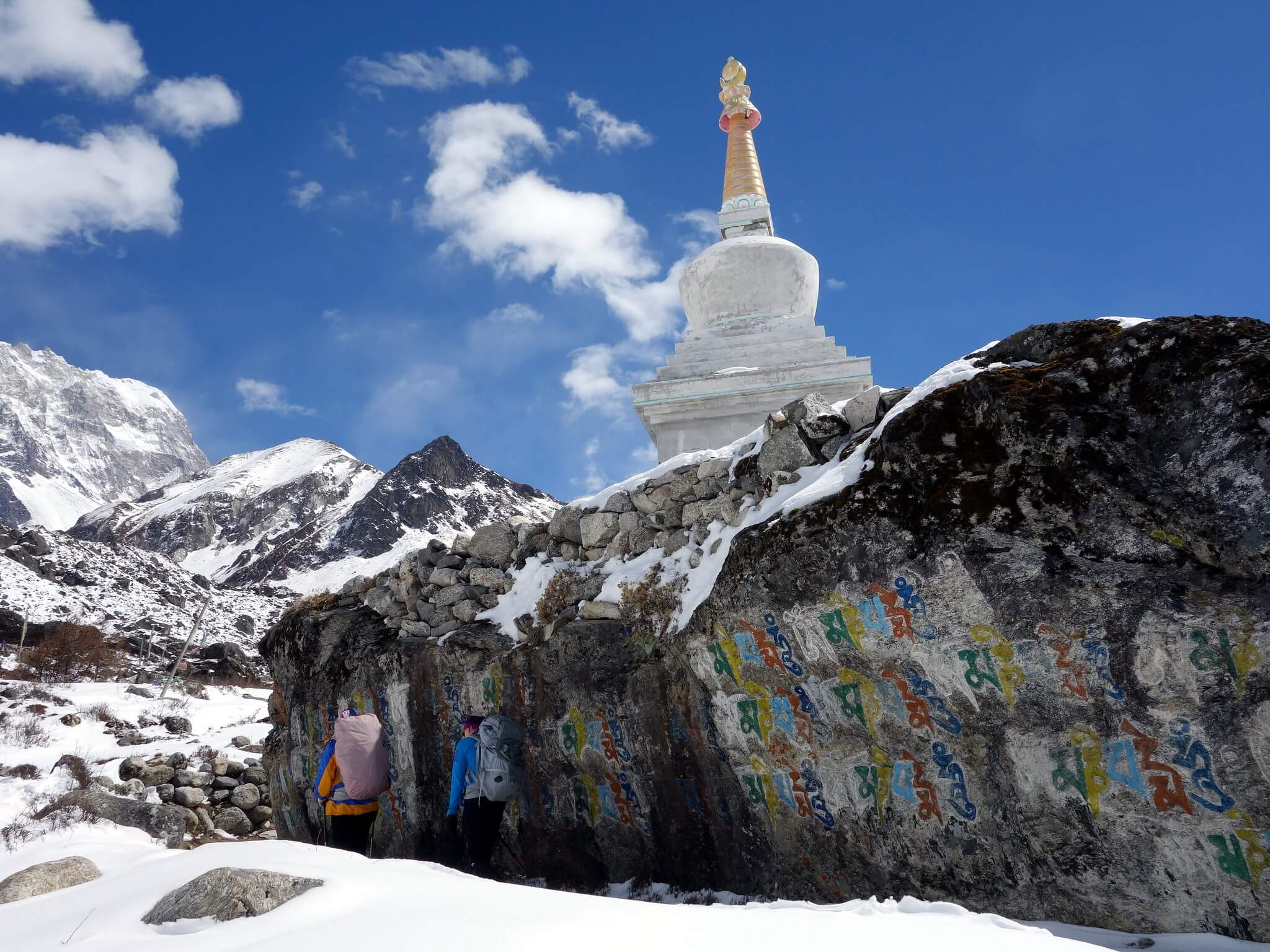
Trekking to Langtang Valley is possible throughout the year. However, Spring season (March to May) right after the cold winter and in Autumn season (September to November) right after the soaking monsoon are two most popular periods to visit the Langtang region.
In most of the days during the Autumn, the temperature remains moderate with a crystal clear sky. This means the temperature during this time of the year is perfect for walking. Also, you get to witness the incredible scenery of the Himalayas throughout the trek. However, the only drawback to trek at this time of the year is the crowded trails.
During the spring season, the temperature is slightly warmer during the day, and the sky looks hazy at times. This means the view may not be as exceptional as the Autumn.
Winter brings cold and harsh weather, especially at the higher elevations. Thick snow covers the trails making it hard to walk during winter. However, the skies are unclouded and reward magnificent sights. If you’re planning to trek to Langtang Valley during the winter, make sure to pack warm clothes and high-quality sleeping bags.
Monsoon is the least favorable time to go trekking in Langtang. The temperature is far too unstable with wet and slippery trails. Since dense forests dominate this region, the risk of leeches increases extensively. Trekking in monsoon demands proper preparation and packing.
Here’s a table indicating the details of average temperature and rainfall of different places en-route to Langtang Valley Trek:
How Difficult is Langtang Valley Trek?
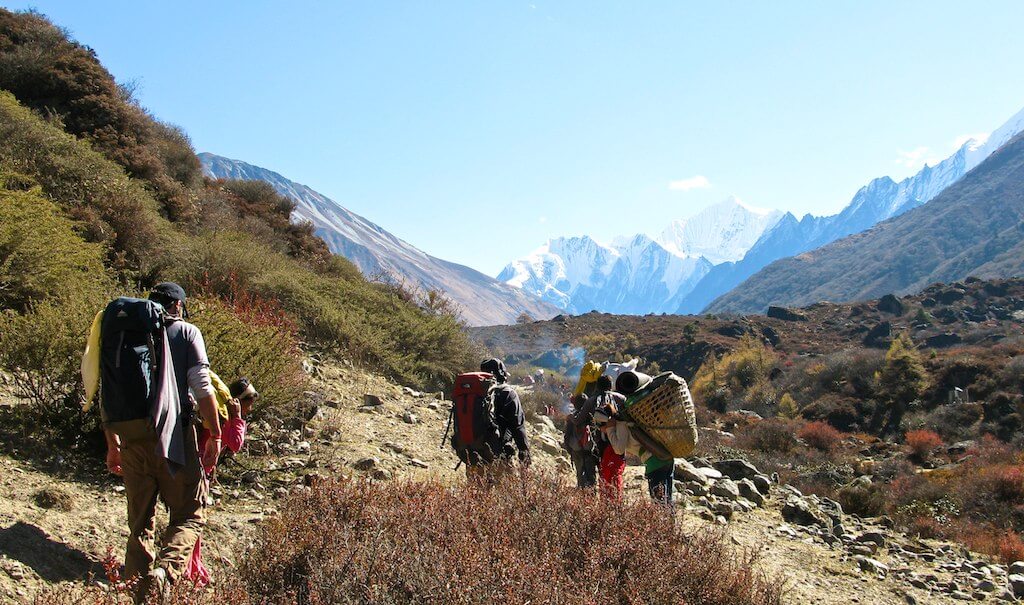
Langtang Valley Trek is a short and moderate trek that does not require any technical skills or previous trekking experience. You can complete the entire trek in 8 to 10 days, walking 5 to 7 hours per day.
The most challenging section of Langtang Trek is the hike from Kyanjin Gompa to Tserko Ri. The trail to Tserko Ri is mostly steep uphill on the rocky Himalayan terrain. However, on most days, the path is easy and comfortable with a pleasant walk.
The highest elevation point in Langtang Valley Trek is 5,000m above sea level. Therefore, Acute Mountain Sickness (AMS) is one of the significant threats while trekking in Langtang. You are required to take all the necessary precautions while traveling in such high elevation. Insist on drinking plenty of water, and be aware of the symptoms of AMS.
The weather in the Himalayas is always unpredictable, especially in the upper reaches. Therefore, it is essential to pack all the necessary equipment while trekking in Langtang Valley. If you’re planning to trek during monsoon season, stay cautious on the trail. There are plenty of landslide-prone areas en-route to Langtang Valley.
While this trek may be relatively easy for experienced trekkers, it does demand a certain level of physical fitness and attitude. One proper way to keep yourself fit for the trek is to engage in cardio-oriented exercises.
What Permits are Requied for Langtang Valley Trek?
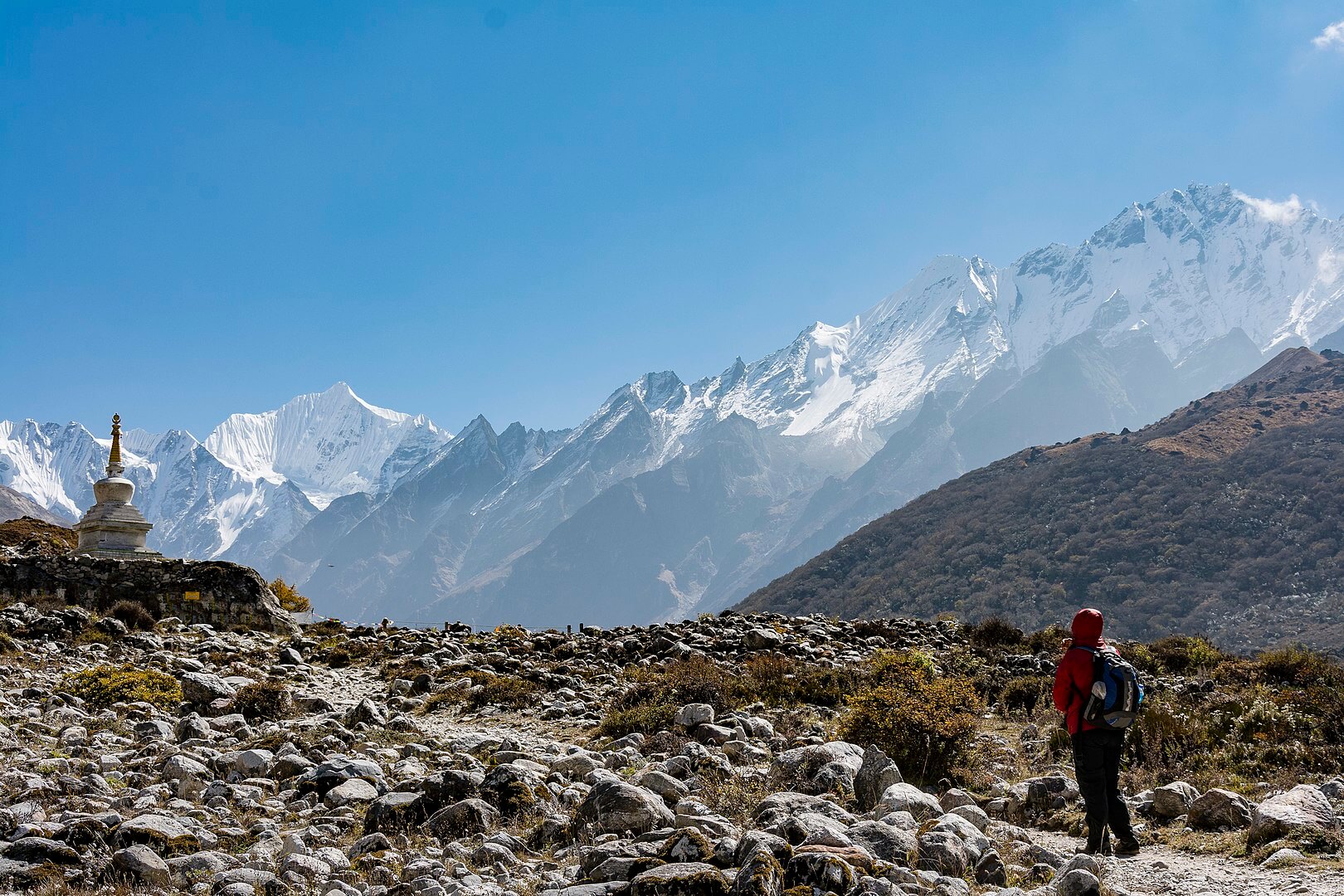
You only require two different permits — TIMS Card (Trekking Information Management System) and Langtang National Park Entry Permit, while trekking to Langtang Valley.
There are three types of TIMS Card; blue for organized group trekkers, green for individual travelers, and a pink one for SAARC nationals. You can acquire TIMS Card from Nepal Tourism Board (NTB) or Trekkers Agencies’ Association of Nepal (TAAN) Secretariat in Kathmandu.
Since you’ll be trekking through the Langtang National Park also need an exclusive National Park Permit to enter the area. The permit is available in Nepal Tourism Board in Kathmandu, or you can also get them from the entry gate at Dhunche.
While issuing a TIMS Card, you’ll require your passport, four passport size photos, insurance details, and contact details of someone in Nepal.
Here’s the price of the permits required for Langtang Valley Trek:
Insurance for the Trek
Having travel insurance is an excellent idea if you’re planning to trek to Langtang Valley. While trekking in such high elevations, you may come across unexpected situations. Therefore, it is essential to get travel insurance for Langtang Trek.
Make sure to choose a policy that covers emergency helicopter evacuation, medical costs, natural disasters, theft, and losses. While several companies provide travel insurance, we advise you to get it from World Nomads. The best thing about World Nomads is that you can claim, buy, or extend the policy anytime online from anywhere — even while traveling.
Guided VS Independent
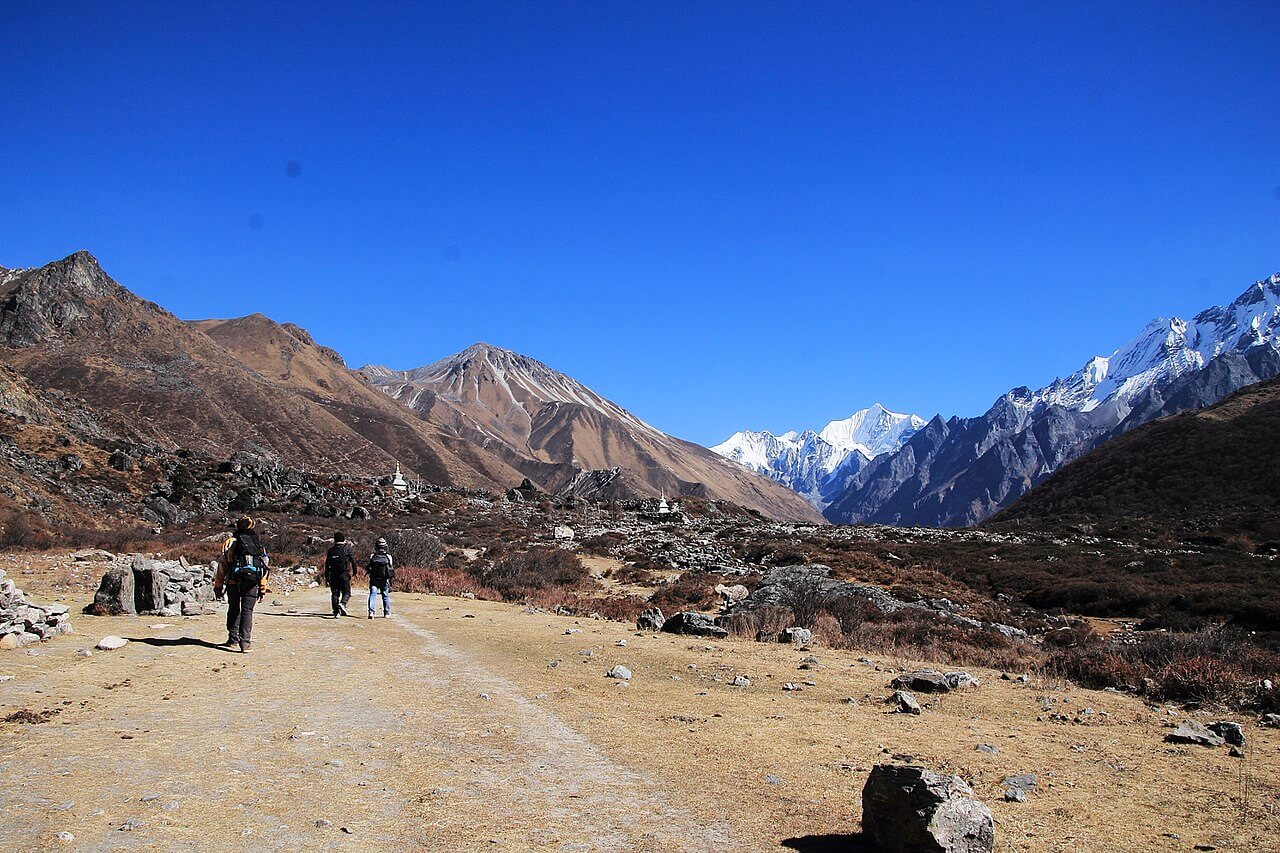
Since Langtang Valley Trek is a moderate walk, you can do it both independently or with a guide. If you’re planning a solo adventure and have prior trekking experience, this trek is an excellent choice for you. The route does not disperse into other trails, and occasional signposts mark the entire trail. Therefore, the risk of taking the wrong path is very minimal.
Altitude is the primary threat while trekking to Langtang Valley. Stay aware and precautious regarding this factor.
Trekking independently is relatively cheaper than hiring a guide, but you need to deal with hassles of transportation, teahouses, food and permit. It is always handy to have an experienced guide at high altitude treks. The guide will assist you throughout the trek and will make sure of your safety.
An experienced guide will also know about the place, culture, people, and the mountains. You’ll also get more in-depth information about the valley if you hire an experienced guide.
Accommodation and Food
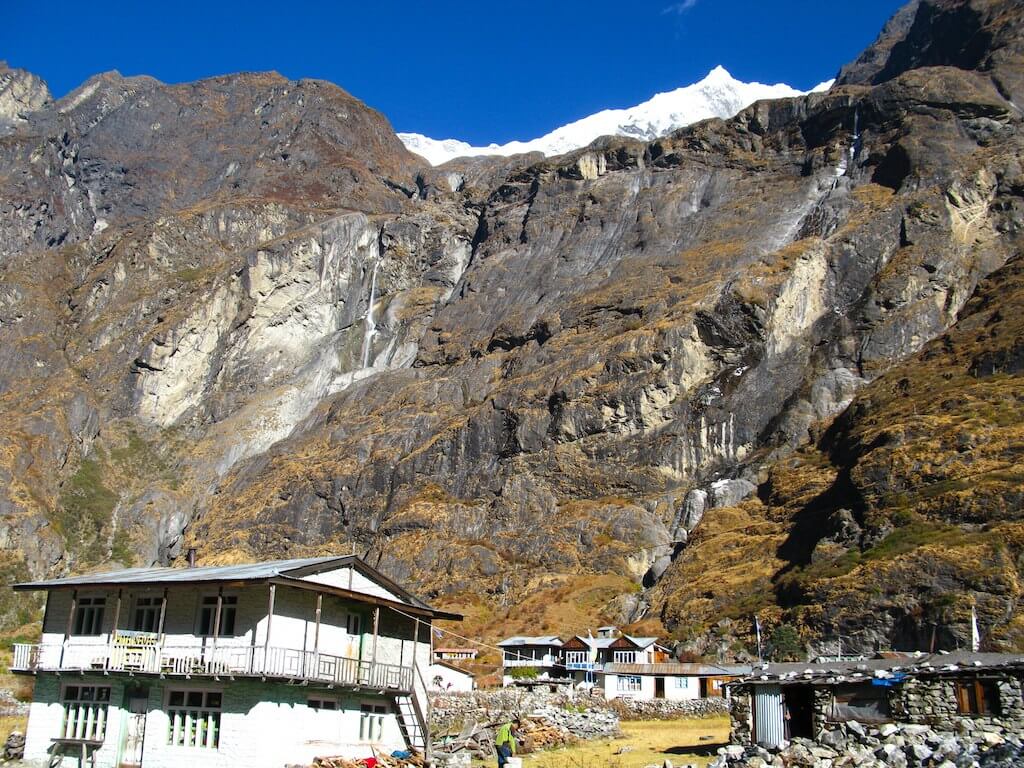
On Langtang Valley Trek, you will mostly stay at the teahouses, which provide rooms, food, and basic amenities like wifi, hot shower, and charging facilities. On the lower reaches of Langtang Valley Trek, you will get high standard rooms with attached bathrooms. These teahouses will offer standard services but may charge you higher than normal rates. Some of the teahouses provide device charging facilities at free of cost.
As you get higher on the trail, teahouses provide only essential services with twin shared rooms. The rooms have two single beds, a thin mattress, a pair of bedsheets, and a cushion. The toilets are usually on a sharing basis without the facility of running water. You’ll have to pay the additional amount for a hot shower, wifi, and charging facilities.
These teahouses also have their restaurant, serving meals to the guests. The choices in the menu are limited, but portions of the food will be quite substantial and filling. Generally, the menu offers Dal Bhat, chowmein, omelet, fried potatoes, pancakes, Tibetan bread, and soups. The non-veg items include yak meat, canned fish, and chicken.
Langtang Valley Trek Cost
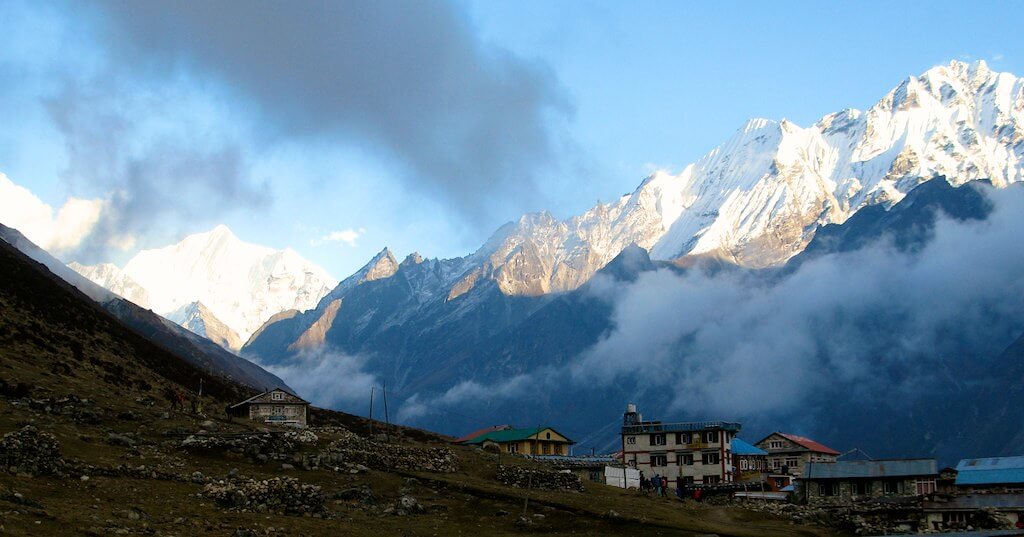
The plenty of factors like trek duration, transportation, type of trek, and season determine the cost of the trek. On average, the total cost of 8-day Langtang Valley Trek can be around US$ 300-400.
You’ll require TIMS Card and Langtang National Park Entry Permits to trek to Langtang Valley. For individual trekkers, the cost of the TIMS Card is US$ 18 while for group trekkers, it is US$ 9 her head. Additionally, the National Park Entry Permit costs US$ 27 per person.
The charge of the teahouses depends on season. Generally, the rooms in Langtang will cost approximately US$ 5 to 10 per night with an additional US$ 4 to 6 per meal.
A local bus from Kathmandu to Syabru Besi will cost about US$ 6-8 per person at par various transport companies. You can also take a local jeep that will cost you around US$ 8-10. Additionally, you can also hire a private jeep for $150 for a group of 6 to 7 people.
If you hire a licensed guide, they will charge you US$ 22 to 25 per day. If you hire a porter, it’ll cost you approximately US$ 15 to 18 per day. If you want to hire a porter-guide, they’ll charge you US$ 18 to 20 per day.
Packing List for Langtang Valley Trek
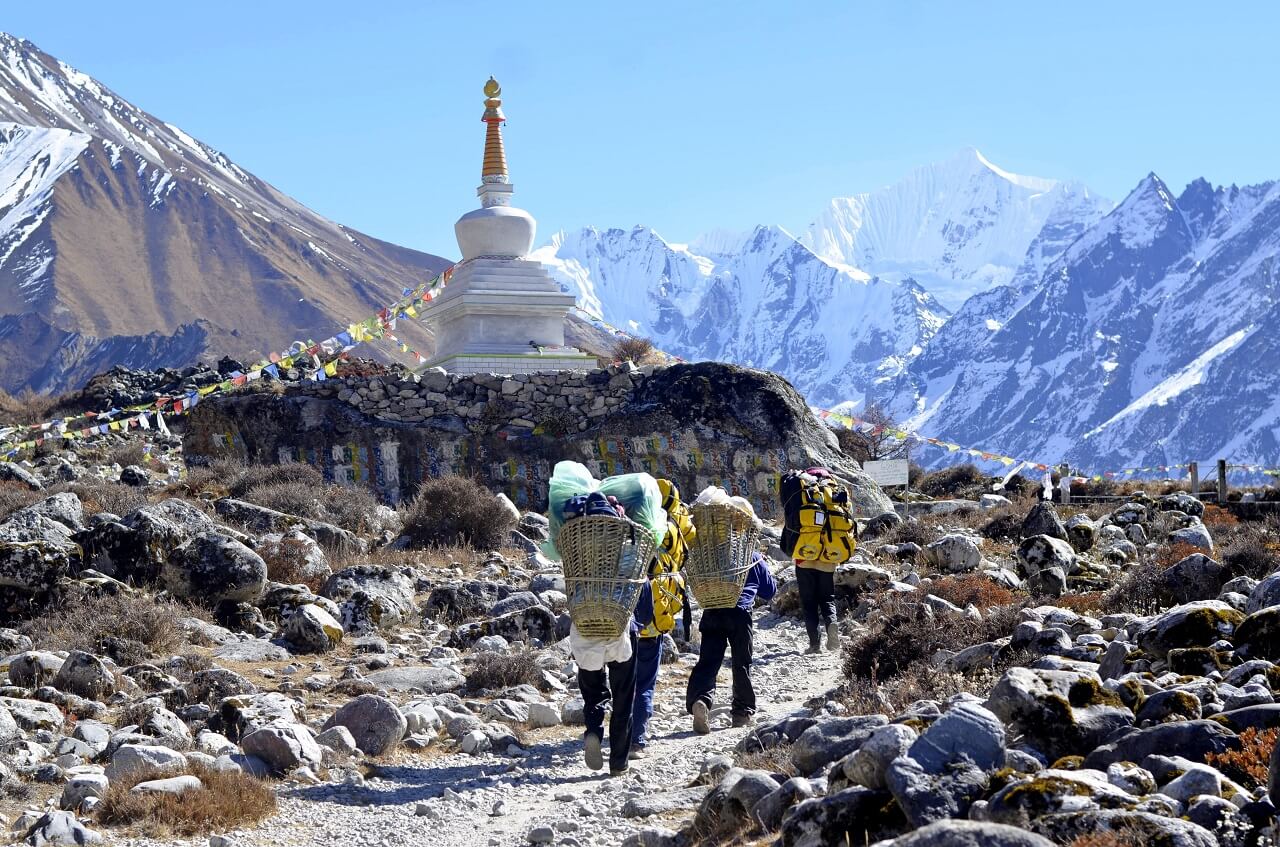
- Duffel Bags
- Trekking Shirt: Pack at least 5 to 7 shirts balancing both long and short.
- Trekking Trousers: Carry a minimum of 2 trekking trousers with a couple of shorts.
- Base Layer: Pack a couple of wool base layers to stay protected from the cold in the upper reaches of the trek.
- Insulation Layer: We recommend you pack a high-quality fleece jacket.
- Outer Layer: Carry a warm and waterproof jacket for extreme weather.
- Waterproof Shell Jacket: Pack a pair of waterproof jackets for wet weather.
- Breathable Underwear: Minimum 5 to 6 pairs of breathable underwear.
- Hiking Boots: Invest in high-quality waterproof hiking boots. Make sure the boot is lightweight and comfortable.
- Trainers/Sandals: It is handy to carry a pair of trainers or sandals.
- Hiking Socks: You should carry 4-6 pairs of breathable hiking socks.
- Thermal Socks: A pair of thermal socks to keep your feet protected from the cold in the higher altitudes.
Head Wears:
- Sun Protection Hat: Carry a protection hat to protect your face from the harsh sun.
- Beanie: An absolute must to keep yourself warm, especially during the evening and night.
- Buff/Neck Gaiter: This small piece of gear comes in handy to protect your neck from the cold winds and also helps you stay protected from the dust.
- Inner Gloves: Pack light inner gloves as they can be useful when the temperature is moderate.
- Outer Gloves: You’ll be wearing them in the upper reaches of the trek. Outer gloves need to be insulated, warm, and waterproof.
Sleeping Bags:
Sleeping bags are the most crucial gears while trekking in the Langtang region. With basic rooms and sleeping facilities, you can never rely on the teahouses for warm, decent blankets.
Therefore, we advise you to invest in a high-quality, 4-season sleeping bag while trekking in Langtang.
Important Accessories:
- Trekking Poles
- Water Bottle
- Basic Medical Kits
- UV Protection Sunglasses
- Water Purification Tablets
- Hand Sanitizers
- Sunscreen/Lip Balm
- Trekking Towels
- Portable Chargers
Network Information
Both Ncell and NTC networks do not work in the Langtang Valley. Once you depart from Kathmandu, NTC services are not available, and Ncell works only up to Lama Hotel. Sky Network is the most preferred telecommunication service in the Langtang Valley. Sky Network works throughout the entire trek, from the lower reaches up to the higher elevations.
Remember, phone services may not be consistent throughout the entire region. Due to the inconsistency of networks, the mobile internet will also be unstable. However, most of the teahouses do provide WiFi facilities, but it might cost you a few extra bucks.
The majority of the teahouses in Langtang have landline phones. In case of emergencies, landline phones are the best way to connect with your emergency contacts.
Useful Tips for Langtang Valley Trekking
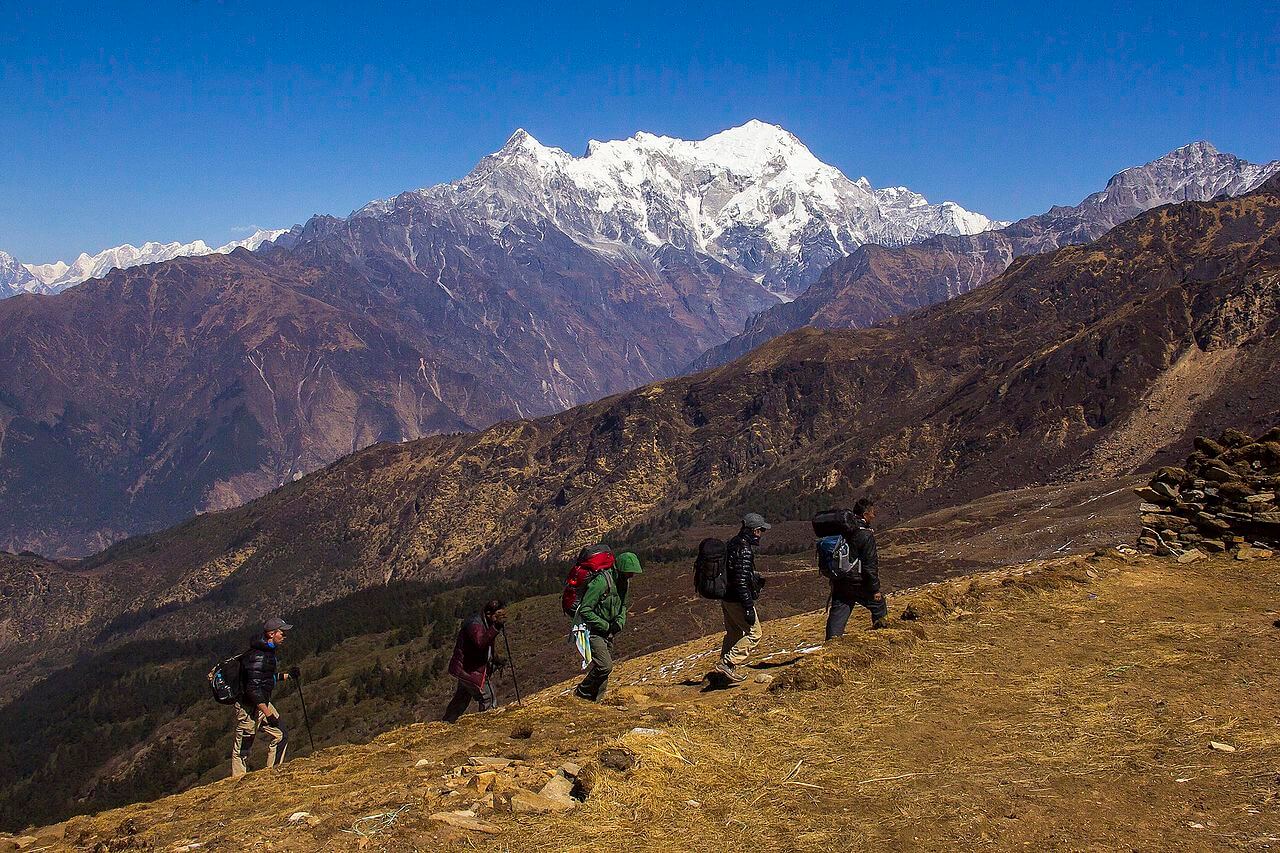
- While trekking in the upper reaches of Langtang Valley, you’re in a constant threat of suffering from acute mountain sickness (AMS). It is crucial to drink more water and take all the necessary precautions to protect yourself from altitude sickness.
- Packing the right equipment is essential while trekking to Langtang Valley. If you do not wish to buy all the expensive trekking gears, we advise you to rent them in Kathmandu.
- Although Langtang Valley Trek is a relatively moderate trek, it requires a certain level of physical fitness. We suggest you engaging in cardio-oriented activities like cycling, swimming and running, a month before the trek.
- It is not advisable to buy bottled waters as they pollute the trekking trail. We highly recommend you to fill up the water at the teahouses and use water purifiers to treat the water.
- Invest in high-quality hiking boots. If you’re planning to trek to Langtang Valley during monsoon or winter, buy waterproof boots that have sturdy soles.
- Before you go for trekking to Langtang Valley, get proper travel insurance that covers both medical costs and helicopter evacuation.
- Carry enough cash on the trek. ATMs are not available on the trail.
Accommodation in Kathmandu
Recommended travel agencies for langtang valley trek.
- Himalayas on Foot
- Magical Nepal
- Mosaic Adventure
- Nepal Eco Adventure
Recommended Books and Guidebooks
- A Trekking Guide to Langtang
- Lonely Planet Nepal (Travel Guide)
- The Rough Guide to Nepal
- Trekking in Langtang, Helambu & Gosainkund
- Climate Change and the Extreme Events in the Himalayas
- High Adventure
- The Snow Leopard
1. Is it possible to do the Langtang Valley Trek solo/independently?
Langtang Valley Trek is a short and moderate walk in the Himalayas of Nepal. It is possible to do solo as well as in a group. The trail does not diverge in multiple routes and it occasionally marks the signposts. So, the trekkers do not stray off the path.
2. How likely am I to suffer from Acute Mountain Sickness in Langtang Valley Trek?
Keep in mind, Langtang Valley Trek exceeds the elevation of 3000m above sea level. Once you cross the height of 3000m, the possibility of suffering from altitude sickness becomes higher. Therefore, it is crucial to drink more water and take the necessary precautions to stay safe from AMS.
3. What type of accommodation can I expect in Langtang Trek?
In the lower region of Langtang, there are plenty of high standard lodges and teahouses that provide quality services. However, these teahouses are relatively expensive than the common one.
In the upper reaches of the trek, the teahouses offer rooms in sharing basis and other basic facilities.
4. Is it safe to drink water in Langtang Valley Trek?
No, it is not safe to drink water directly from local streams or taps while trekking in the Langtang region. Bottled water is quite expensive on the trail. It is advisable to carry your bottle and fill the water in the teahouses. Carry water purifiers or SteriPen purifiers to treat the water before drinking.
5. Do I need travel insurance before trekking to Langtang Valley?
While travel insurance is not mandatory, it is highly advisable to have one in high altitude treks. Even though Langtang Valley is a short and moderate, trekking in such high elevation is risky. Therefore, it is advisable to have proper travel insurance that covers all the necessary costs.
Langtang Valley Trek is a short and moderate trek in the Himalayas of Nepal. Easily accessible from Kathmandu, this trek is an excellent opportunity that rewards trekkers with authentic experience and warm hospitality.
Langtang Trek is an ideal choice for people who are looking to escape the massive crowd of Everest and Annapurna. It offers a diverse landscape, unique culture, beautiful scenery, and panoramic mountain spectacles.
Langtang Valley is also a perfect adventure destination to discover rare wildlife and plants. Carrying a decent camera is highly advisable as this trek offers plenty of opportunities to capture picture-perfect photographs.
Similar Posts
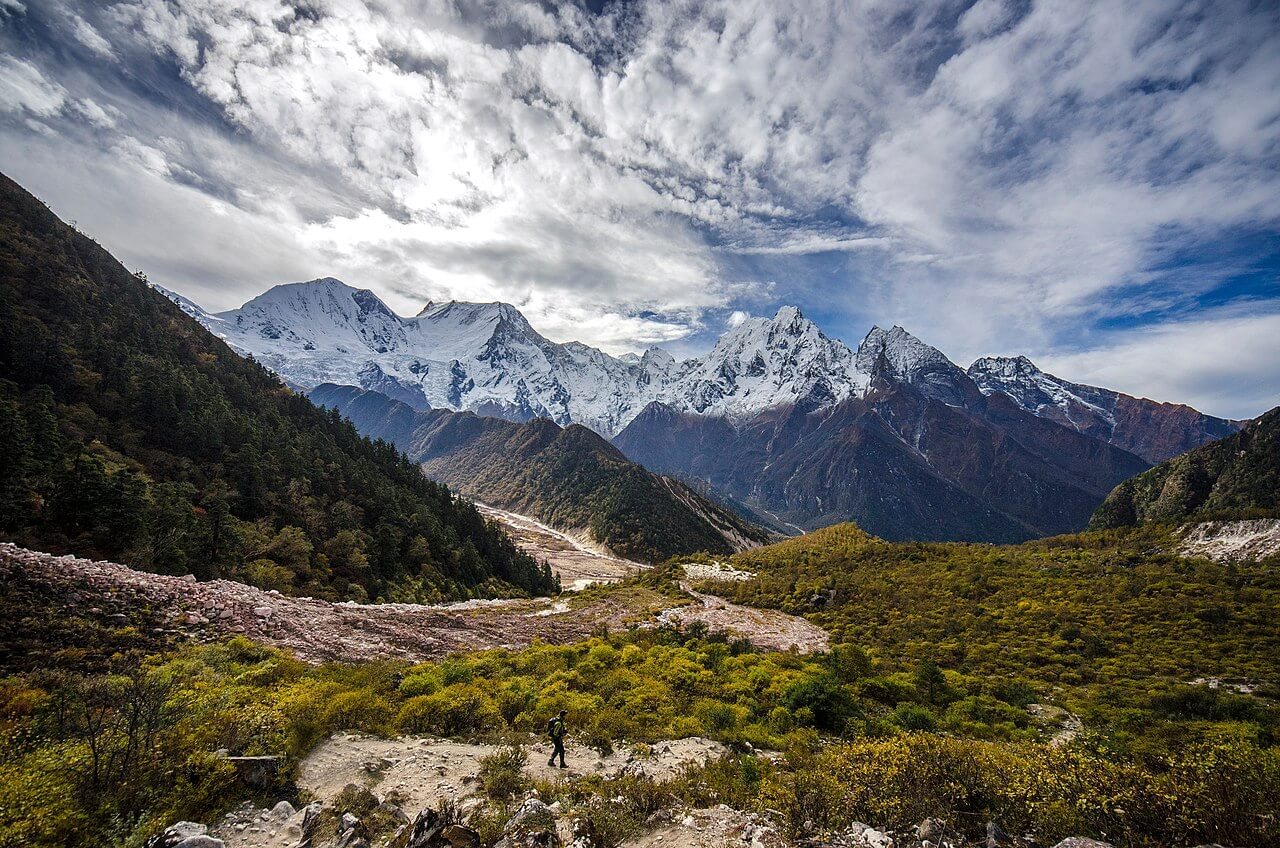
Manaslu Circuit Trek
Manaslu Circuit Trek stands less beaten and secluded compared to treks like Everest or Annapurna, but it is equally as impressive as other classic treks. Manaslu Circuit Trek is the most beautiful as well as demanding treks in Nepal. Trekking in Manaslu is a delightful experience with a blend of adventure, scenery, culture, lifestyle, and…
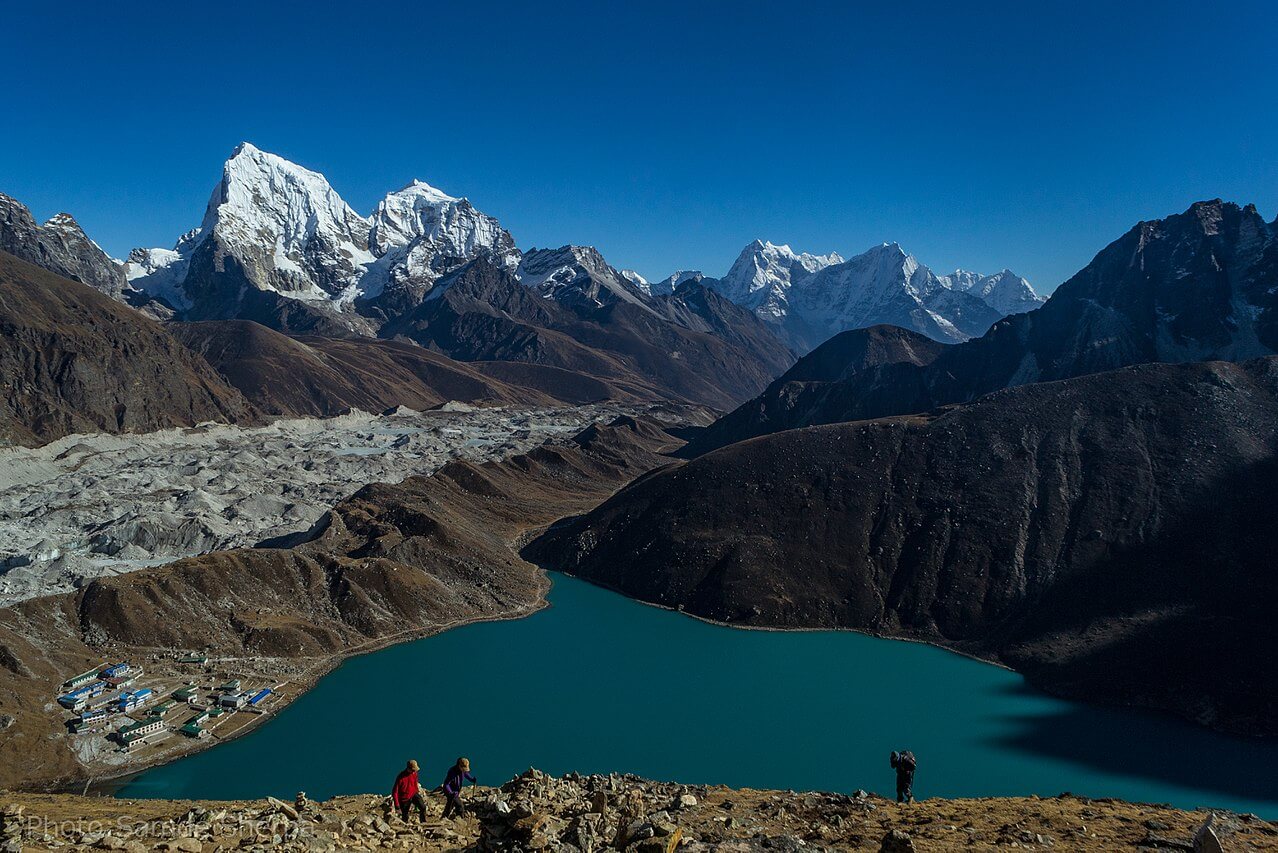
Gokyo Ri Trek
Gokyo Ri Trek, the best alternative trail to the Everest Base Camp Trek, offers exceptional views of the Himalayan peaks along with lakes and glaciers. Gokyo Ri Trek is a moderate trek in the high Himalayas of the Everest region. Instead of traveling to the more commercial Everest Trek, trekkers often choose this itinerary to…
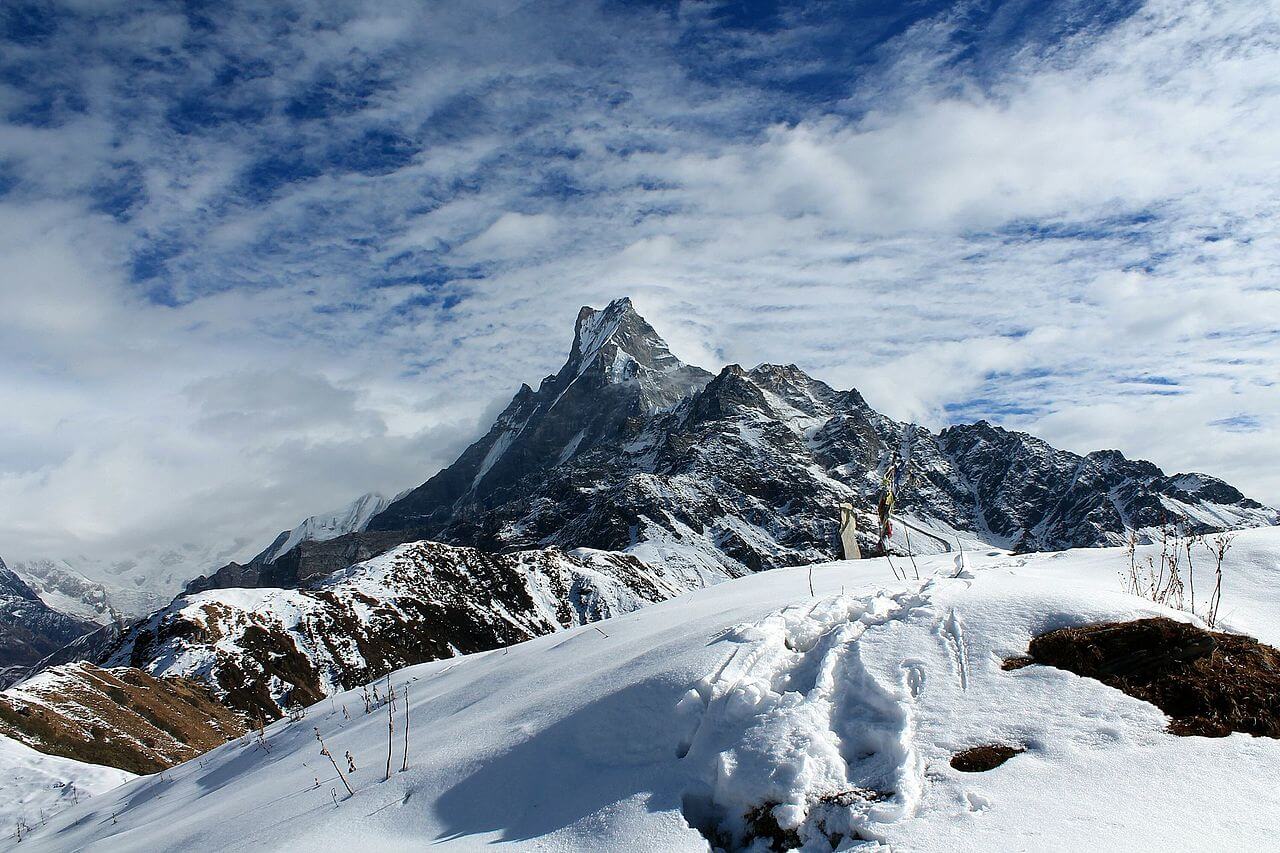
Mardi Himal Trek
Mardi Himal Trek is a hidden gem for the dedicated trekkers and backpackers. Located eastwards of the classic Annapurna Base Camp, this trekking route is yet to witness a large crowd like other commercial treks in Nepal though it officially opened for all in 2012. The richly diverse terrains of Mardi Himal takes you across…
- Hiking Shoes
- Hiking Boots
- Hiking Sandals
- Trail Runners
- Base layers
- Hiking Shirts
- Fleece Jackets
- Softshell Jackets
- Rain jackets
- Down Jackets
- Hiking Pants
- Hiking Shorts
- Base Layers
- Rain Jackets
- Hiking Bras
- Baby Carriers
- Cookware Sets
- Water Filters
- Water Purifiers
- Sleeping Bags
- Sleeping Pads
- Hiking Poles
- GPS Devices
- Solar Chargers
- Dive Regulators
- Dive Computers
- Dive Watches
- Dive Wetsuits
- Dive Gloves
- Dive Lights
- Dive Knives
- Spearfishing Wetsuits
- Spearfishing Masks
- Spearfishing Fins
- Spearfishing Watches
- Freediving Wetsuits
- Freediving Masks
- Freediving Fins
- Freediving Watches
- Sit On Top Kayaks
- Inflatable Kayaks
- Fishing Kayaks
- Tandem Kayaks
- Touring Kayaks
- Kayak Paddles
- Kayak Seats
- Kayak Roof Racks
- Kayak Carts
- Stand Up Paddle Boards
- Touring SUPs
- Inflatable SUPs
- Fishing SUPs
- SUPs For Yoga
- SUPs For Surfing
- SUP Paddles
- Climbing Boots
- Belay Devices
- Climbing Shoes
- Women's Climbing Shoes
- Bouldering Shoes
- Approach Shoes
- Climbing Pants
- Bouldering Pants
- Mountain Bikes for Men
- Mountain Bikes for Women
- MTB Handlebars
- Bike Saddles
- Bike Computers
- Bike Lights
- MTB Jackets
- Bike Helmets
- Bike Packing Gear
- Fat Biking Gear
- Ski Bindings
- Ski Helmets
- Ski Goggles
- Ski Jackets
- Snowboarding Bindings
- Snowboarding Boots
- Snowboard Helmets
- Snowboard Goggles
- Snowboard Pants
- Snowboard Jackets
- Snowshoe Poles
- Avalanche Beacons
- Avalanche Probes
- Avalanche Shovels
- Ski Backpacks
- Surfboards For Beginners
- Surfboards For Kids
- Surfboard For Small Waves
- Soft Top Surfboards
- Foam Surfboards
- Body Boards
- Boogie Boards
- Kiteboarding Kites
- Kitesurfing Boards
- Kiteboarding Harnesses
- Surfing Wetsuits
- Men's Rash Guards
- Women's Rash Guards
- Board Leashes
- DLSR Travel Cameras
- Mirrorles Travel Cameras
- Point and Shoot Travel Cameras
- Fuji Travel Lenses
- Nikon Travel Lenses
- Tripods for Travel
- DLSR Landscape Cameras
- Mirrorles Landscape Cameras
- Point and Shoot Landscape Cameras
- Fuji Landscape Lenses
- Nikon Landcape Lenses
- Canon Landcape Lenses
- Tripods for Landscape Photo
- Wildlife Cameras
- Wildlife Lenses
- Wildlife Tripods
- Wildlife Monopods
- Birdlife Cameras
- Birdlife Lenses
- Surfboards For Small Waves
Hiking The Langtang Trek in Nepal
Have you ever dreamed of hiking the Langtang Trek in Nepal? We’ve all seen those pictures of the soaring Himalayan Mountain Range but do you know what it takes to get there?
A long list of questions fill your head: When is the best time of the year to go? What should I pack? And, what about altitude sickness?
To answer those questions, I have put together this guide to walk you through everything you need to know to plan and prepare for the Langtang Trek, one of the best treks in Nepal .
[thrive_leads id=’51961′]
WHAT TO EXPECT FROM THE LANGTANG TREK?
The trek is situated in the Langtang Valley, nearby Kathmandu city. It is the perfect destination for someone who wishes to trek to the Himalayas but is looking for a relatively easy route with shorter walks and lower altitude.
Although it is close to the city, it is hard to tell. The rich ecosystem of the valley is well preserved. The region is a rural landscape comprising of villages, terraced farms and forests encircled with green hills with a backdrop of the white Himalayan ranges.
The route is a scenic one through dense bamboo and rose tree forests that will take you passed waterfalls and snow-capped mountain peaks. The trek is known for having one of the best views of the Annapurna Range.
The bonus that comes along with the wild scenery is the chance to get to know the unique culture of the local people. Because the region is close to the Tibetan border, their culture resembles to theirs’. As you hike through the valley, you will get a chance to learn from their practices and traditions. You will also come across several Buddhist temples and monasteries.
LANGTANG AFTER THE EARTHQUAKE
The April 2015 Nepal earthquake annihilated many homes and lives. Langtang, among all the devastated areas, was one of the most effected region. The catastrophe destroyed almost all the guesthouses and marred some parts of the trek. The region was also closed for trekking for a really long time.
The good news is that the region has been open again for trekking. Most of the guesthouses are still under reconstruction. You might have to spend your nights in tented camps if you can’t find a room in any of the few guesthouses.
The routes that were a part of the trek but were destroyed in the earthquake, have been recreated following a different path. You need not worry about the comfort. The trek is as pleasant as it always has been.
In fact, by trekking to Langtang, you will become a part of rebuilding the region. Your recreation will be a major contribution to the economical upliftment of the local residents.
BEST SEASON TO TREK TO LANGTANG VALLEY
The best seasons to trek to Langtang are autumn and spring. Autumn is from September to December and spring stretches from March to May. The weather is warm and the heat is bearable. There will be very little or no rainfall. The sky will be clear allowing you to get the best view of the mountains.
DIFFICULTY LEVEL
The trek is graded as a moderate trek. Unlike easy treks, moderate treks have longer walks and higher altitudes. The route in some places steeply ascends or descends. You will require an average level of physical fitness to enjoy the trek.
However, a moderate trek doesn’t not require as much skill, knowledge and experience as the strenuous ones. Even if it is your first trekking experience, Langtang can be a good option to start with. If you are overweight or a senior citizen, take enough rest and break up the hike into short walks.
REQUIRED PHYSICAL FITNESS
The Langtang Trek is not a strenuous trek and hence doesn’t require a high level of physical fitness. But it is advisable to be moderately fit for any kind of trek. Being fit will help you enjoy the walk without putting much stress on your body. Train your body a few weeks before the trek. Read up on how to get fit for hiking , go for a city walking tour and do some regular routine exercises.
WHERE CAN I BUY TREKKING GEAR?
You can purchase hiking equipment in your hometown or in Nepal. Nepal has several stores that sale name brand gear as well as some cheaper ones that sell trekking essentials. Most of these stores are in Thamel, which is the most popular area among travellers. You can also rent gear if you don’t want to travel with your own.
FOOD AND ACCOMMODATION
There aren’t as many teas houses to chose from as before the earthquake but you can still find a few that serve tasty food.
The prefered meal is Dal Bhaat . The dish is filling and will fuel you up for the long walks. Rice is served with lentils, vegetable curry, salad, chutney and meat cooked in Nepali style. The best part of the meal is that you can take as many additional helping of rice and vegetables as you want without having to pay extra.
There are a variety of other dishes. For breakfast, the tea houses serve pancakes, eggs, cereal and porridge. For lunch and dinner, you can also ask for noodles, pasta, momos and various other dishes.
Since most of the guest houses were destroyed during the earthquake, only a few of them are in good condition to accommodate trekkers. You will be either sleeping in tented camps or tea houses depending upon the availability of the rooms.
Do not expect luxurious home stays. The tea houses are simple, comfortable and cozy. In some, you might have to share the restroom which have a squat toilet .
HEALTH CONCERNS
Before trekking, it is always advisable to consult a doctor to check if you are physically healthy enough for high altitudes. But, despite of how fit you may be, there is no guarantee that you won’t fall victim of altitude sickness. There are many symptoms of altitude sickness. Some of them are below:
a. Headache
b. Nausea and vomiting
c. Dizziness
d. Tiredness
e. Loss of appetite
f. Upset stomach
g. Feeling dizzy
h. Shortness of breath
i. Increased heart rate
j. Difficulty sleeping
If you notice any of the symptoms, do not take it for granted. Take necessary precautionary and treatment measures. Some such precautions are:
a. Do not climb any higher for the next 48 hours
b. Descend to a lower altitude if possible
c. Take complete rest until you feel well
d. Do not exercise
e. Do not smoke
f. Drink plenty of water
g. Take external oxygen supply if necessary
h. Take anti-sickness medications
If you don’t feel better but notice you are feeling worse, you will have to be immediately evacuated in a helicopter. So, make sure you purchase your insurance before you trek. The insurance will cover your health costs such as minor & major injuries and emergency helicopter rescue.
There are a couple of local clinics you can consult for minor injuries. Be sure to read up on how to train for high altitude hiking to avoid getting sick.
HIRING A GUIDE AND A PORTER
While you can hike the Langtang on your own, hiring a guide and a porter is highly advisable. A guide will help you navigate through the mountains and will be there in case of an emergency. An added bonus is he will know the best places to eat and stop for the night. When you go to hire a guide, make sure that he or she is licensed to lead tours.
A porter will carry your baggage for you. This will allow you to enjoy long walks without feeling too tired. Even if you have experience carrying heavy backpacks, breathing the thin air of high altitude makes it much more difficult.
A tip of 15% of what you pay to hire the guide & porter is recommended.

WHAT TO PACK
It is very important to have the right kind of equipment to enjoy any trek. Below is a generous list of the things you need to pack. Depending on your needs, you could pack more or less.
• Heavyweight gloves or mittens with a waterproof shell outer
• Down vest and/or jacket (optional)
• Fleece or wool pants
• Hiking boots with spare laces
• Thick Wool Hiking Socks
• Footwear For Around Camp (running shoes and/or sandals)
• Gaiters (optional)
• Thermal Base Layers
• Fleece Jacket
• Wind Breaker Jacket (optional)
• Waterproof Shell Jacket
• Thermal Gloves
• Underwear
• Hiking Pants
• Thermal Bottoms
• Sunglasses with UV protection (opt to but this at your home country)
• Sleeping bag rated to 0 degrees (3/4 season)
• Head Lamp , spare bulbs & batteries
• Small padlock to lock trek bag
• Plastic bags
• Daypack (35-40 litres/2500-3000 cubic inches)
• Sleeping Pad
• Water bottles
• Small Towel
• Waterproof Pants (preferably breathable fabric)
• Toiletries
• Basic first aid kit
ELECTRONIC DEVICES
It is safe to carry your electronic devices with you. But make sure to purchase a cover to insulate your devices from extreme temperatures. Nepal has acute electricity shortage so pack a lot of spare batteries just in case. In higher altitudes, the tea houses will charge you extra for charging your devices.
FINAL THOUGHTS
Langtang trek is one of the best ways to experience the Himalayas. It has its own special characteristics that make it worth experiencing. It may not be as famous as the Annapurna Base Camp or the Everest Base Camp , but the experience cannot be compared. I hope you have found this guide useful and enjoy your adventure!
For more of our top hiking & backpacking gear recommendations, check out these popular buyer's guides:
Best Hiking Backpacks
Best Backpacking Tents
Best Backpacking Sleeping Bags
Best Backpacking Sleeping Pads
Best Backpacking Stoves
Best Hiking Boots For Men ( and Women )
Best Hiking Shoes For Men ( and Women )
- Skip to content
- Skip to primary sidebar
Full Time Explorer
Nepal Travel Blog
Langtang Valley Trek Itinerary: 5, 6, 7 & 8 Days
Nepal Itinerary , Trekking in Nepal / February 18, 2022 by fulltimeexplorer / 6 Comments
The Langtang Valley Trek is a trekking route located north of Kathmandu and south of Tibet. It passes through Langtang National Park and typically takes seven or eight days of which two are spent in a jeep. My husband and I are avid trekkers, but we like to take our time and enjoy ourselves, so we opted for the eight day itinerary. I thought it was hard enough to be interesting, but not so hard that we wanted to give up. Here’s everything you need to know when planning your Langtang Valley Trek itinerary.
Langtang Valley Trek Map
Note: This map should not be used for navigational purposes. It is just meant to give an idea of the route and is not perfectly to scale. Download maps.me on your phone for an accurate offline map that is free to use.
Langtang Trek Overview
Trek duration.
This trek takes between 5 and 8 days, however I would not recommend the 5 and 6 day itinerary as it’s extremely difficult.
Langtang Valley Difficulty Level
We did an 8 day itinerary, and I found this trek to be difficult, but not so hard that we wanted to give up. We had trekkers of all different levels in our group, and everyone completed the trek and had a fantastic time.
Required Permits
A Langtang National Park permit is required for foreigners. It costs 3,000 rupees (about $26 USD)
Trek History
The Langtang Valley has a long history. Some of the buildings along the trekking route are rumored to be 200 to 300 years old! In more recent years, it became infamous for the 2015 earthquake which hit the area hard.
Trekking began in this region around 30-35 years ago (circa 1985) when expeditions and tourists started camping in the area. Over time, the route developed and evolved into a well-worn path offering tea houses and lodging.
Best Time to do the Langtang Valley Trek
It’s best to do this trek in October or November since that is when the views are the best. March and April are the second best time since you’ll still get good views, and the flowers will be in bloom. It is extremely dangerous to do this trek in monsoon season due to landslides.
Langtang Valley Trek Altitude
Kyanjin Gompa Altitude – 3,830 m (12,565 ft)
Kyanjin Ri Altitude – 4,400 m (14,435 ft) There are a few different stopping points along the Kyanjin ridge and they have different altitudes. Some tour companies say it is 4,700 m at the highest point, our maps didn’t specify and locals said it’s 4,600 m.
Tsergo Ri Altitude – 4,984 m (16,351 ft)
Langtang Valley Trail Info
The trail for Langtang is well worn. The path is easy to spot, and it’s well maintained. Locals use the route to get from village to village and they take good care of it. Some of it is dirt trails and other parts are stone that has been laid out. Some of the terrain is steep with cutback turns which make it easier to climb.
Navigating the Langtang Valley Trek
It’s easy to navigate this trek, but I do recommend new trekkers to have a guide with them. Weather can change quickly in the mountains and that can be dangerous. If it began to snow and the easy to see trail suddenly disappeared, would you be able to find your way to the next village?
Those with more experience can download maps.me for an offline map of the area. We made everyone in our group download it in case anyone got lost since we all walk at different speeds.
Packing List
I have a separate post for my packing list as it was too much to include here. Read this blog post for a list of everything I carried with me…
Langtang Valley Trekking Gear List
I’ve written an entire post breaking down what we spent on the trek. You can read it here…
Langtang Trek Cost
Langtang Valley Trek Itinerary Options
Langtang valley trek 5 days.
I highly discourage people from following this route. It involves long days, and high jumps in altitude that will likely result in altitude sickness. This would not be a fun or relaxing itinerary. If you are in peak physical shape and are acclimated to the altitude, then you might be able to follow this itinerary. As someone who treks in Nepal several times a year, I would not even attempt this.
Day 1 – Drive from Kathmandu to Syabrubesi, then walk to Rimche (8 hours driving time, 5 hours walking time)
Day 2 – Walk from Rimche to Langtang Village (7 hours walking time)
Day 3 – Walk from Langtang Village to Kyanjin Gompa (4 hours walking time)
Day 4 – Option to climb Kyanjin Ri, then return to Rimche (9 hours walking time)
Day 5 – Walk from Rimche to Syabrubesi, then drive to Kathmandu (2.5 hours walking time, 8 hours driving time)
Langtang Valley Trek 6 Days
The six day itinerary is a little more manageable than the five day itinerary, but I still wouldn’t recommend it. Climbing Kyanjin Ri and then descending to Rimche is a long exhausting day with 9 hours of walking (not including breakfast and lunch breaks). If you are walking slowly, you may end up walking at night. This is a tough itinerary and you should only do it if you’re in great physical shape.
Day 1 – Drive from Kathmandu to Syabrubesi (8 hour drive)
Day 2 – Trek from Syabrubesi to Lama Hotel (5 hours and 30 minutes walking time)
Day 3 – Trek from Lama Hotel to Langtang Village (6 hours walking time)
Day 4 – Trek from Langtang Village to Kyanjin Gompa (3 hours and 15 minutes walking time)
Day 5 – Option to climb Kyanjin Ri, then return to Rimche (9 hours walking time)
Day 6 – Walk from Rimche to Syabrubesi, then drive to Kathmandu (2.5 hours walking time, 8 hours driving time)
Langtang Valley Trek 7 Days
The seven and eight day itineraries are the most popular for the Langtang Valley Trek. These are enjoyable options which allow you not to rush or have hours of walking with no end in sight. I find that the enjoyment level ends around five hours of walking, and I lose interest in walking any further at around six hours. That’s my own physical limits and I keep that in mind when planning. These routes allow you to finish each day without wanting to give up.
Day 5 – Sunrise trek to Kyanjin Ri, then trek back to Lama Hotel (8 hours walking time)
Day 6 – Trek from Lama Hotel to Syabrubesi (7 hours walking time via Sherpagaon)
Day 7 – Drive from Syabrubesi to Kathmandu (8 hours driving time)
Langtang Valley Trek 8 Days
We opted for the eight day route. For one, we weren’t in a rush. Two, we had some first time trekkers with us and wanted it to be enjoyable. Three, I prefer to spend two nights in the highest village rather than try to combine a sunrise hike and descent to a lower village in the same day. Some of our group was eager to descend until they saw how beautiful Kyanjin Gompa is. After that, everyone was more than happy to have a “relaxing” day there. Mind you, we still did some difficult treks that day. If you plan to do Tsergo Ri, this is the best option as you need a full day to get there and back to Kyanjin Gompa.
Day 5 – Sunrise trek to Kyanjin Ri or Tsergo Ri (2-9 hours walking time depending on the route you choose. We did Kyanjin Ri I, II, and III and took 5 hours including long photo breaks and a snack)
Day 6 – Trek from Kyanjin Gompa to Lama Hotel (6 hours walking time)
Day 7 – Trek from Lama Hotel to Syabrubesi (7 hours walking time via Sherpagaon)
Day 8 – Drive from Syabrubesi to Kathmandu (8 hours driving time)
Detailed Itinerary Breakdown (8 days)
Day 1 – drive from kathmandu to syabrubesi.
Kathmandu Altitude: 1,400 m (4,593 ft)
Syabrubesi Altitude: 1,503 m (4,931 ft)
Daily Altitude Increase: 103 m (338 ft)
Oxygen Concentration: 84% compared to 100% at sea level
Driving Time: 8 hours (with stops for lunch)
Tea house: Hotel Malla & Restaurant – This hotel was okay, I would probably try a different place the next time I’m in town. It wasn’t bad, but it wasn’t good either.
The drive from Kathmandu to Syabrubesi is long and exhausting. We hired a private vehicle which made the trip more enjoyable and a lot safer than taking the bus. Some parts of the road are in bad shape and are extremely bumpy. The road is narrow and winds around blind turns. If you get motion sickness, you’ll want to take medicine ahead of time and have a plastic bag handy. We decided not to walk this day as it’s easier just to get out of the car and chill out after such a long drive.
Day 2 – Syabrubesi to Lama Hotel
Lama Hotel Altitude: 2,480 m (8,136 ft)
Daily Altitude Increase: 977 m (3,205 ft)
Oxygen Concentration: 75% compared to 100% at sea level
Walking Time: 5 hours and 30 minutes (not including lunch or tea breaks)
Distance: 10.9 km (6.8 miles) walking distance
Difficulty Level: Difficult
Tea houses: There are several tea houses on the way where you can stop for breaks. We ate lunch in Pairo at the Namaste Hotel International Bakery & Cafe. We stayed at Hotel Jungle View in Lama Hotel.
There were some minor landslides that blocked the old trekking path on our first day, so we had to follow a road for the first two hours. Usually, you can avoid the road as soon as you leave Syabrubesi. The road that leads to the trekking trail goes up and down a lot more than the old walking route, plus it was in the direct sun making it more tiring than the trail. After leaving the road, we had to cross a suspension bridge. The sides of the bridge had broken, and they were lying flat. This was an unusual thing because it gave the sensation that you were tipping over when crossing it which made it terrifying even though it wasn’t tipping over.
We ate lunch in Pairo at the Namaste Hotel International Bakery & Cafe. The food here was delicious, and the tea house had a beautiful view. Between Pairo and Bamboo, the trail is a gorgeous dirt trail weaving through the jungle. The path goes up and down a lot, but it’s not too steep. It’s an enjoyable walk with views of the river and waterfalls coming down from the hills.
After Bamboo, the path gets steeper and becomes more difficult. Although tiring, it’s a beautiful walk. Before Rimche, the trail becomes even steeper and passes over a large landslide. From here, our whole group began to struggle, even those in good physical shape. The trail is stone and dirt with some steep steps that are hard to get up. The last 20 minutes or so of the trek is a nice gentle path with few ups and downs leading to Lama Hotel. We ended up arriving in the rain when it was almost dark.
Pro Tip: Leave early. We left a little lazily at 8:20 due to having a large group at our hotel who woke us up at the crack of dawn. We were groggy in the morning and tried to sleep in. We didn’t get walking until 8:30 am which is late. We should have been on the move by 7:30 am. We took a lot of tea breaks to make sure the whole group was okay and not far behind, and lunch usually takes an hour and a half (they cook everything when you order it). So, we ended up arriving when it was starting to get dark which is not ideal or safe.
Day 3 – Lama Hotel to Langtang Village
Langtang Village Altitude: 3,430 m (11,253 ft)
Daily Altitude Increase: 950 m (3,116 ft)
Oxygen Concentration: 67% compared to 100% at sea level
Walking Time: 6 hours (not including lunch or tea breaks)
Distance: 11.7 km (7.3 miles) walking distance
Tea houses: There are tea houses on the way for breaks. We ate lunch at Lovely Guest House in Ghodatabela. We slept in Hotel Samsara in Langtang Village.
The beginning of day three starts off easy with an enjoyable walk through the woods. The path is a combination of stone and dirt. The stone was a bit slippery and uneven. It was difficult for new trekkers, but was easy for those with confidence in their footing. About 1/2 hour into the trek, there are gorgeous views of the Langtang mountain range.
We stopped for tea in Riverside. After tea, there were some steep areas that were a bit more difficult, but the last half hour of the walk was almost flat. It’s a gorgeous walk along the river. We stopped in Ghodatabela for lunch at the Lovely View Guest House. The food here was fantastic and fresh.
After lunch, there is one large steep uphill followed by some mild uphills. The greenery starts to fade and the valley opens up. The air starts to get a little thinner, so the small inclines feel more difficult. In this section, you’ll pass the giant landslide that took out the entire Langtang Village in 2015. Seeing it in person is hard to explain. It’s as if a giant chunk of land just disappeared. We decided to walk towards the end of the new Langtang Village to stay in Samsara Guest House which was recommended to us. The food there was surprisingly good considering how less vegetables grow at this altitude. It was one of the best meals on the entire trek.
Day 4 – Langtang Village to Kyanjin Gompa
Kyanjin Gompa Altitude: 3,830 m (12,565 ft)
Daily Altitude Increase: 400 m (1,312 ft)
Oxygen Concentration: 64% compared to 100% at sea level
Walking Time: 3 hours and 15 minutes (not including lunch or tea breaks)
Distance: 6.4 km (4 miles) walking distance
Difficulty Level: Moderate (due to the altitude)
Tea houses: There are plenty of tea houses to stop at along the way. We ate lunch in Kyanjin Ri at our hotel. We stayed at Panorama View which had clean rooms, an attached bathroom, and hot water for showers. We also visited and ate at Nayakhanga Peak Guest House which was equally as nice and had great food.
Day four is a gorgeous day with incredible views of the Langtang Valley. The path here has some mild inclines which feel difficult due to the altitude and thin air. Overall, I’d consider this an easy day if it were easier to breathe. We moved slowly to avoid altitude sickness and took tons of breaks to watch the yak roaming free and to take photos. There were lots of baby yaks when we passed through, so it was fun to watch them playing with each other. This is definitely the most enjoyable day of the trek. If you still have energy when you arrive, you can go see the Kyanjin Yak Cheese Factory and the 200-300 year old Gompa.
Day 5 – Sunrise trek to Kyanjin Ri (or Tsergo Ri)
Kyanjin Ri Altitude: 4,400 m (14,435 ft) – 4,700 m (15,419 ft) depending on where you stand on the ridge.
Tsergo Ri Altitude: 4,984 m (16,351 ft)
Daily Altitude Increase: You sleep at the same altitude as the night before.
Oxygen Concentration: 55% (at Tsergo Ri) compared to 100% at sea level
Walking Time: 5 hours walking time for Kyanjin Ri I, II, and III with breaks. 9 hours walking time for Tsergo Ri with breaks.
Difficulty Level: Very difficult
Tea house: There are no tea houses on the way to Kyanjin Ri or Tsergo Ri, so it’s best to pack whatever food you need. For Kyanjin Ri, we packed a chapati and slices of yak cheese for a snack. Those going to Tsergo Ri may want to pack a larger lunch.
The trek to Kyanjin Ri is difficult due to the steepness of the hill and the high altitude. With the air being thin, it’s extremely hard to breathe and catch your breath. There were times I needed to stop and sit because my heart was pounding so much. It’s important to move slowly and try not to get out of breath. A slow steady pace is best. It took us a little over two hours (walking time) to Kyanjin Ri III, then down to Kyanjin Ri II, down to Kyanjin Ri I, and back to the tea house in Kyanjin. However, we took tons of breaks for photos and sat down and ate our snack so we took about five hours total. We probably stopped at each of the viewpoints for a half hour. It was a beautiful warm day and we planned to stay in Kyanjin Ri that night so there was no rush.
Pro Tip: You should try to be back to the tea house by 11am because the valley is very windy and that can make walking even harder (and dangerous in some areas). We came down around 11:00 am and the wind was hitting my face so hard that it was painful. I do recommend trekking poles as the way down is very steep and slippery. If you have knee or ankle problems, wear a knee/ankle brace.
Later in the day, we walked to “7 Lakes” which is more like “7 Ponds.” A few of our group didn’t make it to Kyanjin Ri and wanted to do a day trek. This is an easy route with very few hills. 7 Lakes took us about 2 hours round trip. If you go in the morning when there’s no wind, you can get some nice photos of the mountains reflecting in the water.
Day 6 – Kyanjin Gompa to Lama Hotel
Daily Altitude Increase: – 1,350m ( -4,429 ft)
Oxygen Concentration: 75% compared to 100% at sea level
Distance: 17.7 km (11 miles) walking distance
Difficulty Level: Easy – Moderate
Tea house: There are plenty of tea houses to stop in for breaks. We ate lunch in Ghodatable at Lovely Guest House. We slept in Hotel Jungle View in Lama Hotel.
Day six was surprisingly easy. We were told it was a long walk and would take 7-8 hours. Since we’d been walking slowly the whole trip, we decided to cut down on breaks and move a little quicker to avoid arriving in the dark. During the flat sections, we had a nice power walk going which was easy to maintain. In the steep sections, we took our time and went slow. The walk ended up being really enjoyable. We arrived at Lama Hotel just before 4pm and all of us agreed it was a much easier walk than we had mentally prepared for. My knees hurt a little by the end of the day, but overall it wasn’t too bad. We ended up making it in six hours.
Day 7 – Lama Hotel to Syabrubesi (via Sherpagaon)
Daily Altitude Increase: – 977 m ( -3,205 ft)
Walking Time: 7 hours (not including lunch or tea breaks) via Sherpagoan
Distance: 11.26 km (7.9 miles) walking distance
Tea house: There are teahouses in Sherpagoan and Khangjim for tea breaks. We ate lunch in Super View Guest House and the food was phenomenal. It was the best food we’d had in days. We ended up staying in Khangjim instead of Syabrubesi. We stayed at Mother’s Home.
We took off late due to a misunderstanding about when we wanted breakfast. We didn’t hit the trail till 9:40am which was more than an hour behind schedule. So, we did a trail run to Rimche. After Rimche, we decided to take the route that goes through Sherpagoan. The route was beautiful, but it was tough. There were steep up and down hills which we weren’t expecting. It also ran along a cliff and would not be a good choice for those afraid of heights. If it weren’t for a giant blister on the bottom of my foot, I would have enjoyed this section as it was much prettier than the route we walked on day two.
We had lunch in Sherpagoan at Super View Guest House. The food was amazing and it was the first time we got so many vegetables since we started the trek. After lunch, it was a steep downhill all the way to the village of Khangjim. Walking through the villages was gorgeous. We were surrounded by wheat fields set in front of giant green rolling hills. The village had old stone buildings lining the pathways. Because of the late start and my blister, we didn’t arrive till 4:15 pm.
Day seven was difficult for me because of the massive blister on the bottom of my toes. Going uphill was manageable, but the steep downhills caused me a lot of pain. I ended up hobbling into the village of Khangjim almost in tears from walking on it for seven hours. So, we opted to stay there the night instead of walking another hour and a half to Syabrubesi. We arranged for a jeep to pick us up which cost more, and the road was a little scary, so I’d recommend walking if you can.
Day 8 – Drive from Syabrubesi to Kathmandu
K athmandu Altitude: 1,400 m (4,593 ft)
Daily Altitude Increase: – 103 m ( -337 ft)
Oxygen Concentration: 85% compared to 100% at sea level
Driving Time: 8 hours (with stops for lunch)
We ended up hiring a jeep from Khangjim which I wouldn’t recommend. The road was bad and the brakes on our jeep broke on the way up. We had to wait hours for a temporary fix which, no joke, involved a condom. Then it was a slow ride down to Syabrubesi where we had to wait another two hours for a proper replacement part to be put in (because let’s be honest, a condom is not an ideal car part). After all that, we didn’t get on the road till after 1pm. We ended up driving back to Kathmandu in the dark which is not as safe since the roads are not well paved in sections. It was a long and tiring day and we didn’t get home till almost 9:00 pm.
Langtang Valley Village Guides
Syabrubesi Village Guide
Lama Hotel Village Guide
Langtang Village Guide
Kyanjin Gompa Village Guide
You might also like…
Michelle della giovanna.
Writer at Full Time Explorer
I’m just your average New Yorker who quit her job in the fashion industry to explore the world. Come find out what it’s like to trade in five-inch heels for squat toilets.
- Visit Twitter account (opens in a new tab)
- Visit Facebook account (opens in a new tab)
- Visit Instagram account (opens in a new tab)
- Visit Pinterest account (opens in a new tab)
This website uses affiliate links. This means that I may receive a small commission (at no extra cost to you ) if you purchase something through these links. I only link to products and companies that I love. Those companies, in return, reward me for connecting them to you .
Full Time Explorer LLC is a participant in the Amazon Services LLC Associates Program, an affiliate advertising program designed to provide a means for sites to earn advertising fees by advertising and linking to Amazon.com.
Reader Interactions
December 14, 2022 at 9:31 pm
I happened to land on your blog and find it very helpful. Your easy & engaging style of writing makes it joyful to read it. And all the excitement and pain you felt during your treks comes through that!
I’m planning to do a solo Langtang Valley trek in March-April, and will be visiting this blog multiple times. Thanks for writing and maintaining this site.
December 14, 2022 at 11:55 pm
Thank you so much! Have a wonderful trip. Langtang is a gorgeous area… you’ll love it!
September 5, 2023 at 10:36 pm
Hello! Do you recommend hiring a porter and guide online or when I land? I am planning a trip April 2024
September 7, 2023 at 4:19 am
Hello MJ, Since it’s peak season in April, I would personally do it a month or two in advance. I’ve found that in peak season, if you wait till the last minute to book, you will find someone, but it’s likely they aren’t as experienced or there might be a reason they haven’t been booked yet.
October 31, 2023 at 6:20 pm
Greetings! I read in great detail your blog posts about trekking in the Langtang Valley. I just booked a very last minute trip (leave in four days), and am feverishly searching for guide recommendations. Your posts were so well written and thoughtful I though you may have some tips regarding booking at guide at the last minute. I’d prefer to hire a private guide, but can of course join a group if needed. I imagine a group would cut down on potential jeep costs. Many thanks!!!
November 1, 2023 at 11:06 am
Hello! I sent you an email, but wanted to write it here as well. We recommend Karma who is a guide who lives in the Langtang Valley and knows the area well. His phone number is +977 9808753202. Have an amazing trip!
Leave a Reply Cancel reply
Your email address will not be published. Required fields are marked *

Langtang Valley Trek: Everything You Need To Know
Jackson Groves
Posted on Last updated: October 20, 2023
Categories NEPAL , HIKING
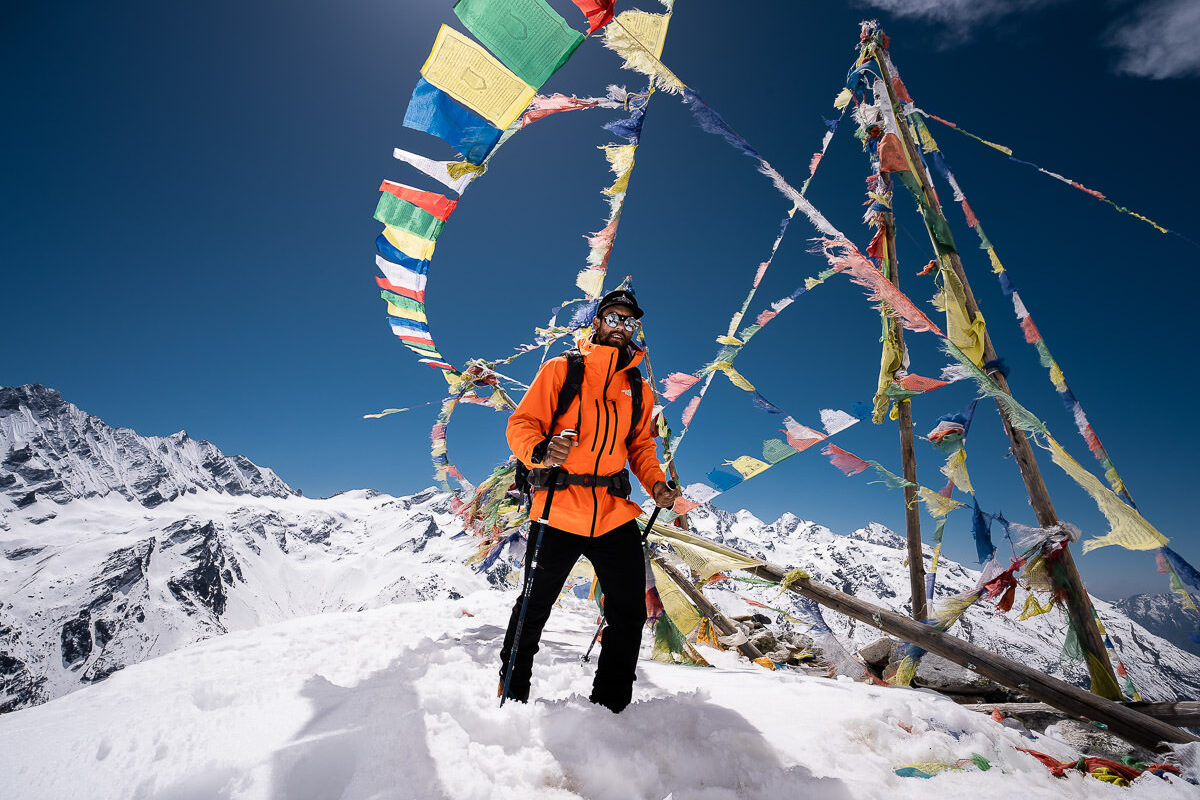
The Langtang Valley Trek is a unique expedition in the Himalayas of Nepal. While shorter than many other popular treks in Nepal, the adventurous expeditions and day-hikes throughout this route make it one of my favorites. After three days of trekking, you will reach Kyanjin Gompa. From this small mountain town, there are several incredible day-hikes with fantastic views.
The short 3-day trek into Kyanjin Gompa makes this trek shorter, cheaper but arguably more beautiful than other treks such as Manaslu Circuit, Everest Base Camp Trek, or the Annapurna Circuit. I did this trek with the trekking company Himalayan Masters who I’ve trekked with
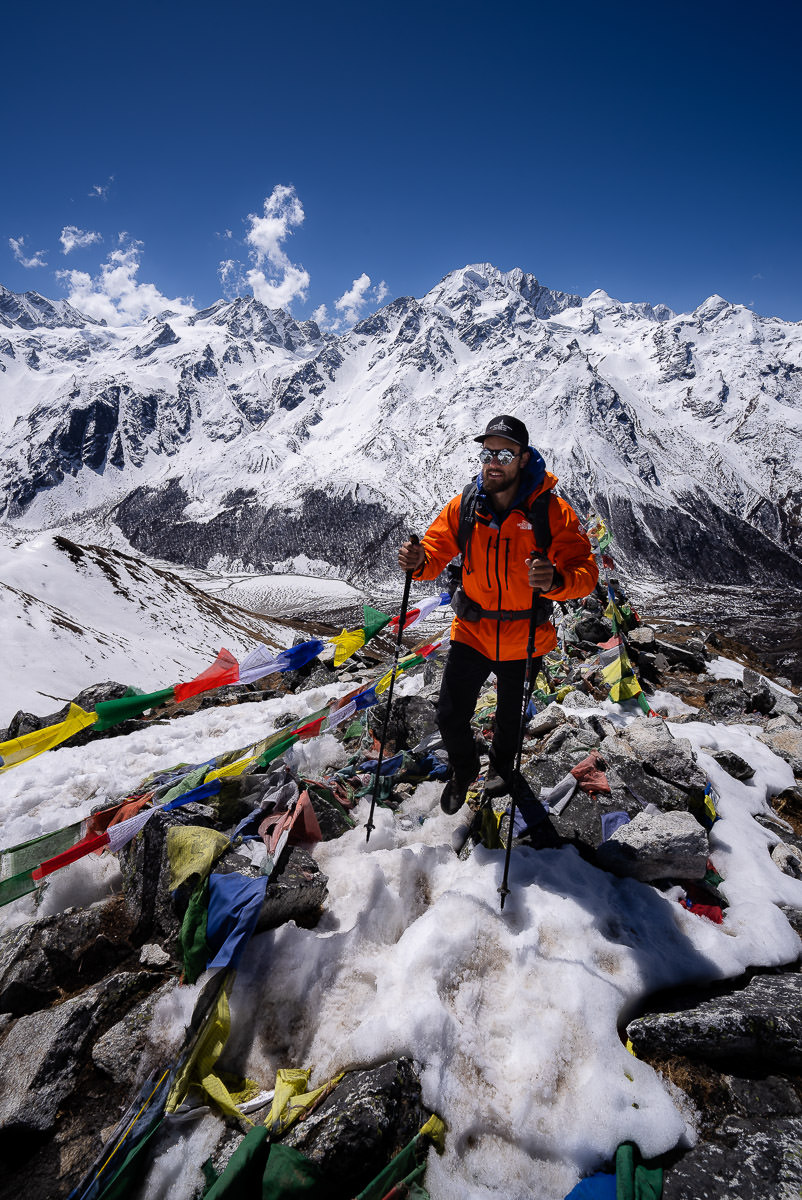
In this blog post, I will cover everything you need to know about the logistics of the Langtang Valley Trek. I’ll also share with you my experience on each day of the trek in the form of a short journal entry and my photos from that day. This will give you an idea of what to expect and a great insight into the scenery you will find on each day of the trek. I’ve already created a lengthy guide for the nearby viewpoints such as Tserko Ri, Kyanjin Ri, or the climb of Yala Peak .
Before sharing my experience in the second section of this blog post, I will detail all of the information you have to know in this complete guide about the Langtang Valley Trek and climbing Yala Peak.
BEST TREKKING COMPANY IN NEPAL
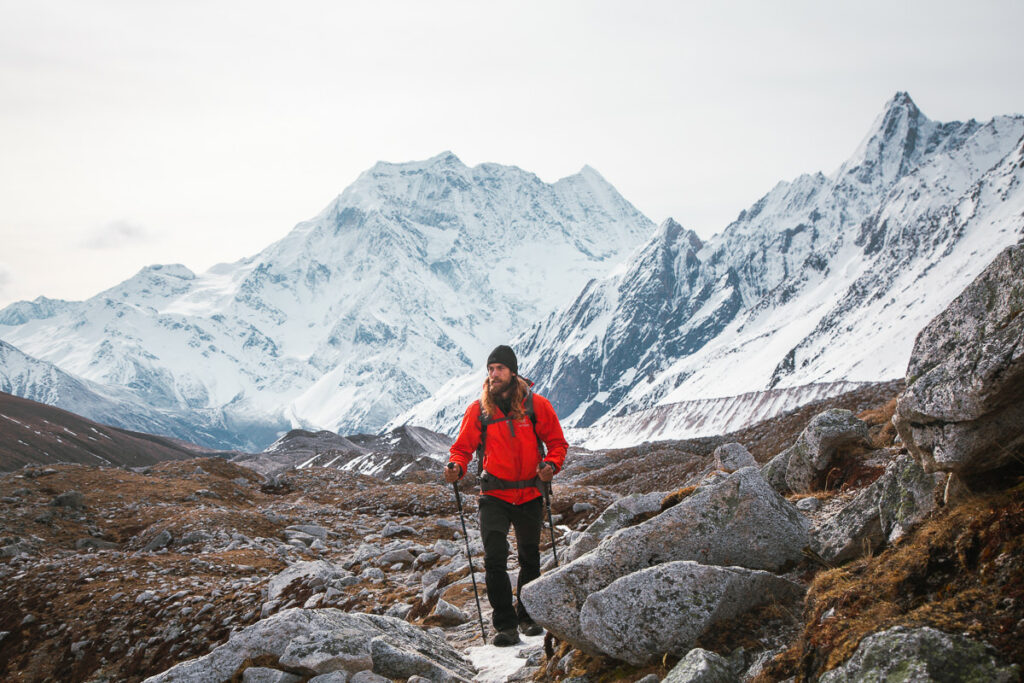
Interested in trekking in Nepal or doing the Everest Base Camp Trek? I recommend booking your trek with Himalayan Masters , which is the company I use for all of my treks in Nepal. Use my code JACKSON5 when you book to receive a 5% DISCOUNT .
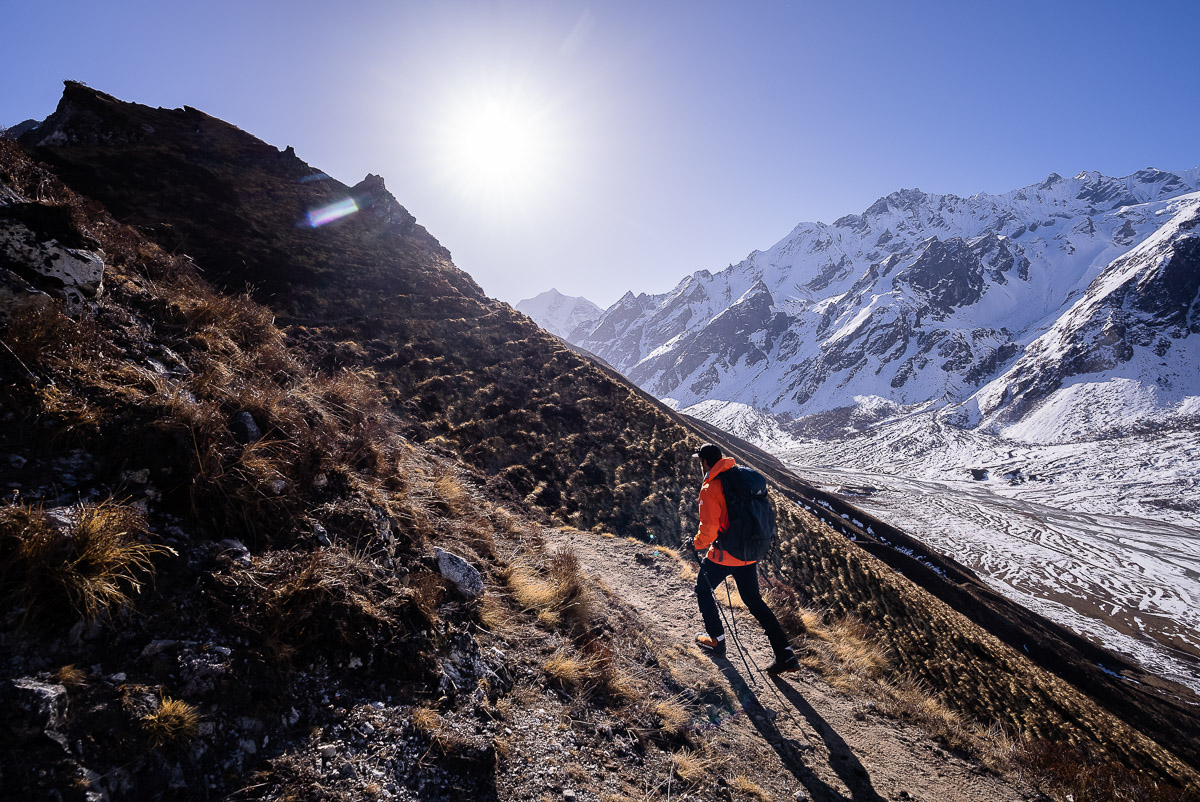
Table of Contents
A GUIDE TO THE LANGTANG VALLEY TREK
In this guide, you will find all of the valuable information you need to plan your trek as well as my personal experience on the entire trek including the Kyanjin Ri Viewpoint, Tserko Ri Viewpoint, and Yala Peak climb.
LANGTANG VALLEY TREK DETAILS
- Distance : 77km or 48 miles
- Days required : 9 days including 2 days of transit to and from Kathmandu (7 days trekking)
- Total Incline : 4000 meters
- Total Decline : 4000 meters
- The highest point on the trek : From Kyanjin Gompa you can reach Kyanjin Ri (4,773m) or Tserko Ri viewpoint (5,033m). Additionally, you can climb Yala Peak from Kyanjin Gompa, which has an altitude of 5,500m.
- Difficulty : The Langtang Valley Trek is much shorter than Everest Base Camp or the Annapurna Circuit although relativley similair. You will reach an altitude of 5000m, which will challenge many. Altitude sickness can be common. The route ascends quite quickly with several days having more than 1000m of altitude gain. These days of ascent are tiring and also require the body to adjust quickly. It is a good beginner trek in Nepal but not one to be taken lightly.
- Permits : You will need a TIMS card and Park Entrance Permit, both can be purchased when entering the park.
- Guide: A guide is not required on this trek. However, the guide manages all of the logistics, distances, directions, and tea houses for your group. I used maps.me to navigate from tea-house to tea-house and found the paths easy to follow. If it’s your first time trekking in Nepal, I would suggest having a guide.
- Accommodation: Guest Houses, also known as Tea Houses, are available along the way where you will sleep in a comfortable bed and have access to showers (extra charge) and restaurant facilities. It was very comfortable accommodation and great after a long day of hiking. Most of the villages were Tibetan, which gave us a great insight into their unique culture.
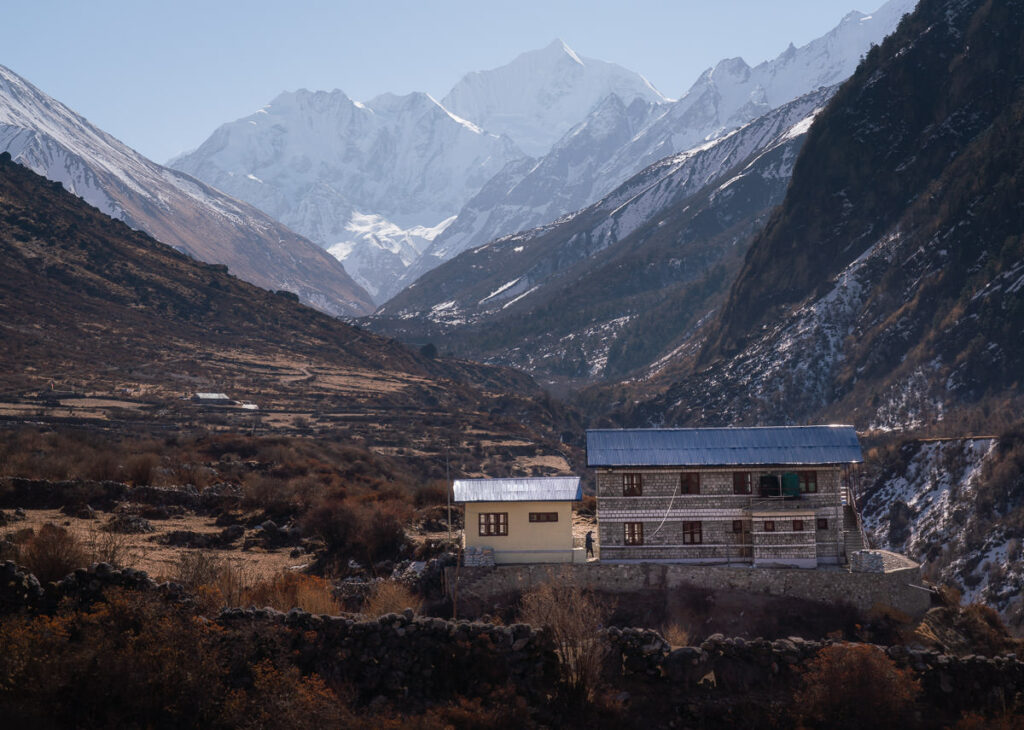
TRY THE 3 BEST TREKS IN NEPAL

Manaslu Circuit : My personal favorite 2-week trek through Tibetan villages and stunning scenery. Less crowded and more authentic.
Annapurna Circuit : The most beautiful & scenic 2-week trek in Nepal although can be crowded at times.
Everest Base Camp Trek : The most iconic 2-week route reaching the famous (EBC) Everest Base Camp at 5,300m.
KEY POINTS ABOUT THE LANGTANG VALLEY TREK
- This circuit is way less crowded than Everest Base Camp Trek or the Annapurna Circuit. It is growing in popularity but it’s still a great time to trek this circuit before it hits the mainstream.
- There are teahouses in each village along the way so each night you get a great sleep in a bed with blankets, have access to showers, eat great meals in a restaurant, and can charge your electronics and cameras.
- The trailhead can be reached by car so there is no need to pay for expensive domestic flights.
- I think it is important to base in Kyanjin Gompa for atleast three nights so you can hike up to Kyanjin Ri and Tserko Ri, which are the highlight of the trip.
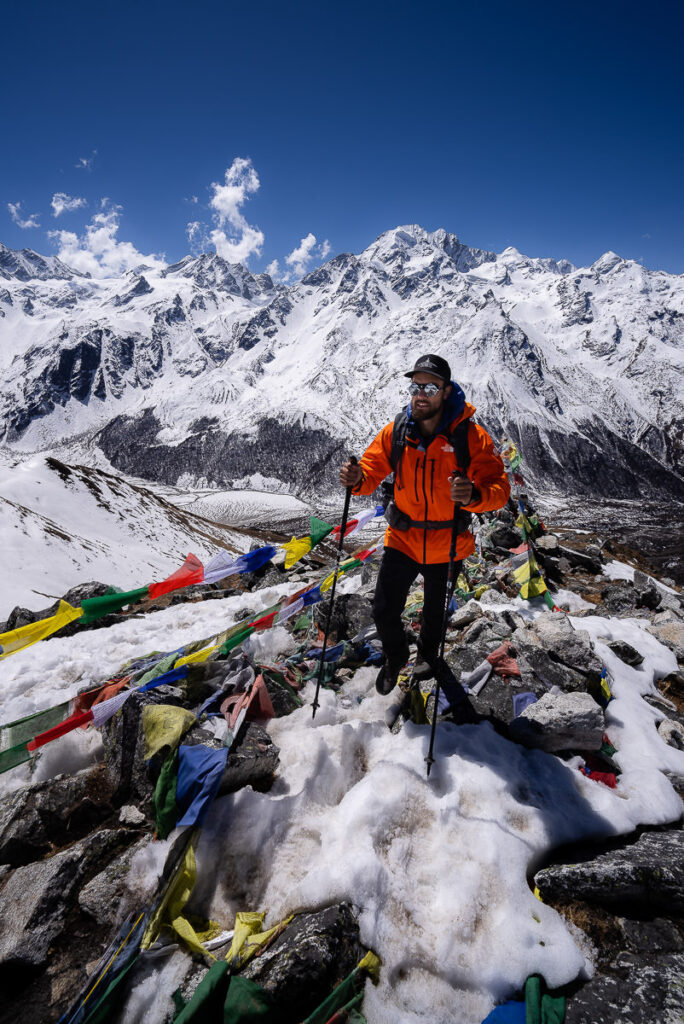
BOOKING A GUIDE FOR THE LANGTANG VALLEY TREK
The Langtang Valley Trek doesn’t require a guide but it’s great to have a guide managing the logistics such as directions, tea-houses, distances, medical issues, and the overall organization. I’d say 80% of trekkers go with a guide. I did the trek with Himalayan Masters which is one of the top trekking companies when it comes to the Langtang Valley Trek.
The trek costs around $800 USD with Himalayan Masters as of 2022 and includes all transfers, accommodation, meals, drinks, permits, and even the hotel stay before and after the trek at a high-quality hotel. I honestly had a great time on this trek and I can wholeheartedly recommend Himalayan Masters.
You can use my discount code ‘ JACKSON5 ‘ for 5% off the total price of your trek with Himalayan Masters which is a pretty handy saving.
Email: [email protected]
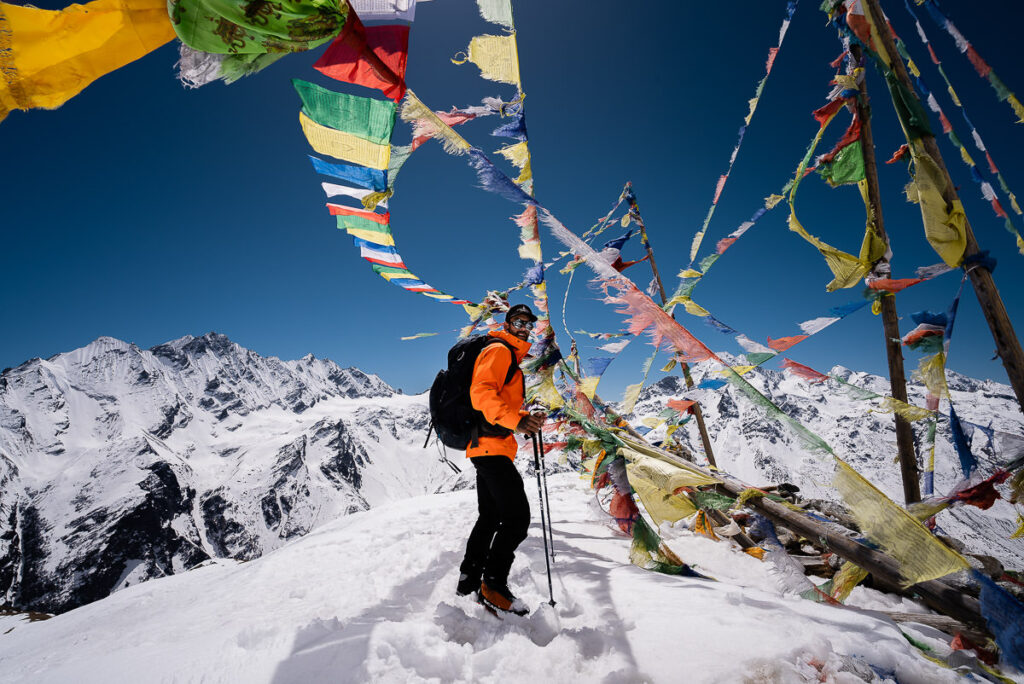
LANGTANG VALLEY TREK PACKING LIST
I packed pretty light and managed to wash most of my clothes each afternoon/night for the first half of the trip. In the latter stages of the trip, it was pretty cold so we weren’t sweating as much and we wore our warm gear basically nonstop while at the teahouses. There was no real need for multiple outfits.
This is just a guide and it worked quite well for me with no complaints from my set-up. You won’t need a sleeping bag as there are blankets in each guesthouse and when it got cold I just wore my down jacket to bed. This meant I didn’t have to carry a sleeping bag for the entire trek.
- 1 pair of pants that maybe convert to shorts
- 1 pair of shorts
- 1 Warm or thicker pair of hiking pants
- 1 Long sleeve quick-dry shirt
- 1 Long-sleeve thermal shirt
- 2 Short-sleeve t-shirts
- 1 Thermal long underwear
- 4 pairs of quick-dry underwear
- 1 Lightweight down jacket
- 1 Heavy-duty summit down jacket
- 1 Neck Buff
- Hiking boots
- 1 pair of warm summit socks
- 2-3 pairs of regular socks
- Trekking poles
- Water filter
All of this should fit into a backpack no bigger than 50L and should be less than 14kg.
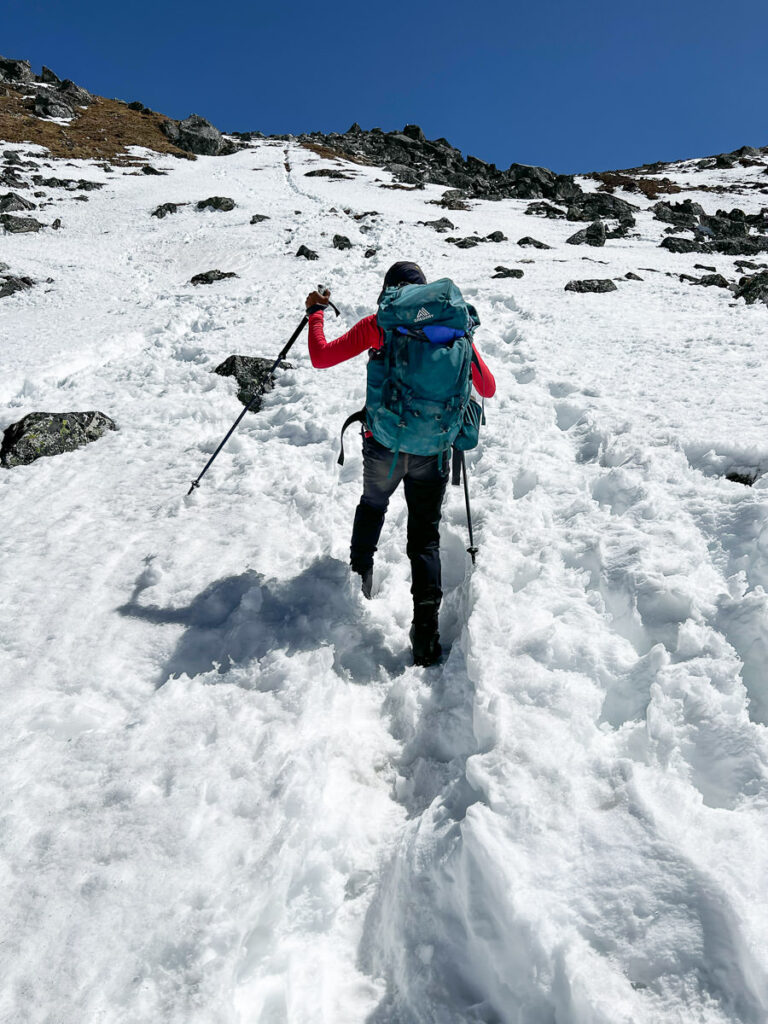
WIFI/ELECTRICITY AVAILABILITY ON THE LANGTANG VALLEY TREK
- Wifi: Costs anywhere from $free to $4 to use wifi at the guesthouses. Buy an NTC Sim before you go. It worked in most spots after Lama Hotel with a weak signal but we were able to send emails, watch Youtube, and message friends from Langtang and Kyanjin Gompa.
- Electricity: You will have to pay anywhere from $free at low elevation to $5 to charge your power banks, cameras, and phones. The key is to get a big power bank. Pay to charge it then charge everything from your power bank. My power bank lets me charge my phone and four camera batteries before it dies. Most of the places we stayed let us charge our gear for free but when it is busy they usually charge a fee as many teahouses run off gas or solar.
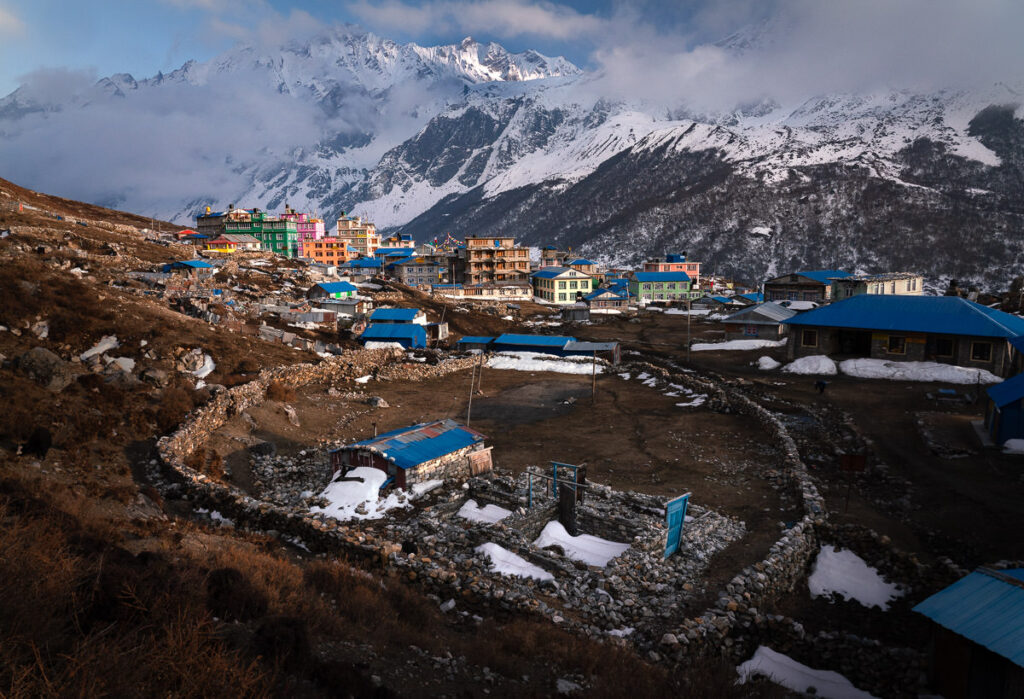
TOP 3 PLACES TO STAY IN KATHMANDU

- Ultimate Luxury: The Dwarika’s Hotel – Luxury, Spa-service, Pool
- Best Value : Aloft Kathmandu Thamel – Swimming Pool, Gym & Great Restuarant
- Budget Choice: Hotel Jampa is easily the top cheap hotel in Kathmandu
LANGTANG VALLEY TREK ITINERARY
This is one of the shorter treks in Nepal and has a straightforward itinerary.
- Day 1 : Drive from Kathmandu to Syabrubesi (1550m) 7 hours
- Day 2: Syabrubesi to Lama Hotel (2,380m) 6 hours
- Day 3 : Lama Hotel to Mundu via Langtang Village (3,430) 6 hours
- Day 4: Mundu to Kyanjin Gompa (3,870m) 3 hours
- Day 5 : Kyanjin Gompa to Tserko Ri to Kyanjin Gompa (5000m) 7 hours
- Day 6: Kyanjin Gompa to Lama Hotel (2,380m) 6 hours
- Day 7: Lama Hotel to Syabrubesi (1550m) 6 hours
- Day 8: Drive from Syabrubesi to Kathmandu 7 hours
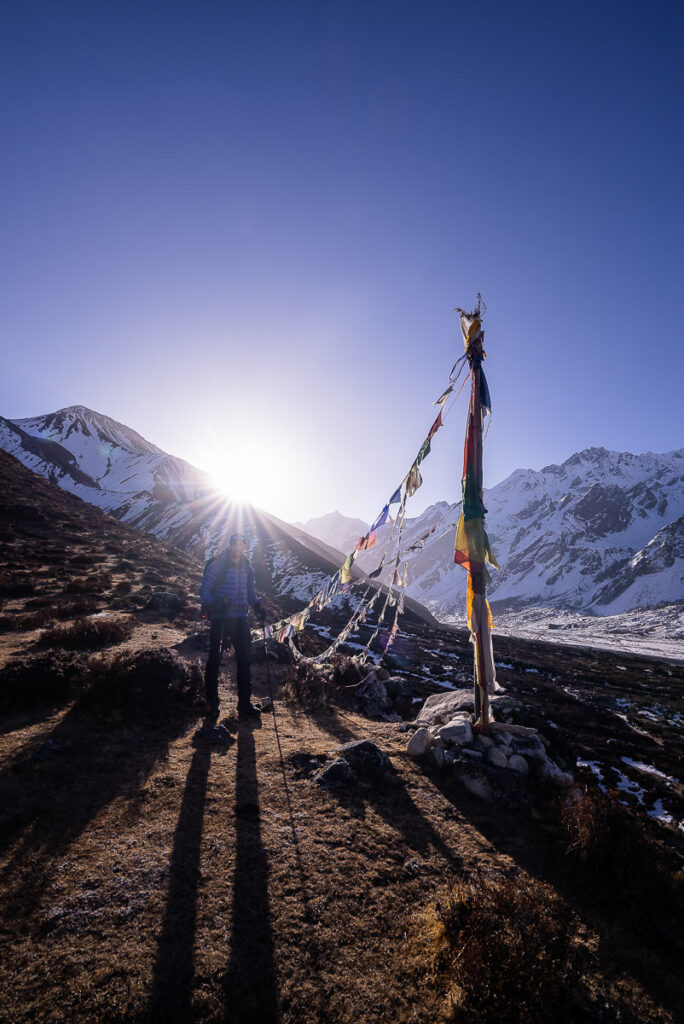
THE FULL VLOG FROM OUR LANGTANG VALLEY TREK
DRINKING WATER ON THE LANGTANG VALLEY TREK
I use the Grayl Ultralight Water Purifier and it is a game-changer for hiking in Nepal, making this super easy and cheap. The Grayl Ultralight Water Purifier removes 99.9999% of viruses of disease-causing bacteria. The best thing about it is it only takes 15 seconds and one press to purify water from any fresh water source. You don’t need to buy bottled water at every tea-house contributing to large amounts of plastic waste and costing you $4+ per day.
Along the Langtang Valley Trek, we filled up at tea-houses, rivers, and local village taps. Unlike aqua purification tablets which require you to wait 30 minutes before drinking, you can have rehydrated yourself immediately with the Grayl Ultralight Water Purifier .
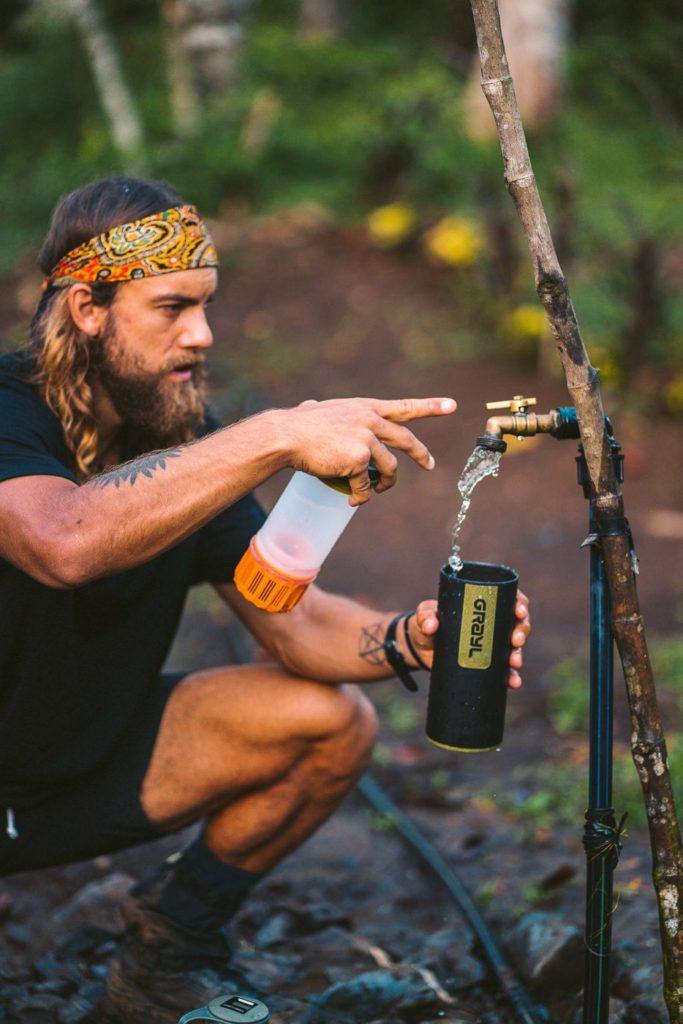
GrayL Water Purifier
- Never pay for water on the trek
- Save 3-4 plastic water bottles a day
- Turns any water into drinking water
INSURANCE FOR THE LANGTANG VALLEY TREK
Nepal can be a dangerous place for trekking or hiking because the high altitude can lead to many illnesses, weakness in trekkers, and misjudgments. There is also a risk on trails for falls, avalanches, or other mishaps. Your regular travel insurance probably won’t cover you at high altitude and won’t cover a helicopter evacuation. There is a solution though .
Need extra protection?
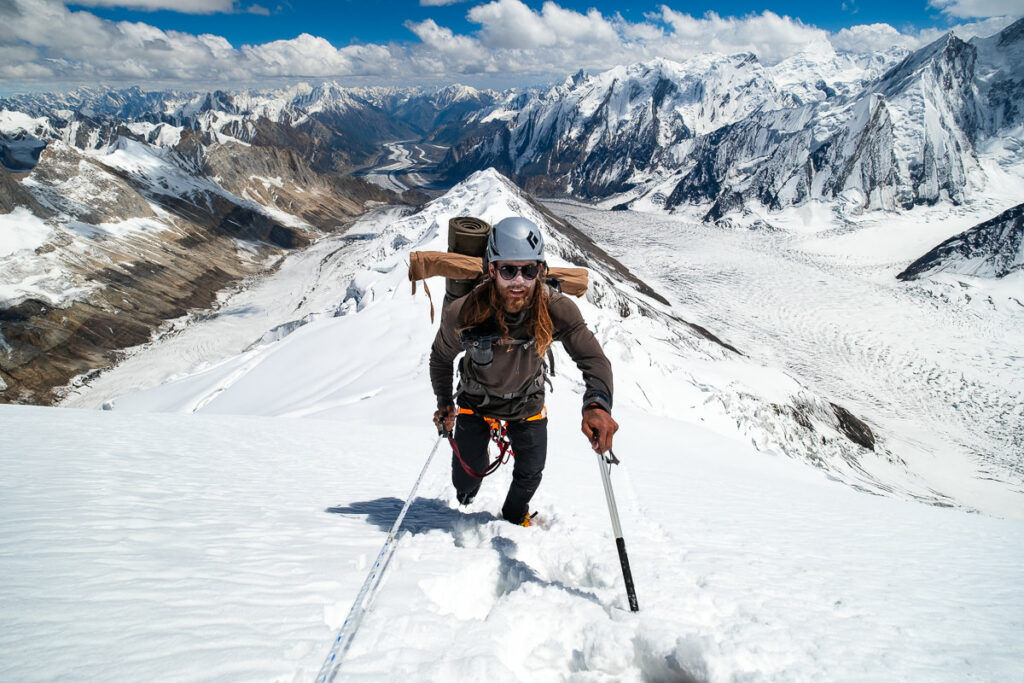
Regular travel insurance is great but won’t cover you for high altitude hikes or for helicopter evacuation. Each year, I purchase a Global Rescue Subscription .
For less than $500 per year or $100 per expedition, you can purchase a Global Rescue subscription and be covered no matter how extreme the hike or how high the climb is.
BEST TIME AND SEASON FOR THE LANGTANG VALLEY TREK
The peak season for the Langtang Valley Trek is March to April and October to November. The time to avoid this trek is during the rainy season from June to August .
During the winter from December to February, this region gets very cold and there will be snow cover in the higher parts of the trek. Many of the guesthouses actually close up for the winter and re-open in late February to March. However, it is possible to hike the Langtang Valley Trek on the fringe of the season in late February/early March and it can be quite beautiful with snow cover.
I hiked the Langtang Valley Trek in early March and it was warm during the day and got pretty cold at night. We experienced some heavy snow on Tserko Ri and Yala Peak but the trekking routes were clear.
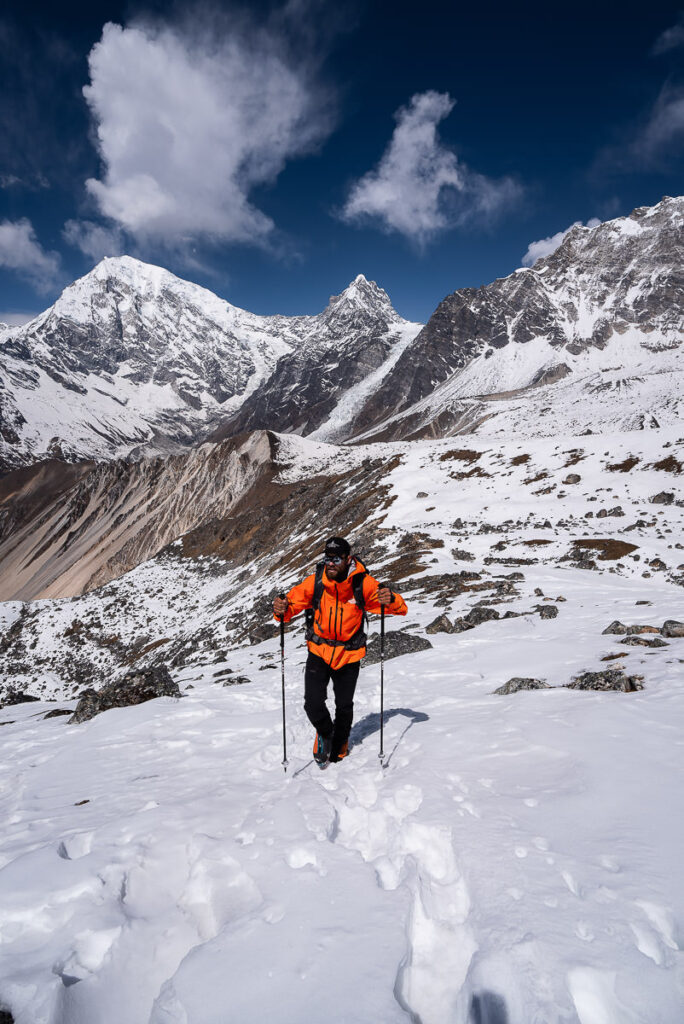
HOW TO GET TO THE LANGTANG VALLEY TREK
There are two main ways to reach Syabrubesi, which is the small town at the starting point of the trek. Despite the distance from Kathmandu to Syabrubesi only being 125km, the journey takes a long time due to the traffic and quality of the road.
Jeep: We went by private Jeep organized by our tour company Himalayan Masters. It costs about $180 to hire the vehicle out for the drive so can be split between your group. It’s not cheap but much less brutal than the lengthy bus journey.
Public Bus: The bus costs about $10 USD and can take anywhere from 7-10 hours depending on the traffic and if there are any roadworks or landslides recently. The bus leaves every day from Kathmandu to Syabrubesi at 6 am and 8 am as well as other defined times. The bus station in Kathmandu is called ‘ New Bus Station’ .
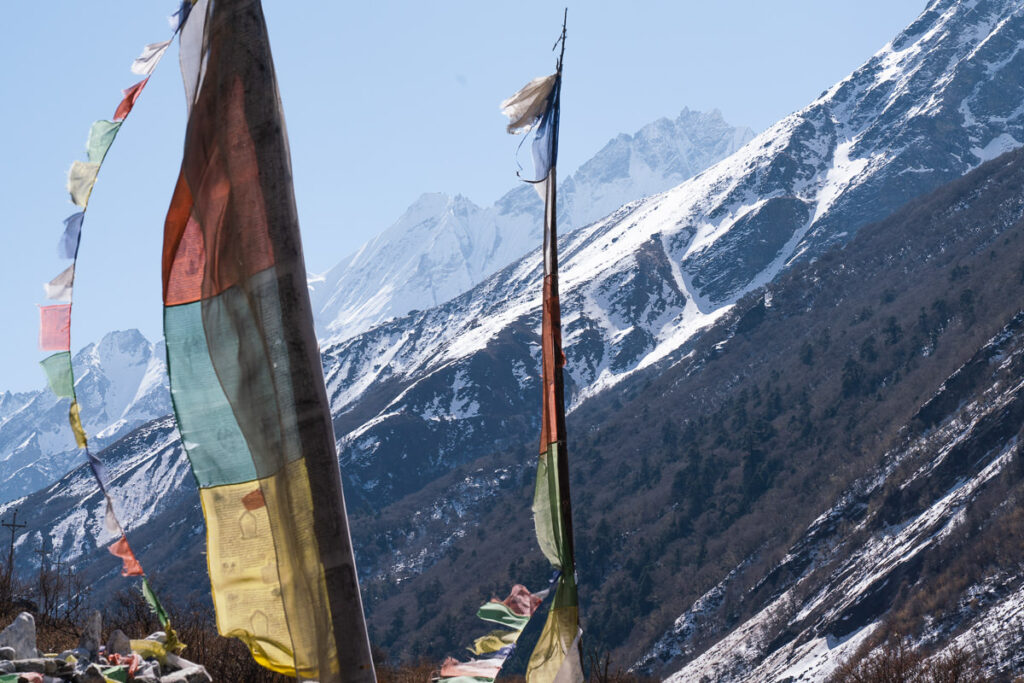
MY EXPERIENCE ON THE LANGTANG VALLEY TREK
Throughout this section of this guide, I will share my experience with each part of this trek. I found the Langtang Valley Trek quite unique as the trek in was actually not too exciting. However, it became an incredible experience once we reached Kyanjin Gompa and did the two hikes Tserko Ri and Kyanjin Ri as well as the Yala Peak climb.
So, unlike other treks where the trekking along the route is the highlight, I found that the time when we were based at Kyanjin Gompa was the highlight and found the trek into Kyanjin Gompa relatively mild.
TREKKING FROM SYABRUBESI TO KYANJIN GOMPA
Syabrubesi seems somewhat of a trekking town even though it is connected by road to the greater civilization. The main street is lined with guesthouses and some of the menus display prices that would see you are already in a remote mountain village.
I would recommend Hotel Lhasa for good Momo and friendly Tibetan owners. This is the last place you will have a reliable internet connection, a moderately warm shower, and a chance to buy any last-minute essentials.
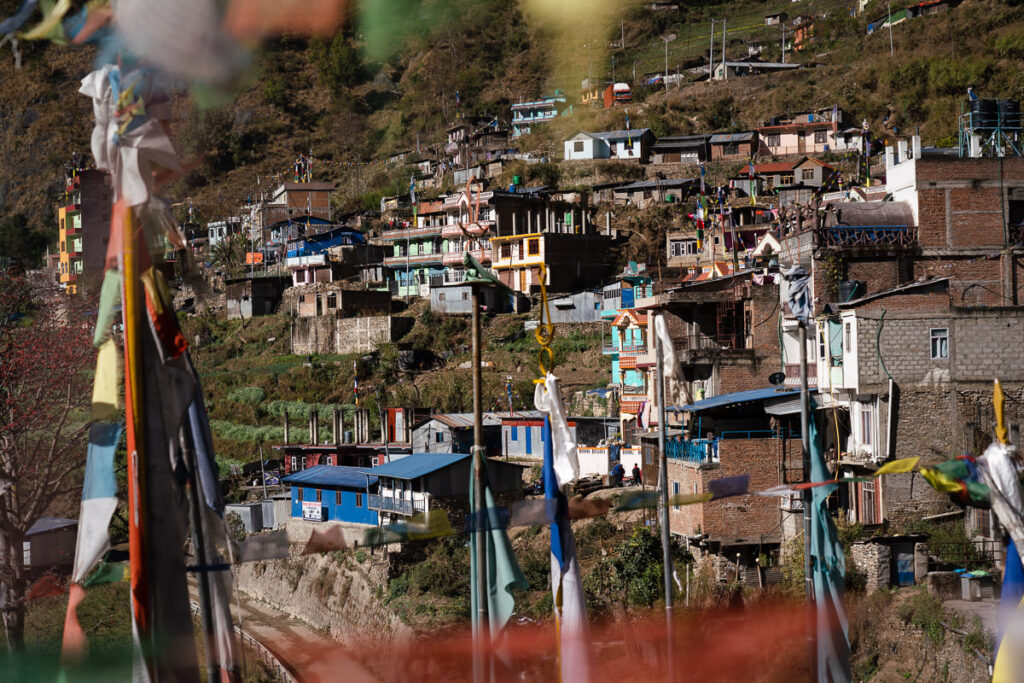
The journey from Syabrubesi to Kyanjin Gompa typically takes most trekkers three days. There are many different options for guesthouses along the way but most seem to follow a distinct route.
Lama Hotel (name of the town not the hotel) is the most common stop for the first night. The trek from Syabrubesi to Lama Hotel is quite intense and involves about 15 kilometers in distance. However, it is the 1200m of vertical gain and sun exposure that will knock you about.
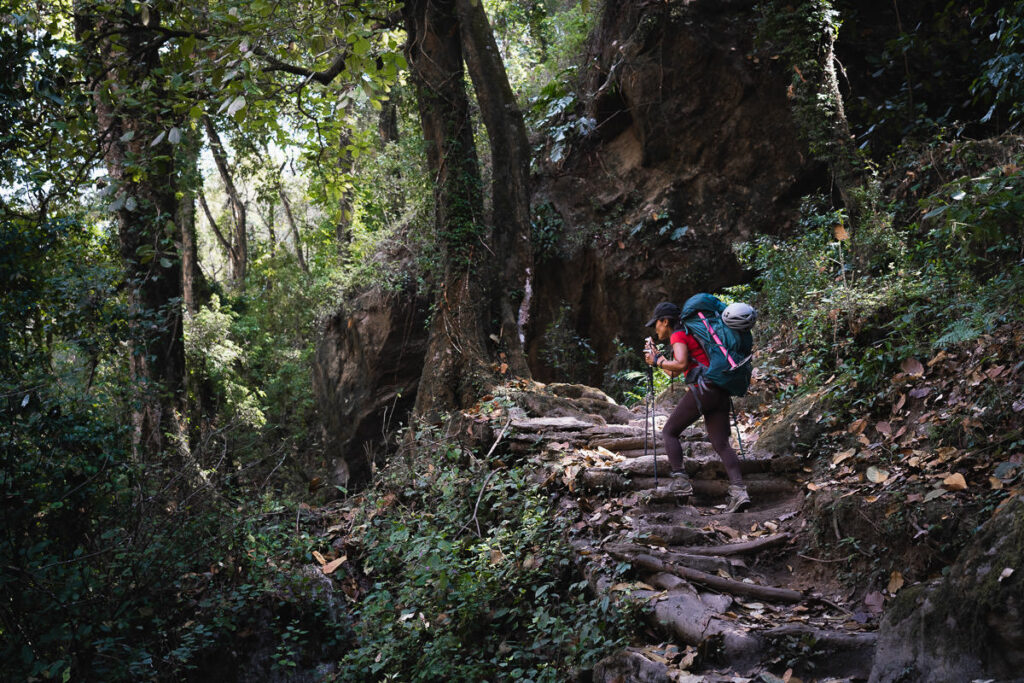
The trail begins alongside the river and has a lot of exposed sunny sections. The elevation isn’t high yet at just over 2300m so it can be very hot. Undulating alongside the river, the trail delves into the forest and careens up endless flights of rocky stairs. You can expect a few glimpses of snow-covered peaks but today is mostly about the river, forests, and a few bridge crossings as the highlights.
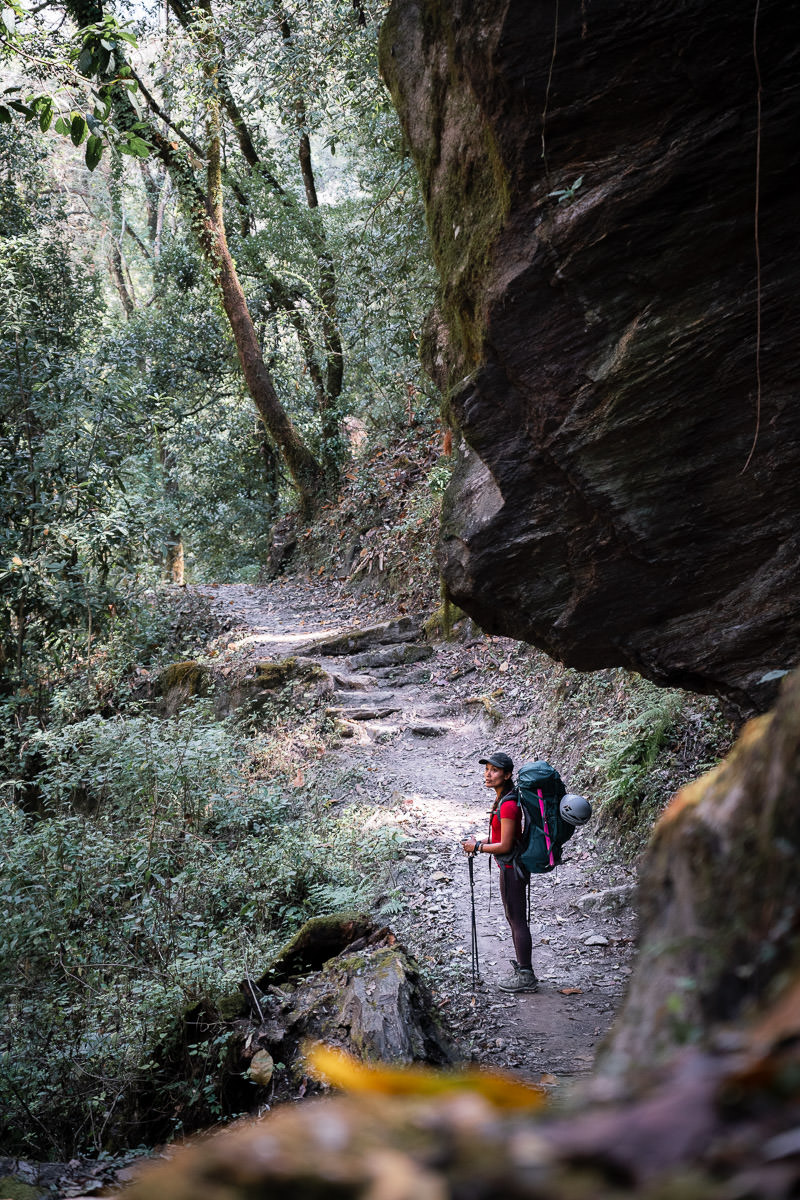
Upon reaching Lama Hotel, we were a little confused. There were six or seven hotels, all with Lama Hotel in their signage. Friendly Guest House Lama Hotel, Origin Lama Hotel, Sunrise Guest House Lama Hotel. It turns out this small village is just a collection of hotels and the location is known as Lama Hotel.
We ended up staying at the Friendly Guest House, run by a Tibetan family who was indeed friendly. Here we had a warm bucket shower, no signal, no electricity, great Tibetan food, a warm heater in the dining room, and comfortable beds with blankets. All you can ask for in the mountains really.
On our second day of trekking, we headed from Lama Hotel all the way to Langtang. You could stop earlier at smaller towns, but Langtang was recommended to us. The trail really opens up in the second half of the day as you break out of the forest and trek along the slopes of the valley towards Langtang.
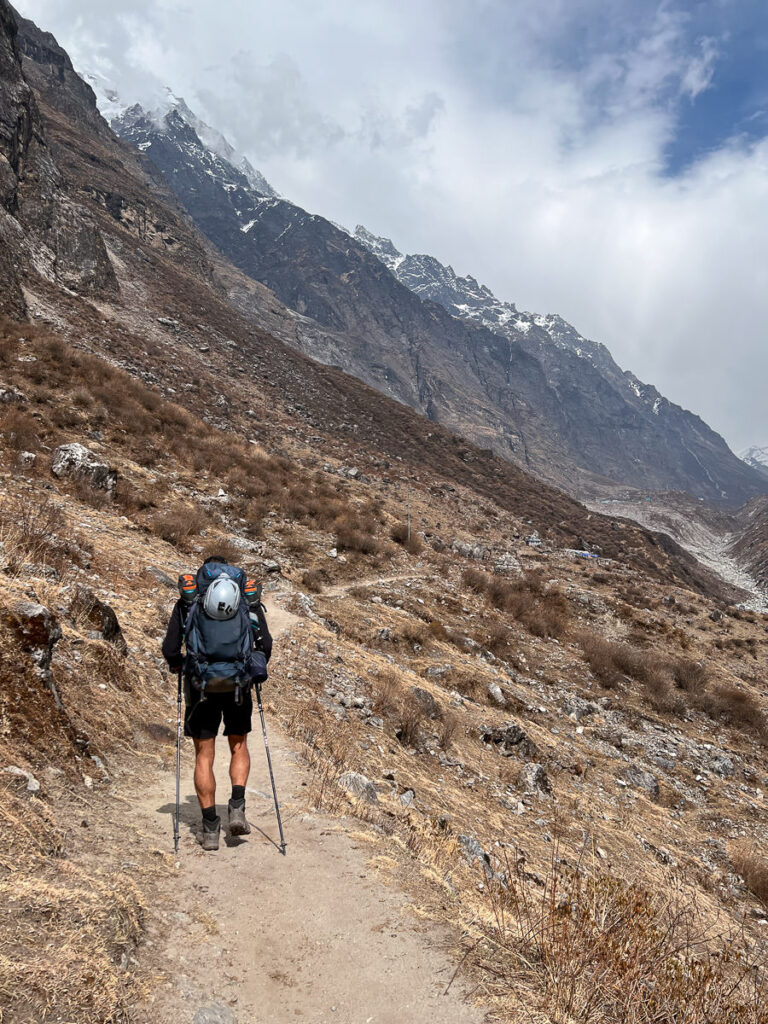
Snow-capped peaks begin to appear throughout the day. However, just after winter, the landscape is burnt orange. In the spring, you could expect lush green grass and wildflowers to create a much more vibrant setting. Personally, I prefer the trekking during the winter time when there are more snow-capped peaks.
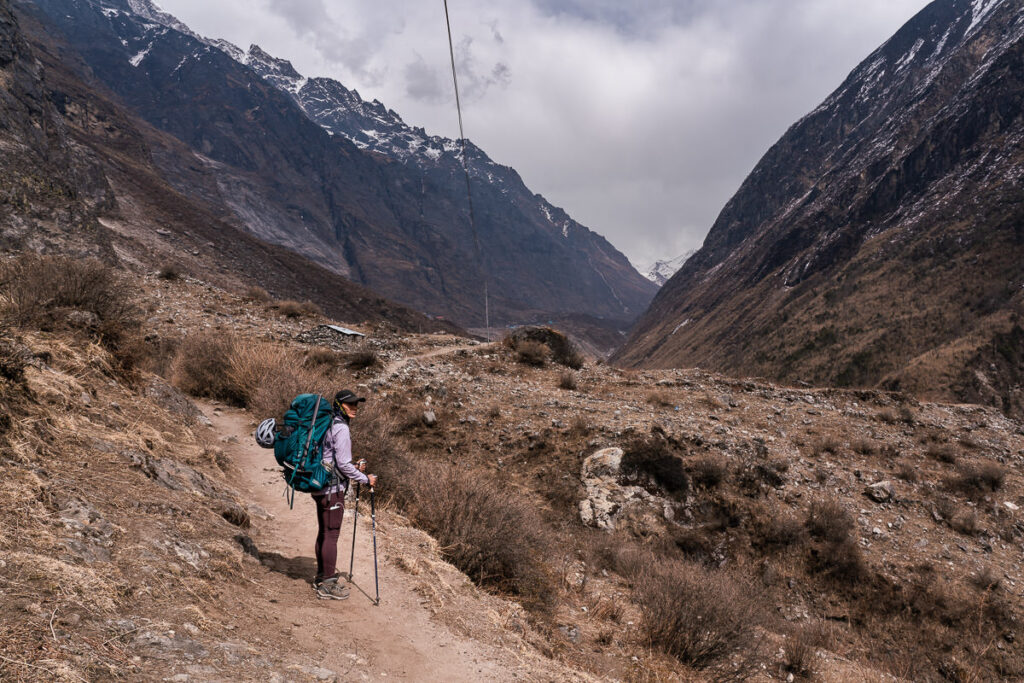
The journey from Lama Hotel to Langtang Village was about nine kilometers with almost 800 meters of incline. It was much softer than the first day but you are now reaching a higher elevation and may start to feel the oxygen thinning. In Langtang, I stayed at Chomo Valais and it had a hot shower and comfortable beds. It was similar to most tea-houses in the region and had a nice dining room with glass windows to enjoy the view.
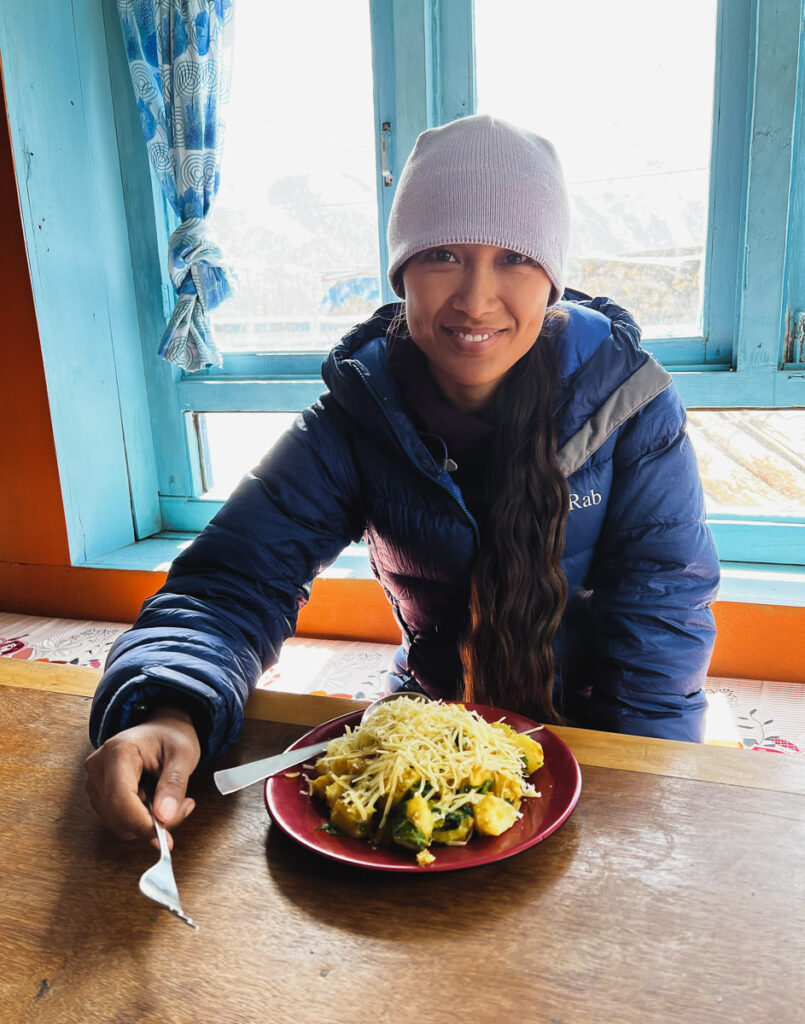
The final day of trekking from Langtang Village to Kyanjin Gompa is short and sweet. With just 6.5 kilometers and a few hundred meters of incline, it is by far the shortest day of the trek. Many people actually find it so short, they had up to Kyanjin Ri viewpoint on the same day as reaching Kyanjin Gompa.
On the way to Kyanjin Gompa, spectacular views of Tserko Ri and 7000m snow-capped peaks come into view. Following the river, you will pass by the stupa and monastery on your way into the town. Kyanjin Gompa is quite unique as the town is hidden from both sides until you basically reach the entrance due to the ridges and its hiding spot in the small valley.
I kept wondering when it would appear as the map said the entire town was just 150 yards away. I still couldn’t see any buildings, and then finally, we climbed the final hill and Kyanjin Gompa was revealed.
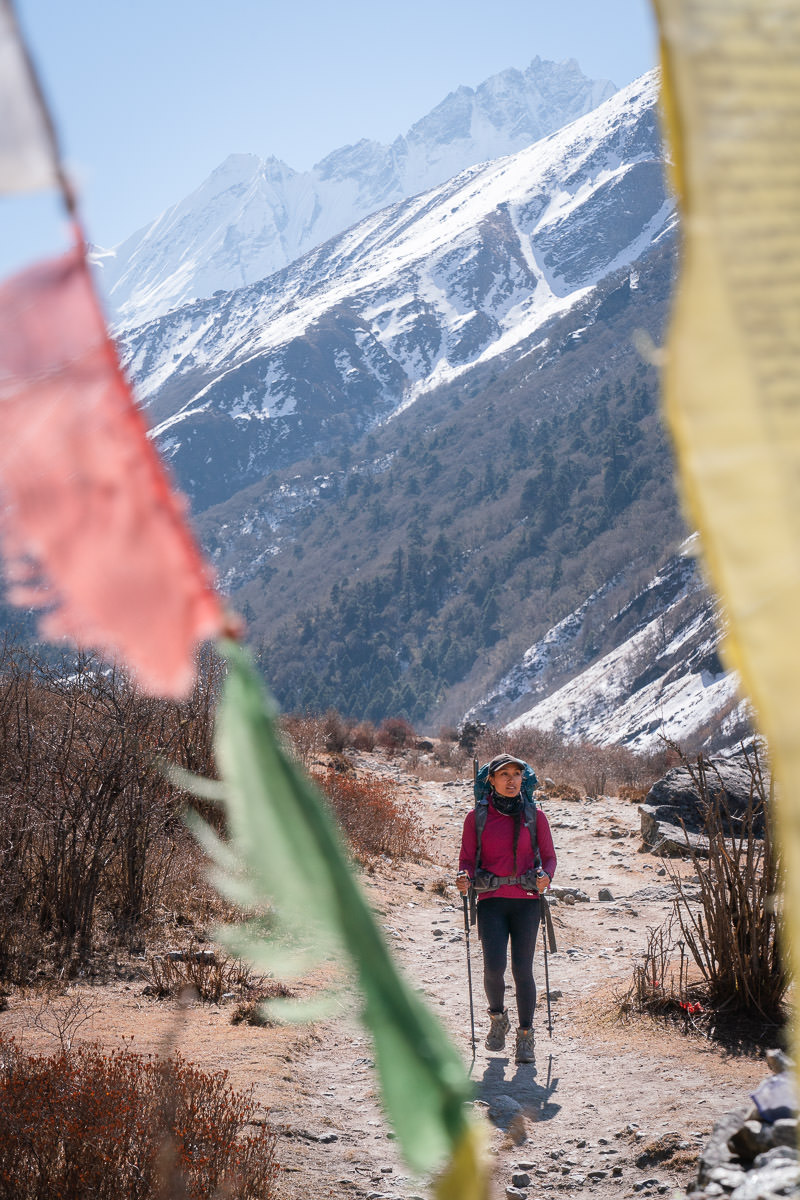
What are my favorite pieces of trekking gear?
There are six pieces of gear that I simply never forget when I go trekking. These are five items that I using right now and this list gets updated every year! Here are my trekking essentials.
- Arcteryx BETA AR Rain Jacket : This is my go-to rain jacket. It’s super light, folds down into a tiny ball, and protects brilliantly in a storm. This one never leaves my backpack.
- Salomon X Ultra 3 Mid GTX Hiking Boots : For the best ankle support, waterproofing, and durable exterior I’m a fan of tough but light hiking boots like these Salomons for my adventures.
- Black Diamond Head Torch : I can’t tell you how many times, I’ve arrived back from a hike unexpectedly late. I always keep this lightweight but strong headtorch in my bag for the unexpected.
- Darn Tough Socks : These are the most comfortable hiking socks I’ve ever worn and last for years. They also have a lifetime warranty and you just send them in with a hole and they replace it no questions asked.
- Osprey Atmos AG 65L Backpack : I’ve never had a more comfortable 65L pack than this one. I got it in the Navy Blue and have trekked with it through many a mountain.
- Bl ack Diamond Trekking Poles : They might feel weird at first, but on a long trek with incline and decline you’ll begin to love these.
- Grayl GeoPress Water Filter Bottle : I’ve used this for three years. It filters your water with one press and you can drink directly from it. Never buy a plastic water bottle again!
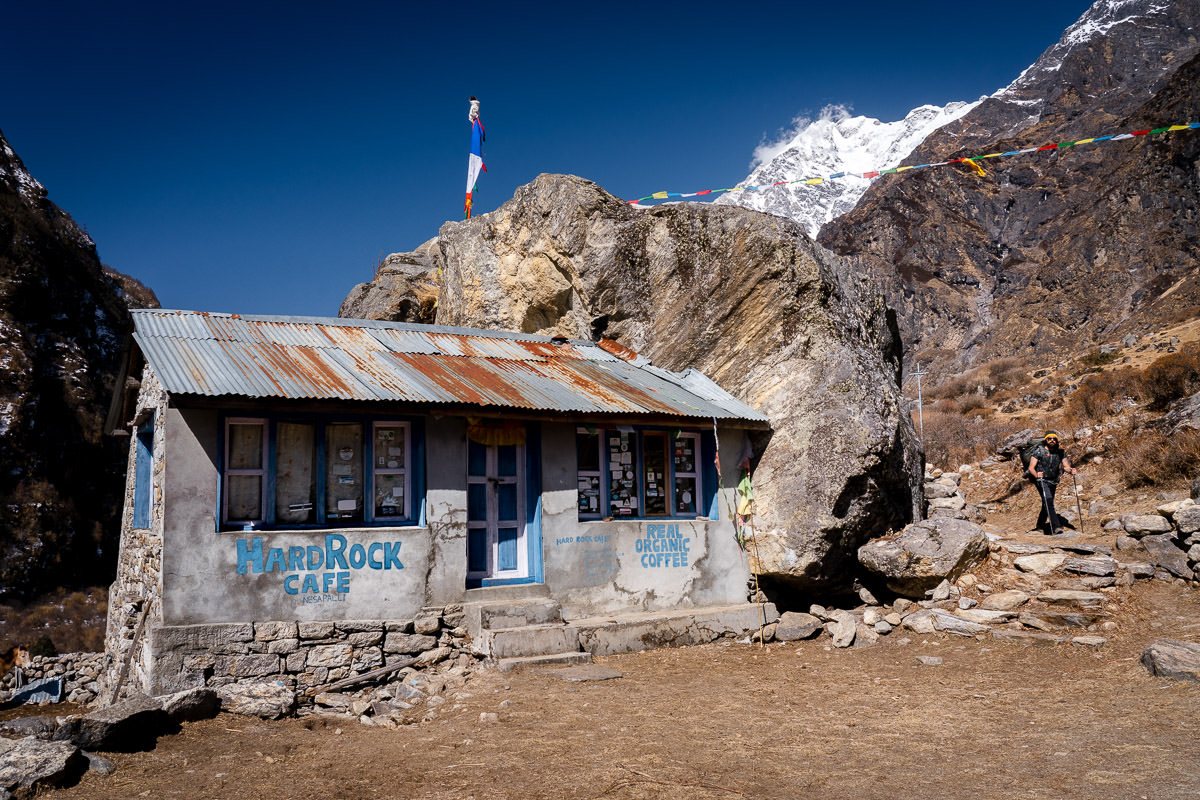
THINGS TO KNOW ABOUT KYANJIN GOMPA
Kyanjin Gompa is the end of the trek for most people. It’s a beautiful town with an incredible backdrop of snow peaks in all directions. The biggest mistake you can make on the Langtang Valley Trek is to stay one night and turn around and hike back down.
The absolute highlight of this trek is to base in Kyanjin Gompa for a few nights and spend one day hiking up Kyanjin Ri and one day hiking up Tserko Ri. We also spent another day climbing Yala Peak but that requires certain gear and experience.
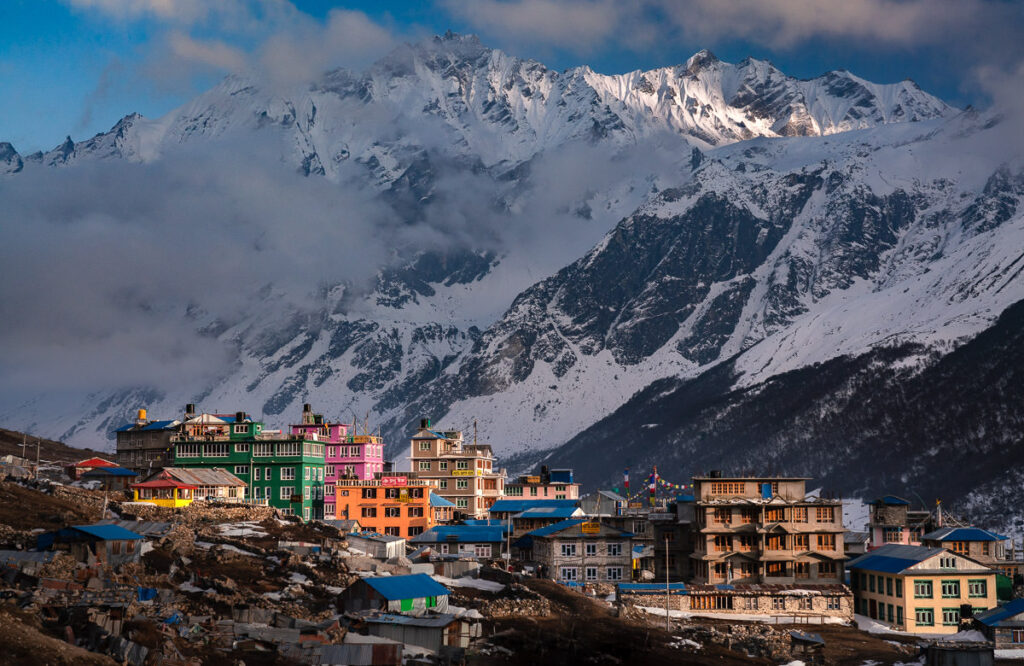
I ended up staying six nights in Kyanjin Gompa. My itinerary was the following:
- Yala Peak Base Camp
- Yala Peak/Sleep at Kyanjin Gompa
Understandably that is a lot of time but we were also trying to acclimatize for Yala Peak so we added in the rest days. The trek in to Kyanjin Gompa was good but not amazing. I really found that the time spent in Kyanjin Gompa was what made this trek is so great not the actual trek in itself. This is different from many other treks such as Everest Base Camp or the Annapurna Circuit where each day of trekking is the highlight rather than a specific destination or a specific town.
I stayed at Mountain View Hotel while in Kyanjin Gompa. It’s one of the smaller, older guest houses and I really enjoyed it here. Unlike many of the new multi-story hotels in the village, this hotel just had two floors and a cozy dining room.
Mipsang, the owner, is one of the kindest and most caring guys we’ve met in Nepal. Say hello to him for us if you end up staying there.
At Mountain View Hotel we had had water showers, internet connection from our sim card, great food, comfortable beds and blankets, and electrical outlets available in the room.
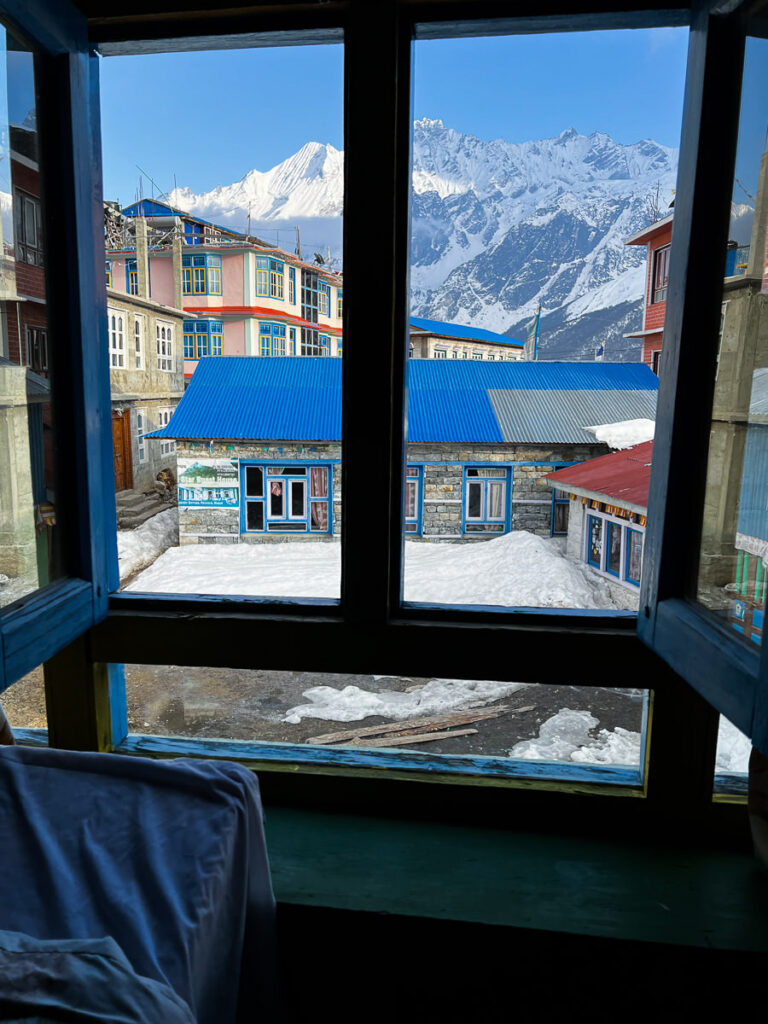
HIKING TO KYANJIN RI FROM KYANJIN GOMPA
From Kyanjin Gompa there are two awesome day-hikes. The smaller and most popular hike is Kyanjin Ri. This viewpoint towers over Kyanjin Gompa and has more than 700m of vertical gain in just a few kilometers. While short in distance, don’t underestimate this hike as it is incredibly steep and reaches heights of 4,700 meters.
The trail begins directly out of the town up the nearest ridge. A series of switchbacks leads you up to Lower Kyanjin Ri, which is the first viewpoint on the route. Covered in prayer flags, this viewpoint you will have you peering down over the entire town with jaw-dropping views across the valley.
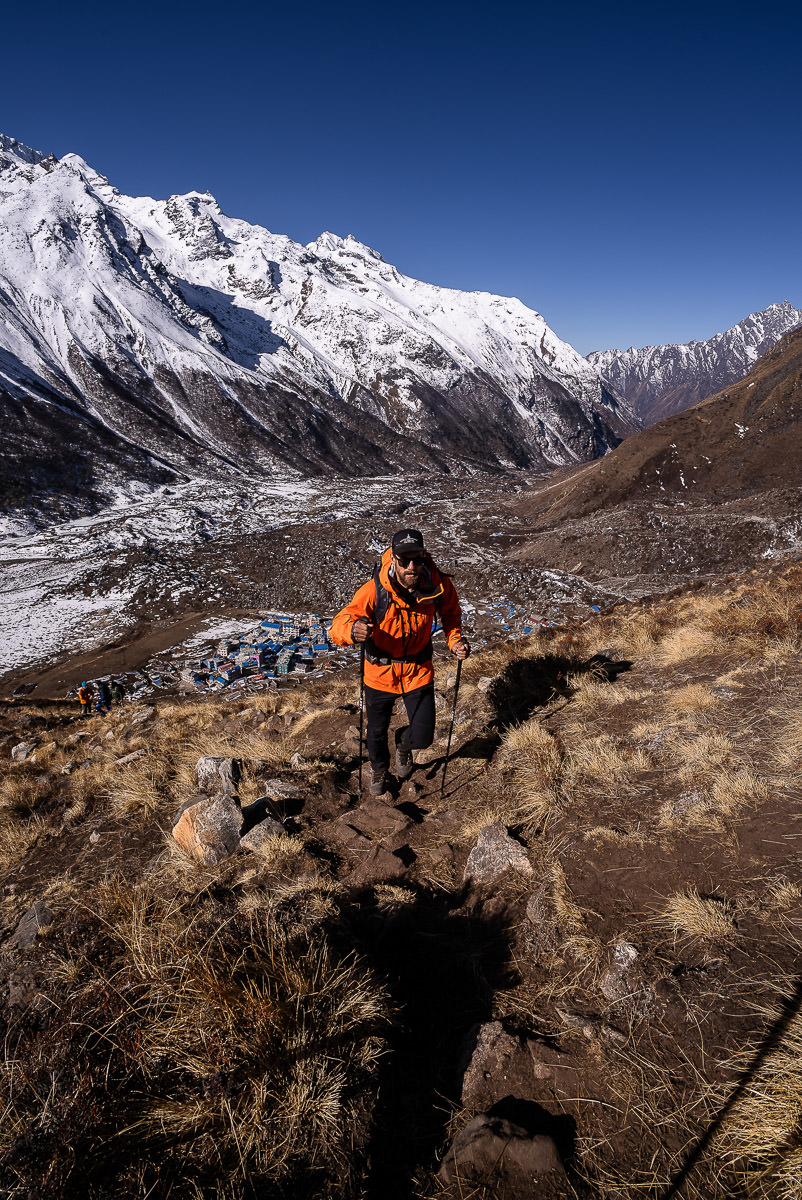
Continuing on, the ridge-line track continues higher and higher. We trekked just after winter and there was still considerable snow coverage for this trekking peak. Reaching Kyanjin Ri, we were walking across the snow at 4700m on a ridge overlooking the Langtang Lirung Glacier and the Langtang Lirung Peak (7,227m). To the right of Langtang Lirung you can find Changbu (6251m) and Yubra (6264m).
You can also spot Yala Peak (5,500m), which is the peak we ended up climbing on our trip to Kyanjin Gompa. And finally, across to the nearest peak, you can see Tserko Ri (5,000m), which will be your final objective on this trek.
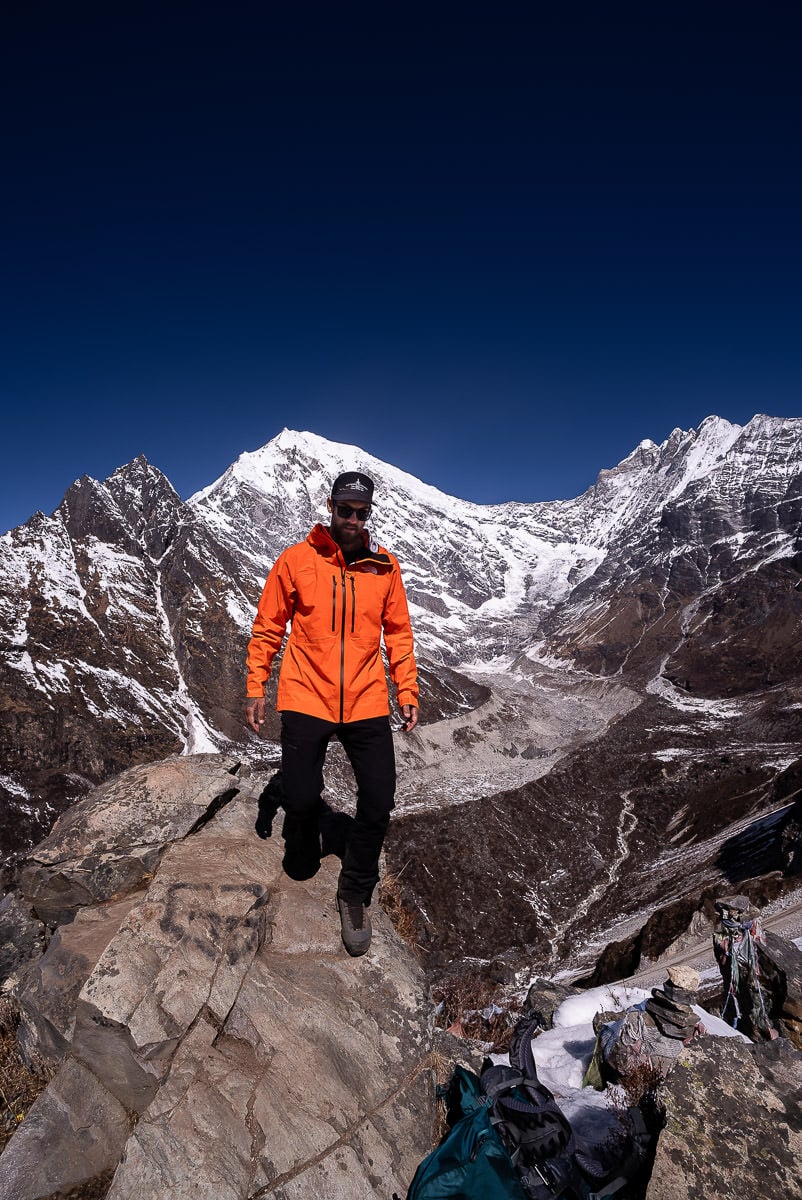
I suggest starting this hike just after sunrise as you won’t be too cold but you will also reach the summit before the afternoon clouds roll in. Take a packed lunch of Tibetan bread and an omelet from your tea house to eat at the summit and you are all set.
If you are interested in this expedition, I’ve written an entire guide about our Kyanjin Ri Hike.
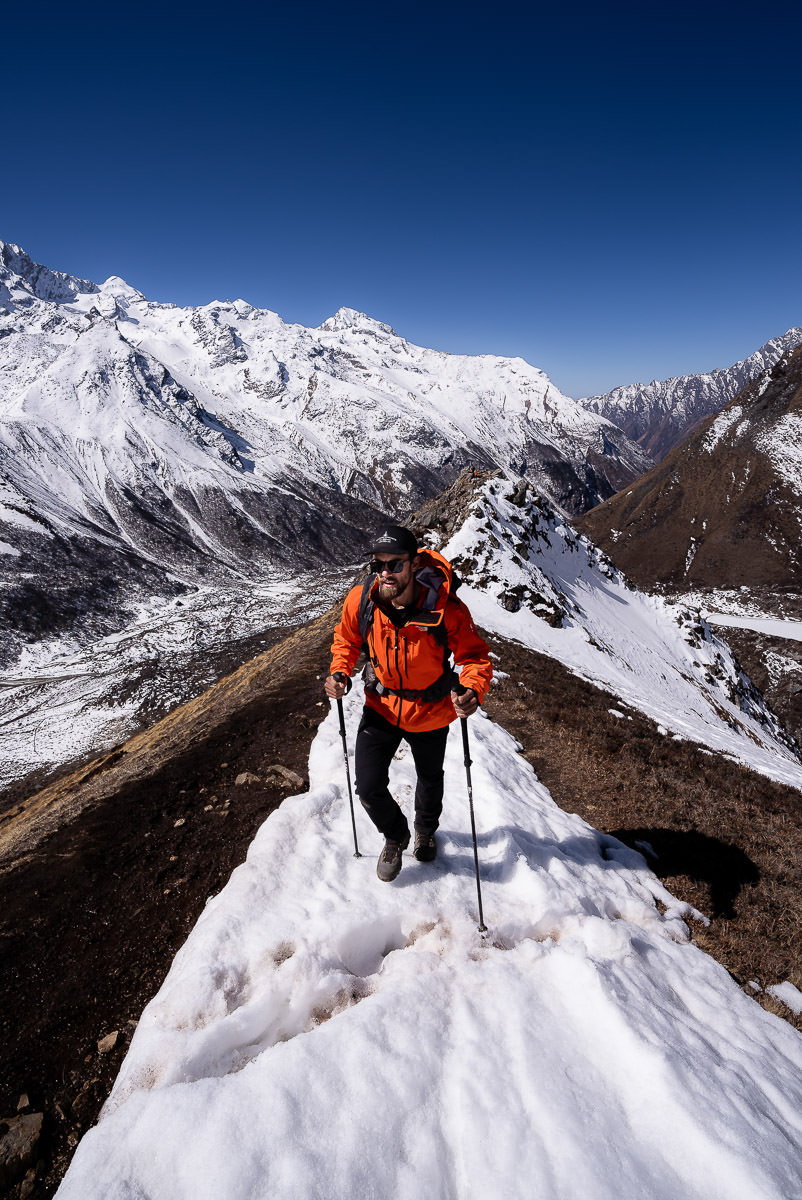
BEST INSURANCE FOR TRAVELERS
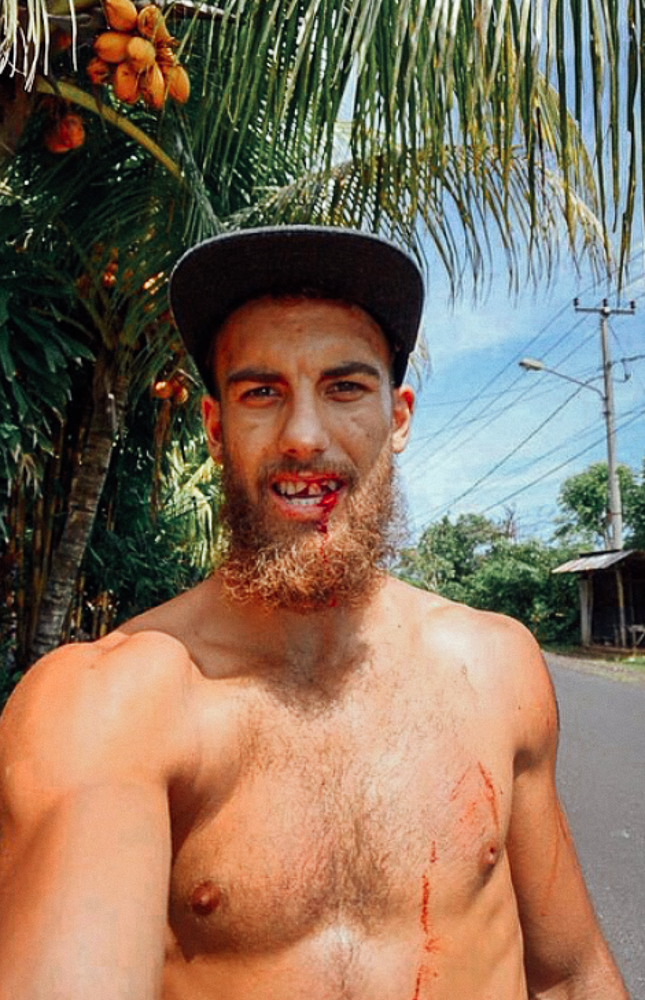
Don’t wait for an accident to happen… get insured! My travel insurance is HeyMondo which offers low-cost travel & medical insurance. That’s me on the left with three teeth knocked out after a motorbike crash in Bali!
You can click to read my Full Review of the Best Travel Insurance .
I’ve made several successful claims with HeyMondo and find their customer service very quick and helpful. Click the button below to get a 5% DISCOUNT
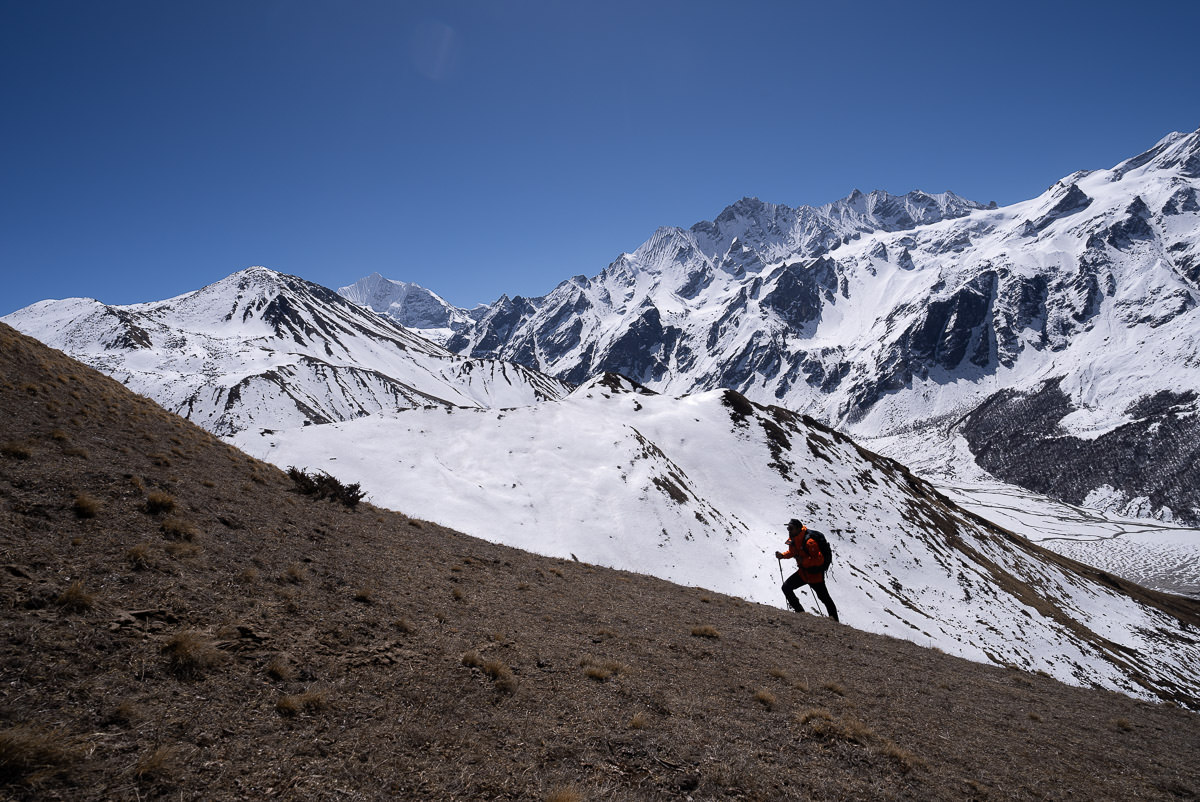
HIKING TO TSERKO RI FROM KYANJIN GOMPA
Tserko Ri (5,700m) is the finale for the Langtang Valley Trek. At 5,000m of elevation, this is a true test for trekkers against the elements and the altitude. It’s an optional day-hike, but one I highly suggest. Tserko Ri isn’t as hard as it sounds and is similar in many ways to its smaller brother, Kyanjin Ri.
The trek is about 8 kilometers in total with almost 1500m of incline throughout the day. It will definitely be a tough test and took us about seven hours to complete at a slow pace with lots of photos.
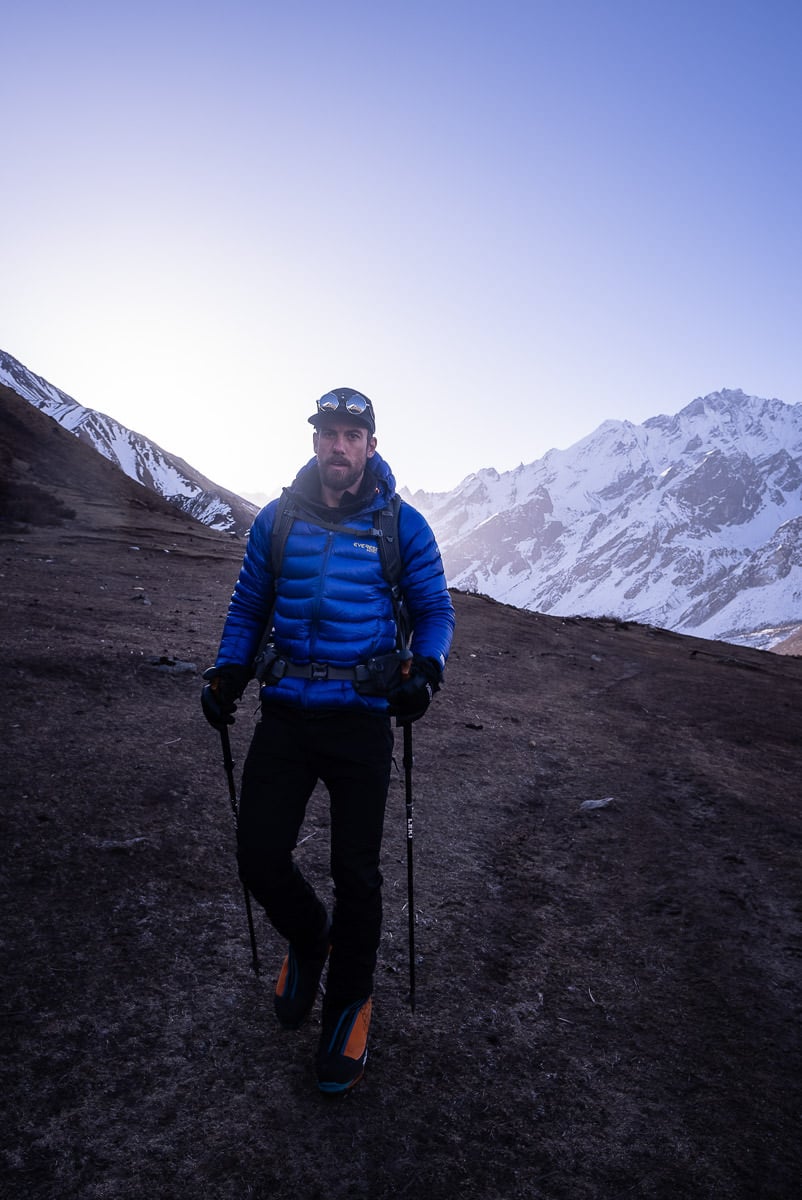
The trek takes you up a ridge all the way to the summit with very little danger to be found along the relatively wide and safe path. We visited just after winter and only encountered snow right at the last portion of the hike. Unfortunately, it was very soft and made it slow-going and difficult.
We managed to reach the summit and were the fourth and fifth people to touch the top for the season. Later in the season with less snow, this is a basic trekking peak and the only major consideration is the incline and the altitude.
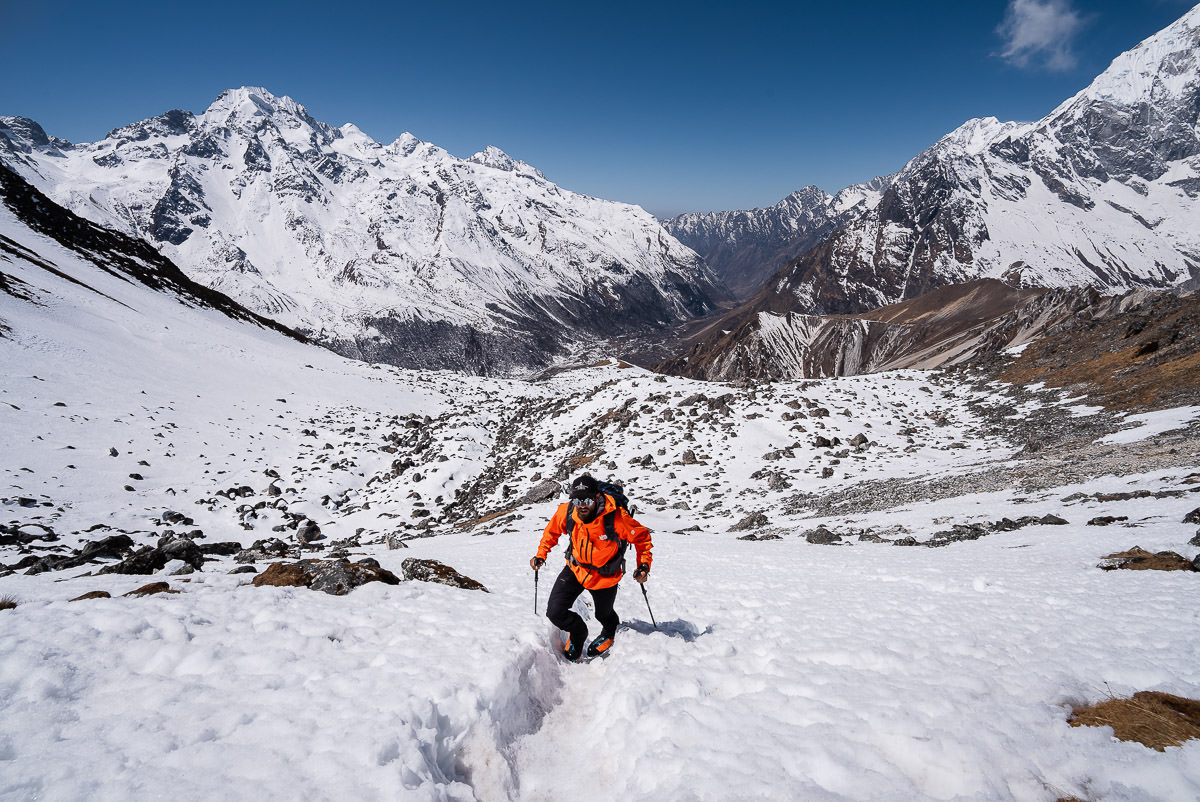
The summit of Tserko Ri is quite unique. A festival years ago at the summit involved carrying many large wooden poles to the top from which prayer flags were hung. There are so many poles and flags the summit has begun to look like a sailing ship. Nowhere in the Himalayas have I seen this many prayer flags at a summit, which made for a colorful, vibrant setting atop the peak.
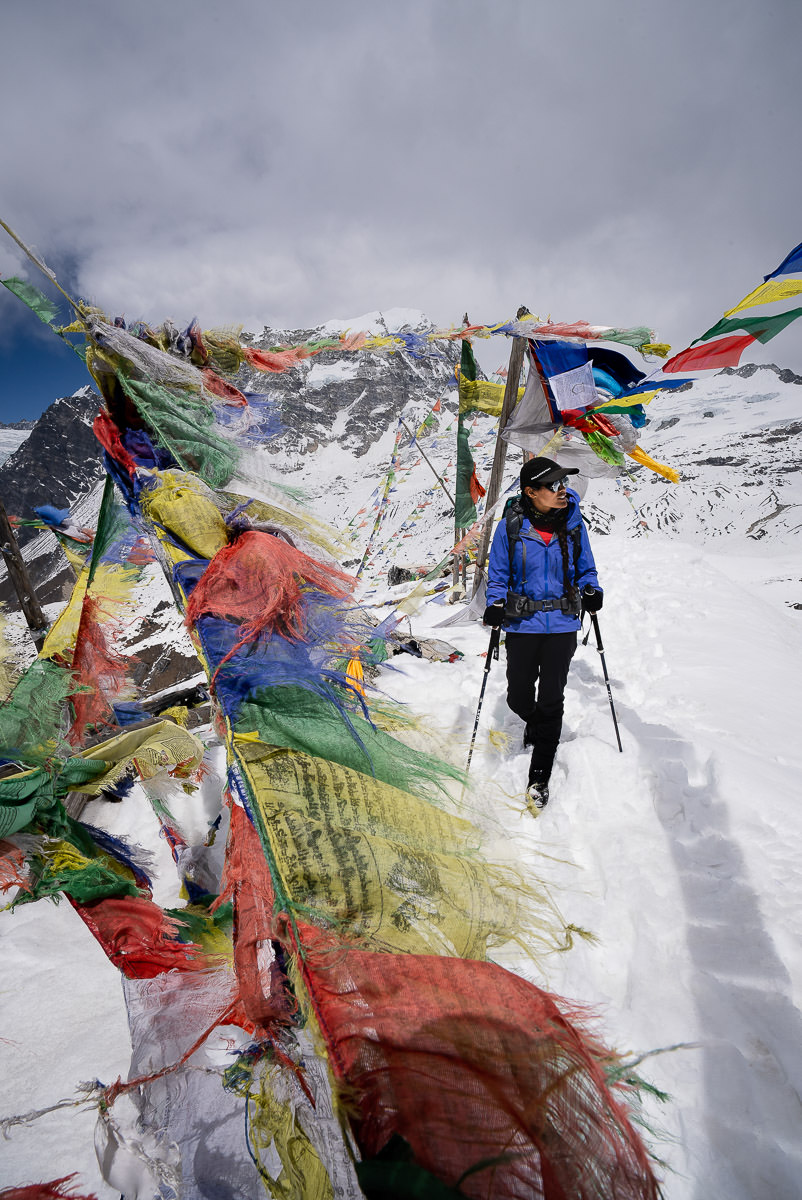
The views from Tserko Ri are simply phenomenal. With panoramic views, you can expect to see Yala Peak, Langtang Ri, Langtang Lirung, Naya Khang and many more.
As with Kyanjin Ri, it is best to be up at the summit before midday to avoid the afternoon clouds rolling in. I advise starting this hike no later than 7 am for the best possible conditions and views at the summit.
If you are interested in this expedition, I’ve written an entire guide about our Tserko Ri Hike.
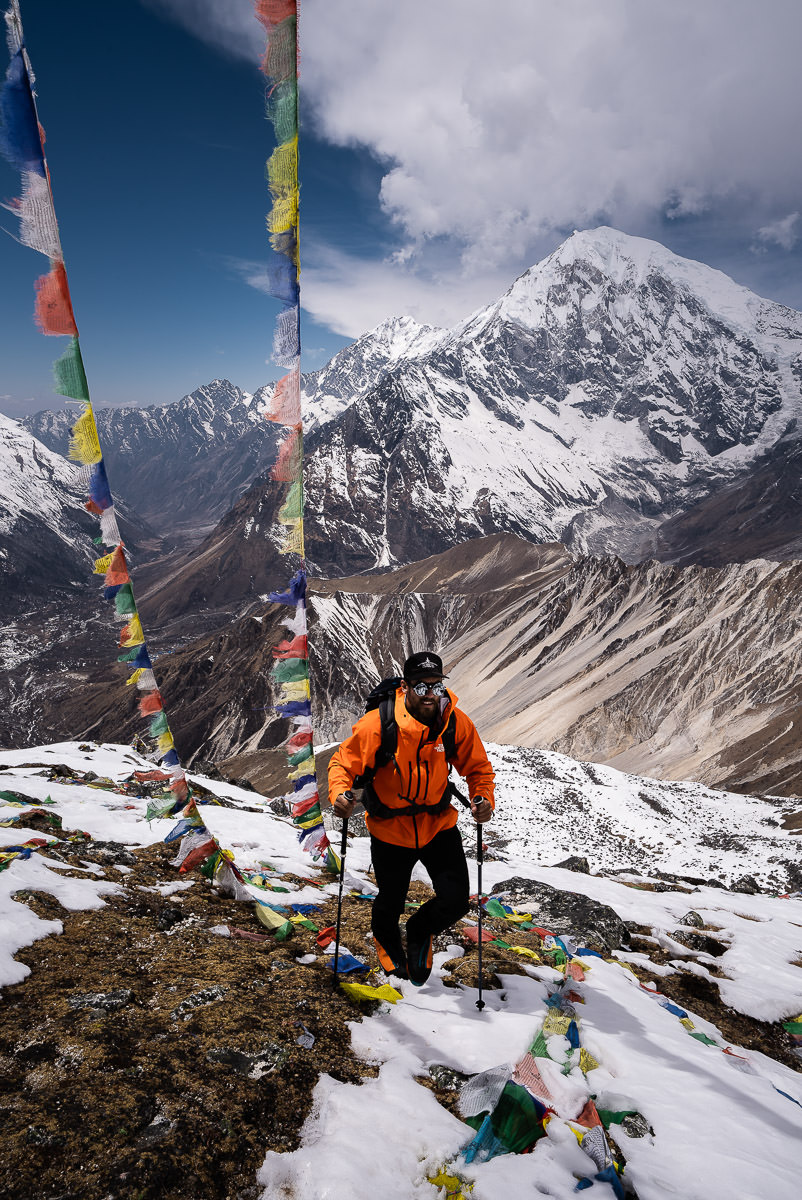
CLIMBING YALA PEAK
Yala Peak is a non-technical peak near Tserko Ri, which could be a great trekking peak for those on the hunt for a challenge.
We climbed Yala Peak with a guide over a two-day period. The climb included a trek to Yala Kharka (4750), which is the base camp. The summit push followed the next morning to Yala Peak (5,500m) through some heavy snow. With views into Tibet and specifically of Shishapangma, it was an incredible experience.
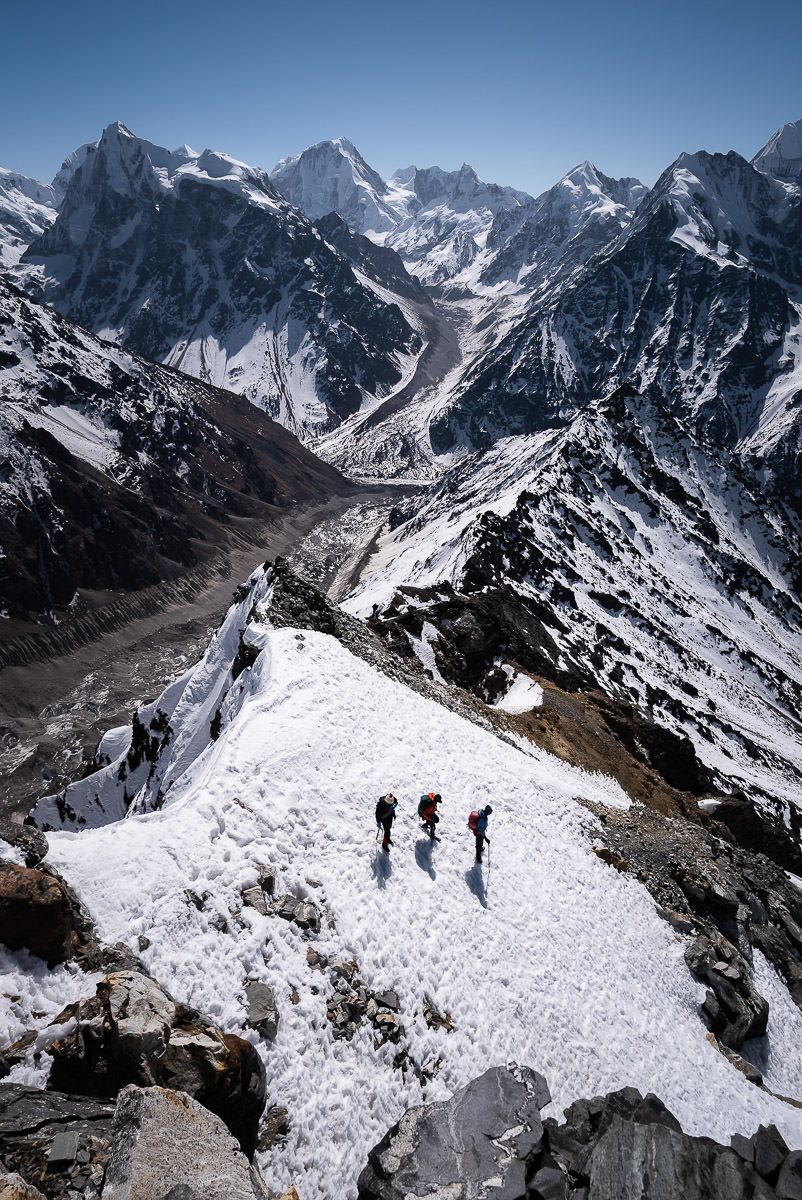
Yala Peak is not commonly part of the Langtang Valley Trek and involves prior preparation. We had to carry in our 6000m boots, extra warm gear, and climbing gear and arranged our climb in advance. While a guide can be arranged in Kyanjin Gompa, there is no gear rental shop so you may need to decide if Yala Peak is on your agenda before you begin the trek.
If you are interested in this expedition, I’ve written an entire guide about our Yala Peak Climb.
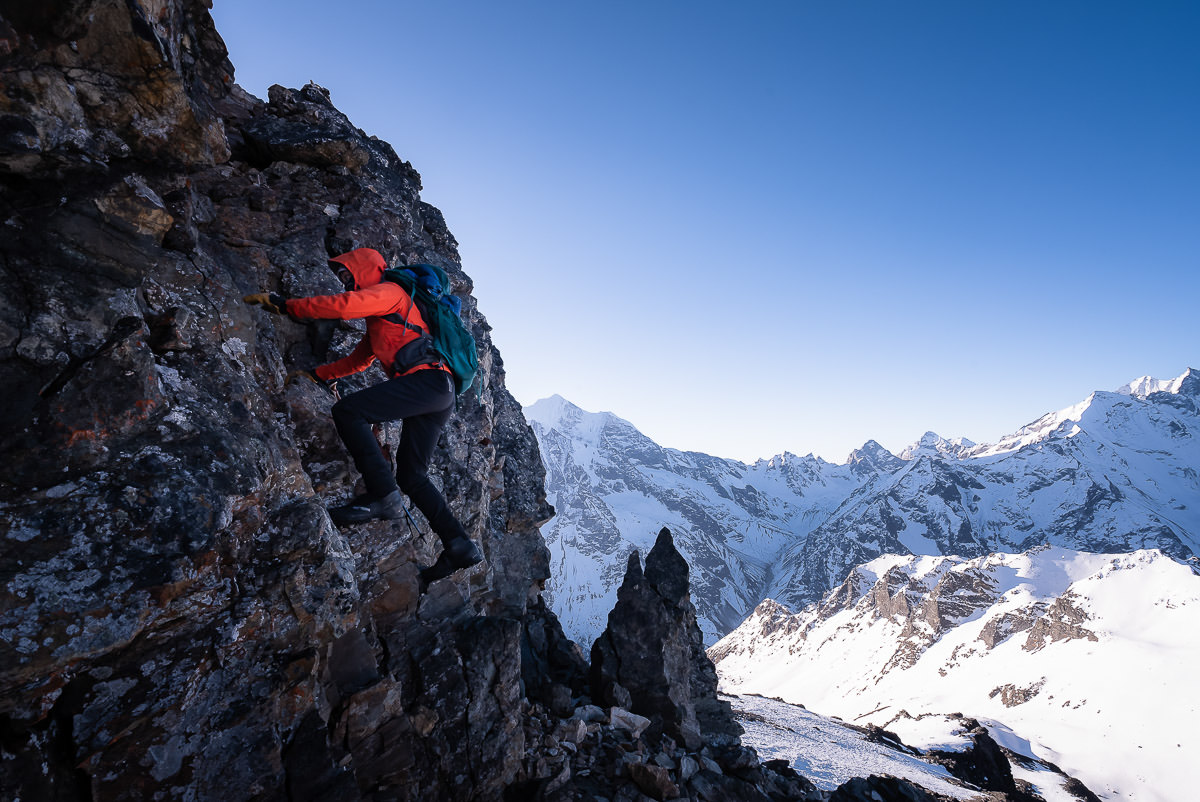
TREKKING FROM KYANJIN GOMPA TO SYABRUBESI
The trek back to Syabrubesi from Kyanjin Gompa takes most trekkers just two days. With only descent on the cards, it is much quicker than the trek upwards. On our first day of trekking, we made it all the way down to Lama Hotel with a 19km hike. On the second day, we had a 12km hike back to Syabrubesi.
It’s only 31km in total and there were some trekkers doing it all in one day. However, with more than 3000m of decline, I suggest taking at least two days for the descent as it can be quite tiring on the knees and ankles to endure so many steps and uneven surfaces.
After ten days out in the Langtang region, we wrapped up our trip with a celebratory beer at the Lhasa Hotel alongside a platter of Momo. It was one of our favorite treks and the expeditions from Kyanjin Gompa were wildly adventurous and incredible memories.
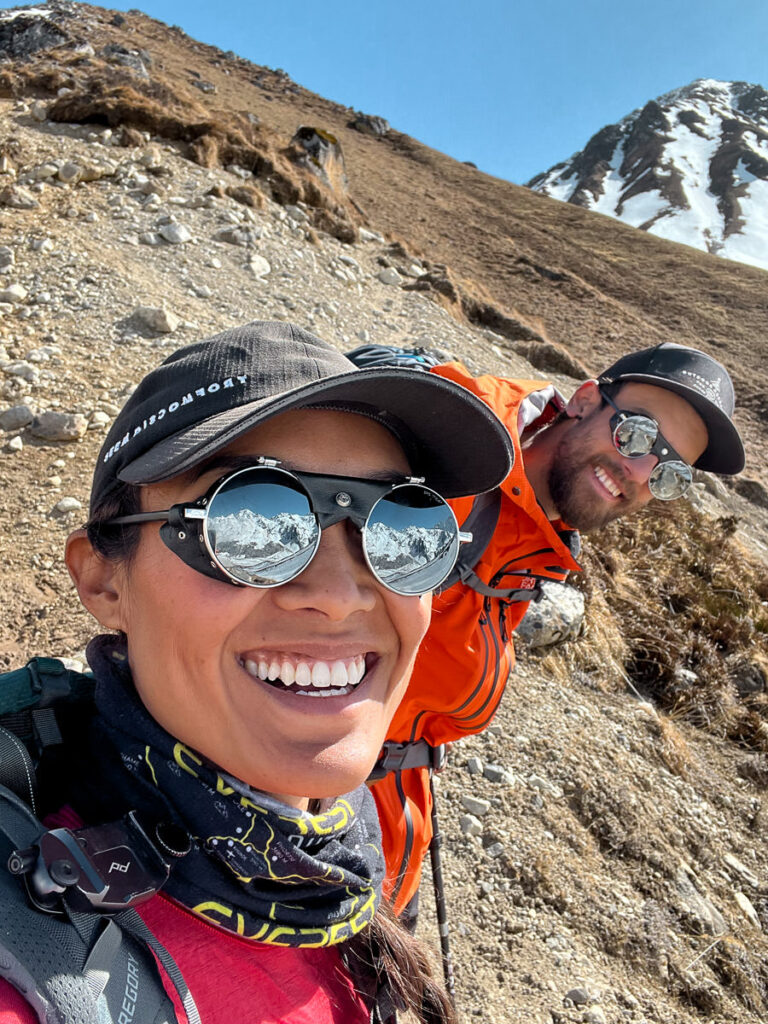
I hope you enjoyed this guide to the Langtang Valley Trek in Nepal and have a great experience yourself!
HAVE YOU READ MY OTHER NEPAL BLOGS?
I’ve been lucky enough to have many awesome adventures in Nepal, which you can check out below where I’ve listed some of my favorite blog poss from Nepal.
- The Most Iconic route: Everest Base Camp Trek
- The Most Scenic Route: Annapurna Circuit Trek
- My Favorite Trek in Nepal: Manaslu Circuit Trek
- An Easy Nepal Trek: Langtang Valley Trek
- A great beginner peak: Island Peak Climb (6,165m)
- My Favorite Climb in Nepal: Climbing Ama Dablam (6,812m)
- My first 8000er: Climbing Manaslu (8,163m)
- My toughest climb in Nepal: Climbing Makalu (8,463m)
- Where to stay: 16 Best Places to Stay in Kathmandu

Saturday 13th of May 2023
This blog has me already planning this in my head. I love hiking and being from Australia, I didn't get much of this sort of thing there, nor, here in Thailand, but I feel like I'd be mad not to get on board with this whilst I'm living in this part of the world.
Hey guy below "Jay" I was living in Brisbane, and there are plenty of good training spots for a hike like this in QLD. Maybe not the snow, but if you want to spend a night on one of the local peaks in the middle of Winter, it'll get you ready, both physically and mentally. If you want a challenge and want to test yourself locally first, try hiking through Mount Kosciuszko area, you can go through the back way on a multiday hike and it's both physically and mentally challenging, and it feels so remote, it takes very little time in those sorts of mountains to feel very alone and vulnerable. But totally worth it!!
Thanks for the article! Brilliant.
Tuesday 2nd of May 2023
Hello Jackson! What an incredible article with so many beautiful photos! I would have loved to have done the Langtang Valley trek with my mother when she was alive - she was the adventurous one, having climbed all of the Scottish Munros, summer and winter, including abseiling down the top of the InPin (I know, not a patch on Nepal!). Sadly, I lost her a couple of years ago, but even at 84 and dying of cancer, she still took us half way up Cairngorm! Maybe I'll manage it one day! Meantine, keep on trekking and stay safe!
Saturday 22nd of April 2023
Hi Jackson! Thank you for this very informative page. I'm hoping to hike this trek in November of this year. Absolute novice, barely done any hikes. I do keep fit with regular exercise though, and will train for this trek soon. I'm based in Queensland, Australia. I do have a fear of heights though, I was wondering what your thoughts were about the trek with this issue. Are there many suspension bridges and are they pretty high up? Would the trek otherwise be all right from that point of view? Thank you for your help. And I know it almost sounds ridiculous wanting to trek with a fear of heights but its something I've always wanted to do. Thank you for your time!

Alpha Adventure Treks
Your Perfect Trekking Partner

A Guide to the Langtang Valley Trek in Nepal

Last Updated on May 17, 2023 by Alpha Adventure Treks
The Langtang trek is one of Nepal’s shortest trekking trails. From the jungle with banana trees and monkeys at lower heights to glaciers and ice peaks at higher elevations, it offers spectacular beauty. Short does not imply simple; the path is difficult from the start, with several long and steep ascents, as is typical of Nepalese trekking.
The trek can be completed as a standalone adventure, in conjunction with the Tamang Heritage trek, or as an acclimatization trek before attempting one of the longer and more difficult routes like as Everest Base Camp or the Annapurna Circuit.
The Langtang Valley is one of the most well-known treks in Nepal’s central region. The alpine scenery around Langtang valley is very magnificent and spectacular.
Langtang trekking takes you through some of Tibet’s old monasteries, Tibetan Buddhist culture, and alpine meadows. Langtang’s valley floor and alpine slops bloom freely with poppy and other alpine flowers throughout the summer, creating a spectacular display of world flowers.
Langtang Lirung (7,246 m), Gang Chhenpo (6,388 m), Naya Kangri (5,846 m), and Dorje Lakpa(6,966 m) are some of the most important mountains in Langtang .
Check Langtang Valley Trekking Package
Table of Contents
Top 10 Reason To Choose Langtang Valley Trek
- Stunning views: The Langtang Valley trek offers breathtaking views of the Langtang Lirung glacier and the surrounding peaks, including Langtang Ri, Yala Peak, and the Dorje Lakpa massif.
- Cultural diversity: The Langtang Valley is home to a diverse mix of Tamang and Tibetan cultures, and the trek offers the opportunity to learn about and experience these cultures firsthand.
- Off the beaten path: While the Langtang Valley trek is not as crowded as some of the other popular trekking routes in Nepal, it is still well-maintained and offers a variety of accommodation options. This means that you can enjoy a more authentic and peaceful trekking experience.
- Wildlife spotting: The Langtang Valley is home to a variety of wildlife, including Himalayan black bears, red pandas, and even the occasional leopard. The trek offers excellent opportunities for wildlife spotting and birdwatching.
- V aried terrain: The Langtang Valley trek takes you through a variety of landscapes, including forests, meadows, and high-altitude passes. This diversity makes for an interesting and varied trekking experience.
- Adventure: The Langtang Valley trek offers plenty of opportunities for adventure, including the option to summit Tserko Ri, a peak that offers panoramic views of the Langtang region.
- Community-based tourism: Many of the accommodations along the Langtang Valley trek are run by local communities, which helps to support the local economy and promote sustainable tourism practices.
- Spiritual significance: The Langtang Valley is home to several Buddhist monasteries and holy sites, which adds a spiritual dimension to the trek.
- Natural hot springs: The Langtang Valley is home to several natural hot springs, which provide a welcome respite after a long day of trekking.
- Good for all levels: The Langtang Valley trek is suitable for trekkers of all levels, from beginners to experienced hikers. There are a variety of routes and options available, making it possible for everyone to find a trek that is suitable for their fitness and experience level.
Overview of the Langtang Trek
- Distance – 77 km/48 mi
- Total ascent – 3925 m/12 877 ft
- Total Days: 9-11 Days
- Highest point – 4600m/15 000 ft Kynajin Ri peak
- Accommodation – guest houses
- Permits – TIMS card and Park entrance permit required
- Cost per day – US$25-30 per person including permits and transportation
Outlined Itinerary for Langtang valley trek:
Day 1 : Arrival day Day 2 : Kathmandu valley (1,300 m) (sightseeing) Day 3 : Kathmandu (1,300 m) to SyabruBesi (1,550 m) Day 4 : SyabruBesi (1,550 m) to Lama Hotel (2,450 m) Day 5 : Lama Hotel (2,450 m) to Langtang village (3,430 m) Day 6 : Langtang village (3,430 m) to Kyanjin Gompa (3,870 m) Day 7 : Kyanjin Gompa (3,870 m) (Acclimatization day) Day 8 : Kyanjin Gompa (3,870 m) to Lama Hotel (2,450 m) Day 9 : Lama Hotel (2,450 m) to SyabruBesi (1,550 m) Day 10 : Drive back to Kathmandu (1,300 m)
Typically, 10 days are enough for concluding Langtang valley trek in accessible manner.
Here are a few reasons why you should consider a Langtang Trek for your next walking vacation:
- Langtang is a breathtakingly magnificent mountain range.
- Langtang treks are easily accessible.
- More than 70 glaciers and stunning lakes, including Goshainkunda (4,380 m), Parvatikunda, Bhairavkunda, and Dudhkunda, can be found in the Langtang valley.
- Survey Langtang National Park (the first Himalayan national park), which was established in 1976 and contains a diverse mix of flora and animals within a 1,710 km2 overall territory.
- Diverse cultures and landscapes
- Because it’s quiet, you’ll be able to learn (and give) much more than you would elsewhere.
“Even if you are unaware of Nepal’s recent history, the Langtang region is a unique corner of the world. By choosing to spend time in Langtang and with its people, you may obtain a better understanding of what life is like beneath Nepal’s vast snow mountains.”
Difficulty level and physical effort for Langtang valley trek
Langtang valley trek is categorized as moderate because it is just over 5,000 meters above sea level. If we can consistently walk for 5-6 hours, we can build up a trek for using a light bag load. For those who are accustomed to walking at higher heights, the climb is much easier.
Furthermore, the Glacier region necessitates a bit more activity in terms of running and exercising on a regular basis before beginning the trek in a couple of months. Aside from that, workouts focusing on the heart, muscles, and lungs would be good in preparing for the Langtang valley trek.
Langtang Valley Trek Facilities and Accommodation:
When compared to other Nepalese treks, the Langtang Valley trek is well-equipped. Imagine savoring a cup of world-class Italian coffee while admiring the magnificent scenery of Langtang Lirung.
Isn’t that fantastic? There are numerous recently constructed hotels and guesthouses that offer superb lodging and dining.
You won’t need to bring any food with you on your hike. There are various alternatives here, ranging from local cuisine to international cuisine.
The hotels provide amenities such as free WiFi and hot showers. Hotels and teahouses can be found at regular intervals throughout the walk. In general, the cuisine and lodging amenities are outstanding.
Best Time to do Langtang Trek:
Spring (March, April, and May) and fall (September, October and November) are the optimum seasons for a Langtang valley trek. The greatest time to see the spectacular mountains and glaciers is in the autumn. Spring also brings us snow-capped mountains and green woodlands brimming with crimson rhododendrons.
Aside from this, the Monsoon has its own significance. Trails are infested with leeches due to the rainy season. Waterfalls, rivers, foliage, and flora and fauna, on the other hand, shine brightest during this season. As a result, nature lovers and photographers enjoy this season.
For the Langtang Valley Trek, you’ll need the following information:
- Passport, separate photocopies of passport, proof of insurance, two additional page size photos, flight tickets, card money, ready money for obtaining Nepalese visa at airport, and photocopies of identity card (for withdrawing cash from bank/ATM).
- Head scarf, warm hat/cap, alternative head lamp, sunglasses, half and long sleeve upper wears, wind cheater jackets, waterproof jackets, light and warm thermal tops and pair of normal, woolen or fleece gloves, trekking shorts, trekking trousers, woolen trousers, waterproof pants, light weighted thermal bottoms, normal and woolen socks, and trekking shoes
- Sleeping bag, large travel bag, small personal carry bag, camera with additional batteries, binoculars, little folding knife, anti-bacterial hand wash, guide books, pocket travel games, power bank are all useful goods.
- Medical and toiletries: First-aid kit (containing bandages, anti-loose motion pills, anti-headache pills, cold and cough medicine, anti-altitude sickness pills, water purification tablets, and stomach antibiotic) and toiletry information, if desired.
Trekking Equipment List:
Body clothing:.
- Sleeping Bag
- Down Jacket
- Three pairs of trekking t-shirts
- Long sleeved shirts
- Thermal Shirt for Colder place
- Fleece Jacket
- Warm wool Sweaters
- Waterproof and windproof Jacket
- Cotton Trekking pants with folding
- Waterproof and windproof pants
Head and Face:
- Wool or fleece hat
- Sunscreen 50
- Face wipes and towel
List of Foot wears :
- Trekking Boats
- ¾ Paris Preferably Cotton Socks
- One pairs extra Sport Shoes
Necessary Gears:
- Gaiters just in case if snow
- Gloves and Thick Gloves
- Big rucksack above the 40 L
- Waterproof Bag Cover
- Trekking Pole (if you needed)
- Laundry Soap
- Toilet papers
- Water peals
- Bottle for drinking water
- Pen and Note Book
- Copy and Tourist Guide Book
- Battery charger
- Memory card
- Cell Phone and Charger
- Money Wallet
- Altimeters and Playing card
First aid Kid:
- Cotton bandages
- Paracetamol
- Painkillers
- Loperamide to Control diarrhea (just in Case).
- Water purified tablets
- Elastic bandages
- Thermometer
- Moleskin and sling.
Activities To Do in Langtang National Park:
Visitors can participate in a range of activities in the park with the help of guides and tour operators.
Visitors can go hiking, climbing, bird watching, or go on a nature walk, village walks, visit hot springs after the trip for a hot bath, and many more activities, depending on their level of adventure and interest.
Langtang Treks FAQs:
Langtang trek difficulty is rated as ‘Strenuous’, which falls midway between moderate and challenging. To reach Kyanjin Gompa, you’ll need to trek for about 5-6 hours each day, which is doable for novices. To go above Kyanjin, though, you’ll have to hike 6-7 hours’ round trip at a high height, eventually arriving at the legendary Tserko Ri (5000 m).
It takes 4 hours to drive from Kathmandu to Langtang National Park (202Km). Early morning buses go from Machhapokhari, New Bus Park in Kathmandu to Syabrubesi in Langtang National Park, commencing at 7-9 a.m.
Yes, Langtang Valley is open all over years for trekking and Hiking to Local as well as Foreign tourists.
Yes, langtang is absolutely safe to trek and enjoy the beautiful landscape and wildlife.
The region is known for its gorgeous cedar trees and flowers, as well as breathtaking vistas of soaring Himalayan peaks such as the gigantic Shishapangma, one of the 8000-meter summits, Manaslu Massif, Ganesh, Langtang, and Jugal Himal.
Langtang trek is considered to be one of the easiest trek which is about 10-12 days’ trek from Kathmandu.
The Langtang Valley begins just north of Kathmandu, on the Tibetan border. Langtang Lirung (7246m), the highest peak in the vicinity, dominates the valley.
Yes, you can exchange your currency in Nepal with the help of your local tour guide agency.
Yes, you will have internet connection in most of the tea houses, you might have to pay minimal fee to use it but don’t be expecting the fast browsing.
Langtang valley trek is possible and safe for solo/individual hikers because it is a short and moderate trek. The track is not difficult to follow, and there are numerous signposts along the way.
No, ATMs and banks are not available on the Langtang Valley trip; therefore, you must bring Nepali cash from Kathmandu.
The cost for langtang trek ranges anywhere between $750- $999 depending on the way you travel and accommodation you stay in. The package includes your stay, dining and other necessary expenses.
Guide to Langtan isn’t Mandatory however trekking to any routes in the place you are not familiar with is no less risky so we recommend hiring a professional guide for better travel experience.
Langtang Treks takes about 9 to 12 days from Kathmandu. We recommend you take at least a day or two in leisure just in case of bad weather or any unforeseen situations.
Langtang Village is located at 3400 Meters above sea level from the North of Kathmandu and takes about 8 days to reach there.
The Langtang Base Camp Trek is a popular trekking route in Nepal that takes you through the beautiful Langtang Valley and up to the base camp of Langtang Lirung, a 7,227m peak in the Langtang region.
The Langtang Base Camp Trek typically takes about 10-12 days to complete, depending on the itinerary and pace of the trekker.
The Langtang Base Camp Trek is considered to be a moderate trek, suitable for people with some prior trekking experience. The trek involves walking through rugged terrain, steep climbs, and high altitudes, so it is important to be in good physical condition.
The best time to do the Langtang Base Camp Trek is during the spring (March to May) and autumn (September to November) seasons. During these months, the weather is generally clear and dry, with good visibility and pleasant temperatures.
The maximum altitude reached on the Langtang Base Camp Trek is around 4,984m at the Kyanjin Ri viewpoint.
Yes, you need a trekking permit to do the Langtang Base Camp Trek. You can obtain a permit from the Nepal Tourism Board or through a licensed trekking agency.
There are several teahouses and lodges along the Langtang Base Camp Trek route that offer basic accommodation and meals. You can also choose to camp if you prefer
You will need to bring suitable trekking gear, including good quality hiking boots, warm clothing, a sleeping bag, a backpack, and other essentials. It is recommended to bring a first aid kit, trekking poles, and a headlamp as well. A comprehensive packing list can be obtained from your trekking agency.
The Langtang Base Camp Trek is generally considered to be safe, but it is important to take appropriate precautions and follow the guidance of your trekking agency and guides. Altitude sickness is a risk at higher elevations, so it is important to acclimatize properly and be aware of the symptoms.
The maximum altitude reached on the Langtang Valley Trek is around 4,984m at the Kyanjin Ri viewpoint.
The cost of the Langtang Valley Trek varies depending on several factors such as the trekking agency you choose, the duration of the trek, the type of accommodation and meals you prefer, and other additional expenses such as permits, transportation, and equipment rentals. Generally, the cost can range from $500 to $1500 USD.
The highlights of the Langtang Valley Trek include the stunning mountain views, the beautiful Langtang Valley, the Kyanjin Gompa monastery, the diverse flora and fauna of the Langtang National Park, and the opportunity to experience the local Tamang culture and lifestyle.
The Langtang Valley Trek covers a distance of approximately 50-60 kilometers, depending on the specific route and itinerary chosen by the trekker.
Feel Free To Contact Us:
Share this:.
- Click to share on Twitter (Opens in new window)
- Click to share on Facebook (Opens in new window)
- Click to share on WhatsApp (Opens in new window)
Related Post
Author: Alpha Adventure Treks
You might want to explore the highest and coolest Himalayas of Nepal, explore Nepali cultures, and visit many beautiful places of Nepal. We are here to make your travel dream come true. There are so many thing you can do in Nepal. You can enroll in trekking, mountaineering, hiking, rafting, and jungle safari. We create best itinerary for our customers according to their travel plans. Our agents are very cooperative and they will contact you beforehand so that you can tell what to include in your travel itinerary. We have highly experienced and very professional team in our Company. They make sure about your safety and other travel things. With us, it will be easy for you to travel to your favorite destination. View all posts by Alpha Adventure Treks
- Travel Guides Plan your adventure
- Destinations Our favourite places
- Tours Book a trip
- Travel Companies Independent specialists
- Travel Guides
- Destinations
- Travel Companies
- Langtang Valley treks
The most accessible trekking in Nepal
- In this guide
- Remote treks
- Challenging treks
- Everest treks
- Annapurna treks
- Upper Mustang treks
Manaslu treks
- Dolpo treks
- Far Western Nepal treks
- Makalu treks
- Kanchenjunga treks
- What to eat in Nepal
- Best Langtang treks
Langtang Valley Trek
Tamang heritage trail, ganesh himal, langtang trekking highlights, langtang region trekking information.
Often visible from Kathmandu city centre, the Langtang Valley treks are some of the most accessible trekking in Nepal .
If the city pollution and traffic wasn’t so off-putting, you could start walking from your guesthouse straight to the mountains.
This accessibility, easy-to-follow trails and lots of lodges has meant the Langtang Valley has always been, alongside Everest and Annapurna, one of the big three independent trekking areas.
The 2015 earthquake caused massive damage and loss of life in and around the Langtang Valley. The beautiful stone wall village of Langtang was buried under a huge avalanche. Today, all the trekking areas have re-opened and once again there are lodges along the routes. But the reminders of the disaster are still there. Where there were yak pastures, pine forests and the village itself, there is now a grey wasteland of rubble stretching for at least two kilometres. Slowly though, even this is fading from sight as vegetation starts to cover the rockfall.
But don’t be put off. This is a beautiful area to trek with high Alpine pastures, rewarding side trips, holy lakes, stunning mountain views, cultural interactions, relatively few other trekkers, and easy and cheap access with no internal flights needed.
Here's my expert guide to trekking in the Langtang Valley.
Featured Langtang Treks
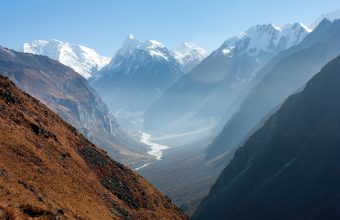
Langtang Helambu Trek
Incredible trek in langtang valley.
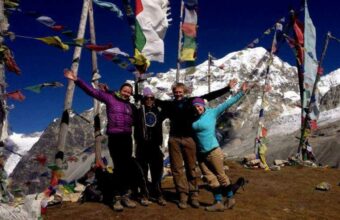
Trekking in Langtang National Park

Ruby Valley Trek
Hidden trails and cultural tales.
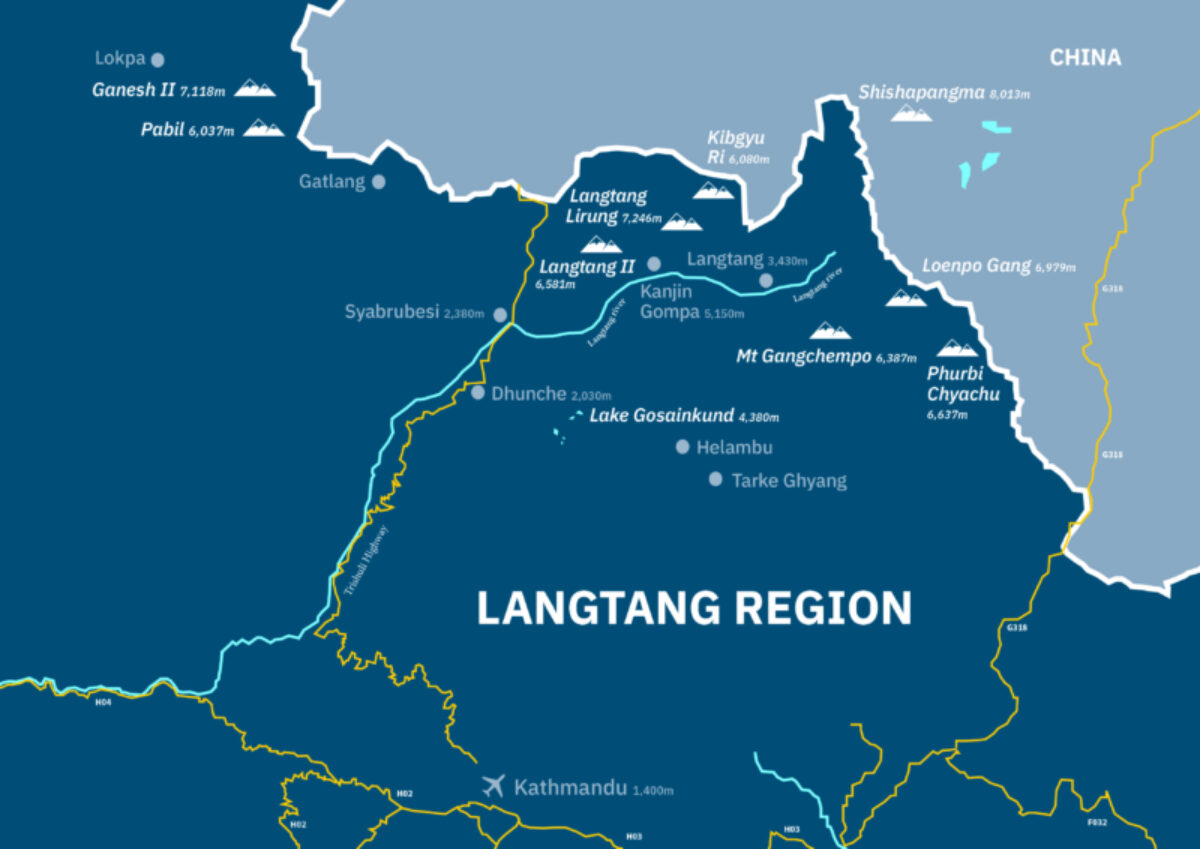
The Langtang Trekking region
The best Langtang Valley treks
Top trekking routes in the langtang region.
The Langtang Valley is a good choice for those with limited time, with the shortest routes taking just a week (or even slightly less) including travel time from Kathmandu. There are also many ways of combining treks to create routes lasting several weeks.
Here's my rundown on the best treks in the Langtang Valley area.

Glorious views of the Langtang Valley
Difficulty: Moderate. The trail climbs quite rapidly so there is a risk of altitude sickness.
Trek Duration: 6 days from Syabrubesi but allow another 2-3 days for side trips from Kanjin Gompa.
Max. Elevation: 3,860m
Accommodation: Trekking lodges. Camping required for any overnight trips beyond Kanjin Gompa.
Start/End Point: Syabrubesi
Before the earthquake, this was one of Nepal’s most popular trekking routes. The trails have been repaired or re-routed and trekking lodges reconstructed. And despite the obvious damage this is still one of the most delightful walks in Nepal. The basic trek takes eight days including travel time from Kathmandu, but add in another couple of days for side trips from Kanjin Gompa.
The standard route follows the Langtang river up a steep and narrow valley. On day two the trail passes over the rubble fields under which Langtang village is buried and on day three the valley opens out to arrive at Kanjin Gompa and big views of Langtang Lirung (7,246m), Langtang II (6,581m) and, perhaps the most distinctive mountain in the valley, the pyramid shaped Mt Gangchempo (6,387m). Kanjin Gompa can be a base for many different day and overnight side trips.
Most people go back the way they came but with more time it’s possible to link up with the Gosainkund and Helambu treks.
Trek Duration: Minimum 8 days depending on route options.
Max. Elevation: 4,610m
Accommodation: Fairly simple trekking lodges.
Start/End Point: Syabrubesi/Dhunche or Sundarijal
The most popular add-on to a Langtang Valley trek, and a fantastic short trek in its own right, is this haul up through pine forests where red pandas live to the Hindu holy lakes of Gosainkund. Although you don’t come face-to-face with the high mountains, you do get grandstand views of the Langtang and Ganesh ranges, as well as crossing the often snowbound and challenging Laurebina La (4,610m).
There are a number of different approach routes to Gosainkund, but to acclimatise it’s best to do the Langtang Valley trek first. Then, from close to the teahouses of Doman, cut across to Gosainkund and descend back to Kathmandu via the Helambu Circuit. Some people go directly to Gosainkund from Dhunche but the elevation gain is great and altitude sickness is common. Starting from Helambu and walking to Gosainkund is a long uphill drag that also invites altitude problems.
Helambu trek
Difficulty: Easy/Moderate.
Trek Duration: 7 days but increasing road accesses means you can cut the trek short at a number of points and bus back to Kathmandu.
Max. Elevation: 3,640m
The closest trek to Kathmandu — it starts from the northern outskirts of the city — takes you on a fairly gentle amble through terraced fields, wild forests, flower meadows and through lots of little villages with views of the mountains. The highest point reached on this trek is 3,640m, so it can be done as a mid-winter trek when higher routes might be snowed in. You can make an enjoyable week-long circuit (a good option for those with little time and/or trekking experience), but most people choose to use Helambu either as a walk in or out route to Gosainkund and the Langtang Valley.
However, be aware that doing this will involve crossing into Helambu via high-altitude passes at either Laurebina La (4,610m) or the very challenging, sometimes dangerous and often snowbound, Ganja La (5,106m). Trekking on these routes involve steep climbs and big changes in altitude, posing a real risk of AMS.
Difficulty: Easy to moderate.
Trek Duration: 5 to 6 days.
Max. Elevation : 3,300m
Accommodation: Homestays.
This route aims to highlight the culture of the Tamang people as much as the mountain scenery. It’s a real community project with money generated from trekkers going into local development projects and trekkers being hosted at night by families in their village houses.
The trail starts from Syabrubesi and is a five to six-day loop close to the border of Tibet. Highlights are the pretty Tamang village of Gatlang, the hot springs at Tatopani, and the fine mountain views over the Ganesh and Langtang range from Nagthali Ghyang. The highest point is 3,300m, so this is a good mid-winter trek when higher routes might be snowed in and it also suits those with limited time.
The Tamang Heritage Trail is very easily combined with the classic Langtang Valley trek. For those with more time, it’s possible to add in Gosainkund and the Helambu treks to make for three weeks of hiking.
Difficulty: Very strenuous and dangerous. People have died attempting this crossing.
Trek Duration: 4 days from Kyanjin Gompa.
Max. Elevation : 5,106m
Accommodation: Camping only.
Start/End Point: Kyanjin Gompa/Tarke Ghyang
The most challenging and dangerous trek in the Langtang region is the crossing of the high (5,106m) Ganj La pass, which links Kyanjin Gompa at the head of the Langtang Valley with Tarke Ghyang on the Helambu Circuit. This should only be attempted by very experienced trekkers with a good support team. You will need camping equipment, a guide who knows the route well, ropes, ice-axes and crampons.
There are no facilities along the route. Note that the pass is, at best, only open between October and November and March to May, but even during these months it’s often snowbound and impassable. Make sure you have a back-up plan in case the pass is closed. Avalanches are a very serious risk on the approach to and from the pass.
Difficulty: Moderate.
Trek Duration: 2 weeks
Max. Elevation: 3,842m
Start/End Point: Syabrubesi/Tripura Sundari
Named after Ganesh, the elephant-headed Hindu god of fortune, Ganesh Himal lies directly between the Manaslu and Langtang ranges, and is one of the great unknowns of Nepalese trekking. With stunning mountain scenery, attractive and welcoming villages, hot springs, waterfalls and a genuine sense of being well off the beaten track, the Ganesh region really has a bit of everything — except crowds of other trekkers.
A handful of homestays and trekking lodges have started to open up, but for now the trails are still largely empty. Because formal accommodation is still so scarce, an organised camping trip is the best way to tackle this trek.
There are a couple of different trekking routes in the Ganesh region which you can access from Manaslu and the Tsum Valley in the west, but the standard trail starts from Syabrubesi and follows the Tamang Heritage Trail to the gorgeous village of Gatlang before crossing the Pansang La pass (3,842m).

The Langtang area has it all. Start walking from Kathmandu and before you know it, find yourself in a tranquil mountain village, breezing through flower meadows, picnicking in the shade of pine trees, crossing rushing rivers, and a snowbound pass, and standing atop a minor Himalayan peak.
Kanjin Gompa day trips
The small village of Kanjin Gompa (3,860m) at the head of the Langtang Valley, might be the official end point of the Langtang Valley trek but in truth this is where the fun really starts. Numerous day and overnight trips fan out from the village. You can make the almost obligatory hike up to the Kyanjin Ri viewpoint (4,600m) for sensational views, or have a rollicking day’s adventure to the glaciers and yak pastures of the Lirung Valley. A bigger challenge is the long and exhausting day trip to the Tsergo Ri viewpoint at 4,984m, or, for the adventurous, an overnight camping trip to the summit of Yala Peak, which at 5,500m often requires ropes, crampons and an experienced guide.
Gosainkund Lake
The holy lake of Gosainkund (4,400m) has a black rock sticking out of it that Hindus believe is the head of Shiva, and the lake attracts scores of Hindu pilgrims particularly over the August full moon. Like any good pilgrimage, the trek to Gosainkund is a challenging one involving a high pass crossing and memorable scenery. Once at the lake there are a number of side trips to other lakes and high viewpoints.
Helambu and the Tamang Heritage Trail offer a delightful combination of mountain views and pretty villages. The latter offers a real insight into local life thanks to an exciting tourism-based community initiative in which trekkers can stay as guests in village houses, and traditional dances and events are laid on. Both these treks are (for the Himalayas) fairly low level with little risk of altitude-related problems.
Ease of access
The Langtang area offers the most accessible trekking in Nepal. Take a taxi across Kathmandu to the Shivapuri National Park and start walking the Helambu Circuit within an hour of leaving your guesthouse. If you’re heading straight to the Langtang Valley, Ganesh Himal or Tamang Heritage Trail, a day’s bus ride from the city will get you to the trailheads.
Exploration
Don’t think that because the Langtang region is so popular there’s no adventure left. Grab some tents and a guide in Kanjin Gompa (or bring them from Kathmandu) and walk for a day or so further up the Langtang Valley to Langshisha Kharka and towards the Langtang glacier, and you’ll feel as if you have the Himalayas all to yourself. The nearby Ganesh Himal is perhaps the most overlooked range in the Nepalese Himalayas. You could trek here for days without meeting another foreigner.
Apart from the TIMS card, no special permits are required for the treks in this area. The Langtang, Gosainkund, Ganj La and Helambu treks all enter the Langtang National Park for which there is a Rs 3000 entry charge. The Helambu trek also enters the Shivapuri National Park for which there is a Rs 500 entry fee.
The best time to trek the Langtang trails is from October to April. It can get very cold in December and January but lodges remain open and the trails are quiet. In April, flowering rhododendron add a palette of red and orange to the slopes. Few people trek here in the monsoon but during the Janai Purnima festival during the August full moon, thousands of Hindu pilgrims (including lots of sadhus and other holy people) make their way to the holy Gosainkund lakes to bathe. This makes for an interesting experience for those who aren’t bothered by the lack of mountain views.
The region suffered very badly in the earthquake but all the trekking trails have been repaired and trekking lodges rebuilt. Camping gear is only required if you’re exploring the Ganesh Himal, attempting the Ganj La pass, or heading further up the Langtang valley from Kyanjin Gompa. However, for safety and enjoyment reasons, a guide is a good idea on all these treks.
Access to this area from Kathmandu couldn’t be easier. Simply hop on a bus in central Kathmandu and by the end of the day you’ll be in Syabrubesi or one of several other trailheads. There is no scheduled air access to the area.
Featured tours

Featured tours View all
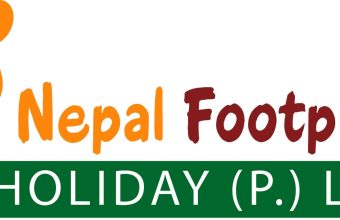
Why Horizon Guides?

Impartial travel guides
Our guides are written by the leading experts in their destinations. We never take payment for positive coverage so you can count on us for impartial travel advice.

Expert itineraries
Suggested itineraries and routes to help you scratch beneath the surface, avoid the tourist traps, and plan an authentic, responsible and enjoyable journey.

Specialist advice
Get friendly, expert travel advice and custom itineraries from some of the world's best tour operators, with no spam, pressure or commitment to book.
Our guides are 100% impartial and are written by independent, professional travel journalists. We make money by charging carefully-screened travel companies to list their business on our website. Our advertisers have no influence on our editorial content and we never accept payment for positive coverage.
Read more about how we work and what we believe in here .
- Travel guides
- Work with us
Sitemap , Privacy Copyright © 2024 Horizon Guides
Everything You Need To Know About The Langtang Valley Trek

Most of you have probably never heard of the Langtang Valley or Langtang National Park, right? Or heard anything about this unknown but beautiful trekking circuit in Nepal, only a relative short drive from the chaos of Kathmandu. If you have ever been lucky enough to be walking around the streets of the capital on an exceptionally clear day, the mountains you will be seeing are those of the Langtang National Park.
So what to expect on the Langtang Valley trek? Stunning and often blooming rhododendron forests, Tibetan villages with some of the friendliest people on earth, exceptional hiking and often challenging sections along the Langtang Khola (river), valleys of waterfalls to 360-degree views of snowcapped peaks including that of Langtang Lirung, a 7,200 metre mountain.

Trekking in Langtang Valley is mindblowing! In this Langtang Valley Trek blog I will tell you all the things you need to know: places to see, difficulty, where to stop/sleep, trek cost, itinerary and more tips for an incredible experience.

The Langtang Valley trek has everything that the Everest Basecamp trek and Annapurna Basecamp trek have and the best thing about this Langtang trek is that you’ll pretty much have the whole valley to yourself… apart from a yak or two!
So if you want to get off the beaten path in Nepal travel to Langtang Valley!

Best time to do the Langtang Valley Trek
October and November are the ideal months to put on your hiking boots with little rain, good amounts of sunshine and warmth at lower altitudes. On higher grounds it already starts to get colder so prepared yourself well for the Langtang trekking.

Spring is also perfection from late March to May as Rhododendron’s bloom and wildflowers pop up all over the valley. This time of the year makes the Langtang stand out from other trekking circuits in Nepal.
In summer don’t be put off by the warmer weather below Lama Hotel because the higher you go, the colder it will get especially once you pass Langtang Village (from day 3 onwards). Chances of rain are significantly higher these months.
I did the Langtang Valley trek in the first week of June and temperatures were perfect for trekking. There was a slight chance of rain from day to day, but only one day it actually rained for about 2 hours. We found shelter in a tea house and order a pot of tea. Also magical! Unfortunately our days were mostly clouded, nevertheless it was an absolutely amazing lifetime experience.

Langtang trek difficulty
In general I found the Langtang trekking a bit more challenging than the Annapurna Basecamp trek, especially the first two days were long and tough to get through. From day 3 onwards it flattens out a little more and the trek becomes easier. In terms of altitude the Langtang Valley trek is pretty easy as the last village of the valley, Kyanjin Gompa, lies at only 3,800 / 12,500 foot.

These donkeys are only for transportation of goods. They look sweet and innocent, but one tried to kick me so be careful! You don't want to get injured while trekking in Langtang Valley.
If you scroll down on this blog you will find the Langtang trek itinerary in where I describe every day including the difficulty per day.
Personally, I would not worry about the Langtang Valley Trek difficulty too much. The first two days of any trekking are always hard. Every though start requires a little determination, but once you get through that and you start seeing the beauty of the surrounding mountain peaks then you will only be smiling.

Do you need a porter/guide?
When trekking the Annapurna Basecamp in 2013 I did not have a guide nor a porter. In all honesty I don’t think you need one for the Langtang Trek either, but…
My Langtang valley trek was with a group of 10 people and we had 1 amazing guide and 5 porters. Although you don’t need someone to guide you (there is only one way up) our guide was such an amazing addition to our team it was lovely to have him around. The same counted for the porters!

By hiring a team of porters and a guide you are contributing to local communities by offering these people a job. On top of that Nepali people are some of the friendliest in the world and having their smiling faces around you will surely cheer you up in times that the Langtang trekking is difficult. Also you don’t have to worry about guesthouses, meals, trip planning, etc. They fix it for you!

I hardly brought anything and only had my standard blue little backpack that I am now traveling around the world with for the last couple years. Which one? Click here to check out my Pacsafe .
What to pack for the Langtang Valley trek
For a comprehensive Nepal packing list be sure to visit my article in the link. There you will find everything you need to bring on the Langtang trek. Below in my list of Langtang Valley tips you can already find a couple essential things to bring.

9 Langtang Valley tips
1. where to sleep in langtang valley.
The trekking is a so-called tea house trekking. Basically you hike from mountain village to mountain village. Some villages consist of 50 houses, some of only 5. But no worries there are plenty guesthouses everywhere scattered along the trek. Accommodation is very basic but warm and cosy. Staying at the local guesthouses are one of the best things about trekking in Nepal in general.

Bring toilet paper! Western toilets are a rarity on the Langtang Valley trek. Some newer guesthouses in the bigger villages (Langtang Village and Kyanjin Gompa) have western toilets, but for the rest it will be squat toilets. My best tip is to start practicing! :)
First off have no expectations! If you prepare for the worst than all will be fine. Yes there are showers along the Langtang Valley Trek, but hot water is NOT guaranteed or chargeable. Don’t expect a hair dryer or any luxury item! So time your showers right…
On my 7-day trek in Langtang I had 3 hot showers. At the start and end of the Langtang trek in Shyaphru Besi and when we stayed at Langtang Village.
Make sure to carry enough cash on you to last the entirety of the trip from Kathmandu to Kyanjin Gompa and back as there are no ATM’s along the way. I will talk about the Langtang trek cost later, but better bring too much cash than a little too less. In the end of the day you are supporting local villages in the Langtang Valley and it feels good to spend money on these amazingly lovely people.
5. Phone signal
One of my favorite things about trekking in Nepal is that I can completely switch off. My first big trekking adventure was at Annapurna Basecamp in 2013 when I hiked through the mountains for 15 days. So when I went on the Langtang trekking I was really looking forward to not being online.
Things have changed and even going off the beaten path in Nepal there is a phone signal on the Langtang trek. In my article about the best sim card for Nepal I already explained that in case you are planning to go trekking in Langtang Valley you have to buy a Nepal Telecom sim card as that is the only signal available. There is only a signal in Langtang Village and Kyanjin Gompa, funny enough the two highest located villages at the end of the valley.
Ncell Nepal has no signal! I had an Ncell sim card and therefore still disconnected and I can tell you it feels amazing! :)

6. Wifi available
Nowadays there is even WiFi! So in case you really want to be connected to the internet you can buy internet access for a couple dollars. It costs about $10 for 1GB and you can use it in several guesthouse around Langtang Village and Kyanjin Gompa. Don’t expect high speed internet but I saw some other people using Instagram and Facebook with the Wifi.
7. Bring powerbanks
Most guesthouses will let you charge your electronic devices for free, others ask less than a dollar. But electricity plugs are limited so it is better to bring a couple strong powerbanks with you.
8. Tipping guides/porters
It is normal to tip your guides and porters. I am not 100% sure anymore but I think we tipped $30 per person with 10 people and dived the tip over the guide and the porters. The smile on their faces was priceless.

9. Langtang Trekking permit
Trekking in the Langtang Valley requires a TIMS card or a ‘Trekkers Information Management System’. These cards cost around 5,000 Nepalese Rupees ($44) and can be purchased enroute to the trailhead of the Langtang Valley or at the Nepal Tourism Board in Kathmandu.
A TIMS is a requirement for every major trekking in Nepal. Along with a TIMS, you are going to need to pay an entry fee for Langtang National Park. The Langtang National Park Entry Permit costs 3,000 Nepalese Rupees ($26).
Make sure you carry extra passport photos and a copy of your passport before purchasing a TIMS or National Park Permit as this will help the officers collect information for your TIMS.

Best Langtang trek itinerary
The most common Langtang trek itinerary is 7 days. Including the drive from and back to Kathmandu this Langtang Valley trek itinerary is 9 days.

Day 1: Drive from Kathmandu to Shyaphru Besi
- Distance: 120 kilometers (75 miles).
- Time: 9-11 hours depending on traffic and road conditions.
Getting to the trailhead of any trekking in Nepal is an adventure in itself meaning that nearly all adventures are bound to start in Kathmandu and may take up to half a day or more merely to get to the starting point of your trek.
Day 1 is more of a travel day, a really long one so make sure you are packed and ready to hit the road as early as possible to avoid the chaotic traffic of Kathmandu. Ideally, 05.00 or 06.00 in the morning is the perfect time to leave the city to avoid most of the crazy traffic.
Shyaphru Besi is located some 5 hours from the main road connecting Kathmandu and Pokhara and if you get out of the city before the traffic crawls to a stop, the whole trip either by bus or jeep should not take more than 9 hours.
Bus and jeep days can be long so make sure you charge up your phone or bring a book along to help pass the time. But prepare yourself for an at times horrible trip. Sorry I can’t make it sound better. The roads are really those of your worst nightmares! LOL
Oh and it is dusty! Like really dusty… :) A Langtang trekking tip I would like to tell everyone is to fix a vehicle with AC, like closed windows kind of bus/jeep! The dust is killing, or buy a mouthpiece!

Once at the trailhead, Shyaphru Besi is the last main town you will pass for the next week so be sure to have all the things to bring for the Langtang trek. Another good tip is to stock up on trail-snacks at Shyaphru Besi as the higher you climb into the Langtang Valley, the more expensive things become.
Day 2: From Shyaphru Besi to Lama Hotel
- Difficulty: Hard (long and tiring)
- Time: up to 8 hours
- Altitude: From 1,460 to 2,470 meter, total of 1,010 meters (3,310 ft) ascent.

Hiking out of Shyaphru Besi is a good feeling and knowing that you have officially put on the hiking boots and headed for the Himalaya is an even better feeling. The Langtang Valley trek has started! The first few kilometers of the trek involve swing bridges decorated with colourful flags and a first glimpse of the Langtang Khola which is a mighty river originating from the Langtang Glacier.

The first hour of the trek is quite flat following parts of an unfinished road and a rather mild mule track but that all changes once you arrive in the town of Pahare where a seemingly endless barrage of ups and downs occur over the course of the next 4 or 5 hours.
Fueling up or eating when trekking at altitude is essential so don’t forget to have lunch and plenty of water. Bamboo is an idyllic place to rest before pushing on through the thick native forests.

Me and my guide at Bamboo.
After resting up at Bamboo, you will notice the steep, rocky walls of the Langtang Khola which rise sharply into the sky. If you are lucky enough, Langurs are a species of monkey common to the area and can be seen bounding from tree to tree in search of fruit and new leaf shoots. High on the rocky walls are ginormous hives of honey often 1 to 2 metres in circumference which are extremely difficult to get to and harvest.
For the remainder of day 1, the trek weaves and winds over loose scree while continuing along the Langtang Khola River.

Lama Hotel is the name of the town and not a specific hotel and was our first place to sleep on the Langtang trek. Lama Hotel is based on the raging corner of the Langtang Khola while being tucked away into a beautiful patch of forest where curious monkeys often come down from the trees to pinch food from unsuspecting tourists.
The best place to stay in Lama Hotel is the first guesthouse on the left called Friendly Guest House. Everyone was broken that first day and even before dinner we all laid down to take a nap. Day 1 of the Langtang trek definitely was the most difficult one.
Day 3: Lama Hotel to Langtang Village
- Difficulty: Medium to hard as you will feel the big day from yesterday.
- Time: up to 7 hours.
- Altitude: From 2,470 to 3,400 meter, a total of 970 meters (3,200 feet) ascent.
Lama Hotel to Langtang Village is a big day and a welcome change to the ups and downs of Shyaphru Besi to Lama Hotel. Already after 1 day of hiking, the scenery starts to change within the first 2 hours of hiking.
Once you have hiked past the small village of Thomna, the valleys open right up giving stunning views of the towering cliffs and the odd glimpse of Langshisha Ri, a 6,560 metre snowcapped peak still some incredible distance away.
During the 2015 earthquake, the Langtang Valley was one of the most heavily affected regions in Nepal so you will notice large areas of debris, ruined houses and remnants of the recent earthquake. As the region is now stable, there are times where you will see plumes of dust after loosened rocks gravitate their way to the valley floor.
With towering cliffs all around, waterfalls are a common sight.
Enroute to Langtang village, there are a few good options for a meal and a cup of hot tea my favourite being Chyamki, a tiny village just before Langtang village and a mere 45 minutes hike away. What makes Chyamki so incredible the fact that it just survived from being wiped off the map in the 2015 earthquake.
Today, an area the size of 30 or more football fields divides Chyamki from Langtang Village. This particular landslide was so intense that it dislodged a glacier which slid from high up in the mountains above and to get from one village to another, you have to cross the remnant glacier by foot!
Langtang Village sits at 3,400 meters and is the first place from where you will get to take in the ultimate Himalayan views at a relatively close distance. To the north of the village, the Luri Himal can be seen, a 6,905 meter mountain peak. This particular chain of mountains connect to Langtang Lirung but more on that later!
With the Langtang Village being affected by the 2015 earthquake, many guesthouses are still being built but there are plenty to choose from. The good thing about all these new guesthouses is that they mostly have a western toilet and a proper hot shower.

Langtang Village was the only place on the trekking where I took a hot shower. Don’t judge me, it is normal to take only 1 shower a week when trekking in Nepal. By the way I tried washing myself in the Langtang Khola River but damn you need a thick skin for that: COLD!!!!
Day 4: Langtang Village to Kyanjin Gompa
- Difficulty: fairly easy as it is mostly flat/very slowly ascending.
- Time: up to 4 hours.
- Altitude: From 3,400 to 3,800 meter, a total of 400 meters (1,300 feet) ascent.
Langtang Village to Kyanjin Gompa is a slow going day despite its short distance. As the trail progresses, the valley opens right up and reveals stunning peaks in all directions.
As soon as you put Langtang Village behind there is a short steep climb for about 20 minutes, but then the trail flattens and follows Mani walls which are long rock walls with hand carved Buddhist writings imbedded into slabs of rock. Walking past Mani walls requires you to walk on the left-hand side which is a sign of respect for Buddhism and Hinduism which are prevalent in Nepal.
With only a few ups and downs, the hike is straightforward giving you time to take in the sights of a stupa at Yamphu which can be entered. In the middle of the stupa is a prayer wheel of gigantic proportions that spins as it is pushed while butter lamps flicker with the entering breeze.

From the Yamphu stupa, it is a matter of 30 minutes uphill hike to Kyanjin Gompa.There are several ways to reach Kyanjin Gompa, I recommend to take the high route over the big hanging bridge from where you have amazing views over one of the glaciers in the Langtang Valley.

Once you arrive in the small but charming town of Kyanjin Gompa, be prepared to be blown away by the closeness of Himalayan giants. Every direction you set your eyes upon, mountains pierce the sky while glaciers, seracs and chutes of snow bound the imposing mountain faces.
For now, take the rest of the afternoon off to acclimatize so sit back with a cup of tea and enjoy the views! Chilling out in Kyanjin Gompa taking in these views with a hot tea was one of my highlights of the Langtang Valley trekking.

Day 5: Rest/acclimatisation day at Kyanjin Gompa
There’s nothing more important than having a rest day or even two when hiking at altitude. Acclimatization allows your body to adapt to the change in atmospheric pressure. The higher in altitude you are, the less oxygen is available so there are a few key things to do to help your body adjust.

Drink More Water! Dehydration at altitude is common. When conditions are colder you may not want to consume water or fluids, but you’ll need to drink as much as possible until you become hydrated.
Drink Less Alcohol! Look who’s talking! But seriously guys, alcohol and altitude DO NOT go hand in hand. Wait until you are at a reasonable level, preferably when descending before consuming alcohol. Or just when you know you are going down.
In all honesty we got freaking drunk on day 6 in Kyanjin Gompa after we climbed to Kyanjin Ri. :)
Go High, Sleep Low! Possibly one of the best techniques for adapting to higher altitudes. A simple method of hiking to a higher altitude than to where you are going to sleep that night. Hiking to an altitude of already 200 meters higher than your accommodation and turning around will drastically help you sleep at night.
Don’t Forget to Eat! At altitude, your body consumes a lot of energy so make sure you have had an adequate meal before going to bed.
Take naps! Sleeping is by far the most important thing to do while at altitude. Sleeping at altitude can be strange with lucid, real life dreams occurring almost nightly to restless nights where you might not get any shut eye at all. Nights in the Himalaya and guesthouses can be long as they are very different to that of a western house so bring a book to read or music to listen to and that might help you sleep.
I usually sleep bad in the mountains. I tend to wake up in the middle of the night and can’t fall back asleep, because of my aching body. I seriously felt like I was suffering insomnia the first days on the Langtang Valley trek.
Now for exploring the village of Kyanjin Gompa!

With a rest day at hand, make sure to get out of the guesthouse to stretch your legs. Without doing anything too extravagant, you can walk to the nearby Yak Cheese Factory and sample a rather tasty delicacy of the high Himalaya.
If you’re feeling a bit more adventurous, I recommend going for a short walk to a lone stupa looking out to the incredible 7,227 meter Langtang Lirung peak which takes around 1 hour return.

Day 6: Summit Kyanjin Ri and back to Kyanjin Gompa
- Difficulty: Hard! This day involves some serious climbing, don't underestimate it.
- Time: up to 6 hours.
- Altitude: From 3,800 to 4,770 meter, a total of 970 meters (3,200 feet) ascent and back down.
Kyanjin Ri a peak adjacent to Kyanjin Gompa and a good challenge providing exceptional views of Langtang Lirung, Yala Peak and the Dorje/ Kangjala Himal.
The hike to Kyanjin Ri can be divided into two parts with the first being a rocky outcrop perched at 4,300 meters. As the hike is quite a jump in altitude, be sure to spend 30 to 45 minutes here before pressing on to the summit of Kyanjin Ri.

Kyanjin Ri is further away than it appears and is a lot steeper than you would imagine. A beautiful ridgeline precariously fades into the distant with the Kinshung and Yubra peak dominating the view. Depending on your level of fitness, the summit of Kyanjin Ri can be reached within 1 hour, preferably take your time to avoid altitude sickness related problems.

The views from the top of Kyanjin Ri are outstanding with enhanced views of Langtang Lirung as well as the gnarly ridgeline and summit of Kinshung Peak. When you are lucky you can even see the Shishapangma mountain just across the border in Tibet/China. This is the 14th highest mountain in the world with an altitude of 8,027 meters (26,335 ft).

When I was climbing to the top of Kyanjin Ri it started raining and I almost aborted my mission. Luckily I decided a little while later to continue and I’m extremely happy I did. Reaching the top of a mountain probably is one of the most rewarding feeling there is!

A long time ago in 2008 I did my first mountaineering trip in Bolivia to the summit of a mountain 6,088 meters (19,980 ft) above sea level. Until today it is one of my best travel adventures from around the world.
Descending from the summit can take 2 hours at the most but be careful as there are lots of loose, rocky sections.

Day 7: From Kyanjin Gompa back down to Lama Hotel
- Difficulty: Easy! From this day onwards it is all downhill.
- Time: 6 to 8 hours.
- Altitude: 1,440 meters (4725 ft) descent.
The Langtang Valley Trek as you might have noticed is a return trek unless you are thinking of combining the Panch Pokhari Trek which can be done by taking a high route just past Kyanjin Gompa.

As for the return part of the trek, you can do it in a few different ways depending on the time you have allowed yourself in Langtang Valley. If you are thinking of changing up the trek on the way back down, you could possibly stay at a different guesthouse in a different town or village.
Nearly 95% of the trek is downhill and the elevation that you will lose is guaranteed to give you a good night’s rest.

Due to our time restraints, we chose to hike back to Lama Hotel which took 8 hours and stayed at the same guesthouse due to the awesome hospitality provided. The party already started in Kyanjin Gompa, but when we got our hands on a couple more bottles of Nepali rum we got completely hammered at Lama Hotel.

Day 8: Lama Hotel to Shyaphru Besi
- Difficulty: easy/medium. It just drags along and you want to get back to civilisation!
- Time: 6 hours
- Altitude: 1,010 meters (3,310 feet) descent.
Once again, due to time restraints we were unable to extend our time in the Langtang Valley however if you have sufficient time towns like Bamboo and Hotspring provide all your needs for an overnight stay off the beaten path in Nepal. Both Bamboo and Hotspring are meters away from the Langtang Khola giving you a soothing soundtrack to your relaxation after a day on the trail.
When doing the Annapurna Basecamp trekking in 2013 I loved it so much that I was probably the slowest trekker on the mountain. If you have time, take your time! You won’t regret being an extra day close to nature and it cuts the long walk down into two as well.
If you decide to press on for Shyaphru Besi, today is much like the first day with a decent amount of ups and downs, swing bridges and warm temperatures.
After a week or more in the Langtang Valley, Shyaphru Besi is a welcoming site with a hot shower very much on the cards.
Day 9: Back to Kathmandu!
I hope all the above Langtang Valley trek tips were helpful and it got you excited to go off the beaten path in Nepal. May you have any questions please hit me up on my Instagram @traveltomtom . Here you will also find some more stories and videos of my Langtang trekking. Curious what to bring to Nepal then click on my packing list article and read what to put in your suitcase. Also inspiring to read is one of my first ever articles about the Poonhill trekking . A short but great trekking in the Annapurna region to one of the most amazing viewpoints in the Himalayas.

Curious how to be able to travel the world full time ? Click on the link to read my story or see here how to make money from travel blogging .
Enjoy your trip to Langtang Valley!

- Langtang Region Guide
Best Time to Do Langtang Trek
Trekking to Langtang Valley is possible all year round. However, spring and autumn are the best time to do Langtang Trek. The weather remains mild with a crystal-clear sky for the most of the days during the autumn. This means that the weather is ideal for hiking at this time of year. Also, you get to experience the amazing views of the Himalayas throughout the trek.
However, the only downside to trek at this time of the year is the crowded trails, but still less than the Everest or Annapurna regions. The temperature is warmer during the day during the spring season, and the sky looks hazy some times.
Winter brings cold, harsh weather, especially at higher altitudes . Thick snow covers the trails making it difficult to trek during winter especially above 3500 meters. However, the skies are clear and reward splendid views. If you plan to trek to Langtang Valley in the winter, bring warm clothing and a good-quality sleeping bag.
Monsoon is the least popular time to go trekking in Langtang . The weather is far too unpredictable, with muddy and slippery trails. Since dense forests dominate this region, the risk of leeches dramatically increases. Trekking during the monsoon season requires careful planning and packing .
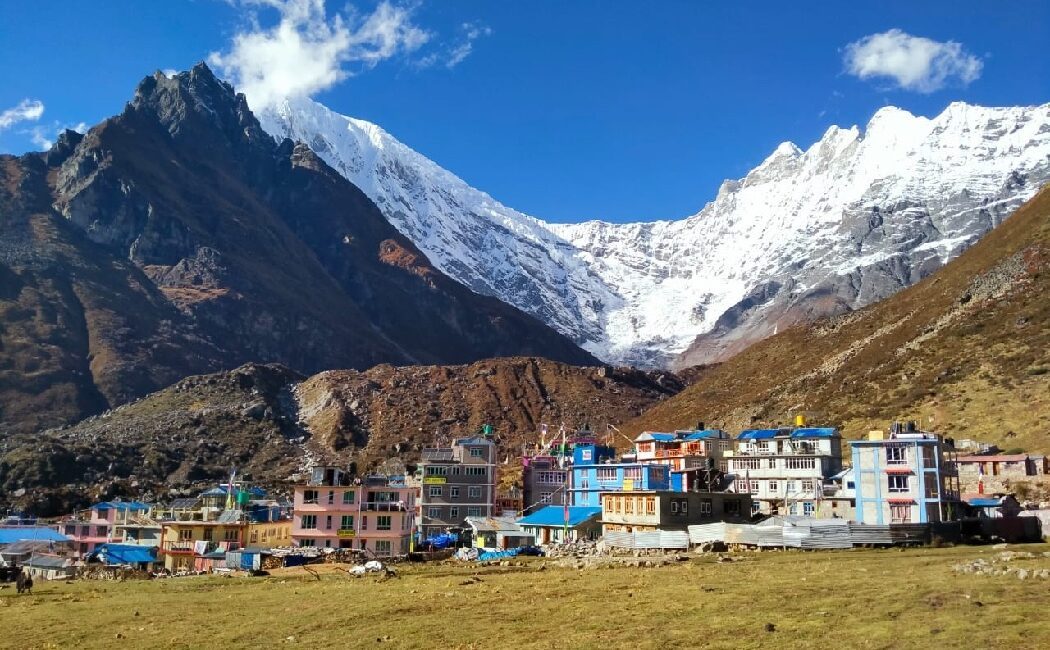
How to Get to Langtang from Kathmandu?
Travel by a local bus.
You can reach to Syabrubesi in around 7 to 8 hours if there is no traffic or slowdown. There are local buses, public jeeps and private vehicle available in Kathmandu.
Local buses carry passengers and loads more than their capacity. So, most tourists usually find the bus drive quite exhausting. This long and uncomfortable bus ride is combined with views of the majestic Himalayas.
You may also see people sitting on the bus’s roof. The empty spaces are filled by loads of stuffs, which people step and sit on.
Also, buses stop every small town they pass by to pick up and drop off goods and people. The travel time can range from 9 to 10 hours.
Despite these discomforts, you will be welcomed to breathtaking views of the Himalayan scenery.
Travel by a Jeep
Besides local bus, you can also travel to Syabrubesi by jeep called as Tata Sumo – a compact 4×4. Although a jeep is faster than a bus, the entire time of journey is hugely affects by traffic and road conditions. So, the time difference between bus and jeep travel will be small.
Every day, at 7:30 a.m., Jeeps leave from Machhapokhari with 8 to 10 people.
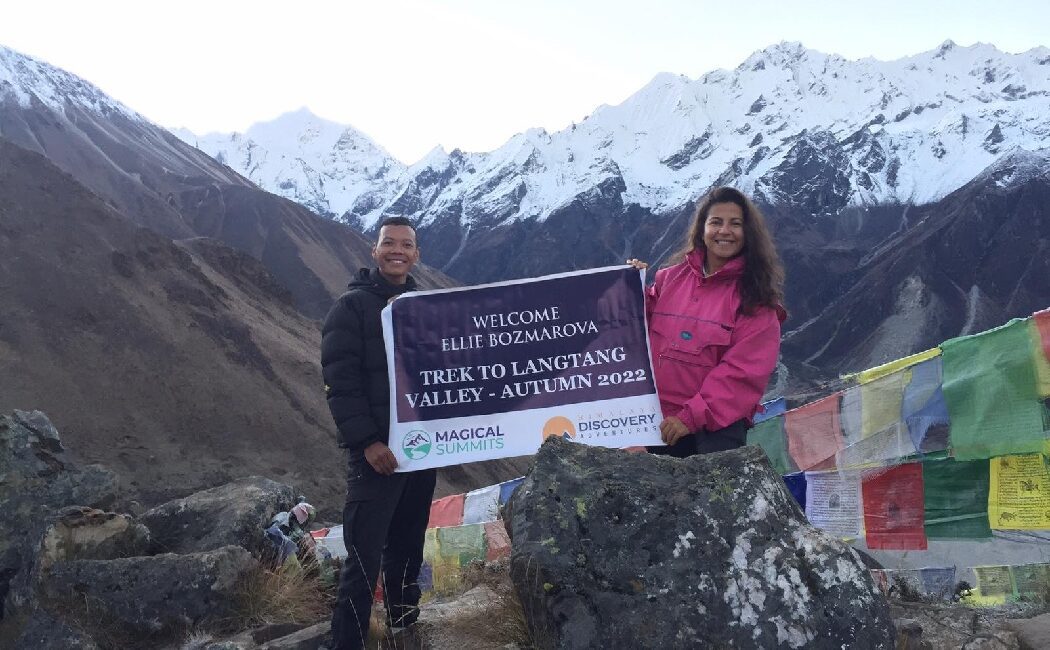
Travel by Private Vehicle
Hiring a private jeep or car might be costly. For one-way travel, you may have to pay around $160. If you prefer to hire a private jeep, you can search for other travelers to share the ride.
Langtang Trek Map
If you’re planning to go on a pleasant week-long trek near Kathmandu, you should go for the Langtang trek. The weather in the Langtang region varies with the seasons of autumn, spring, monsoon, and winter. However, the best time for this trek is the spring and autumn season.
To start organizing a private trek click here to get started .
You May Also Like
- Nepal in August
Nepal Trekking Packing List
- Nepal in April
Upper Mustang Trek Difficulty
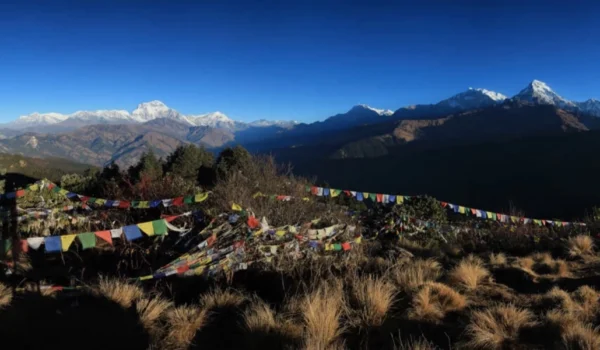
Trekking Areas of Nepal
Posts you might be interested in.
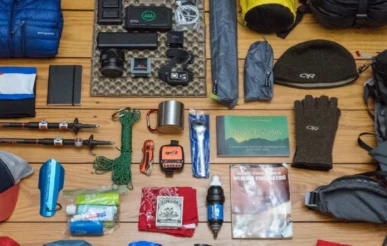
Everest Base Camp Trek in January
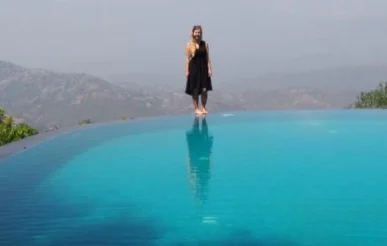
Solo Travel in Nepal
Personalize trip.
"I was born and raised in Nepal, nearby Everest region. I am proud to be a native Sherpa, and I have been a Mountain guide over a decade now. Following my passion, I decided to start helping travelers with their travel plans! I think life is a journey, a trip where you collect experiences when you share with other people and with nature."
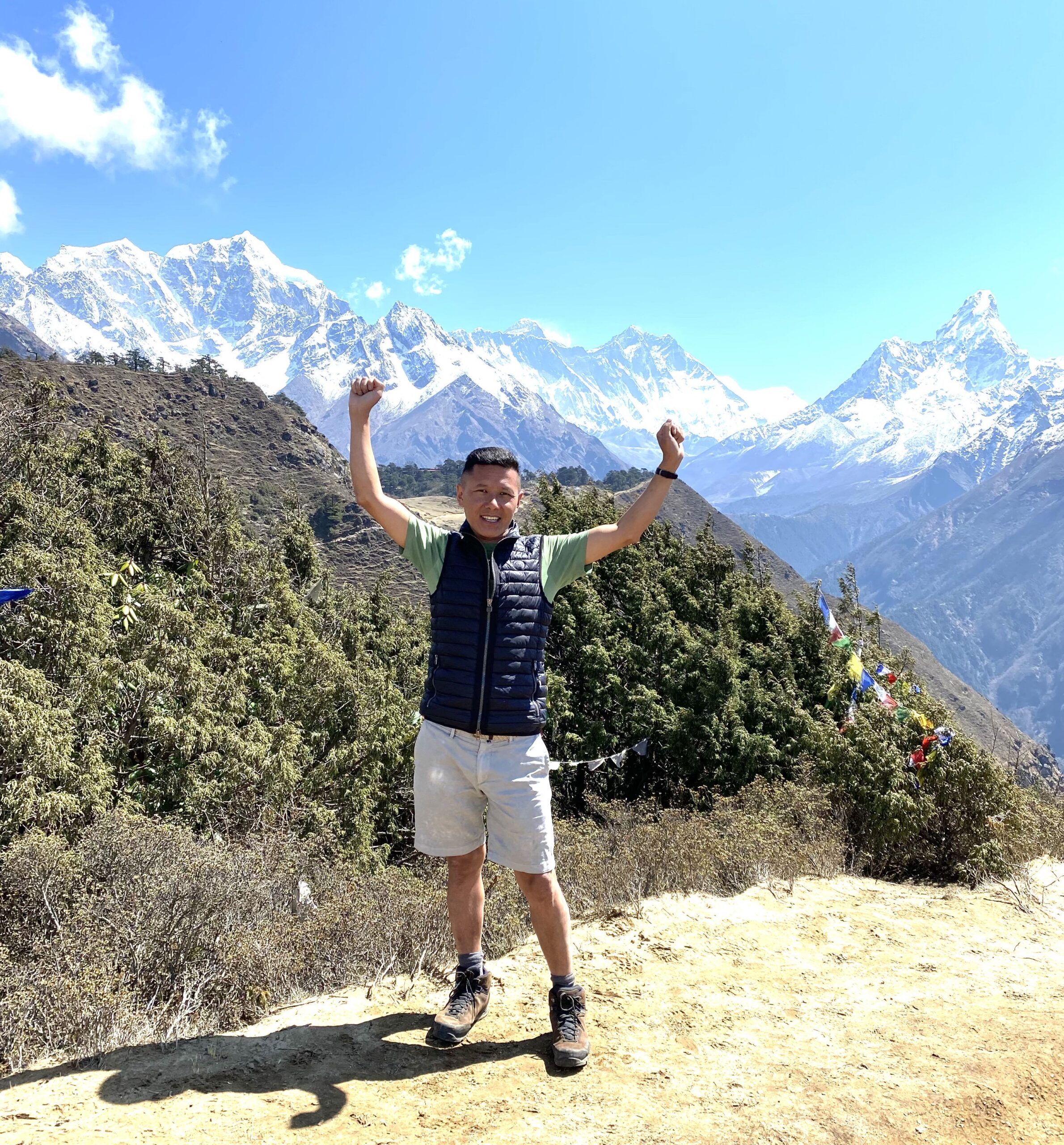
Chhiring Sherpa
We are certified.

Destinations
Trekking type, langtang trek: high altitude adventure in kathmandu's backyard, by jan bakker.
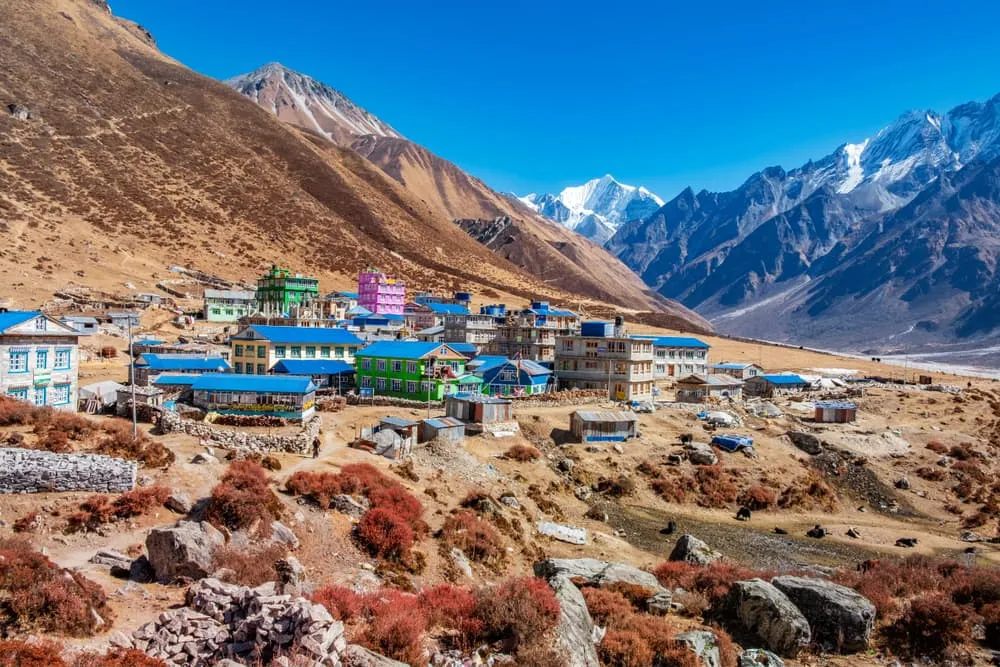
Close to the Tibetan border there’s a magical valley with towering mountains that exceed the 7000 meters mark. Welcome to the Langtang Valley, a hidden gem not far from Nepal’s capital city Kathmandu. From the lush forests in the shadows of the Langtang Himal to the picture perfect viewpoint of Tsergo Ri at almost 5000 meters, the Langtang Valley trek has it all. The great news is, this trek is doable for almost every trekker as the distances and elevation gain are relatively small. Bookatrekking.com has taken numerous trekkers to this forgotten corner of the Himalayas. And we’re thrilled for you to join us too!
I am Jan, and at Bookatrekking.com, I ensure that you find your next epic trek in the Nepali Himalayas. As an experienced trekker who has visited Nepal multiple times, I’d like to share my knowledge and advice for the trek to the beautiful Langtang Valley . Unleash the explorer in you and get in touch!
The Langtang Valley Trek: The Most Accessible High Altitude Trek in Nepal
How hard is the langtang trek, when to hike the langtang valley trek, langtang valley and the 2015 earthquake, langtang valley trek itinerary, langtang trek map, what permits do i need for the langtang valley trek , what are the teahouses in langtang valley like , packing list for the langtang valley trek, how to identify and prevent ams on the langtang valley trek, where can i book the langtang valley trek.
Nepal is famous for its long-distance hiking trails like Everest Base Camp and the Annapurna Circuit , covering lots of mileage and vertical gain. This may not be for everybody. The Langtang Valley Trek is ideal for those who don’t want to commit to a strenuous trekking journey, but still want to experience the very essence of trekking in Nepal.
The Langtang region is located straight north of Kathmandu, geographically the closest Himalayan mountains from the capital. The enormous ridge of snow and ice called the Langtang Himal forms a formidable natural barrier of more than 7000 meters high with neighboring Tibet. The mountains and the valley below are part of the Langtang National Park, the first designated national park in the entire Himalayan Range. It’s a safe haven for elusive animals like the red panda, ghoral (mountain goat) and the snow leopard.
The trek starts in Syabrubesi, at the bottom of the Langtang Valley where you pay your Langtang National Park fee. A skinny trail winds along the banks of the at times raging torrents of the Langtang Khola. The route is mostly in the shade of the rhododendron and pine trees, keeping you a bit cooler in the hot, lower parts of the valley. The landscape opens up as you approach Langtang Village. To the north is the huge wall of Langtang Himal’s highest peak, Langtang Lirung (7234m). Six kilometers further up the valley there’s Kyanjin Gompa, with a 300 years old monastery. This friendly village is a huge contrast to its barren surroundings, and it’s the highest overnight stop on the Langtang trek. From here, there’s the option to climb up Tsergo Ri, more than a 1000 vertical meters up. It’s a long, tough, but non-technical climb to a large buddhist stupa. From the top at 4985m you have panoramic views of Langtang Lirung and the world’s 14th highest peak, Shishapangma (8027m high!). It is in many ways the highlight of trek.

Langtang Valley Trek
In short, the trek is not that hard. The Langtang Valley elevation is fairly modest compared to for example the Everest treks . The trails up the valley are in good condition, and they ascend gradually along the river Langtang Khola. The distances are very manageable, leaving enough time to enjoy downtime in the villages after the day’s walk. The hardest day is the trek up the 4985 meter high Tsergo Ri from Kyanjin Gompa, which is a bit like ascending a mountain (higher than Mont Blanc!). However, this ascent is optional, as you will come back to stay in the same place at Kyanjin Gompa. You could also go for a slightly lower viewpoint at Kyanjin Ri at 4779 meters above sea level. For those who want to take it easy, you can stick around in Kyanjin Gompa and take in the spectacular mountain scenery while sipping endless cups of tea. All in all, this trek is doable for every reasonably fit hiker.
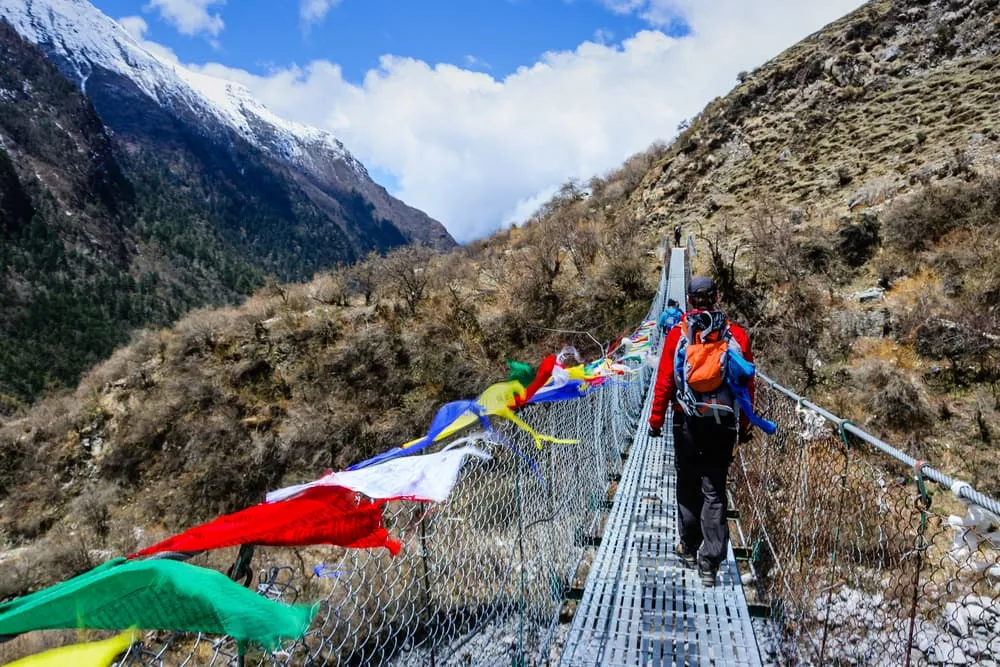
The Langtang Region, along with most of the other trekking areas in Nepal , has four distinct seasons. Spring, summer, autumn and winter. The months from March to May, pre-monsoon, and from October to early December, post-monsoon, are the most popular for hiking the Langtang Valley trek. Every season offers its own excitement and atmosphere and in principle, you can go trekking year-round. There are good reasons why spring and autumn are considered the trekking season. Below we’ll explain more what each of the seasons are like.
Spring (March-May) is the prime trekking season and trekkers from around the globe come to the Nepali Himalayas in large numbers. In springtime, the temperature is pleasant, the precipitation is low and the hiking conditions are great. On the trail there’s a lot of excitement to head up to the maximum Langtang Valley altitude of almost 5000 meters at the Tsergo Ri. While temperatures in daytime along the trek are balmy, the temperature higher up in Kyanjin Gompa and beyond can be very cold in the early morning. To prepare yourself for this, check our complete Langtang trek packing list further below in this blog post.
Summer season falls in the months of June, July and August. Summer is the period with higher temperatures and in that sense it is quite pleasant. However, this is also the monsoon season, and it rains a lot. The chance of seeing the mountains around you is smaller as it is cloudy most of the time. The trail will be wet and slippery and there is an increased risk of landslides. And leeches are very active during these months. On the flip side, it’s almost empty on the route and the traditional villages feel calm and serene.
Autumn in the Langtang Valley (September, October, November) is, like springtime, prime trekking season with similar trekking conditions. There is one difference. The air in spring is sometimes a little hazy due to the dust in the atmosphere. Post-monsoon the air is very clear, allowing for stunning views of the surrounding mountains.
Winter season runs from December to February. This period is the toughest time to trek the Langtang Valley. The sun is low and doesn't get above the mountain ridge lines for a period of time, especially in the lower parts of the valley. Night temperatures drop to -10 degrees Celsius. Add wind and snowfall and you’ve got yourself proper winter conditions. Why do we still run the Langtang Valley hike in winter? We work with some of the best trekking companies in Nepal. Besides trekking trips they also organize climbing expeditions to some of the highest peaks in the Himalayas. Our partners can keep you safe and comfortable, even in these cold conditions. And you will probably have the entire trail to yourself!
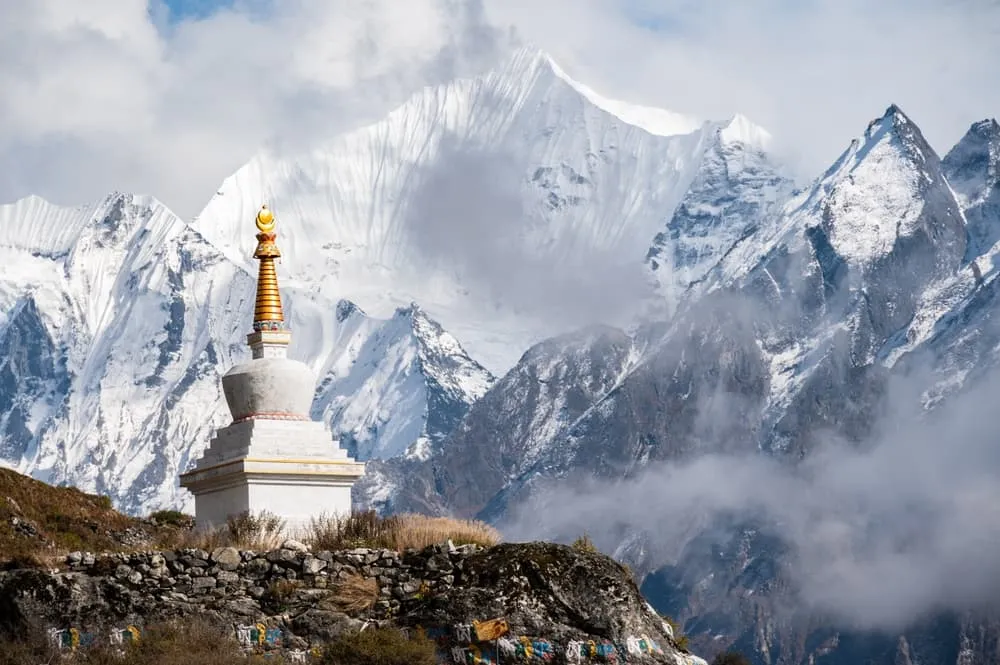
The earthquake that struck Nepal in April 2015 was a devastating event, and Langtang was one of the severely affected areas. The earthquake had a magnitude of 7.8 and caused widespread destruction, triggering avalanches and landslides in the Himalayan region.
In Langtang specifically, the earthquake triggered a massive avalanche that swept through the valley, burying entire villages under tons of snow and debris. The aftermath was heartbreaking, with many lives lost, homes destroyed, and families shattered. The remote and mountainous terrain made rescue and relief efforts challenging. The avalanche also caused a glacial lake to burst, compounding the destruction downstream. The entire community of Langtang was essentially wiped out, and the survivors faced the daunting task of rebuilding their lives amidst the ruins. The earthquake highlighted the vulnerability of communities in seismic zones and the need for better preparedness and infrastructure to mitigate the impact of such disasters in the future.
The villages have mostly been rebuilt, albeit in different more safe locations. Also the walking trails have been restored and trekkers have returned to enjoy the Langtang Valley hike.
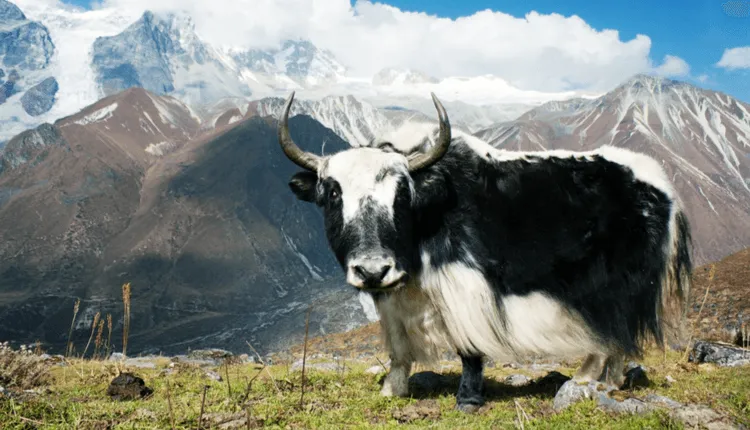
Drive to Syabrubesi
Syabrubensi.
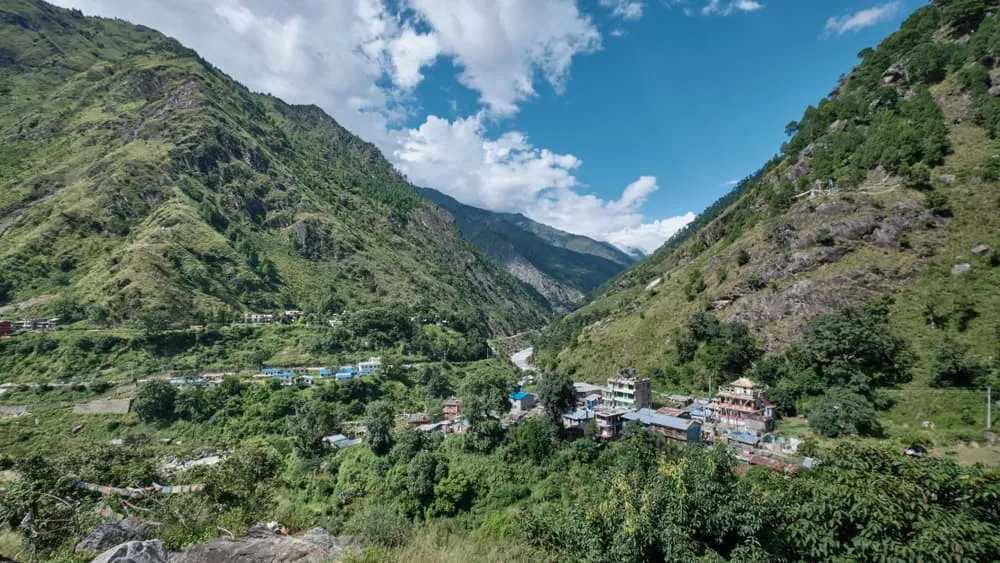
Syabrubesi trek to Lama Hotel
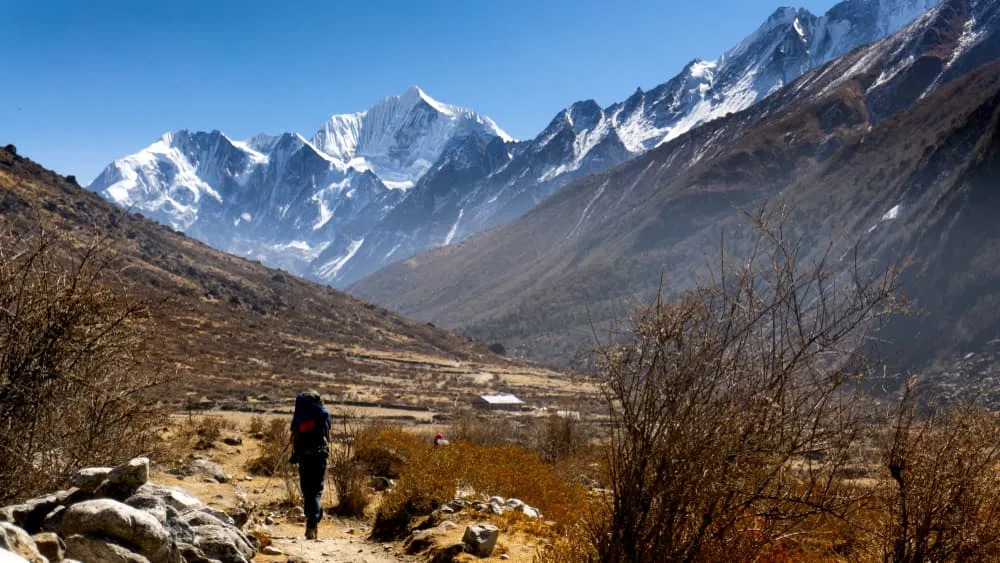
Trek to Langtang

Trek to Kyanjin Gompa
Kyanjin gompa.

Side trek Trek to Tsergo Ri (4985m)
Trek to rimche.
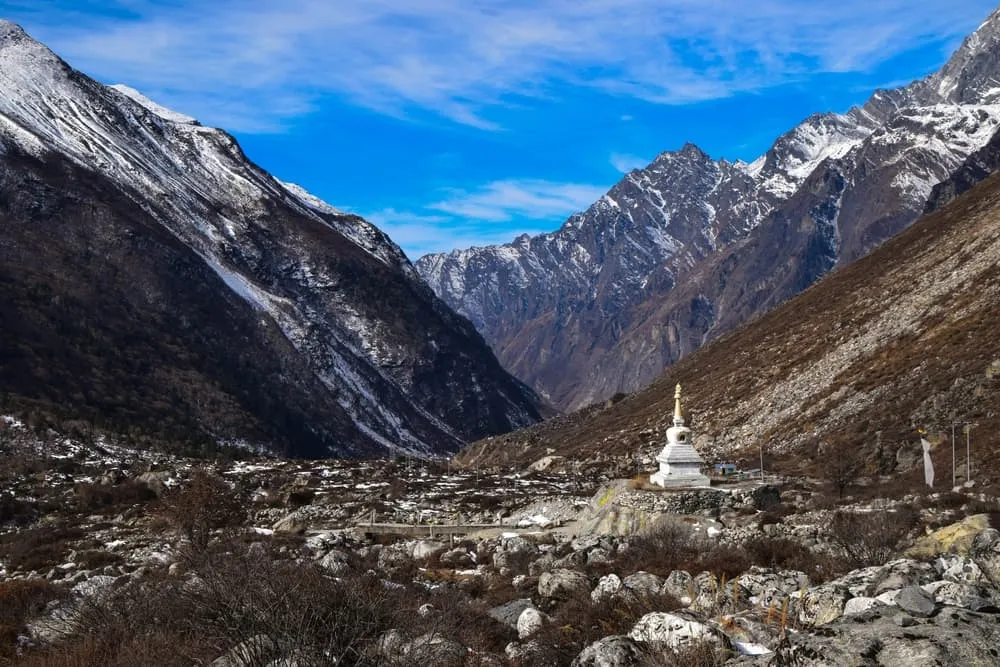
Trek to Syabrubesi
Drive back to kathmandu.
For trekking in Langtang National Park, you need the following permits:
TIMS (Trekkers Information Management System):
This permit is important for every trekker wishing to trek in Nepal. From the Annapurna Circuit to the trek to Poon Hill, all trekking routes require this permit. This costs NRS 2000 per person. This equals about 17 USD or 15 EUR.
Langtang National Park entrance fee
The Langtang trek leads through the Langtang National Park. This costs an additional 25 USD.
All permits are arranged by your trekking provider.
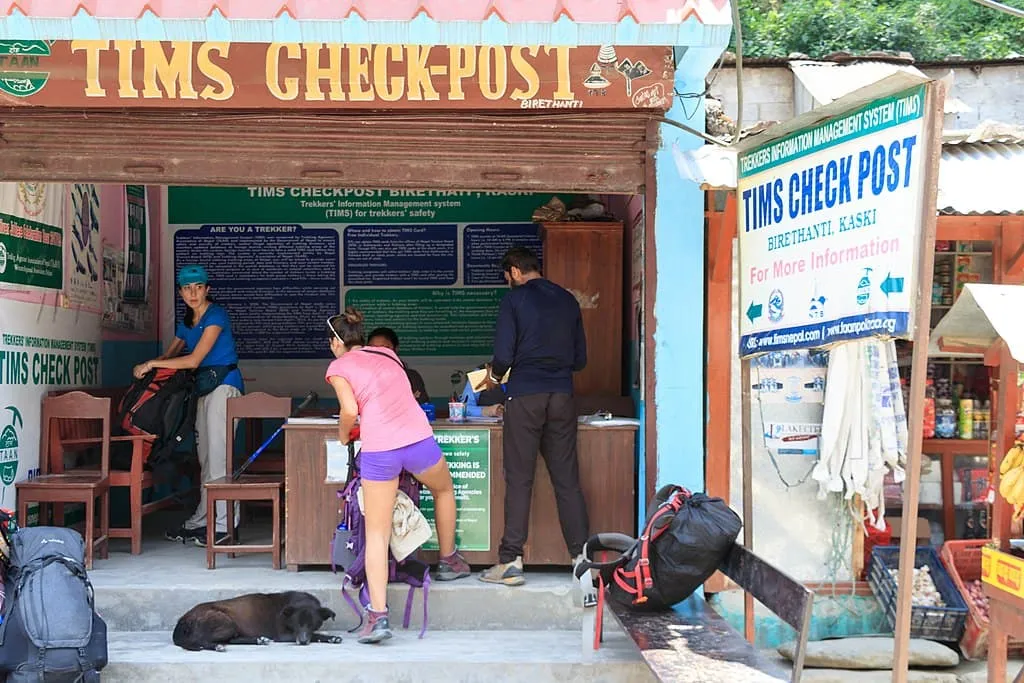
Experiencing a stay in the traditional villages along Nepal's trekking routes is, in my opinion, an integral and enriching aspect of trekking in Nepal. It represents a harmonious blend of rugged mountain wilderness and a distinctive mountain culture. Staying in these mountain villages provides a genuine glimpse into life in the Langtang Valley.
Each village offers accommodations in a tea house, the local term for a guesthouse. During my trekking adventures in Nepal, I always look forward to reaching the next destination early. Why? Because I cherish the tranquility and simplicity of life in these mountain villages. Enjoying a cup of tea, I immerse myself in the daily rhythm of life in the Himalayas. Some villages may feature monasteries, and fortunate trekkers might encounter one of the many Buddhist festivals. While the tea houses themselves are generally simple, in recent years, some have undergone improvements, now equipped with flush toilets, warm water, and even WiFi. Fortunately, the delectable dhal bat, a staple in Nepalese trekking cuisine, remains a highlight on every tea house menu. Immerse yourself in Nepal's mountain culture on the Langtang Trek!
Not sure yet or want to discuss your plans for the Langtang Valley Trek with one of our trekking experts? Get in touch today and turn your dreams into memories!
Trekking in Nepal requires good quality and appropriate equipment. Especially the essentials like a good pair of hiking boots and breathable hardshell rain jacket. We highly recommend that you read our suggested packing list to hike the Langtang Valley Trek.
Technical Clothing
Accessories.
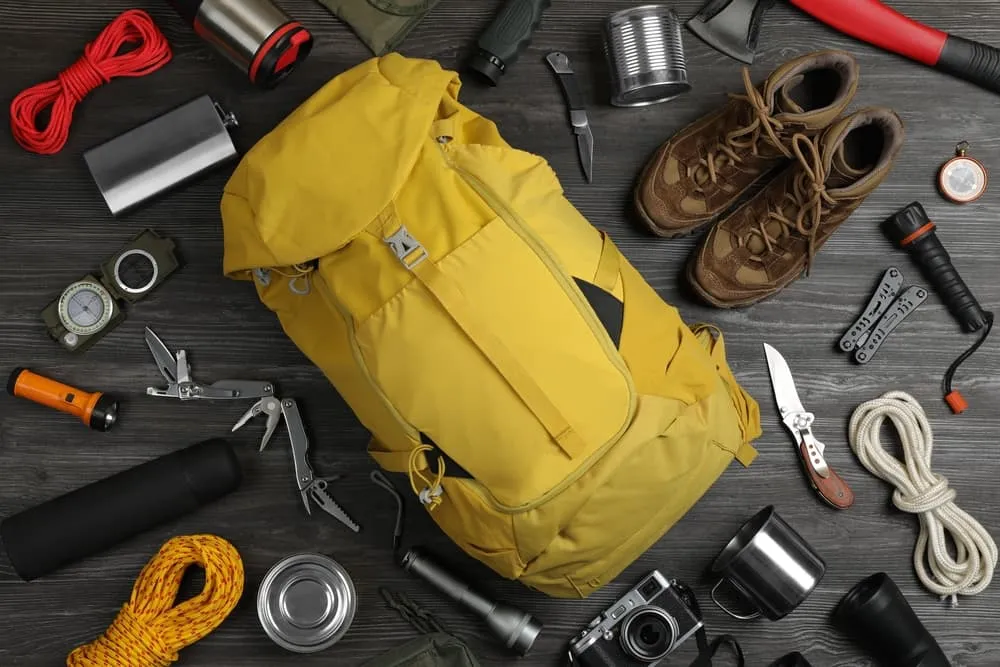
It's essential to understand that altitude sickness can affect anyone, regardless of age, fitness level, or previous high-altitude experience. These days there are several tools to monitor your health at altitude. A widely-used (analog) method is the Lake Louise score card. It ticks the altitude symptoms while keeping the severity in mind. It’s a common tool used by guides. Nowadays, most trekking and mountain guides bring a blood oxygen saturation meter, which also measures the heart rate. These are key indicators whether a person adapts to altitude well or not. AMS can occur when trekking the Langtang Valley Trek. Below you can find everything you need to know about altitude sickness.
Acute Mountain Sickness (AMS)
Altitude sickness, also known as Acute Mountain Sickness (AMS) is a health condition that occurs when someone is exposed to low levels of oxygen at higher altitudes. AMS is a serious condition and as the name suggests acute. It needs to be dealt with immediately, as it is potentially life-threatening. Most people will experience some mild symptoms of altitude sickness. It’s important to be aware of these symptoms and act before symptoms become more severe. Below we break down the different forms of AMS and how you can reduce the risk of getting it.
AMS symptoms
It is key to know how to identify altitude illness. You may experience the following symptoms due to the jump in altitude: headache, lack of appetite, breathing difficulties, insomnia, nausea and vomiting. The intensity and severity of these symptoms may increase with altitude and an overall feeling of fatigue will take all your joy away. This may further deteriorate to one of these life-threatening conditions.
High Altitude Pulmonary Edema (HAPE) : HAPE is a condition in which fluid accumulates in the lungs, making it difficult to breathe. Symptoms may include shortness of breath, a persistent cough, chest tightness, and an increased heart rate. It can be a life-threatening condition and requires immediate descent to lower altitudes and, in severe cases, medical treatment.
High Altitude Cerebral Edema (HACE) : HACE is a more serious condition in which fluid accumulates in the brain. Symptoms may include severe headaches, confusion, loss of coordination, and altered mental status. HACE is also a medical emergency and requires immediate descent and medical attention. Below 7 ways of minimizing the risk of AMS:
1. Gradual Ascent
One of the most effective ways to prevent AMS is to ascend gradually. When traveling to high altitudes, try to take several days to acclimatize before going higher. This allows your body to adapt to the reduced oxygen levels. All our treks in Nepal keep sufficient acclimatization into account.
2. Stay Hydrated
Dehydration can increase the risk of AMS, so drink plenty of fluids. Avoid excessive alcohol and caffeine consumption, as they can contribute to dehydration.
Consume a balanced diet with adequate carbohydrates and avoid heavy, fatty meals. Carbohydrates can help your body utilize oxygen more efficiently at high altitudes.
4. Medication
Some individuals may consider taking medication, such as acetazolamide (Diamox), to help prevent AMS. Consult with a healthcare professional before using any medication, and be aware of potential side effects.
Ensure you get enough sleep and rest during your ascent. Fatigue can increase the risk of AMS.
6. Avoid Overexertion
Pace yourself and avoid overexertion. Listen to your body, and if you experience symptoms of AMS, rest or descend to a lower altitude.
7. Descend if Symptoms Persist
If you experience symptoms of AMS, such as headache, nausea, dizziness, or difficulty breathing, it's crucial to descend to a lower altitude. Symptoms should not be ignored or dismissed.
At Bookatrekking.com you can book this trek and many others. Our guided options come with experts on the ground, and offer you a convenient, stress-free, safe, and educational way to explore the outdoors. Find our offers here . Our easy-to-use platform allows you to browse and compare different trekking options and find the perfect fit for your interests, abilities, and budget.
If you have any questions about a specific trek or need help choosing the right one for you, our team of trekking experts is here to assist you. Simply reach out to us and we will be happy to provide you with personalized recommendations and advice to help you plan the trekking adventure of a lifetime.
Is this not your cup of tea and are you looking for other epic adventures? Check out one of our blog posts:
Summit climbs
- Climbing Kilimanjaro
- Climbing Triglav
- Climbing Island Peak in Nepal
- Climbing Mount Kenya
- Climbing Mount Elbrus
- Climbing Mount Kinabalu
- Climbing Toubkal
- Climbing Rinjani
- Everest Base Camp Trek
- Annapurna Circuit Trek
- Nepal Travel Guide
- Salkantay Trek
- Peru Travel Guide
Kilimanjaro
- Machame Route
- Lemosho Route
- Kili Travel Guide
Self-guided treks
- Tour du Mont Blanc
- West Highland Way
- Camino de Santiago

Also Interesting
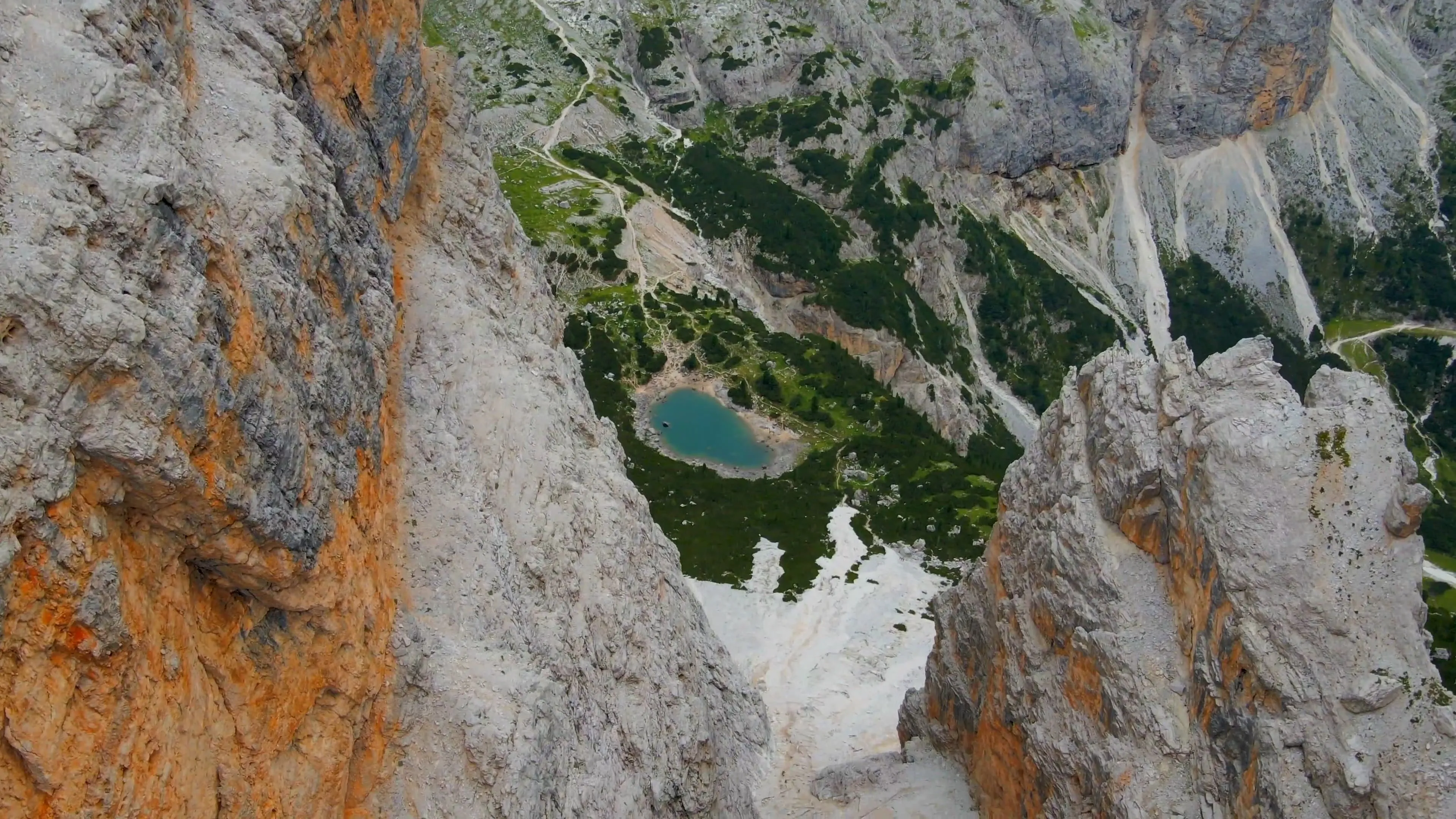
Alta Via 1: Map, Difficulty, and Route on the Italian Dolomites
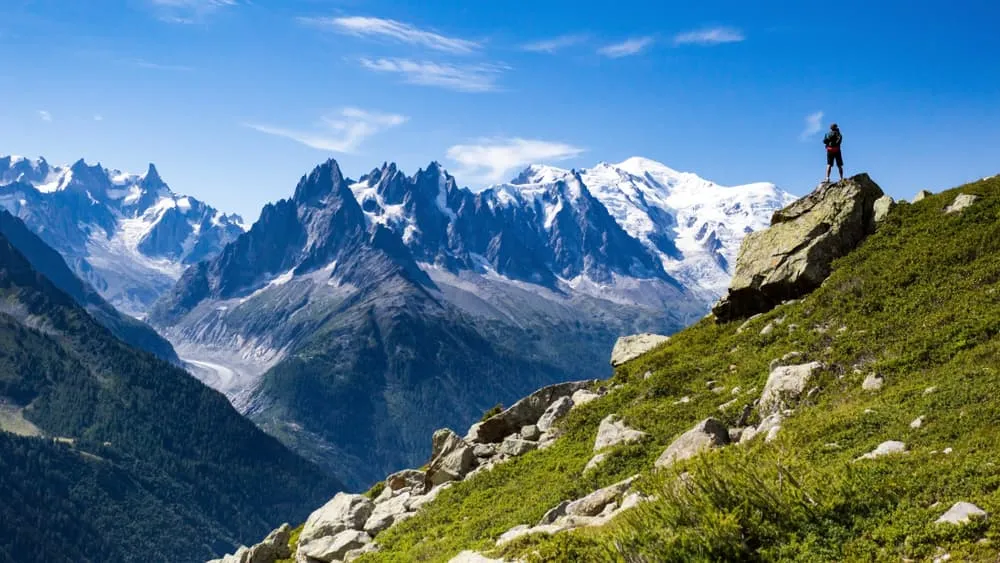
Tour du Mont Blanc: All You Need To Know
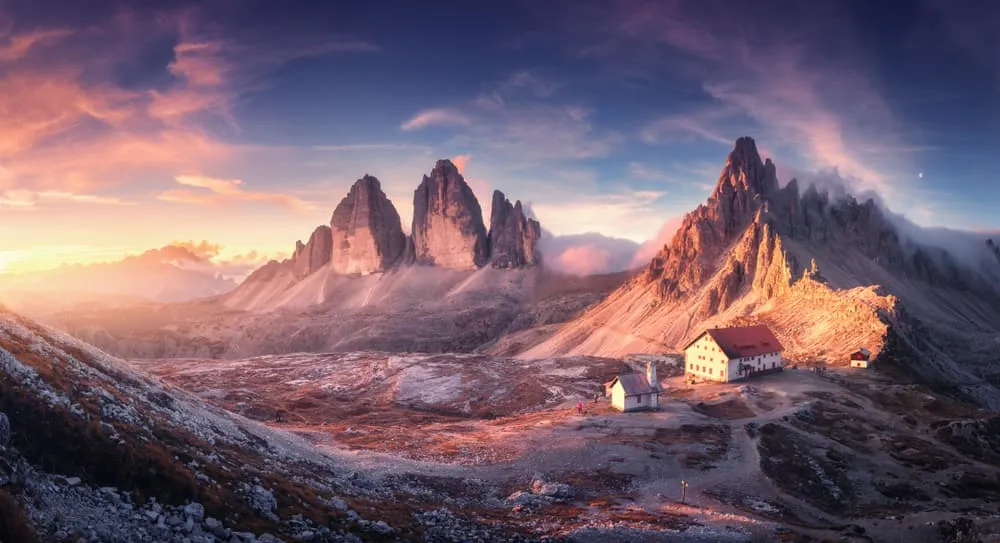
Dolomites Hiking: The 8 Best Options for Hiking Hut-to-Hut in Italy
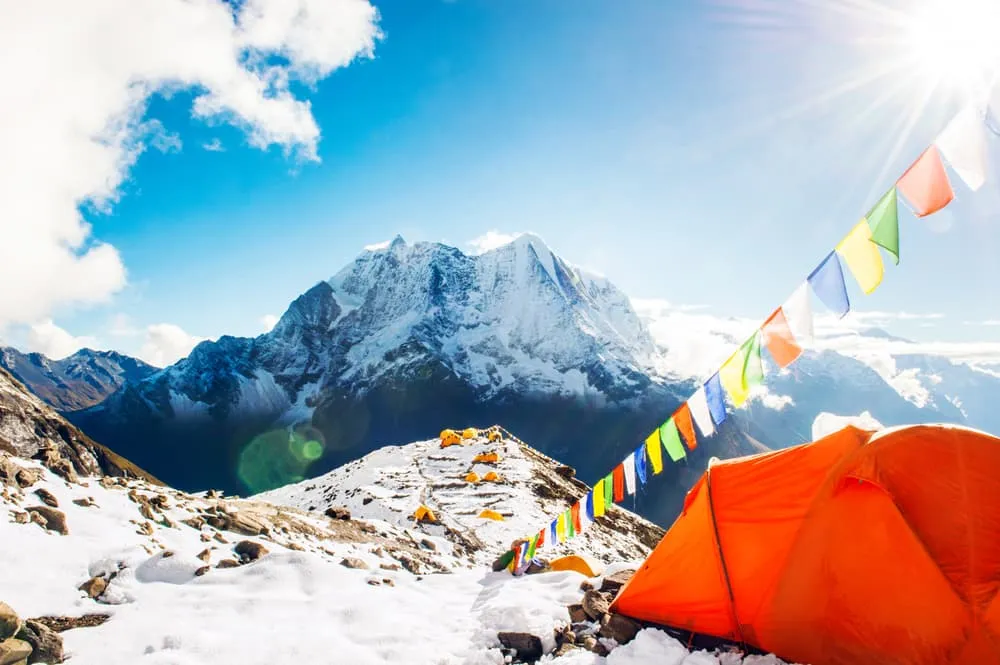
Everest Base Camp: A Trek to The Roof of The World
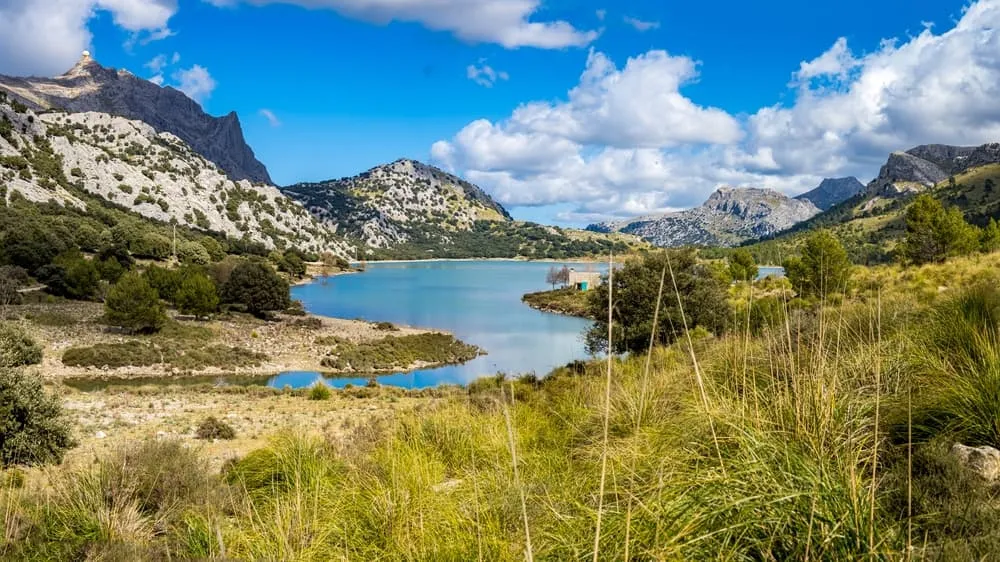
Hiking the GR221 in Mallorca: Everything You Need to Know
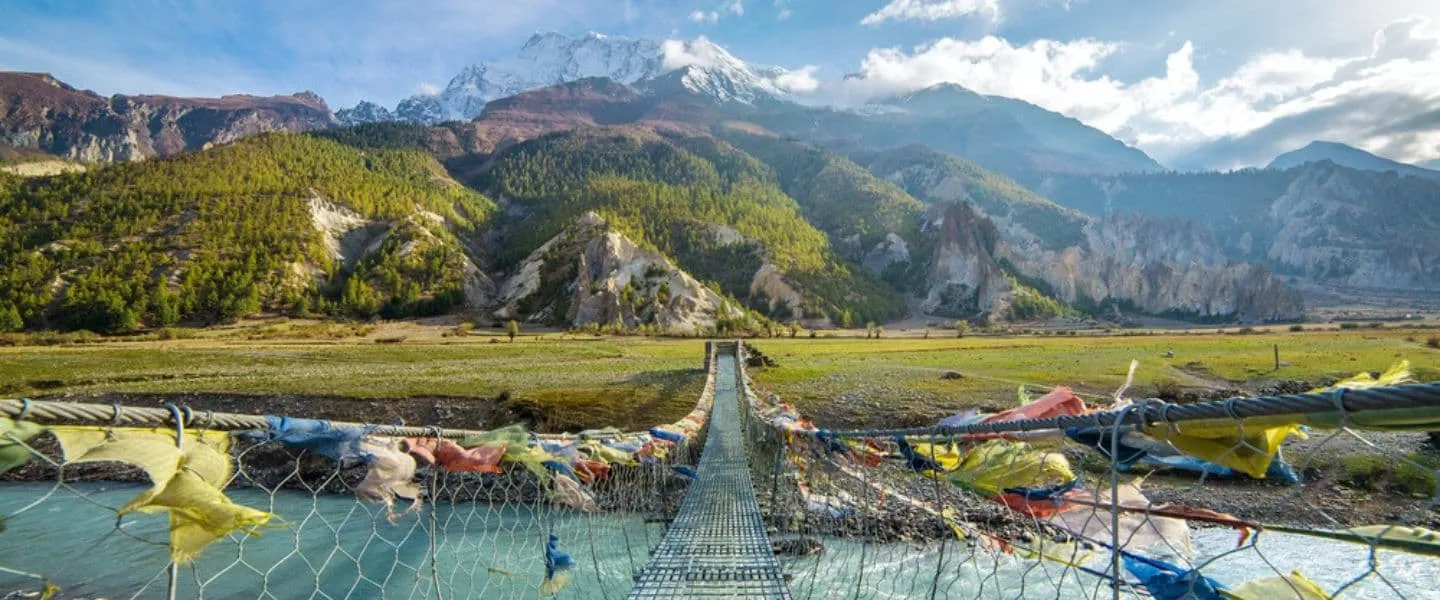
Annapurna Circuit Trek: How to Hike Around the Annapurnas
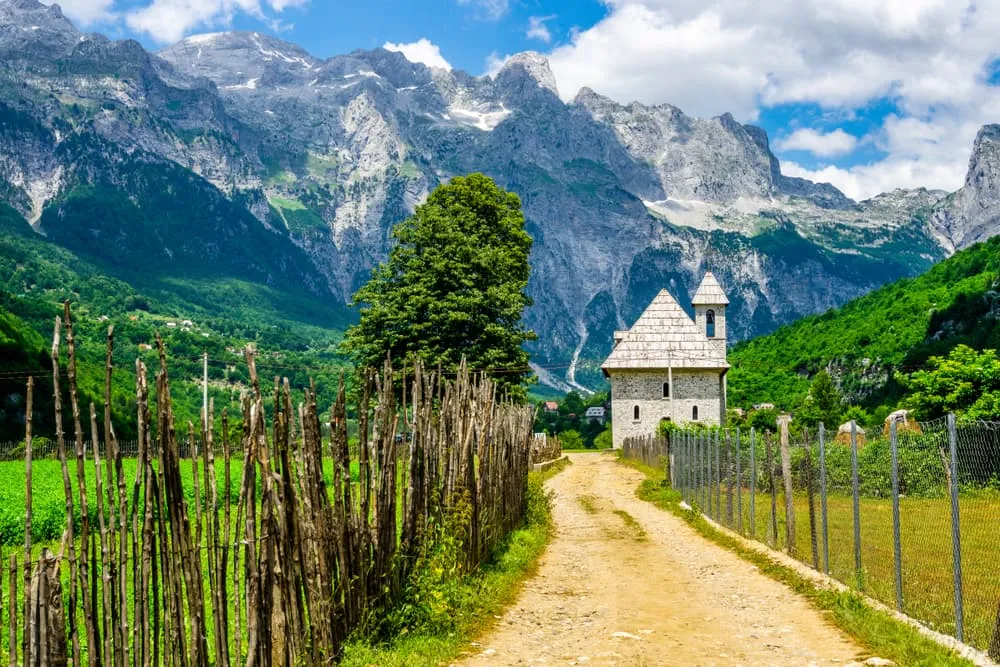
Peaks of the Balkans Trail: All You Need to Know

Hut-to-Hut Hiking in the Pyrenees: The 4 Best Walks
Get weekly inspiration with the best treks.


The Ultimate Exploration of
Langtang valley.
The Langtang Valley, often referred to as "the valley of glaciers," is nestled amidst the breathtakingly beautiful mountains in the central Himalayan region of Nepal. Located approximately 61.8 kilometers north of the capital city, Kathmandu, the valley provides an enthralling spectacle of snow-clad peaks, lush green forests, and vibrant, traditional Nepalese villages.
Langtang Valley: The Hidden Splendor of Nepal
At the heart of the valley are the Tamang people, an indigenous community whose culture, language, and dress are very similar to the Tibetan people. Their lifestyle, heavily influenced by Buddhism, reflects a symbiotic relationship with the natural environment, adding to the valley's distinct charm.
The Langtang Valley is also known for the Langtang Trek, one of the most popular trekking routes in Nepal. This trek, which ranges from moderately difficult to challenging, takes travelers through dramatic landscapes, ancient monasteries, and yak pastures, providing glimpses into the local culture and way of life. The trek ultimately leads to the high alpine valley where the stunning Langtang Lirung glacier and the Kyanjin Gompa, a famous Buddhist monastery, are located.
Despite being overshadowed by popular destinations like the Everest and Annapurna regions, Langtang Valley stands out as a hidden gem offering a blend of natural beauty, rich cultural heritage, and adventure. It's an unspoiled haven for those seeking tranquility away from the tourist crowds. Tragically, the valley was severely impacted by the devastating earthquake in 2015, but through resilience and community efforts, it has undergone considerable reconstruction and continues to welcome travelers from around the world.
Geographical location and significance

The Langtang Valley is situated in the Bagmati province of central Nepal, approximately 61.8 kilometers north of Kathmandu. It lies in the region where the southernmost limit of the Tibetan plateau meets the Himalayan mountain range. The valley's geographical coordinates are roughly 28.2° N latitude and 85.6° E longitude.
The Langtang Valley is nestled between the main Himalayan range to the north, bordering Tibet, and a slightly lower range of snowy peaks to the south. Langtang Lirung (7,227 meters), Gang Chhenpo (6,388 meters), Naya Kanga Ri (5,846 meters), and Dorje Lakpa (6,966 meters) are some of the prominent peaks surrounding the valley. The highest point in the national park is Langtang Lirung.
The valley's geographical position holds significant scientific interest. It presents a unique opportunity to study tectonic and metamorphic processes due to its location along the tectonic boundary between the Indian and Eurasian plates. It's also a valuable site for studying glacial processes and the impact of climate change on the Himalayan ecosystem, given the prevalence of glaciers in the region.
In terms of cultural geography, Langtang Valley is significant because it's home to the Tamang ethnic group, whose culture and traditions bear a strong resemblance to Tibetan society. This offers valuable insights into the historical migration and cultural exchange between Tibet and Nepal.
From a tourism perspective, Langtang's location near Kathmandu makes it easily accessible compared to other remote Himalayan regions. Despite its proximity to the capital, Langtang Valley provides a peaceful retreat from the hustle and bustle, offering tourists a blend of high-altitude adventure, natural beauty, and cultural immersion.
The geographical significance of Langtang Valley is further underlined by its representation of diverse ecosystems, from subtropical forests in the lower sections to alpine scrub and rock in the upper regions, making it a hotspot for biodiversity. The national park's diverse topography and altitude variation contribute to the proliferation of a wide range of flora and fauna.
Lastly, the Langtang Valley holds significant importance in terms of environmental conservation and sustainable tourism. It's a living example of how communities can coexist harmoniously with nature while preserving their cultural heritage and promoting eco-tourism.
Early Inhabitants and Historical Significance

The Langtang Valley, nestled within the confines of the high Himalayas, has been home to the Tamang people for centuries. The Tamangs, believed to have migrated from Tibet hundreds of years ago, are the major ethnic group in this region. Their customs, language, attire, and religious practices bear a striking resemblance to Tibetan culture, reflecting their historical roots.
The valley's history is intertwined with Buddhism, evident in the monasteries, chortens (Buddhist shrines), prayer flags, and Mani walls (stone structures inscribed with Buddhist prayers) that dot the landscape. The revered Kyanjin Gompa, a significant religious site located at the upper end of the valley, indicates the historical and ongoing importance of Buddhism in the lives of the local people.
The historical significance of Langtang Valley is also marked by its location along an old trade route between Nepal and Tibet. Before the Chinese invasion of Tibet in 1950, the people of Langtang engaged in barter trade, exchanging Nepalese grains for Tibetan salt, wool, and livestock. This historical trade route fostered cultural exchange and shaped the socio-economic fabric of the region.
Historical Events
Establishment of Langtang National Park: In 1976, the Government of Nepal established Langtang National Park, the country's first Himalayan conservation area. This milestone event marked a significant step towards conserving the valley's rich biodiversity and promoting sustainable tourism.
The 2015 Earthquake: The Langtang Valley was one of the regions most severely affected by the devastating 7.8 magnitude earthquake that struck Nepal on April 25, 2015. The earthquake, and the subsequent avalanche it triggered, led to massive loss of life and property in the valley. The village of Langtang was buried under an avalanche, causing the death of approximately 300 people, including locals and tourists. The earthquake's aftermath led to significant changes in the region's topography, and the process of rebuilding the affected areas has been a critical chapter in Langtang's history.
Post-Earthquake Reconstruction and Resilience: In the face of such adversity, the people of Langtang demonstrated immense resilience. With support from government, non-government organizations, and the international community, they have been steadily rebuilding their homes, teahouses, and trails, revitalizing tourism, and restoring their livelihoods.
The 2015 Earthquake's Impact on the Valley
Efforts towards rebuilding and rehabilitation, present situation and future implications.
The 7.8 magnitude earthquake that struck Nepal on April 25, 2015, had a devastating impact on Langtang Valley. A massive landslide, triggered by the quake, swept through the valley, burying the entire village of Langtang under tons of rock and ice. Approximately 300 people, including locals and tourists, lost their lives in this disaster. The earthquake and subsequent landslides also destroyed homes, teahouses, monasteries, and infrastructure, leaving the valley in ruins.
The disaster not only caused a tremendous loss of life and property but also deeply affected the socio-economic fabric of the region. The destruction of the trekking trail and teahouses severely impacted tourism, a major source of income for the local people.
The recovery and rebuilding process in Langtang Valley has been a story of resilience and community spirit. With support from the Nepalese government, non-governmental organizations, and international aid, the people of Langtang have been working tirelessly to rebuild their homes, restore their livelihoods, and revive tourism.
New teahouses have been constructed, and the trekking trail has been repaired and reopened, encouraging tourists to return to the region. Community-based initiatives have played a crucial role in the rebuilding process, with locals actively participating in reconstruction efforts.
As of now, Langtang Valley has made significant strides in its recovery. The tea houses are operational, and the trekking trail is busy with trekkers, signalling a revival of tourism. However, the scars of the disaster are still visible, serving as a poignant reminder of the tragedy.
The earthquake has also underscored the need for better disaster preparedness and management in the region. Efforts are being made to improve early warning systems, build earthquake-resistant structures, and raise awareness among locals and visitors about safety measures.
In terms of future implications, the experience has highlighted the importance of sustainable tourism. As Langtang rebuilds, there is a growing recognition of the need to balance tourism growth with preserving the valley's natural and cultural heritage.
The 2015 earthquake was a devastating event in the history of Langtang Valley. However, the resilience of the people and their determination to rebuild their lives and their community have been truly inspiring. As the valley continues to recover, it stands as a testament to human strength and resilience in the face of adversity.
Langtang Valley Attractions
Langtang Valley has long been a cherished destination for travelers and trekkers worldwide, thanks to its stunning natural beauty, rich cultural heritage, and the allure of adventure it offers. Here's a closer look at the appeal of Langtang Valley:
Stunning Landscapes: Langtang Valley is often referred to as the "valley of glaciers" and for good reason. The region is abundant with snow-clad peaks, picturesque alpine forests, roaring rivers, and serene mountain lakes. The breathtaking views of peaks like Langtang Lirung, Ganesh Himal, and Dorje Lakpa are nothing short of awe-inspiring.
Diverse Wildlife: The valley, which lies within Langtang National Park, is rich in biodiversity. The variation in altitude has resulted in a wide range of habitats, from deciduous forests to alpine scrub, making it home to numerous species, including the red panda, snow leopard, and Himalayan tahr. Bird enthusiasts can also spot a variety of bird species.
Cultural Immersion: Langtang Valley is primarily inhabited by the Tamang ethnic group, whose culture, traditions, and lifestyle are heavily influenced by Tibetan Buddhism. The local architecture, monasteries, prayer flags, Mani walls, and the warmth of the Tamang people add a unique cultural dimension to the visit.
Trekking Adventures: The Langtang Valley Trek is one of the most popular trekking routes in Nepal. While it's less crowded than the famous Everest and Annapurna treks, it's equally rewarding. The trek, which is suitable for all fitness levels, takes one through diverse landscapes, traditional villages, yak pastures, and ancient monasteries. The highlight of the trek is reaching Kyanjin Gompa and the option to hike to Kyanjin Ri or Tserko Ri for stunning panoramic views of the valley and the surrounding peaks.
Proximity to Kathmandu: Unlike other remote Himalayan regions, Langtang Valley is relatively close to Kathmandu, making it easily accessible for international and domestic travelers alike. Despite this, it's far enough to feel like a tranquil retreat from the bustling city.
Community-Based Tourism: Travelers get the opportunity to contribute to the local economy through community-based tourism. Many tea houses and homestays are run by local families, providing an intimate experience of Tamang hospitality and culture.
Sustainable Tourism: Langtang Valley offers an example of how tourism can be sustainable. There are ongoing efforts to minimize environmental impact, promote local culture, and ensure that the benefits of tourism are shared within the community.
Whether it's the allure of high-altitude trekking, the serenity of Himalayan landscapes, or the charm of cultural discovery, Langtang Valley offers an unforgettable journey for every traveler.
What is Langtang Valley Trek?
Duration: The Langtang Valley Trek typically takes between 7 to 10 days, depending on the specific route, pace, and whether additional side trips are included. The trek starts and ends in Syabrubesi, a day's drive from Kathmandu.
Difficulty: The trek is considered moderate in difficulty. It does not demand advanced technical climbing skills, but it does involve several days of walking at high altitude, with significant ascents and descents. Acclimatization days are necessary to prevent altitude sickness.
Best Season to Visit: The best time to trek in the Langtang Valley is during the spring (March to May) and autumn (September to November) seasons. During these periods, the weather is usually clear, providing excellent views of the mountains. Spring is also the time when wildflowers, including the beautiful rhododendrons, are in full bloom. Winter treks (December to February) are possible but much more challenging due to snow and cold temperatures. The summer season (June to August) is generally avoided due to the monsoon rains, although the rains are less heavy in this region compared to other parts of Nepal.
Langtang Valley Trek Attractions
Tamang Village s: The trek takes you through several traditional Tamang villages, where you can observe the daily life, culture, and traditions of the local people. The villages of Langtang and Kyanjin Gompa are particularly noteworthy.
Langtang National Park: The entire trek is within the boundaries of Langtang National Park, offering opportunities to encounter diverse flora and fauna. If lucky, trekkers might spot wildlife like the Himalayan tahr, musk deer, or even the elusive snow leopard.
Kyanjin Gompa: Situated at the upper end of the valley, this ancient Buddhist monastery is a place of tranquility and spiritual significance. It offers panoramic views of the surrounding mountains.
Cheese Factory: The cheese factory in Kyanjin Gompa, run by a local cooperative, is famous for its yak cheese. Trekkers often visit the factory and sample the locally produced cheese.
Tserko Ri and Kyanjin Ri: These are optional hikes from Kyanjin Gompa for those who wish to explore more. The hikes are challenging but reward trekkers with stunning panoramic views of the Langtang range and beyond.
Langtang Lirung Glacier: This glacier, visible from Kyanjin Gompa, is the largest in the Langtang Himal range.
Langtang Village Memorial: A visit to the memorial site in Langtang village provides a sobering reminder of the lives lost in the 2015 earthquake and avalanche.
Langtang Valley Trek Itinerary
The Langtang Valley Trek typically takes about 7-8 days. Below is a general itinerary. Please note that the actual schedule may vary depending on your physical condition, weather, and other factors.
Day 1: Kathmandu to Syabrubesi.
The journey begins with a drive from Kathmandu to Syabrubesi, the gateway to Langtang Valley. This journey takes about 6-8 hours.
Day 2: Syabrubesi to Lama Hotel,
The first day of trekking involves a hike through beautiful forests alongside the Langtang River. The trail passes through several small villages before reaching Lama Hotel, where you'll spend the night.
Day 3: Lama Hotel to Langtang Village.
The trek continues through dense forests, gradually ascending to the beautiful Langtang Village. This Tamang village offers a unique insight into the local culture and lifestyle.
Day 4: Langtang Village to Kyanjin Gompa.
The trail ascends steadily to Kyanjin Gompa, passing through yak pastures and small settlements. Once at Kyanjin Gompa, you can explore the area, visit the monastery, and enjoy stunning views of the Langtang range.
Day 5: Acclimatization Day at Kyanjin Gompa.
This day is set aside for acclimatization. You can explore the surroundings, visit a local cheese factory, or hike to Kyanjin Ri or Tserko Ri for breathtaking panoramic views of the Himalayas.
Day 6: Kyanjin Gompa to Lama Hotel
The trek starts to descend from this point. You'll retrace your steps back to Lama Hotel, enjoying the beautiful landscapes and biodiversity of the valley.
Day 7: Lama Hotel to Syabrubesi.
This is the last day of trekking. You'll descend back to Syabrubesi, passing through rhododendron and bamboo forests and several Tamang villages.
Day 8: Syabrubesi to Kathmandu.
You'll drive back to Kathmandu from Syabrubesi, marking the end of your Langtang Valley Trek.
Remember, this is a strenuous trek at high altitudes, and proper acclimatization is crucial. Be sure to stay hydrated, eat well, and listen to your body. Always prioritize safety over sticking strictly to the itinerary.
Visit Langtang Valley

Langtang Valley Photos
[email protected] +977-9823000055
Copyright © 2023 Langtang Valley
Time in Elektrostal , Moscow Oblast, Russia now
- Tokyo 09:11AM
- Beijing 08:11AM
- Kyiv 03:11AM
- Paris 02:11AM
- London 01:11AM
- New York 08:11PM
- Los Angeles 05:11PM
Time zone info for Elektrostal
- The time in Elektrostal is 8 hours ahead of the time in New York when New York is on standard time, and 7 hours ahead of the time in New York when New York is on daylight saving time.
- Elektrostal does not change between summer time and winter time.
- The IANA time zone identifier for Elektrostal is Europe/Moscow.
Time difference from Elektrostal
Sunrise, sunset, day length and solar time for elektrostal.
- Sunrise: 04:51AM
- Sunset: 07:57PM
- Day length: 15h 6m
- Solar noon: 12:24PM
- The current local time in Elektrostal is 24 minutes ahead of apparent solar time.
Elektrostal on the map
- Location: Moscow Oblast, Russia
- Latitude: 55.79. Longitude: 38.46
- Population: 144,000
Best restaurants in Elektrostal
- #1 Tolsty medved - Steakhouses food
- #2 Ermitazh - European and japanese food
- #3 Pechka - European and french food
Find best places to eat in Elektrostal
- Best pizza restaurants in Elektrostal
- Best restaurants with desserts in Elektrostal
- Best breakfast restaurants in Elektrostal
Trains Moscow to Elektrostal: Times, Prices and Tickets
- Train Times
- Seasonality
- Accommodations
Moscow to Elektrostal by train
The journey from Moscow to Elektrostal by train is 32.44 mi and takes 2 hr 7 min. There are 71 connections per day, with the first departure at 12:15 AM and the last at 11:46 PM. It is possible to travel from Moscow to Elektrostal by train for as little as or as much as . The best price for this journey is .
Get from Moscow to Elektrostal with Virail
Virail's search tool will provide you with the options you need when you want to go from Moscow to Elektrostal. All you need to do is enter the dates of your planned journey, and let us take care of everything else. Our engine does the hard work, searching through thousands of routes offered by our trusted travel partners to show you options for traveling by train, bus, plane, or carpool. You can filter the results to suit your needs. There are a number of filtering options, including price, one-way or round trip, departure or arrival time, duration of journey, or number of connections. Soon you'll find the best choice for your journey. When you're ready, Virail will transfer you to the provider's website to complete the booking. No matter where you're going, get there with Virail.
How can I find the cheapest train tickets to get from Moscow to Elektrostal?
Prices will vary when you travel from Moscow to Elektrostal. On average, though, you'll pay about for a train ticket. You can find train tickets for prices as low as , but it may require some flexibility with your travel plans. If you're looking for a low price, you may need to prepare to spend more time in transit. You can also often find cheaper train tickets at particular times of day, or on certain days of the week. Of course, ticket prices often change during the year, too; expect to pay more in peak season. For the lowest prices, it's usually best to make your reservation in advance. Be careful, though, as many providers do not offer refunds or exchanges on their cheapest train tickets. Unfortunately, no price was found for your trip from Moscow to Elektrostal. Selecting a new departure or arrival city, without dramatically changing your itinerary could help you find price results. Prices will vary when you travel from Moscow to Elektrostal. On average, though, you'll pay about for a train ticket. If you're looking for a low price, you may need to prepare to spend more time in transit. You can also often find cheaper train tickets at particular times of day, or on certain days of the week. Of course, ticket prices often change during the year, too; expect to pay more in peak season. For the lowest prices, it's usually best to make your reservation in advance. Be careful, though, as many providers do not offer refunds or exchanges on their cheapest train tickets.
How long does it take to get from Moscow to Elektrostal by train?
The journey between Moscow and Elektrostal by train is approximately 32.44 mi. It will take you more or less 2 hr 7 min to complete this journey. This average figure does not take into account any delays that might arise on your route in exceptional circumstances. If you are planning to make a connection or operating on a tight schedule, give yourself plenty of time. The distance between Moscow and Elektrostal is around 32.44 mi. Depending on the exact route and provider you travel with, your journey time can vary. On average, this journey will take approximately 2 hr 7 min. However, the fastest routes between Moscow and Elektrostal take 1 hr 3 min. If a fast journey is a priority for you when traveling, look out for express services that may get you there faster. Some flexibility may be necessary when booking. Often, these services only leave at particular times of day - or even on certain days of the week. You may also find a faster journey by taking an indirect route and connecting in another station along the way.
How many journeys from Moscow to Elektrostal are there every day?
On average, there are 71 daily departures from Moscow to Elektrostal. However, there may be more or less on different days. Providers' timetables can change on certain days of the week or public holidays, and many also vary at particular times of year. Some providers change their schedules during the summer season, for example. At very busy times, there may be up to departures each day. The providers that travel along this route include , and each operates according to their own specific schedules. As a traveler, you may prefer a direct journey, or you may not mind making changes and connections. If you have heavy suitcases, a direct journey could be best; otherwise, you might be able to save money and enjoy more flexibility by making a change along the way. Every day, there are an average of 18 departures from Moscow which travel directly to Elektrostal. There are 53 journeys with one change or more. Unfortunately, no connection was found for your trip from Moscow to Elektrostal. Selecting a new departure or arrival city, without dramatically changing your itinerary could help you find connections.
Book in advance and save
If you're looking for the best deal for your trip from Moscow to Elektrostal, booking train tickets in advance is a great way to save money, but keep in mind that advance tickets are usually not available until 3 months before your travel date.
Stay flexible with your travel time and explore off-peak journeys
Planning your trips around off-peak travel times not only means that you'll be able to avoid the crowds, but can also end up saving you money. Being flexible with your schedule and considering alternative routes or times will significantly impact the amount of money you spend on getting from Moscow to Elektrostal.
Always check special offers
Checking on the latest deals can help save a lot of money, making it worth taking the time to browse and compare prices. So make sure you get the best deal on your ticket and take advantage of special fares for children, youth and seniors as well as discounts for groups.
Unlock the potential of slower trains or connecting trains
If you're planning a trip with some flexible time, why not opt for the scenic route? Taking slower trains or connecting trains that make more stops may save you money on your ticket – definitely worth considering if it fits in your schedule.
Best time to book cheap train tickets from Moscow to Elektrostal
The cheapest Moscow - Elektrostal train tickets can be found for as low as $35.01 if you’re lucky, or $54.00 on average. The most expensive ticket can cost as much as $77.49.
Find the best day to travel to Elektrostal by train
When travelling to Elektrostal by train, if you want to avoid crowds you can check how frequently our customers are travelling in the next 30-days using the graph below. On average, the peak hours to travel are between 6:30am and 9am in the morning, or between 4pm and 7pm in the evening. Please keep this in mind when travelling to your point of departure as you may need some extra time to arrive, particularly in big cities!
Moscow to Elektrostal CO2 Emissions by Train

Anything we can improve?
Frequently Asked Questions
Go local from moscow, trending routes, weekend getaways from moscow, international routes from moscow and nearby areas, other destinations from moscow, other popular routes.

- Bahasa Indonesia
- Eastern Europe
- Moscow Oblast
Elektrostal
Elektrostal Localisation : Country Russia , Oblast Moscow Oblast . Available Information : Geographical coordinates , Population, Area, Altitude, Weather and Hotel . Nearby cities and villages : Noginsk , Pavlovsky Posad and Staraya Kupavna .
Information
Find all the information of Elektrostal or click on the section of your choice in the left menu.
- Update data
Elektrostal Demography
Information on the people and the population of Elektrostal.
Elektrostal Geography
Geographic Information regarding City of Elektrostal .
Elektrostal Distance
Distance (in kilometers) between Elektrostal and the biggest cities of Russia.
Elektrostal Map
Locate simply the city of Elektrostal through the card, map and satellite image of the city.
Elektrostal Nearby cities and villages
Elektrostal weather.
Weather forecast for the next coming days and current time of Elektrostal.
Elektrostal Sunrise and sunset
Find below the times of sunrise and sunset calculated 7 days to Elektrostal.
Elektrostal Hotel
Our team has selected for you a list of hotel in Elektrostal classified by value for money. Book your hotel room at the best price.
Elektrostal Nearby
Below is a list of activities and point of interest in Elektrostal and its surroundings.
Elektrostal Page

- Information /Russian-Federation--Moscow-Oblast--Elektrostal#info
- Demography /Russian-Federation--Moscow-Oblast--Elektrostal#demo
- Geography /Russian-Federation--Moscow-Oblast--Elektrostal#geo
- Distance /Russian-Federation--Moscow-Oblast--Elektrostal#dist1
- Map /Russian-Federation--Moscow-Oblast--Elektrostal#map
- Nearby cities and villages /Russian-Federation--Moscow-Oblast--Elektrostal#dist2
- Weather /Russian-Federation--Moscow-Oblast--Elektrostal#weather
- Sunrise and sunset /Russian-Federation--Moscow-Oblast--Elektrostal#sun
- Hotel /Russian-Federation--Moscow-Oblast--Elektrostal#hotel
- Nearby /Russian-Federation--Moscow-Oblast--Elektrostal#around
- Page /Russian-Federation--Moscow-Oblast--Elektrostal#page
- Terms of Use
- Copyright © 2024 DB-City - All rights reserved
- Change Ad Consent Do not sell my data
Screen Rant
David ajala on star trek: discovery season 5, michael & moll relationships, and grudge's farewell to set.
Screen Rant interviews David Ajala about Cleveland Booker's relationships with Michael Burnham and Moll in Star Trek: Discovery season 5.
Warning: SPOILERS For Star Trek: Discovery Season 5, Episode 5 - "Mirrors"
- Cleveland Booker's expertise is crucial in catching new Star Trek: Discovery villains Moll and L'ak in Season 5.
- Book reunites with Burnham in their hunt for the Progenitors' treasure.
- David Ajala talks about Book's growth, Grudge, and that he is open to return in Star Trek: Starfleet Academy .
David Ajala returns as Cleveland Booker in Star Trek: Discovery season 5, as the former courier's expertise is vital to catching Moll (Eve Harlow) and L'ak (Elias Toufexis), Discovery season 5's new villains. Booker's pet cat, Grudge, is also back.
In Star Trek: Discovery season 5, Cleveland Booker joins Captain Michael Burnham (Sonequa Martin-Green) and the USS Discovery's hunt for the ancient treasure of the Progenitors , which has the power to create life. Book's reunion with Burnham is awkward as they have been estranged since their romance ended. Meanwhile, Book realizes Moll is the daughter of his mentor, Cleveland Booker IV, and he is desperate to connect with Moll, who is the closest thing Cleveland now has to family.
Star Trek: Discovery Season 5 Returning Cast & New Character Guide
Screen Rant interviewed David Ajala about Cleveland Booker's need to connect with Michael Burnham and Moll in Star Trek: Discovery season 5, filming on Star Trek: Strange New Worlds' Enterprise sets, and the potential of returning as Book in Star Trek: Starfleet Academy .
Grudge Took The End Of Star Trek: Discovery Hard
Screen Rant: When you and the cast found out that Discovery season 5 is the final season , who told Grudge and how did Grudge react?
David Ajala: I had to tell Grudge. And you wanna know a secret? Grudge took it pretty well, actually. I mean, she's far from being overly sentimental. But I think the main thing that she was just disappointed by is that she will no longer have a whole trailer to herself. She was a bit bummed out by that. I told her, 'Hey, you've got me.' She's like, 'Yeah.'
Did she get on the phone and call her agent?
David Ajala: So you know she's got an agent, then. So you know that she has a whole entourage. It's an agent, manager, stylist, groomer. Someone who feeds her cat treats. Myself. I'm part of the entourage. There's a few. It's a bit embarrassing, but we love her.
When Discovery ended, did you keep anything from the set? Tell me you kept one of Booker's coats.
David Ajala: Absolutely, I kept something, John, but I don't wanna get in trouble. So I can't say what. I may have taken one thing. (laughs) You have to.
Although Discovery isn't over yet, looking back, what's your lasting impression of Cleveland Booker and Michael's relationship, and playing it for three years with Sonequa?
David Ajala: When Sonequa reached out to me, [and] I knew that I was joining the show or I had been cast, she said, ‘Welcome to this wonderful world where everyone supports each other, where we're so excited to be on set, where we literally believe that we have lightning in a bottle.’ I believe that their relationship is lightning in a bottle, but it's lightning that feels, dare I say it, safe. It's exciting, and it feels safe. I think these two will always be in each other's lives. I think they bring out the best in each other. And behind every great woman is herself.
What It Was Like Filming On Star Trek: Strange New Worlds' Enterprise Sets
This week's episode of Discovery is one of my favorites of season 5. You, Sonequa, Eve Harlow, and Elias Toufexis spent most of the episode on the Enterprise set. I need to know what that was like for you.
David Ajala: Oh, it was amazing. Like, truly, because it's one thing, seeing it on the screen. And having seen it many times over the years, and then now to physically be in that space... It was tricky. It was. And I think seeing it for the first time, my reaction was captured on camera because I wanted it to be that. And just to see how Sonequa looked around and took in the space, and held the space in such reverence and awe just really helped to enjoy the magic of that moment.
You guys shot that episode during Strange New Worlds' hiatus, right? They had already finished season 2.
David Ajala: That's right.
When you were on Strange New Worlds ' sets, did you notice a difference between their set and Discovery' s set? Is there something they have that you guys don't, and you were like, 'Hey, how come they have this and we don't?' Or was it vice versa?
David Ajala: It was more vice versa? Oh, man, y'all don't have this, but we do? All right, then. It is what it is. There were few little tiny details that we were very grateful for at the time. But you can tell the distinct difference between the two sets. They're not too dissimilar, but I definitely prefer our set. And that's not being biased. I think it's just more fun, because there's a lot of little hidden things that we have that helped us to get through our days when we're filming. I'll say that much without getting in trouble.
Booker Tries to Connect With Burnham & Moll In Discovery Season 5
I love that Book is very zen this season. In season 4, he was in dire straits. His planet blew up. He lost his family. He lost Michael. He went to prison. But Book is very centered now. Can you talk about this new approach to playing Book and where he's at in season 5?
David Ajala: Thank you, by the way, John. I appreciate that. I think with this version of Cleveland Booker, he is someone who, loosely, I'll say this, he has had a fall from grace very, very publicly, but with the best of intentions. He's also someone who has been given a second chance. And I feel that he understands the grace he's been afforded to be given a second chance. And I think he grabs that second chance like a life raft. It helps to be intentional again. So I think he's operating from a place of a much deeper level of intentionality. And I think, also, he loves Michael, and he wants to be seen in the best light with regard to Michael because he care. Beyond the ego, I think he cares deeply for her.
I honestly think Michael and Book is one of the greatest love stories ever told in Star Trek. And you know, it's not over yet. But the depth of it, the honesty, just the beauty of the two of them, the way they support each other, even when they're at odds, I think it's just beautiful to watch.
David Ajala: That's wonderful. Thank you, John.
Talk to me a little bit about Booker's desire to connect with Moll . I understand Book's feeling that she's the closest thing to family he has left.
David Ajala: Exactly. And it's such a profoundly huge idea to digest, but his whole planet, Kwejian, was obliterated. There is nothing left of it whatsoever. In fact, the only physical thing he has is the chain, the necklace around his neck. That's the only thing he has of Kwejian. And then, now, to be in such close proximity with an individual who is the closest thing to family that he has, this feels also like another second chance. But this second chance, I guess, is a lot more complicated. But I think because of the need Cleveland Booker has to connect. I think he will do the utmost to try and reach Moll.
I also really like how Moll and L'ak remind Book of himself and Michael during the courier days. I just love that.
David Ajala: Yeah, I'm really happy you picked up on that, John. That is such a lovely little detail, which I think charges the energy better and increases the stakes because now he's looking at a parallel version of him and Michael Burnham. He gets them. He understands the thrill they seek, the thrill of the chase. Better the devil you know, right? I love that. And more will be revealed as the episodes continue.
Book's Future In Star Trek After Discovery
This is the final season. If Discovery had continued, was there ever a chance of Booker actually joining Starfleet? Is that something you or he would have wanted?
David Ajala: Potentially. I think it's an invitation that he would have been gracious enough to accept and not to claim. But I think what's important to Cleveland Booker is to be the master of his fate, and to keep and maintain that autonomy. So, if there's a hybrid version of being able to maintain that autonomy, and also be of service to Starfleet, whatever that role looks like, Cleveland Booker would gladly take that role.
Before I let you go, I'm gonna float an idea about you, and tell me what you think: Professor Cleveland Booker - Starfleet Academy.
David Ajala: Done deal. But you missed one key ingredient and feature: Professor Cleveland Booker and Grudge - Starfleet Academy. I ain't trying to get no enemies out here, John. I need to make sure I put some respect on the Queen's name.
Yes. I've got it: Chancellor Grudge - Starfleet Academy.
David Ajala: There you go. There you go. I love that. Done deal. Love that so much. And so will Grudge.
About Star Trek: Discovery Season 5
The fifth and final season of Star Trek: Discovery finds Captain Burnham and the crew of the USS Discovery uncovering a mystery that will send them on an epic adventure across the galaxy to find an ancient power whose very existence has been deliberately hidden for centuries. But there are others on the hunt as well … dangerous foes who are desperate to claim the prize for themselves and will stop at nothing to get it.
Check out our other Star Trek: Discovery season 5 interviews here:
- Sonequa Martin-Green
- David Ajala and Doug Jones
- Wilson Cruz, Mary Wiseman & Blu del Barrio
- Alex Kurtzman and Michelle Paradise
- Callum Keith Rennie
- Eve Harlow and Elias Toufexis
New episodes of Star Trek: Discovery season 5 stream Thursdays on Paramount+

COMMENTS
A 2023 update for the Langtang trek. From the 1st of April 2023, it's compulsory for all international trekkers to have a licensed guide for hiking most routes in Nepal including the Langtang trek. It's a very recent change that was made in March 2023. Unfortunately, it's still unclear if it's compulsory for the Langtang trek or not.
If you want to know the price for the Langtang Valley trek then the cost of the trek ranges from Rs. 15,000 - 20,000. But the cost may vary depending upon the group size, food, and accommodation you take during the trek. Be sure to carry extra money, it will be helpful in case of emergencies and other stuff.
15 kilometers, 7 hours, altitude gain 1070+. The first day of the Langtang trek is also one of the most difficult days of the trek as you gain more than a 1000 meters in altitude. It starts with a 3 hour gentle climb up to Bamboo village. Bamboo village is about halfway and a great place for a lunch break.
The best time to trek the Langtang Valley is Autumn, from mid-September to mid-December, and Spring, from March to May. These are considered the best seasons to hike in Nepal. when the sun is out during the day, but the nights are cold. Winter is also a possibility, if you don't mind the cold.
Syabrubesi is the trailhead for the Langtang Valley trek, a small town approximately 115 km north of Kathmandu. You can get there by public bus or private jeep and the journey takes around 5.5 - 9 hours depending on your mode of transport. The road is narrow and twisting at points with occasional steep drop-offs, and includes some bumpy ...
Best Time to Travel in Langtang Region. Trekking to Langtang Valley is possible throughout the year. However, Spring season (March to May) right after the cold winter and in Autumn season (September to November) right after the soaking monsoon are two most popular periods to visit the Langtang region. ... Langtang Trek is an ideal choice for ...
Route: Langtang village (3430m) to Kyanjin Gompa (3870m) to Kyanjin Ri (4773) Trekking time: 6 hours, and then to reach Kyanjin Ri from Kyanjin Gompa 2 hours up, 1-1.5 hours down. Distance: 5.7km / 3.5 miles, and then around 4km / 2.5 miles from the Kyanjin Gompa village to Kyanjin Ri.
The trek is situated in the Langtang Valley, nearby Kathmandu city. It is the perfect destination for someone who wishes to trek to the Himalayas but is looking for a relatively easy route with shorter walks and lower altitude. Although it is close to the city, it is hard to tell. The rich ecosystem of the valley is well preserved.
Best Time to do the Langtang Valley Trek. It's best to do this trek in October or November since that is when the views are the best. March and April are the second best time since you'll still get good views, and the flowers will be in bloom. ... (6 hours walking time) Day 4 - Trek from Langtang Village to Kyanjin Gompa (3 hours and 15 ...
BEST TIME AND SEASON FOR THE LANGTANG VALLEY TREK. The peak season for the Langtang Valley Trek is March to April and October to November. The time to avoid this trek is during the rainy season from June to August. During the winter from December to February, this region gets very cold and there will be snow cover in the higher parts of the trek.
Best Time to do Langtang Trek: Spring (March, April, and May) and fall (September, October and November) are the optimum seasons for a Langtang valley trek. The greatest time to see the spectacular mountains and glaciers is in the autumn. Spring also brings us snow-capped mountains and green woodlands brimming with crimson rhododendrons.
The Langtang, Gosainkund, Ganj La and Helambu treks all enter the Langtang National Park for which there is a Rs 3000 entry charge. The Helambu trek also enters the Shivapuri National Park for which there is a Rs 500 entry fee. The best time to trek the Langtang trails is from October to April.
Best Langtang trek itinerary. The most common Langtang trek itinerary is 7 days. Including the drive from and back to Kathmandu this Langtang Valley trek itinerary is 9 days. Day 1: Drive from Kathmandu to Shyaphru Besi. Distance: 120 kilometers (75 miles). Time: 9-11 hours depending on traffic and road conditions.
Relax and stretch on Langtang Valley. The Autumn season is the most popular and best time for the Langtang Valley trek. September, October, and November are the autumn months in Nepal. During this time, you will experience warm and stable weather conditions. The days are bright and sunny, with clear blue skies offering you the best views of the ...
This is also the seasonal time. So, you get to meet many companions during your whole journey. The trails are crowded. You can hardly get any rooms at housestays. Still, this is the best time to trek if you want a safe trek without difficulties. Summer Season (June-August) Summer is quite a challenging time to trek Langtang Valley.
Langtang Trek Map. If you're planning to go on a pleasant week-long trek near Kathmandu, you should go for the Langtang trek. The weather in the Langtang region varies with the seasons of autumn, spring, monsoon, and winter. However, the best time for this trek is the spring and autumn season.
This period is the toughest time to trek the Langtang Valley. The sun is low and doesn't get above the mountain ridge lines for a period of time, especially in the lower parts of the valley. ... The countries Kosovo, Albania and Montenegro are connected by the Peaks of the Balkans Trail, one of our best-kept secrets. This trek has only been ...
Autumn is the best time to trek in Langtang. From September to mid-December, the weather is warm and remains stable. If you trek in this season, you get to walk underneath the stunning blue skies, breathe fresh air and see clear mountain views. You may feel cold in the morning and the nights but during the day the temperature ranges from 10°C ...
Duration: The Langtang Valley Trek typically takes between 7 to 10 days, depending on the specific route, pace, and whether additional side trips are included. The trek starts and ends in Syabrubesi, a day's drive from Kathmandu. ... Best Season to Visit: The best time to trek in the Langtang Valley is during the spring (March to May) and ...
Seasonality: The best time to embark on the Langtang Trek is during the spring (March-May) and autumn (September-November) months. These shoulder seasons offer pleasant trekking conditions with clear skies and comfortable temperatures. The monsoon season (June-August) should be avoided due to heavy rains and potential landslides. ...
Sunrise, sunset, day length and solar time for Elektrostal. Sunrise: 05:08AM. Sunset: 07:43PM. Day length: 14h 35m. Solar noon: 12:25PM. The current local time in Elektrostal is 25 minutes ahead of apparent solar time.
The journey from Moscow to Elektrostal by train is 32.44 mi and takes 2 hr 7 min. There are 71 connections per day, with the first departure at 12:15 AM and the last at 11:46 PM. It is possible to travel from Moscow to Elektrostal by train for as little as or as much as . The best price for this journey is . Journey Duration.
The biggest shock of Star Trek: Discovery season 5, episode 4's time travel was seeing Specialist Michael Burnham (Sonequa Martin-Green) from Star Trek: Discovery season 1 again, and how much Michael has changed. Written by Sean Cochran and directed by Lee Rose, Star Trek: Discovery season 5, episode 4, "Face the Strange," was a thrilling time travel adventure that sent Captain Michael Burnham ...
Elektrostal Geography. Geographic Information regarding City of Elektrostal. Elektrostal Geographical coordinates. Latitude: 55.8, Longitude: 38.45. 55° 48′ 0″ North, 38° 27′ 0″ East. Elektrostal Area. 4,951 hectares. 49.51 km² (19.12 sq mi) Elektrostal Altitude.
The 9th radio centre of Moscow was a high power shortwave and medium wave broadcasting facility at Elektrostal near Moscow.Its broadcasting frequency was 873 kHz with a transmission power of up to 1200 kilowatts. It was also used as radio jammer of "unwanted" stations.
David Ajala returns as Cleveland Booker in Star Trek: Discovery season 5, as the former courier's expertise is vital to catching Moll (Eve Harlow) and L'ak (Elias Toufexis), Discovery season 5's new villains. Booker's pet cat, Grudge, is also back. In Star Trek: Discovery season 5, Cleveland Booker joins Captain Michael Burnham (Sonequa Martin-Green) and the USS Discovery's hunt for the ...